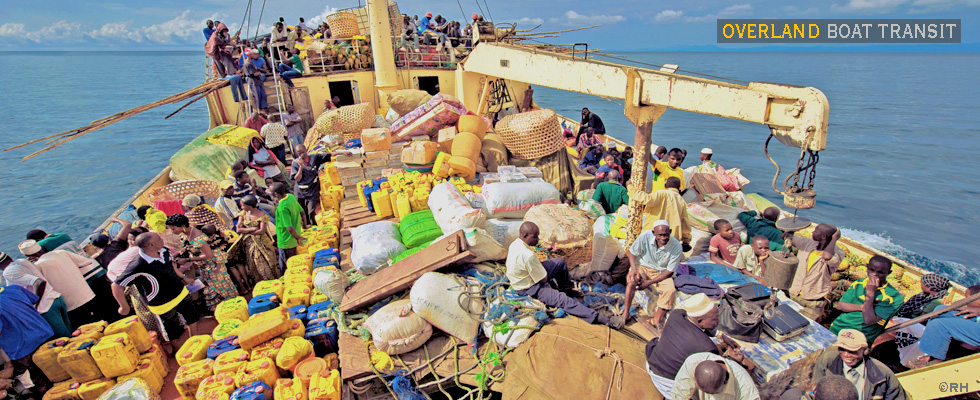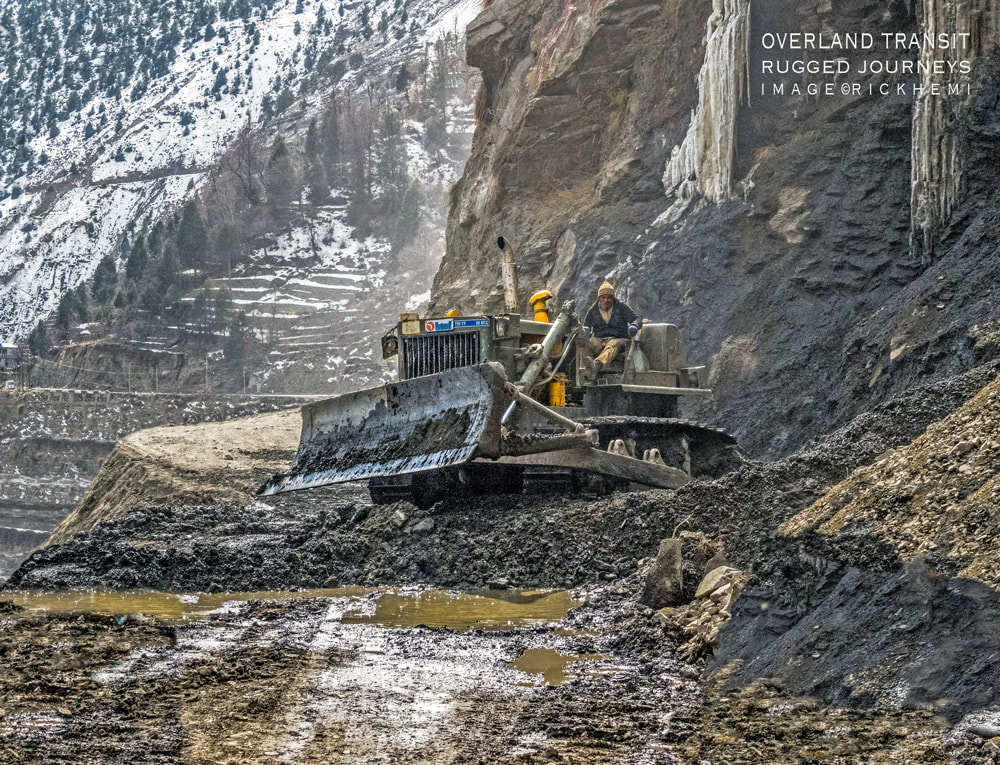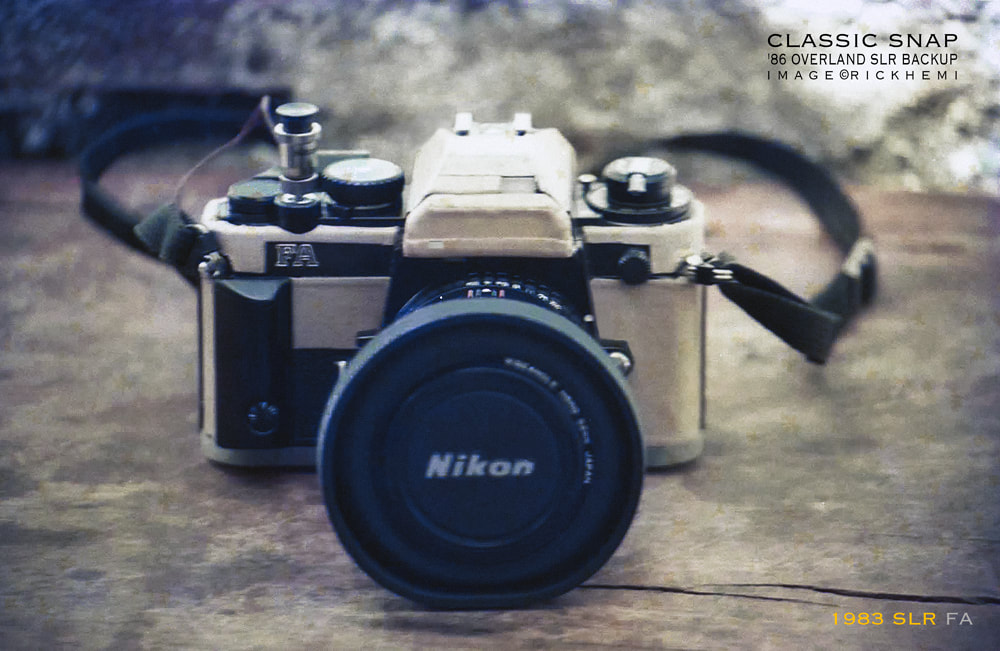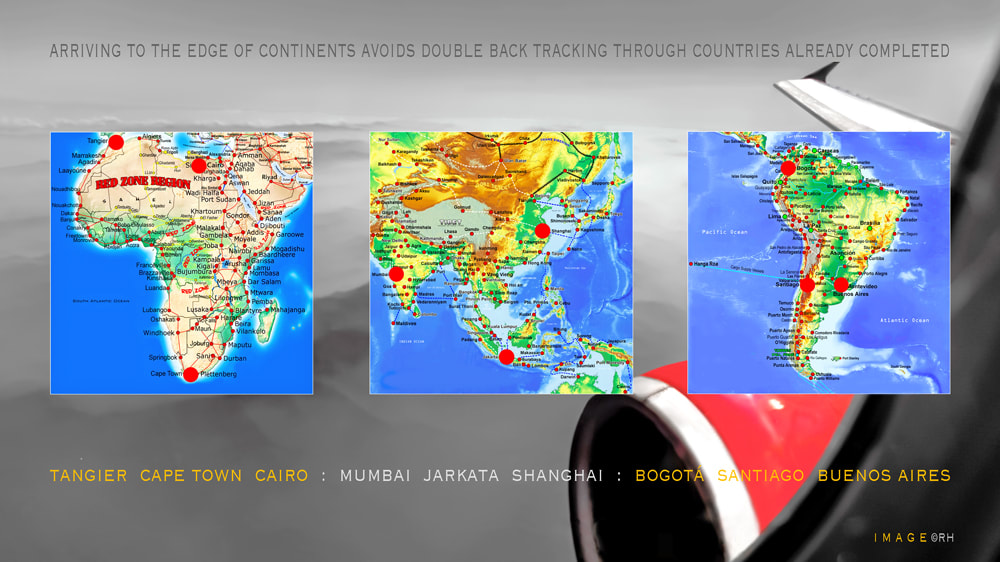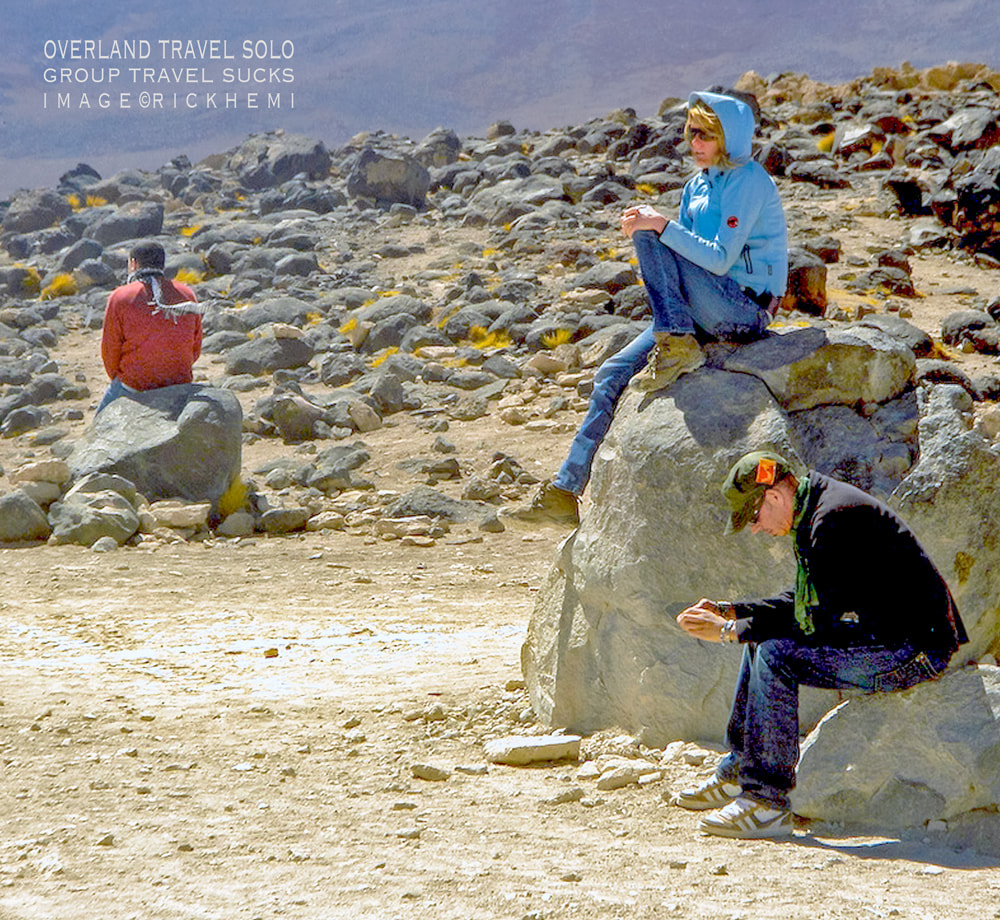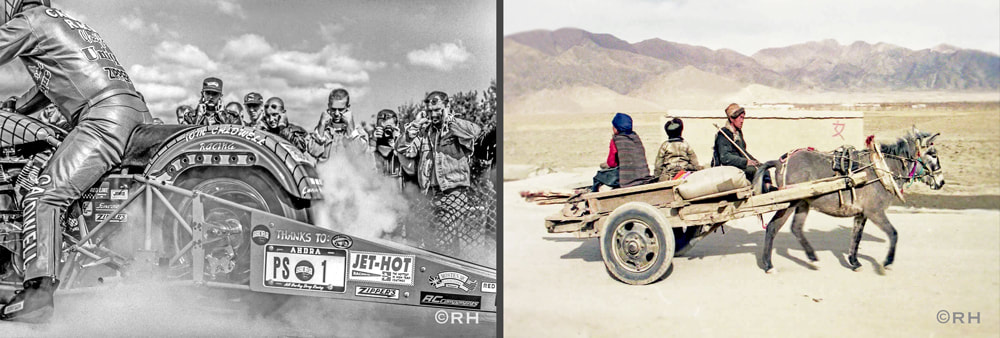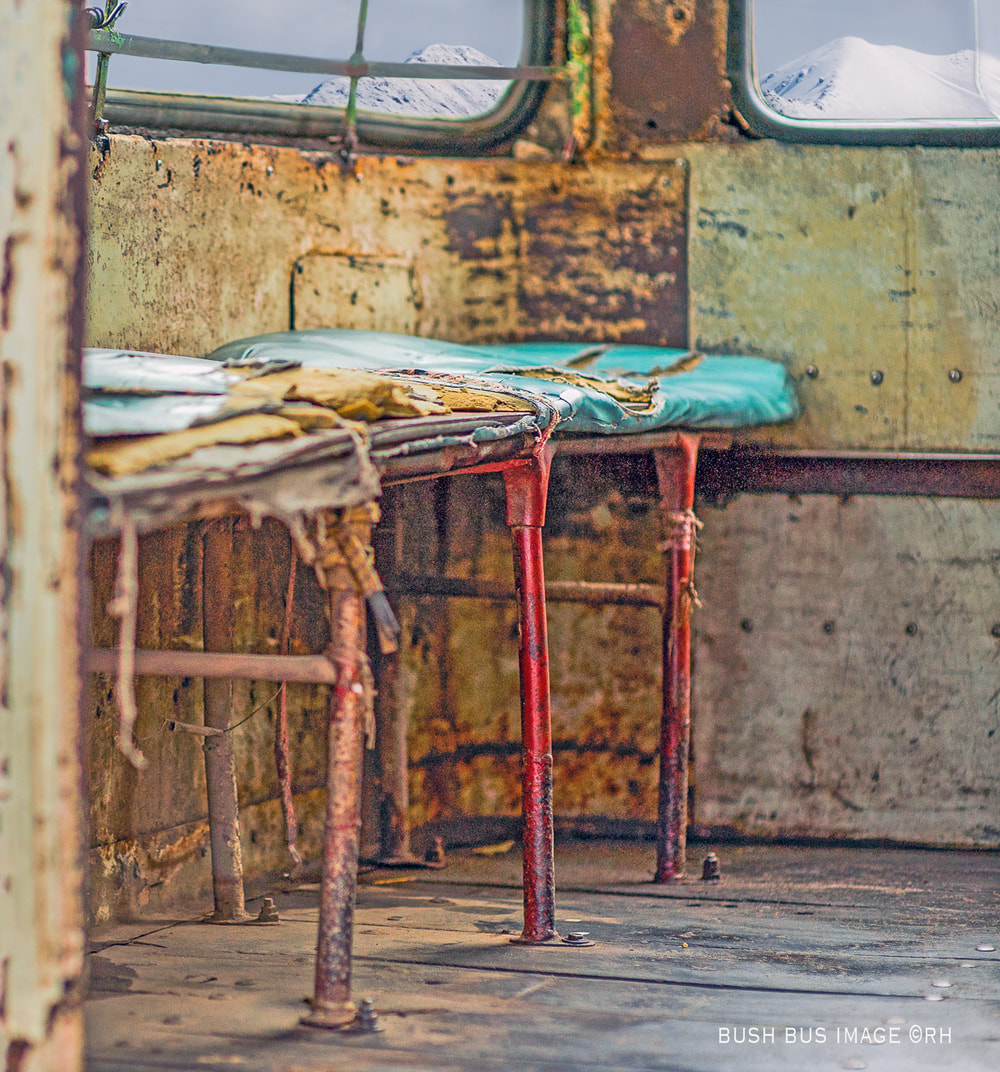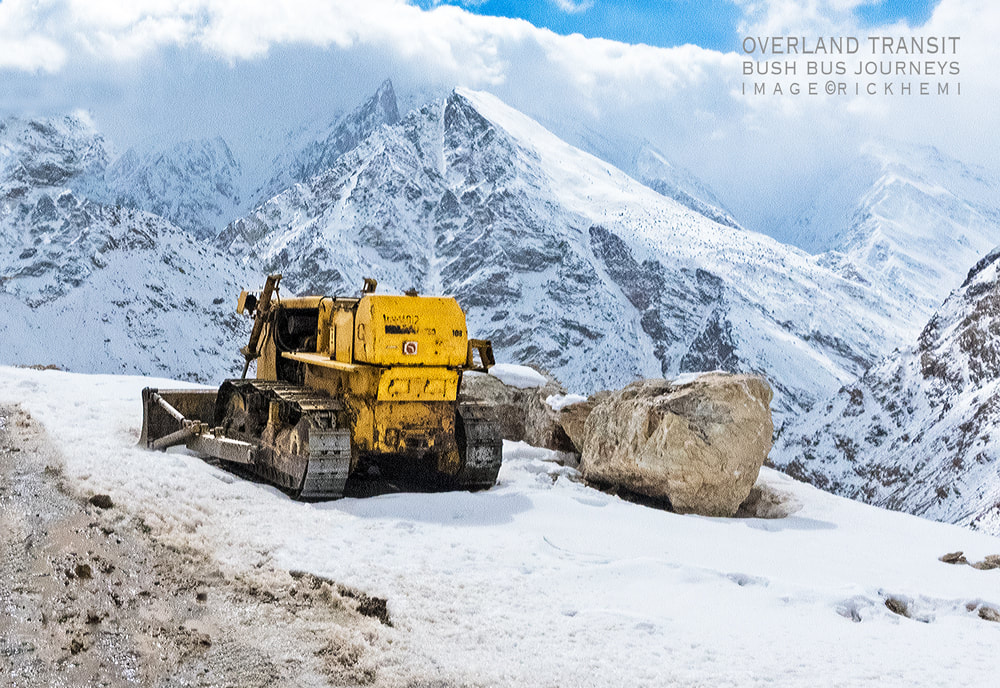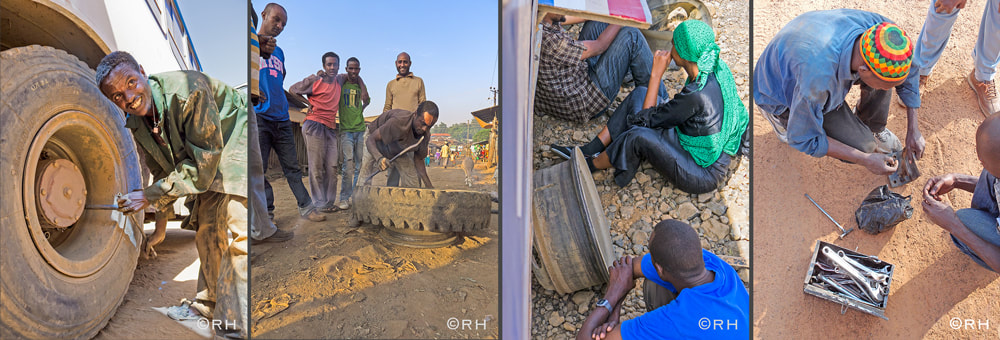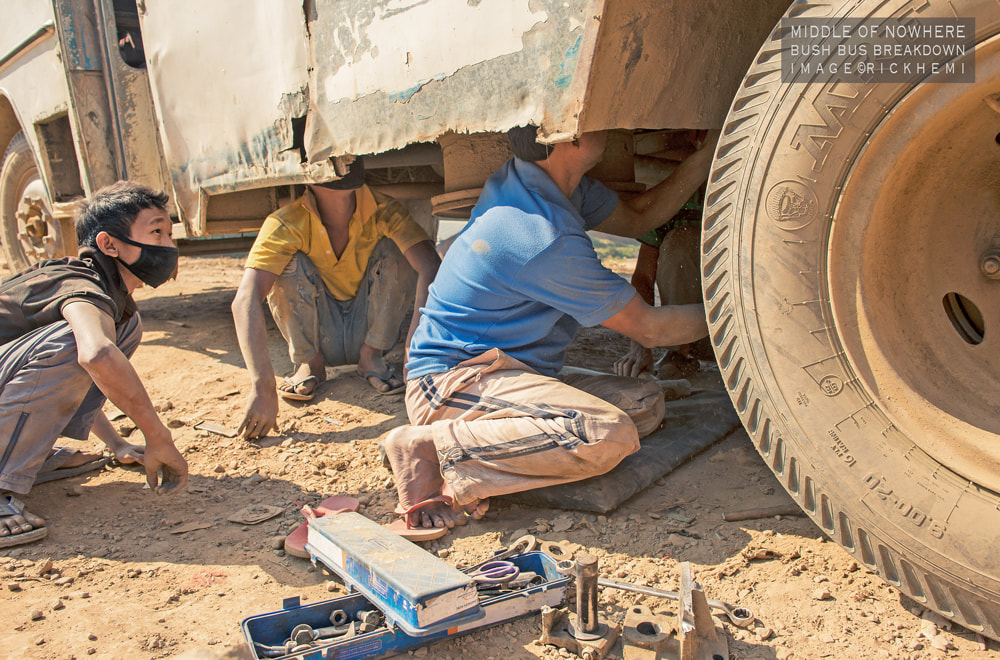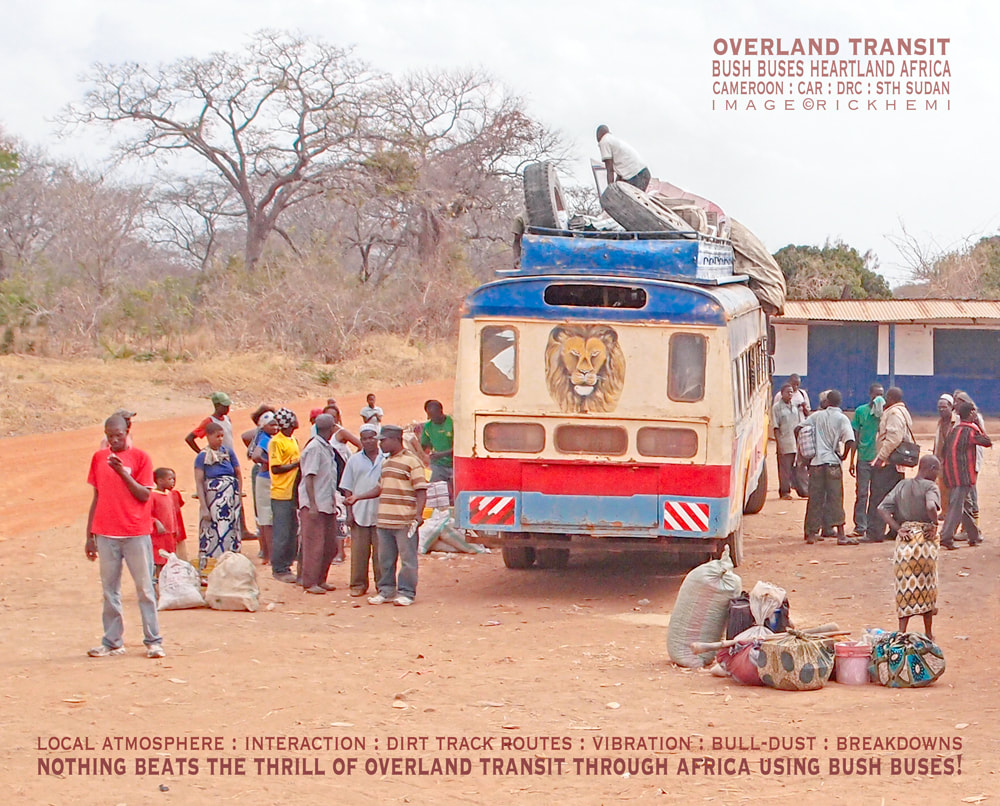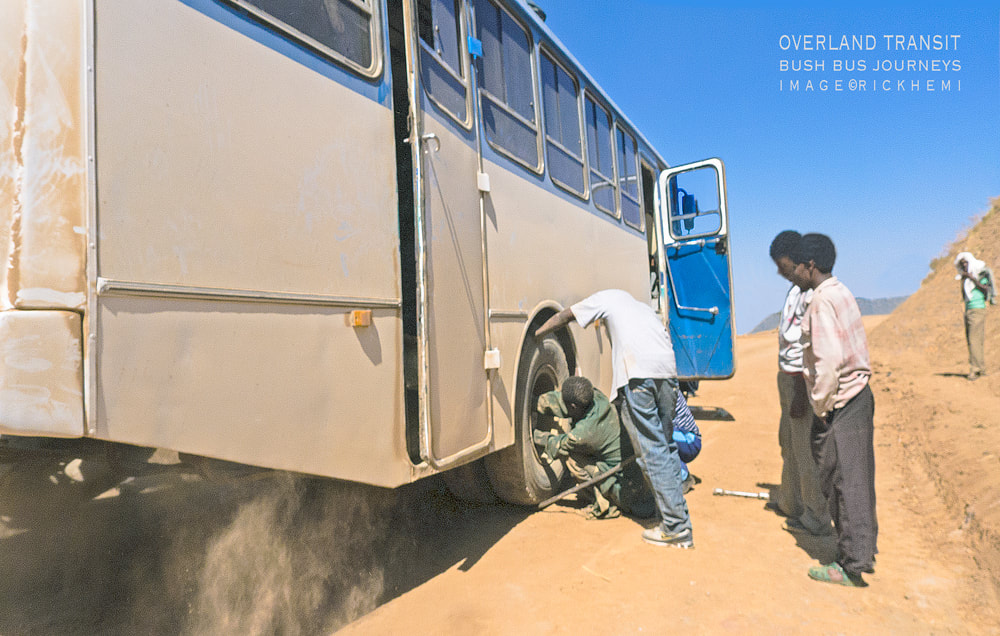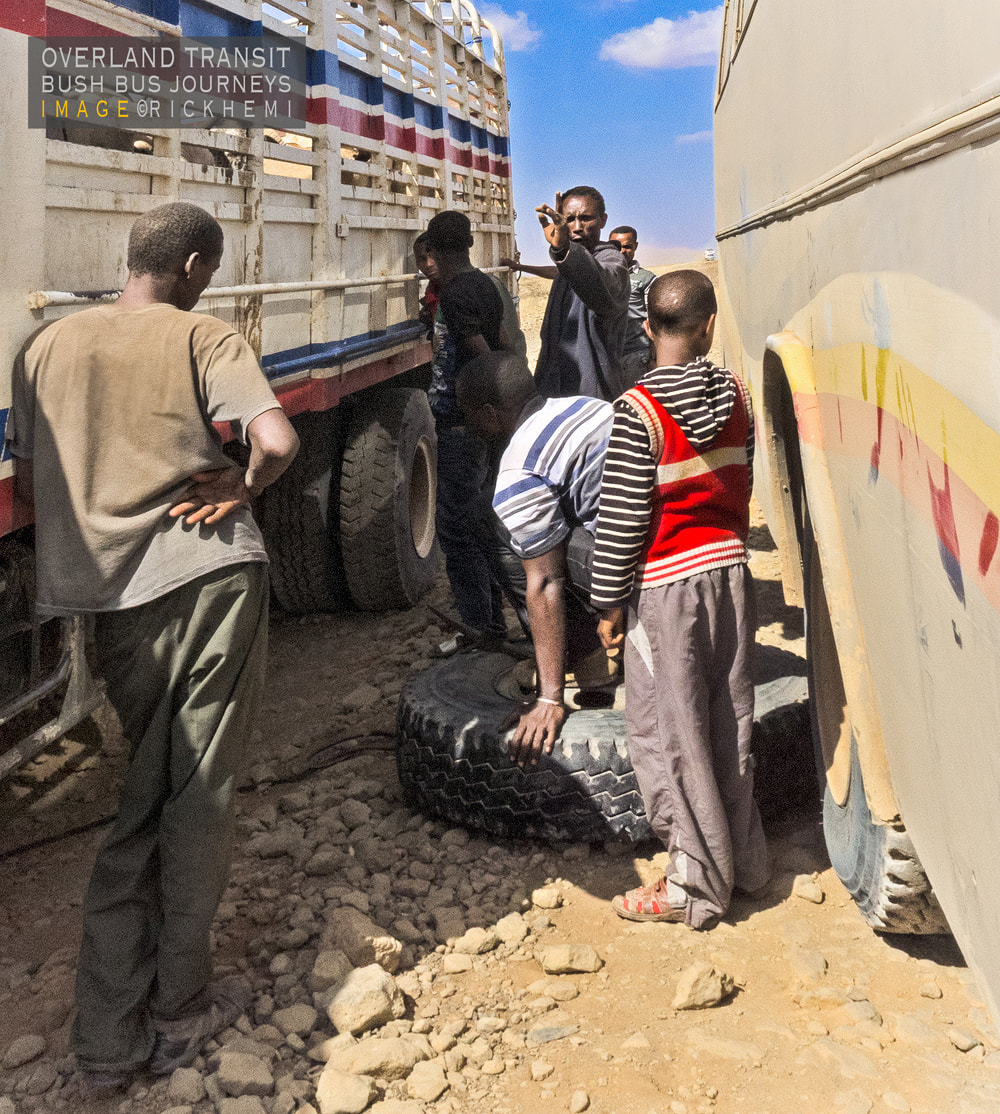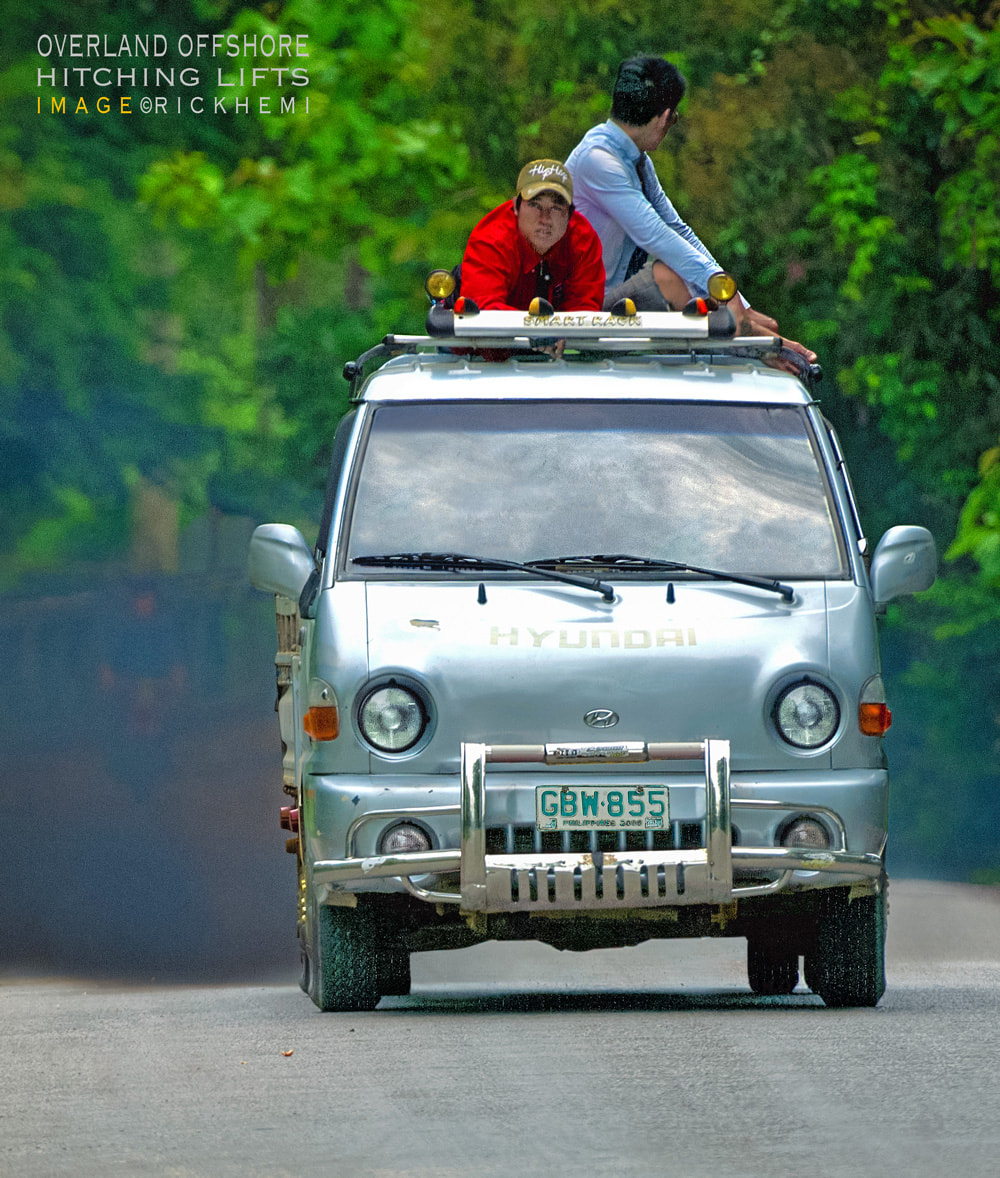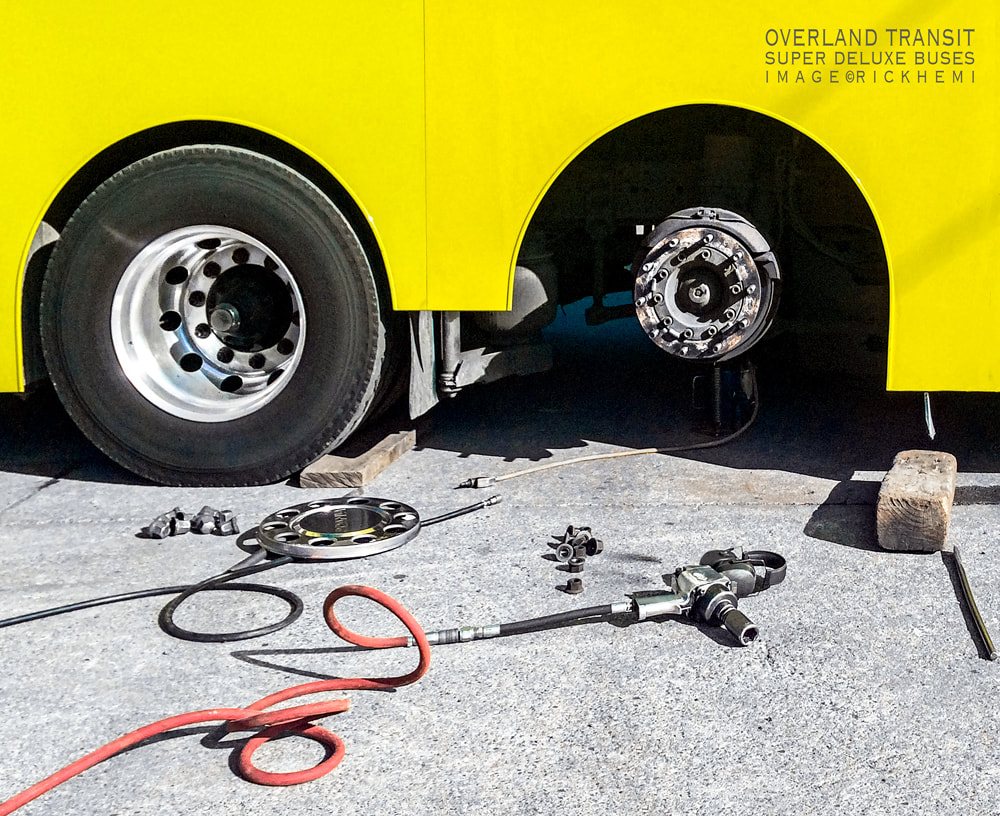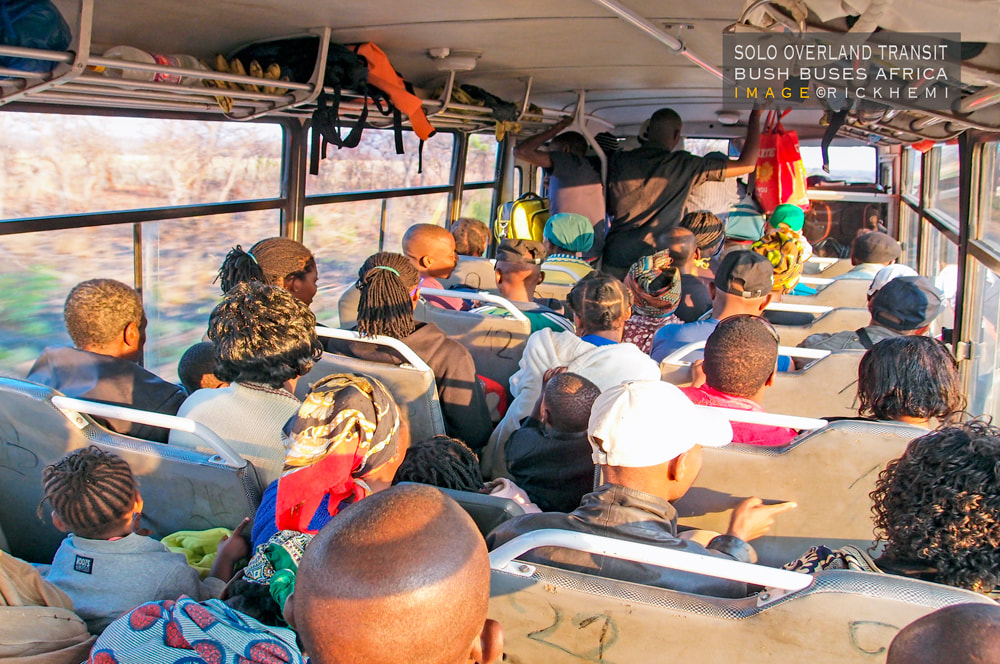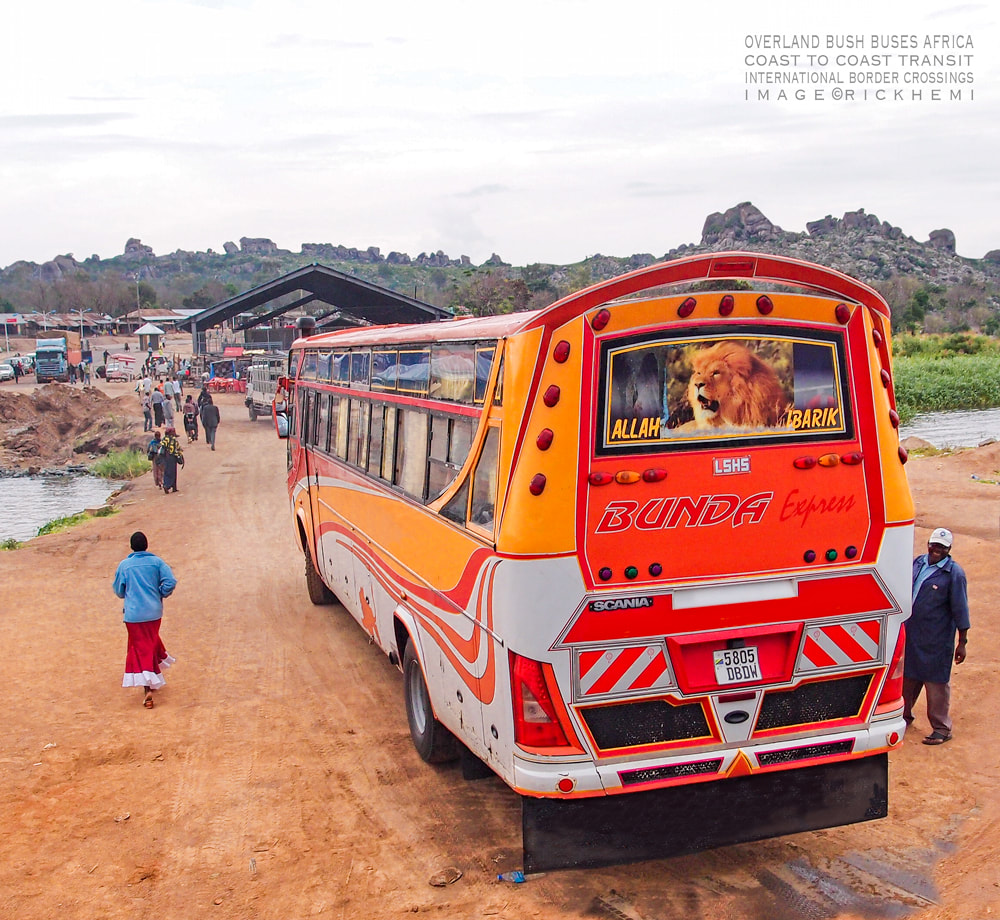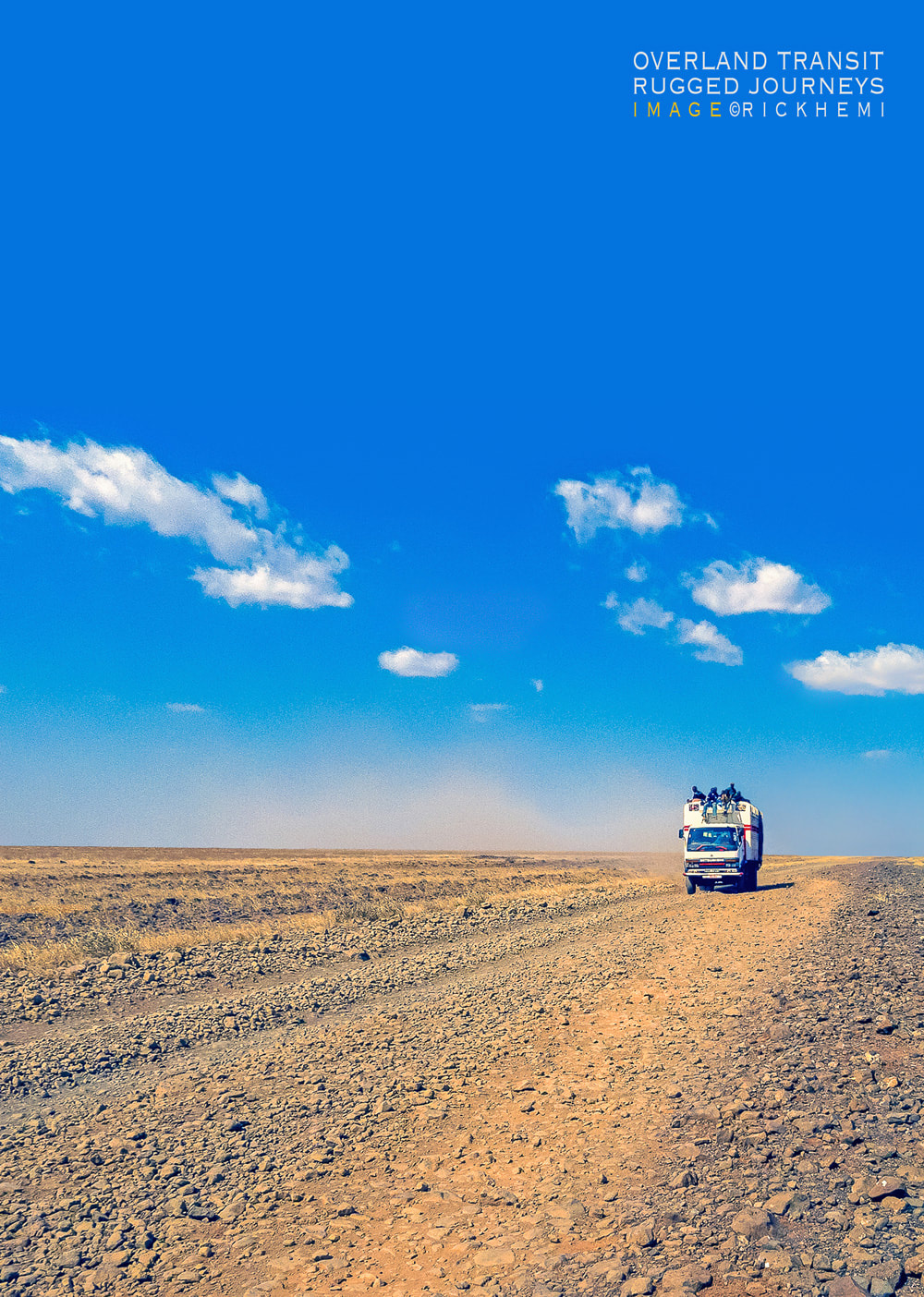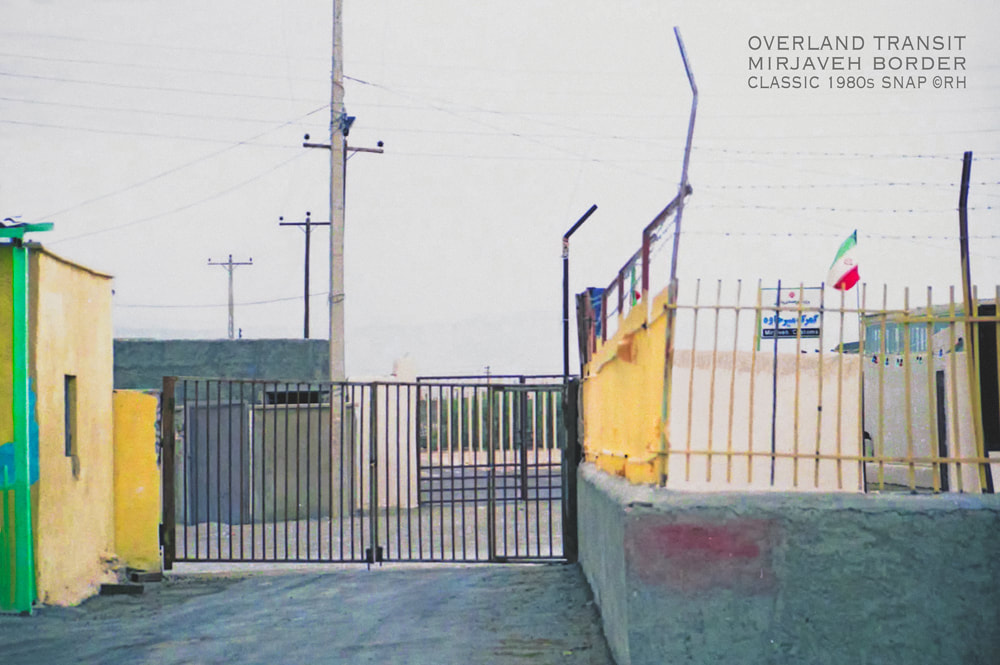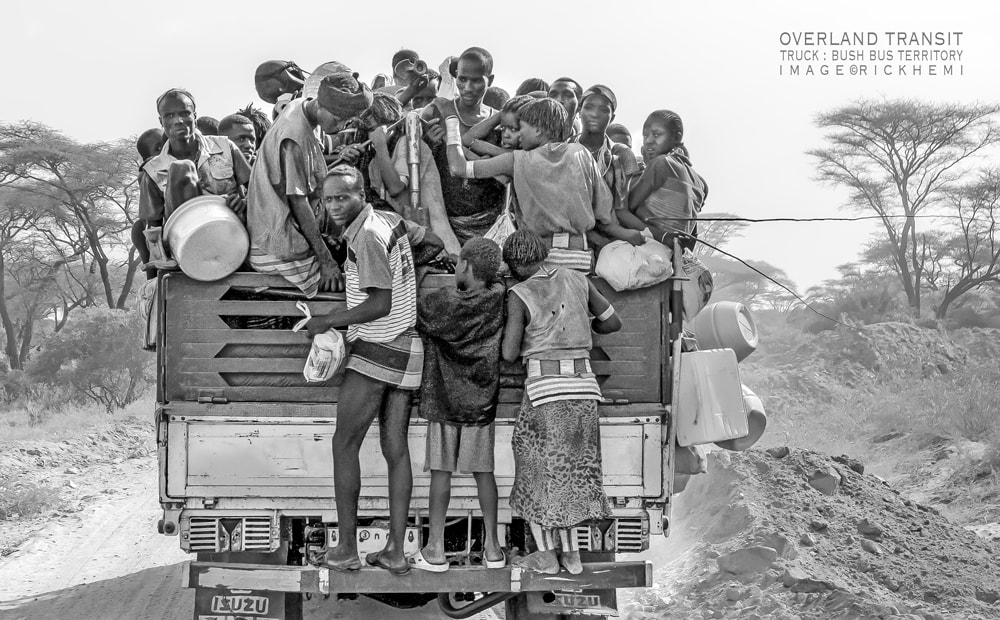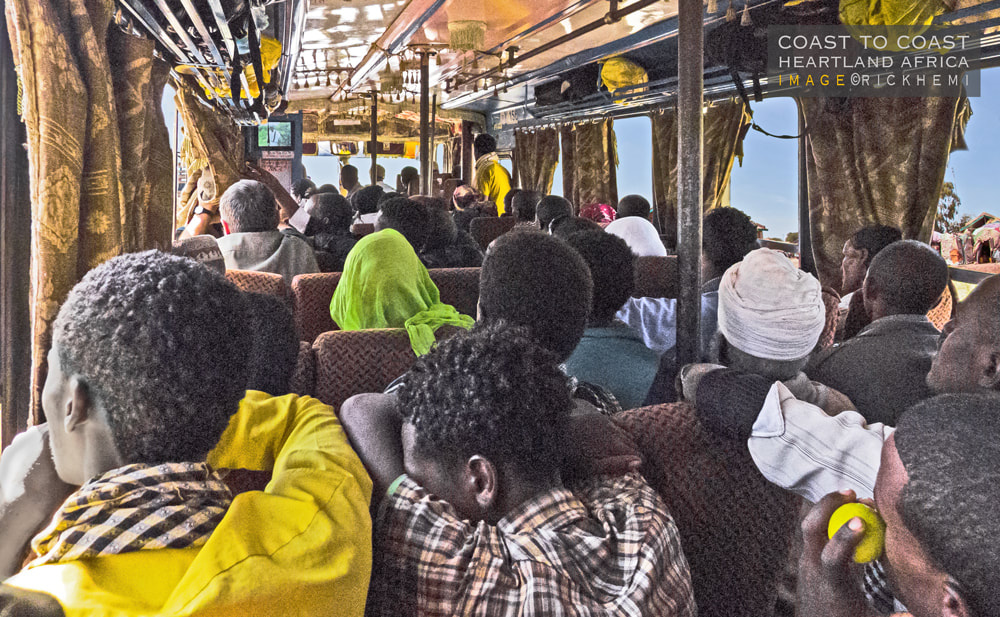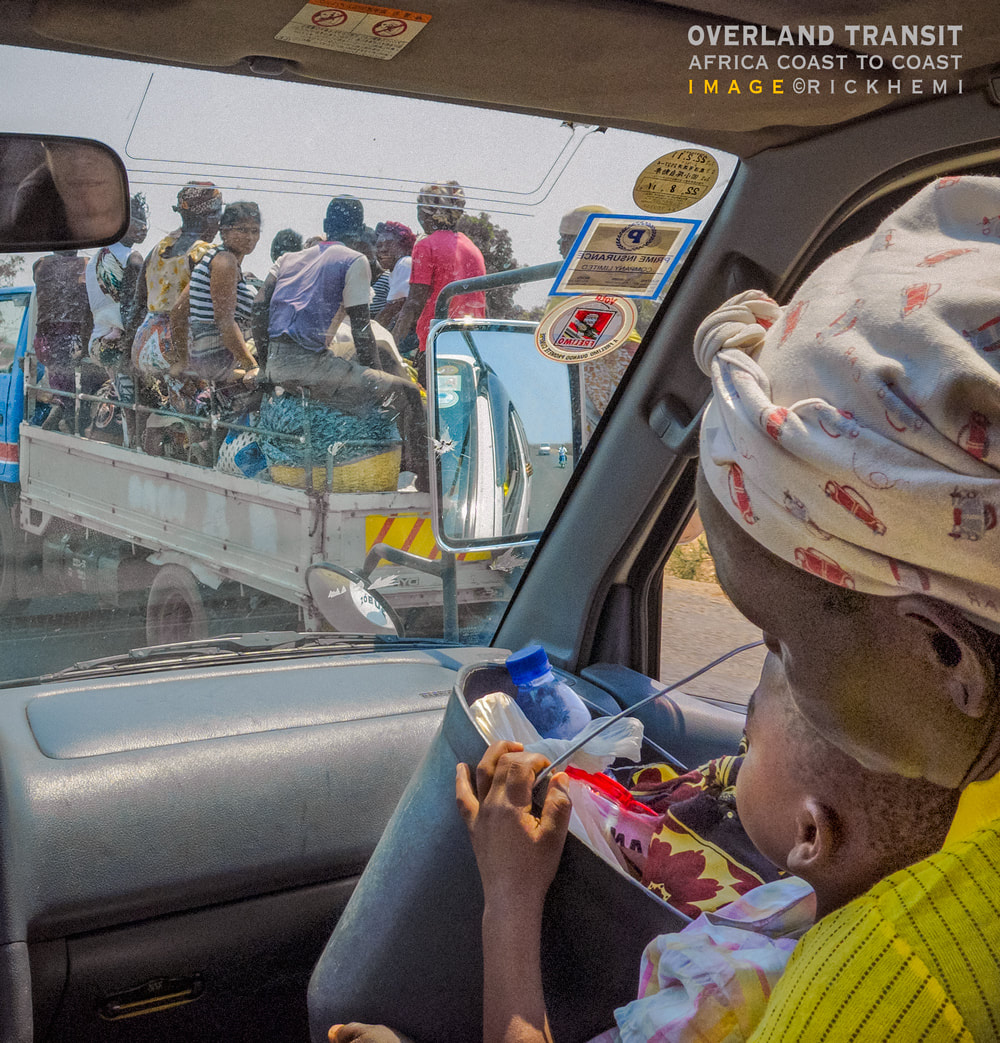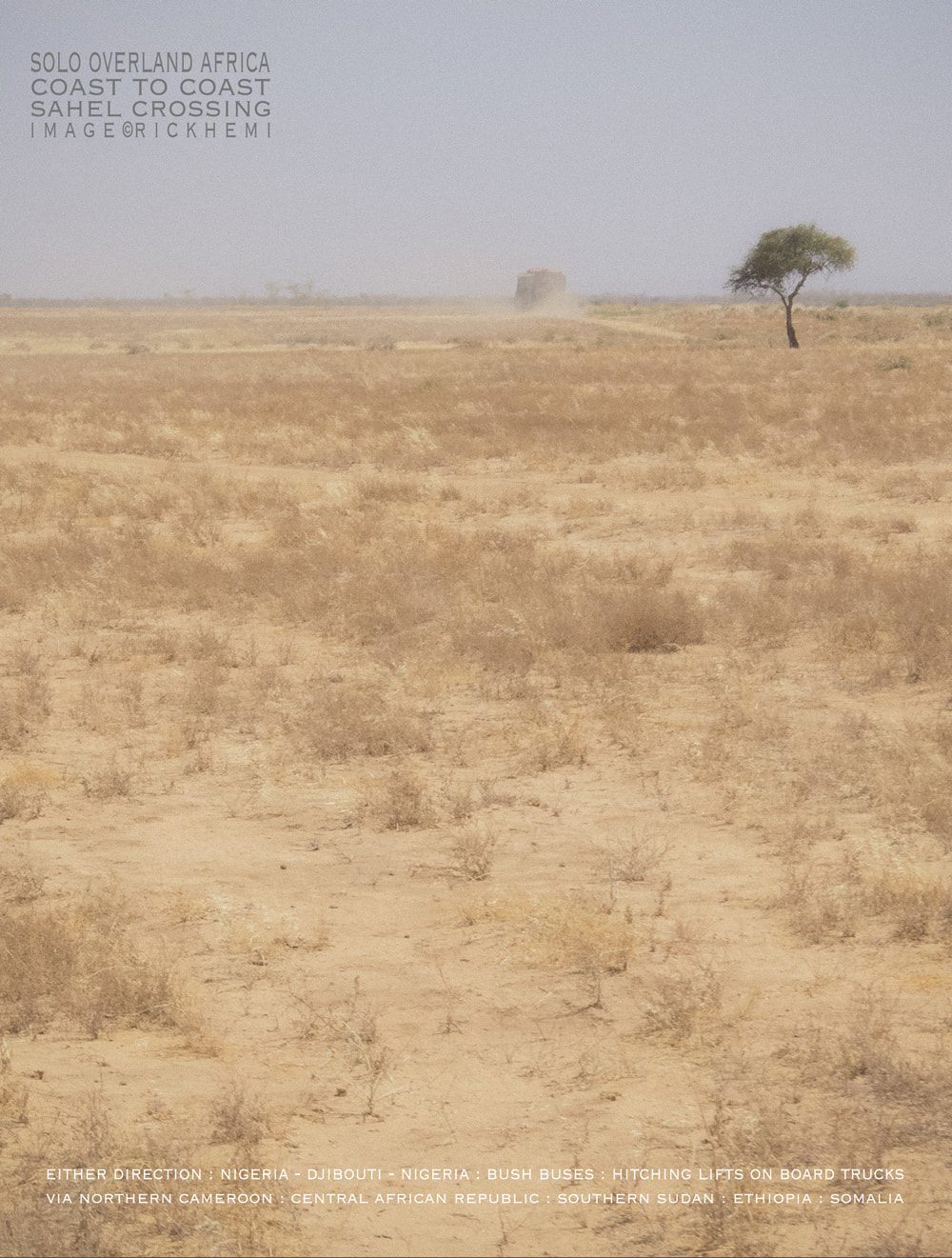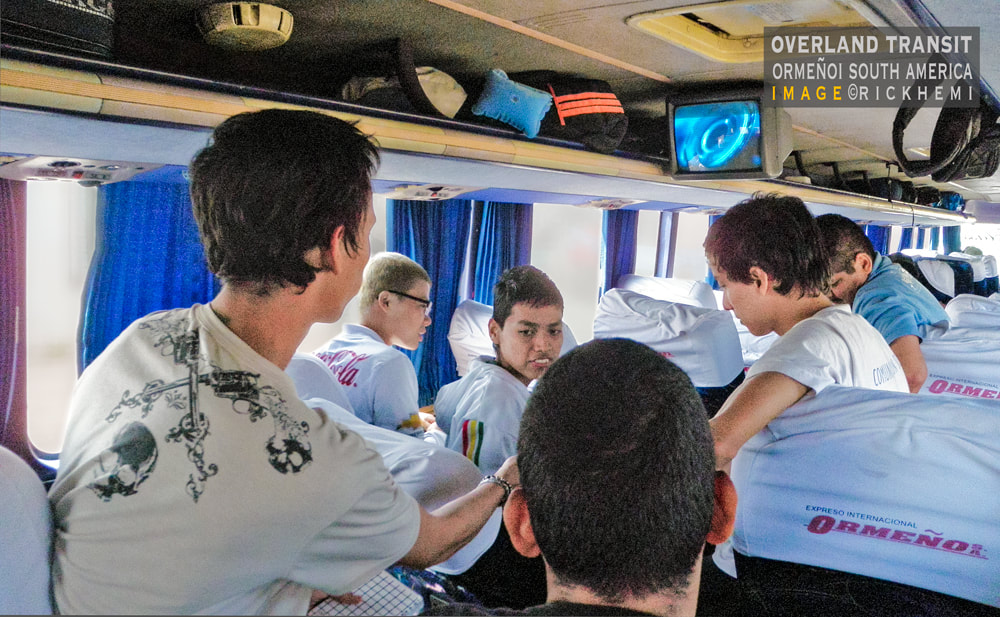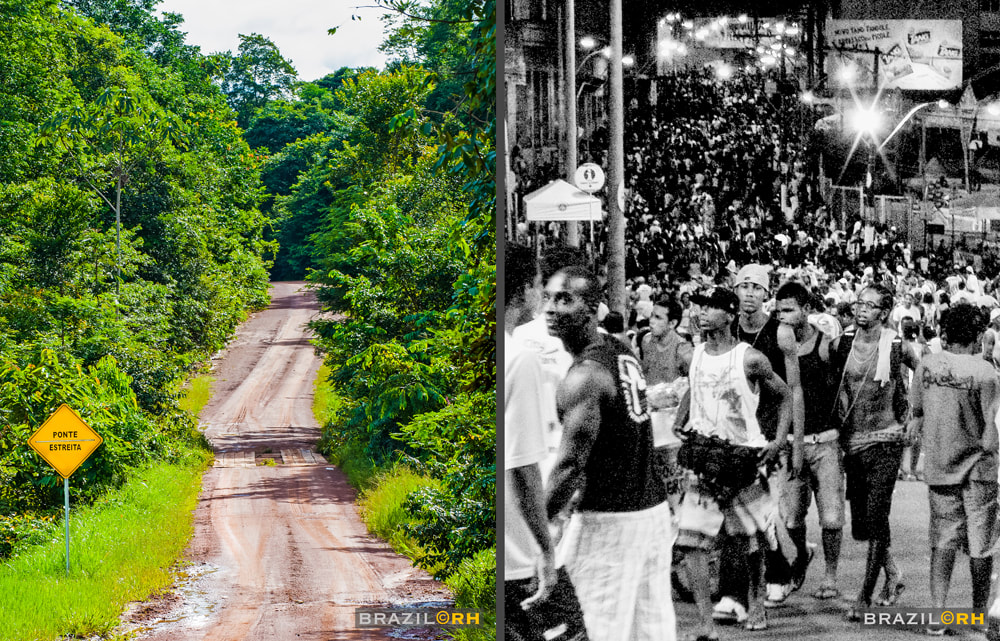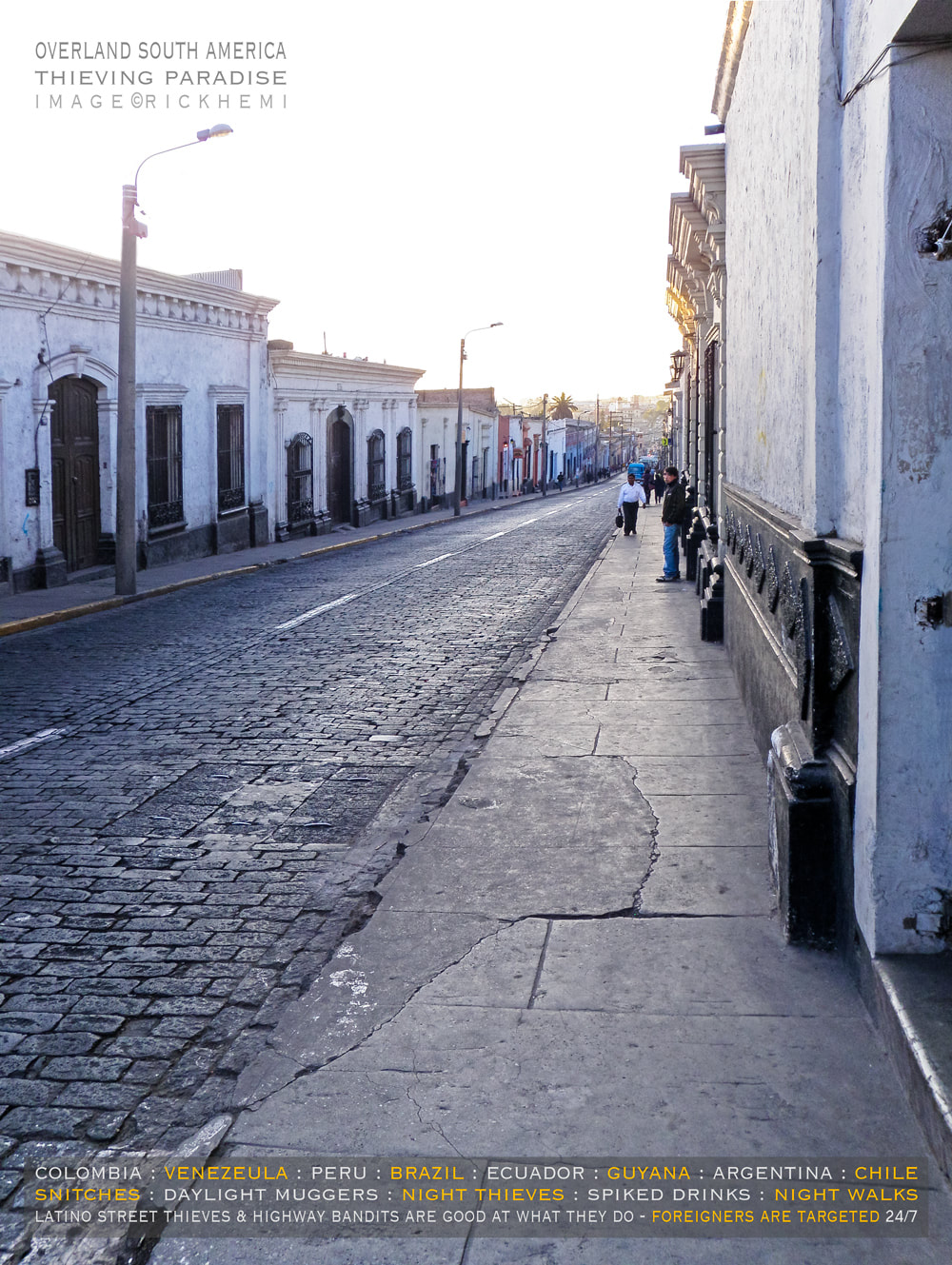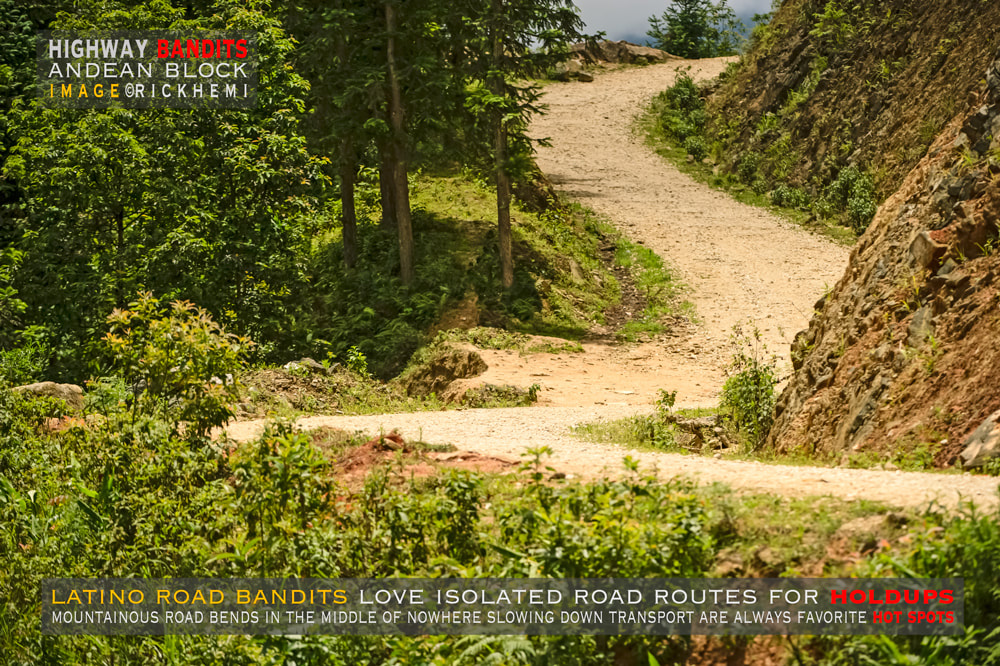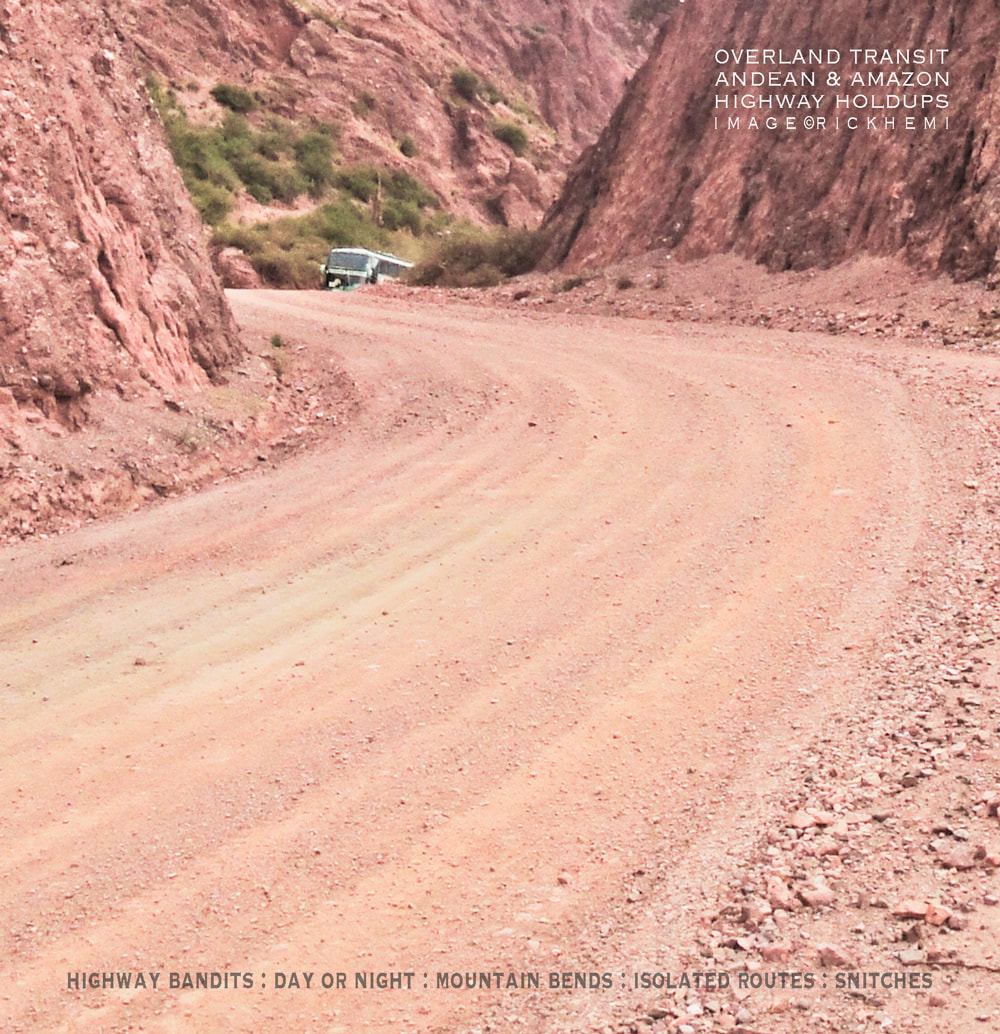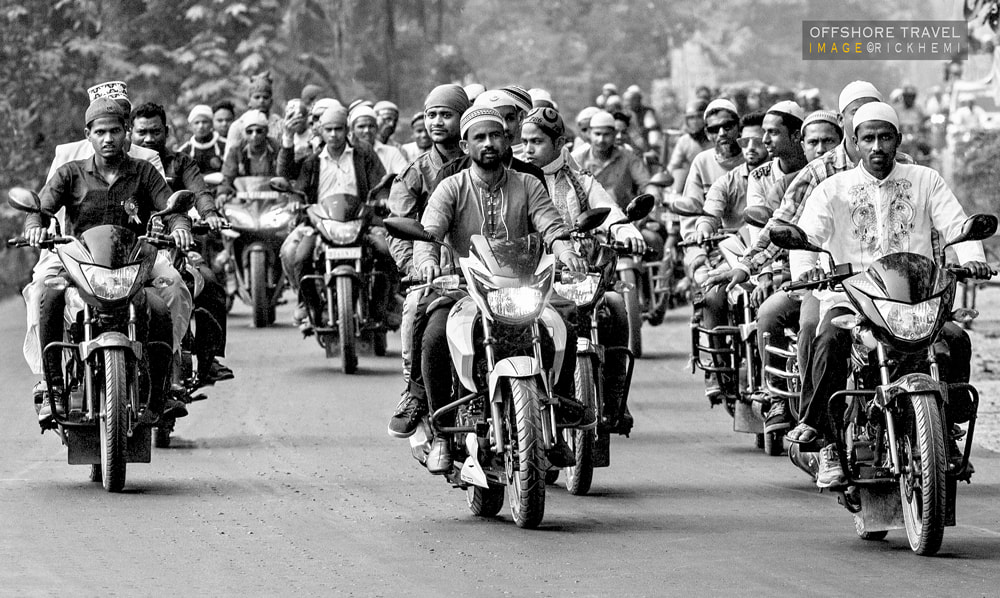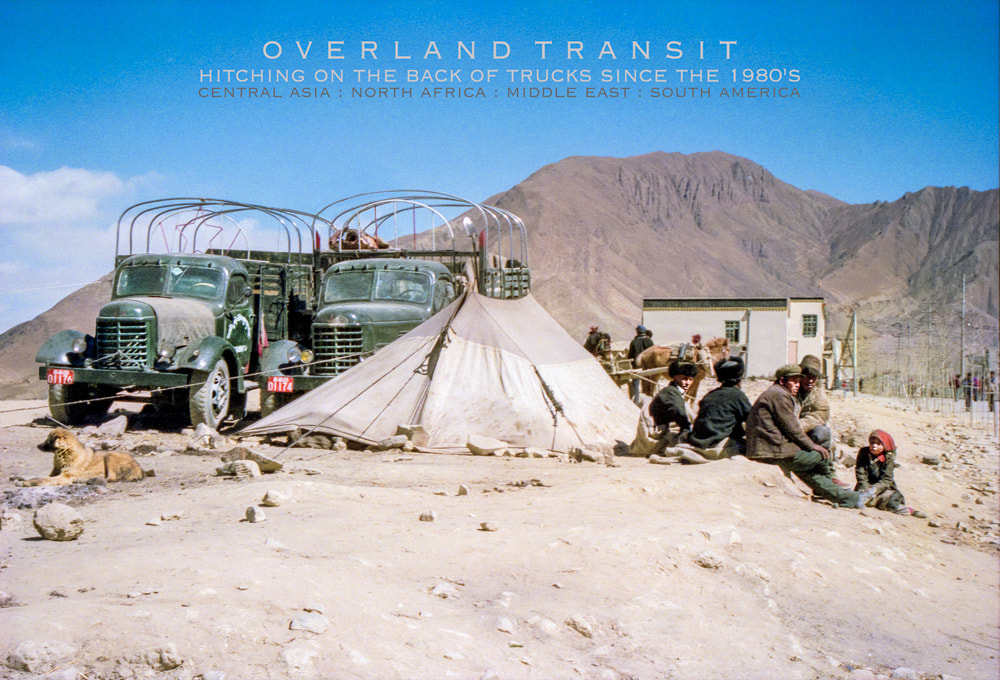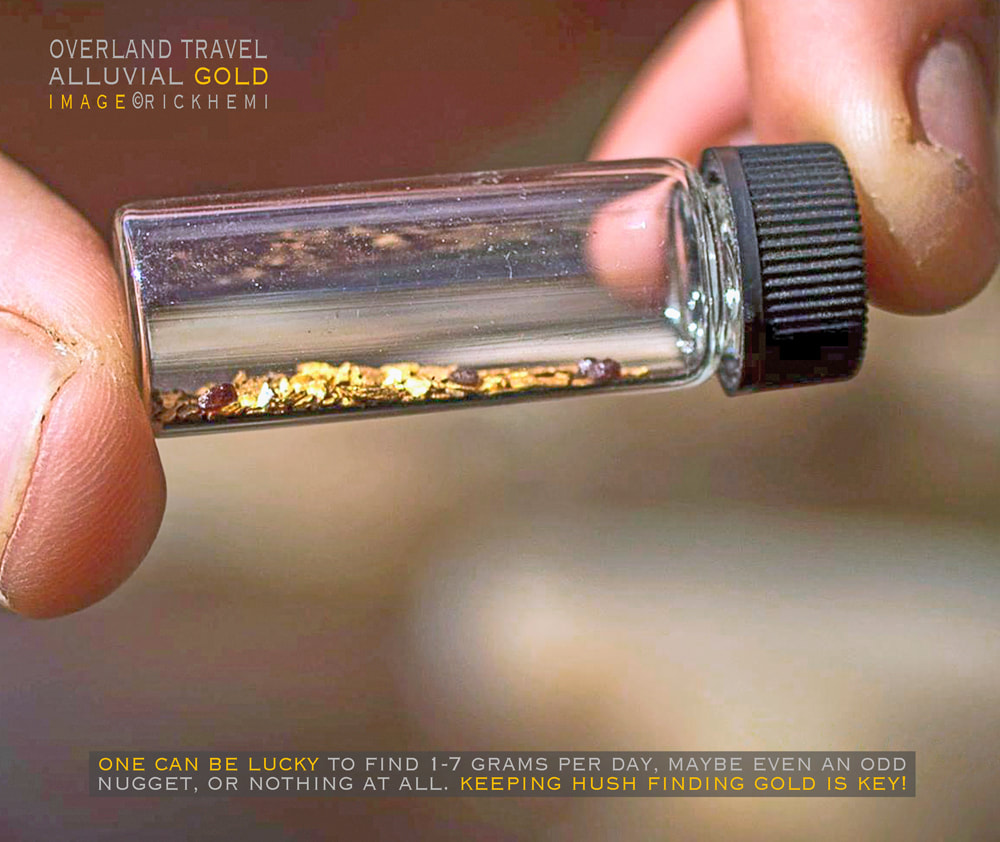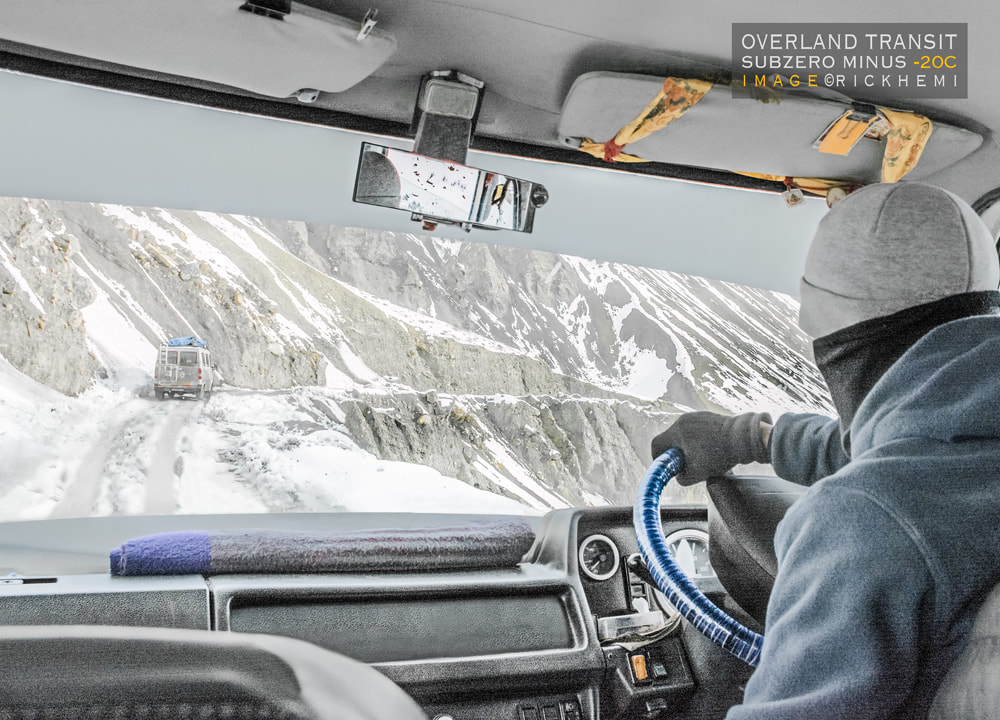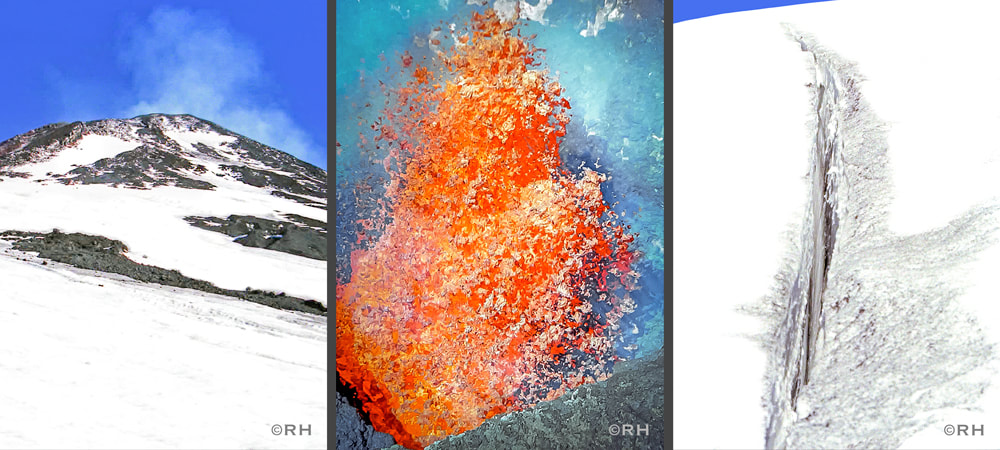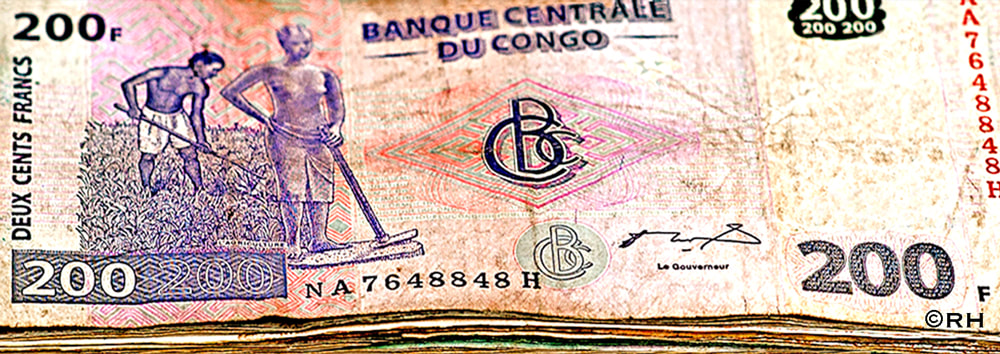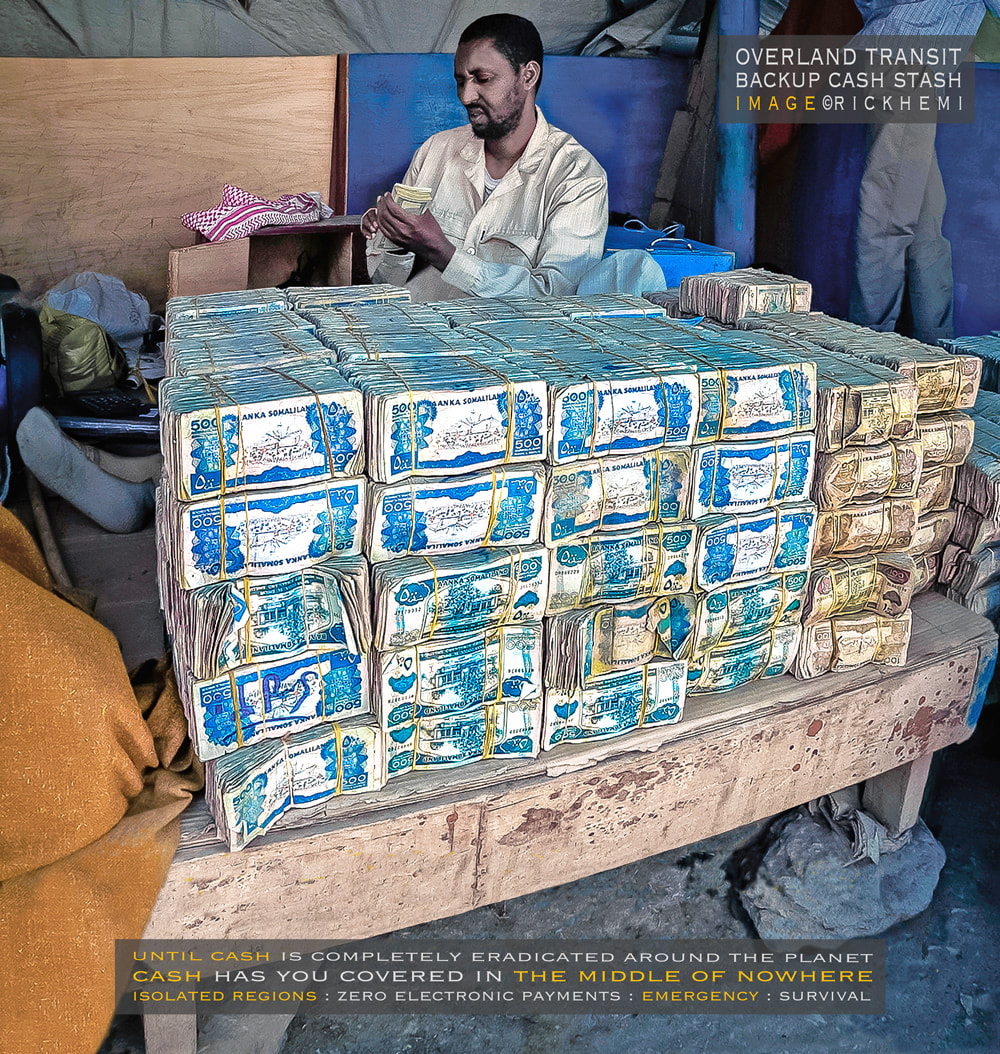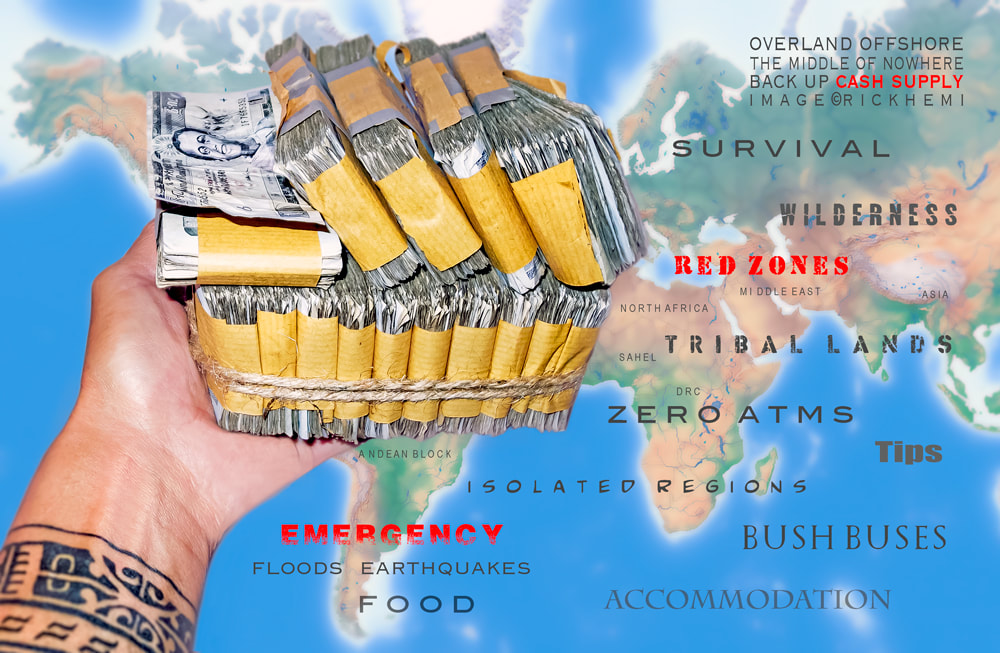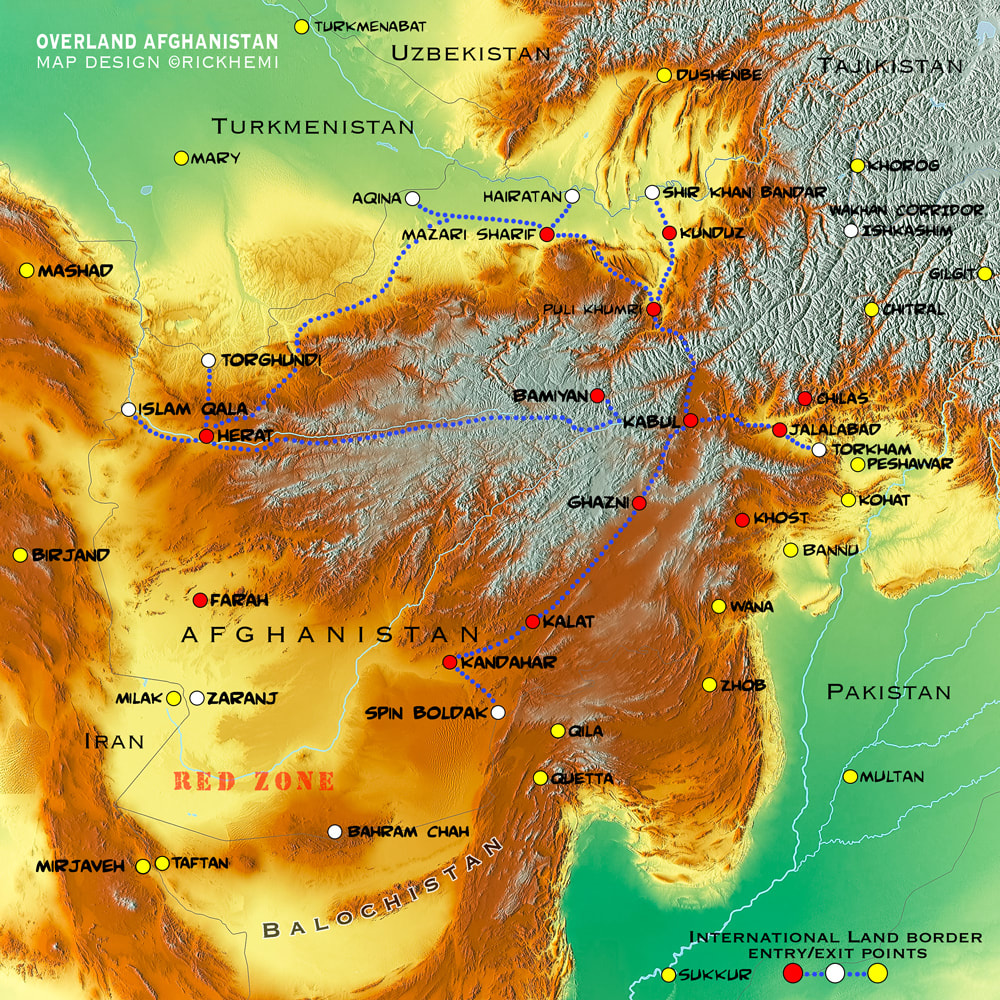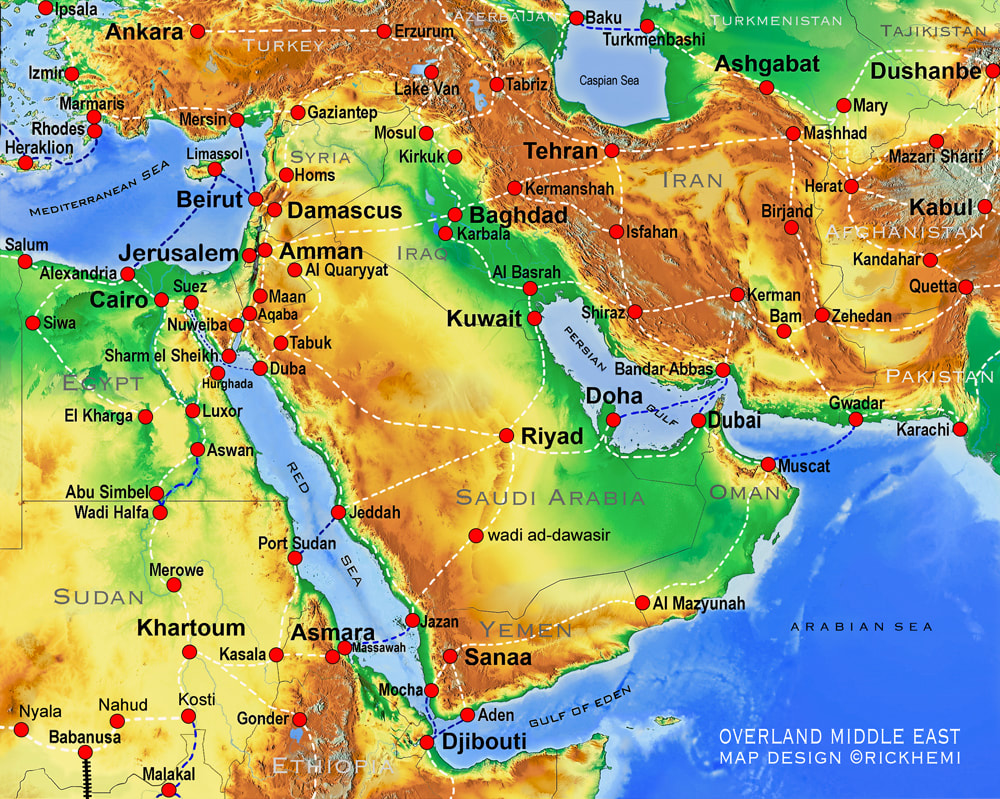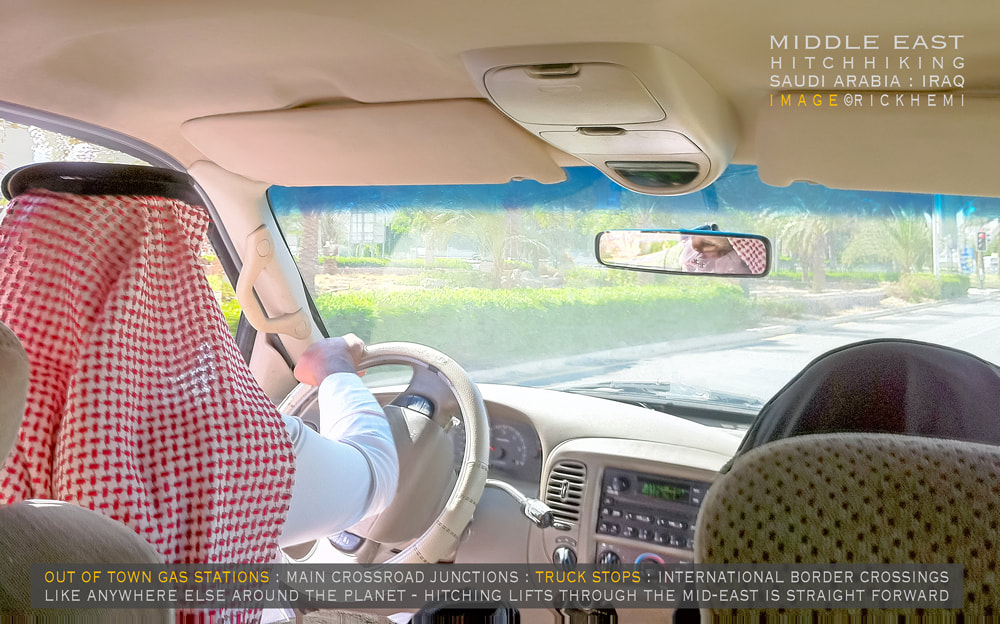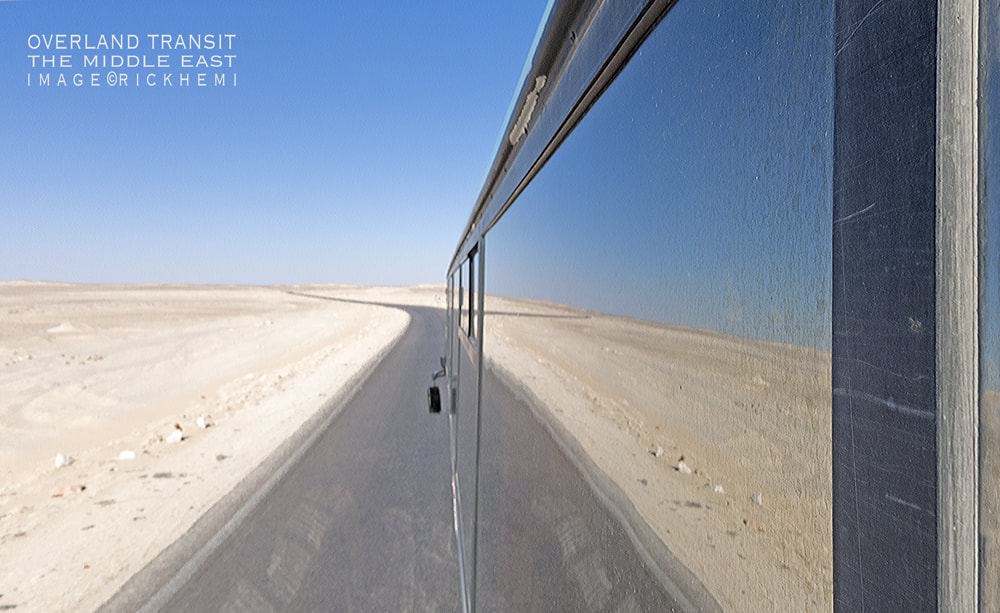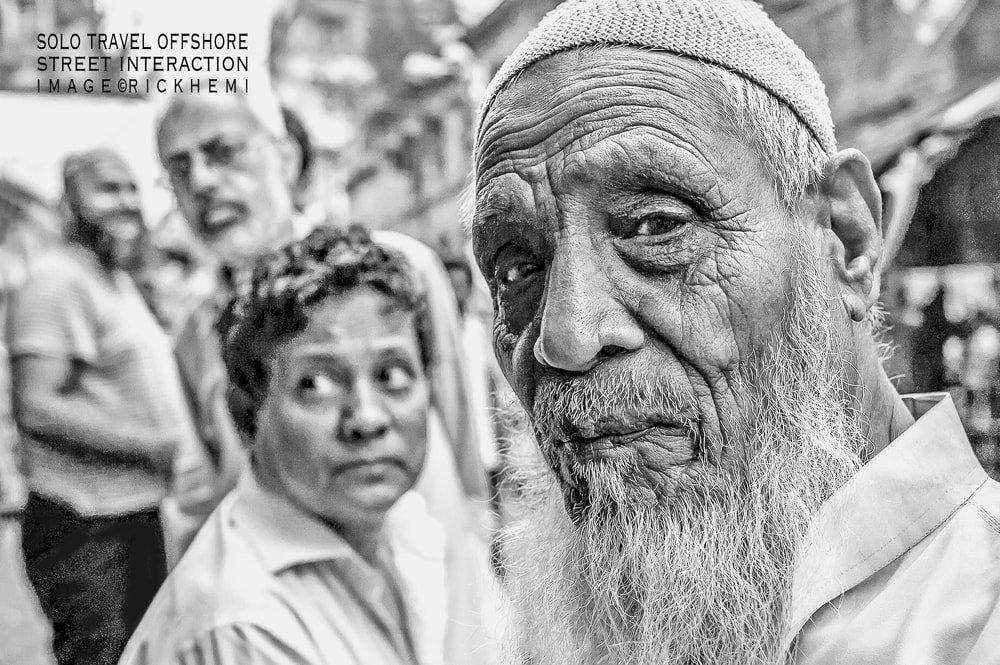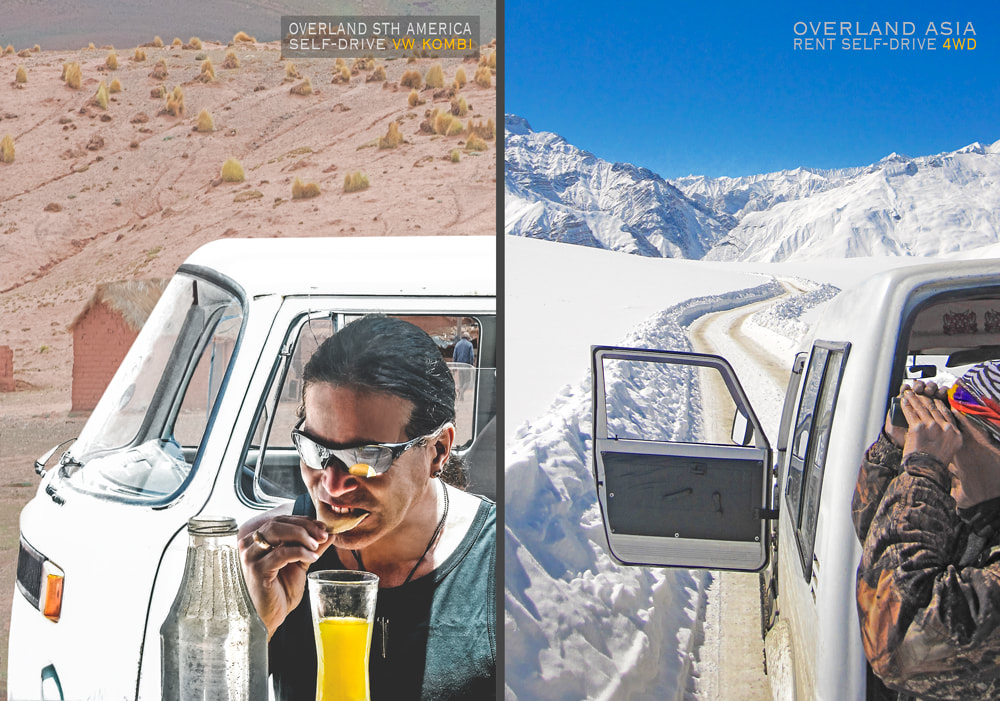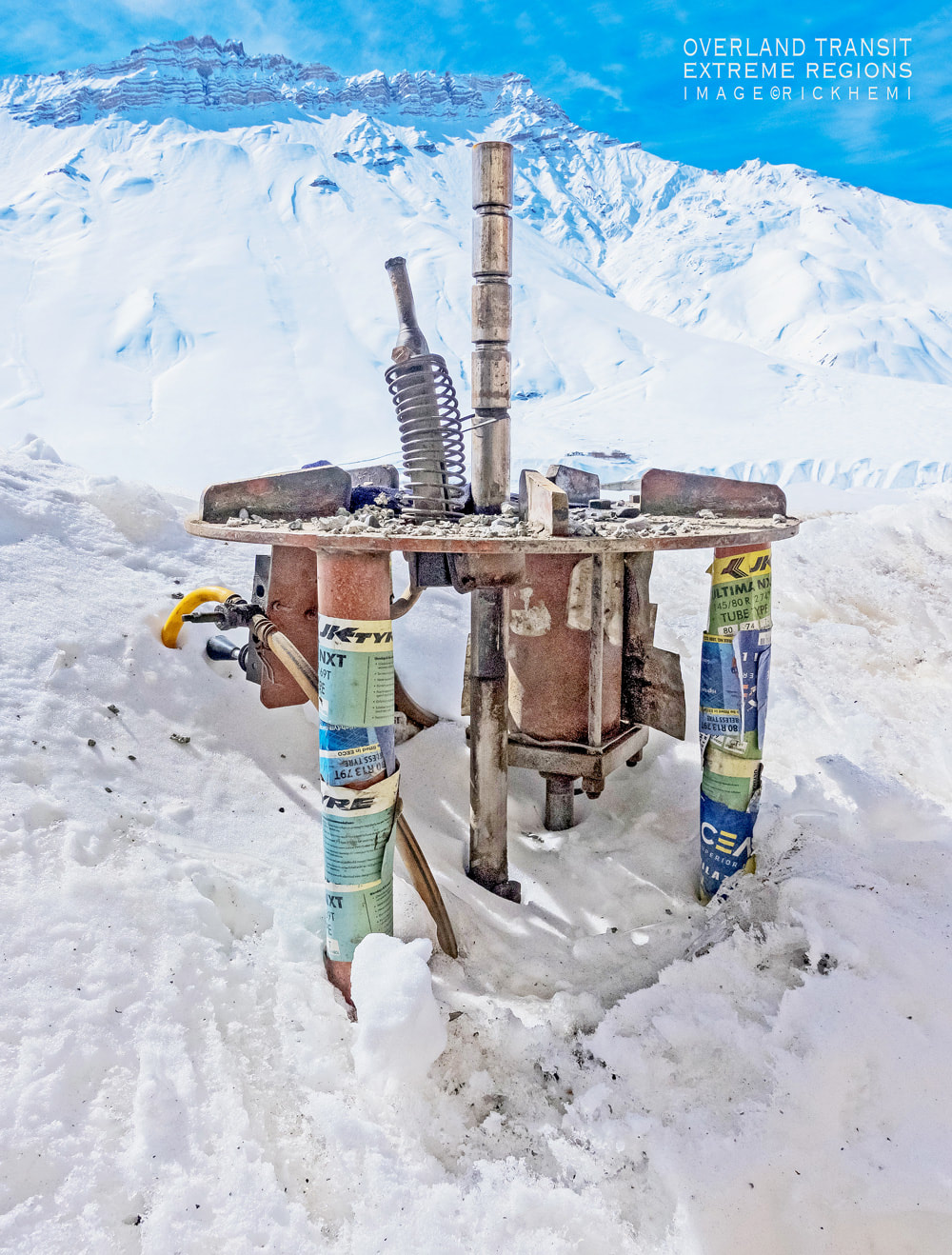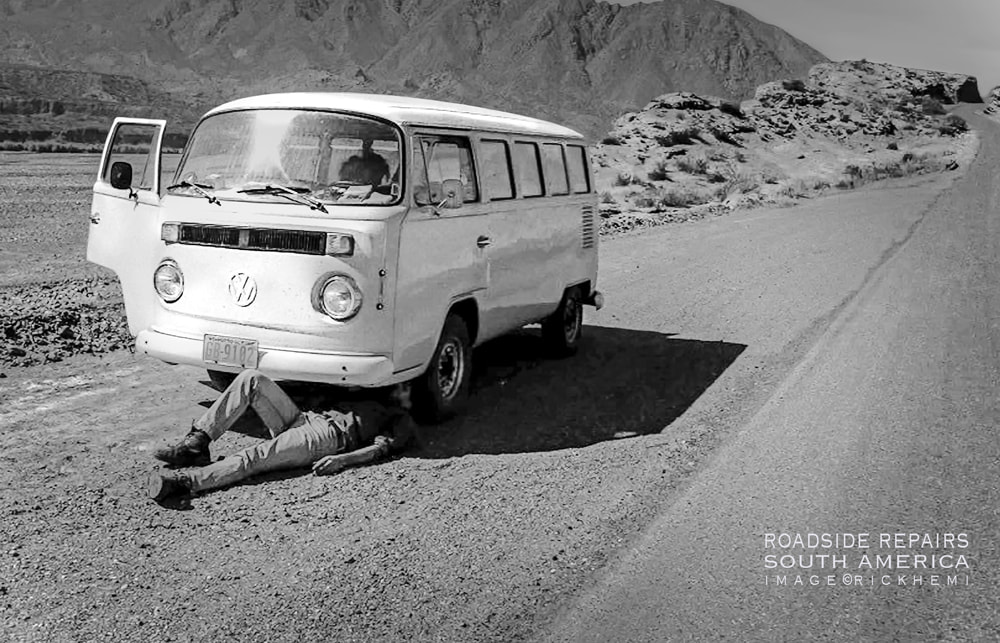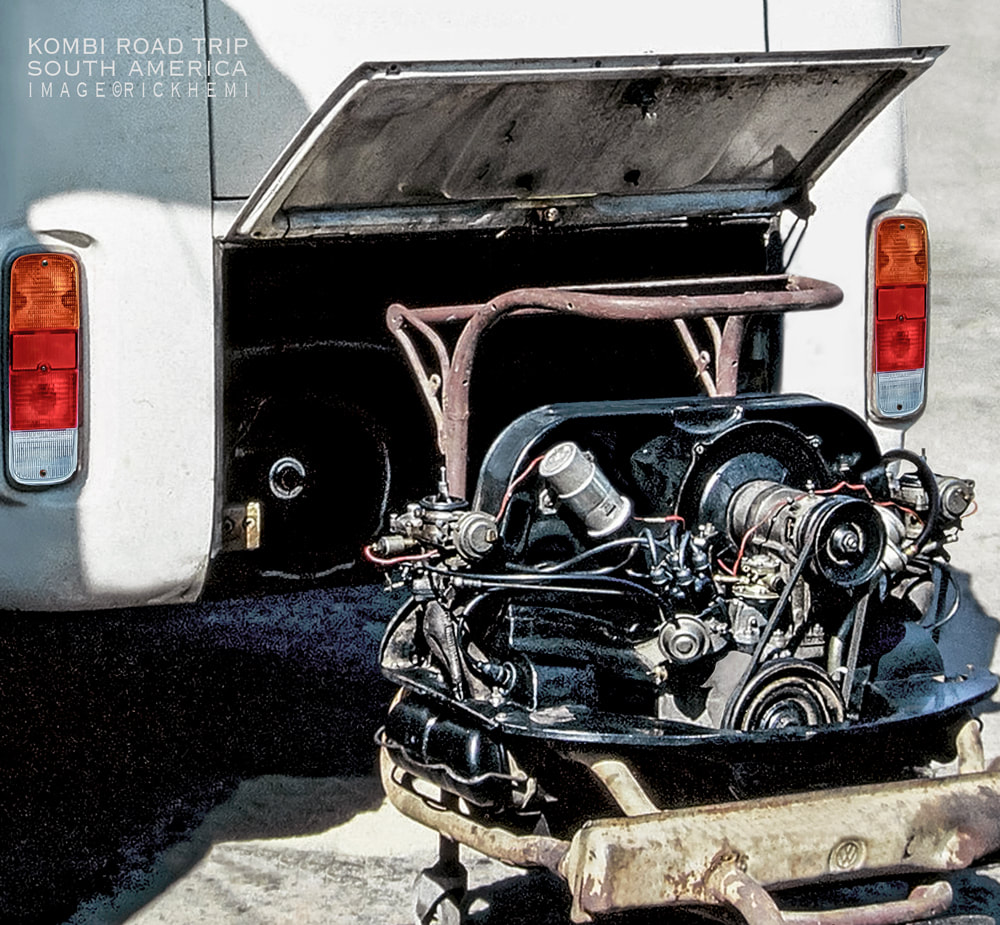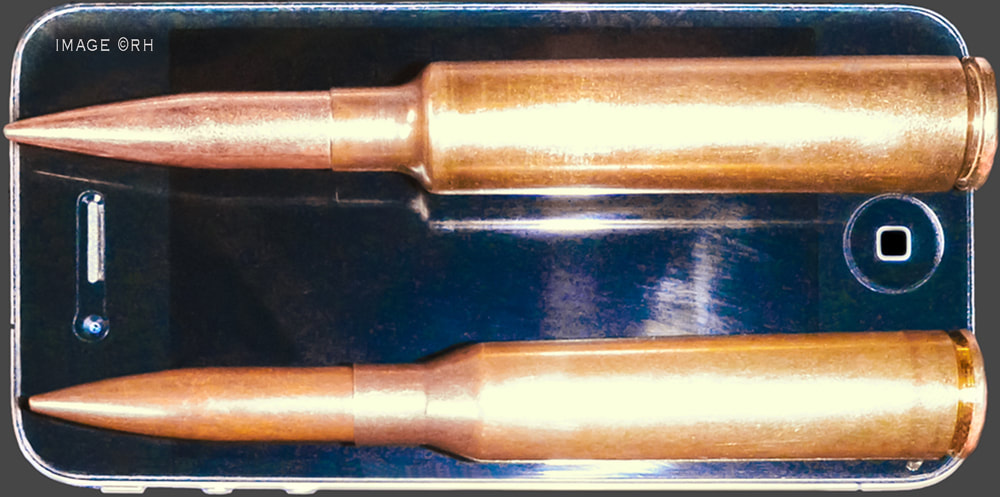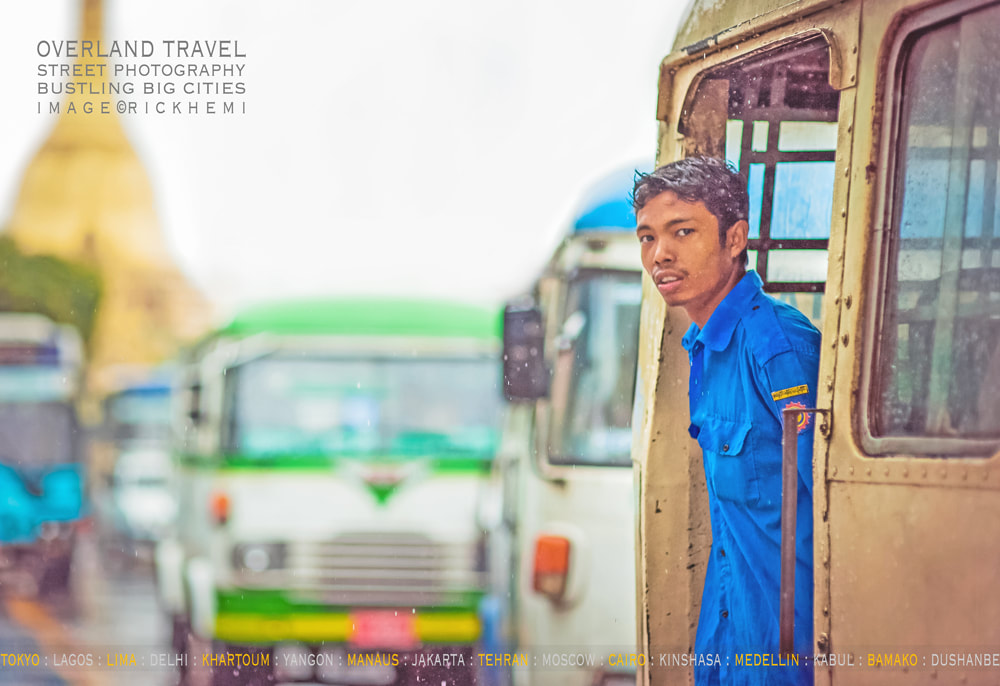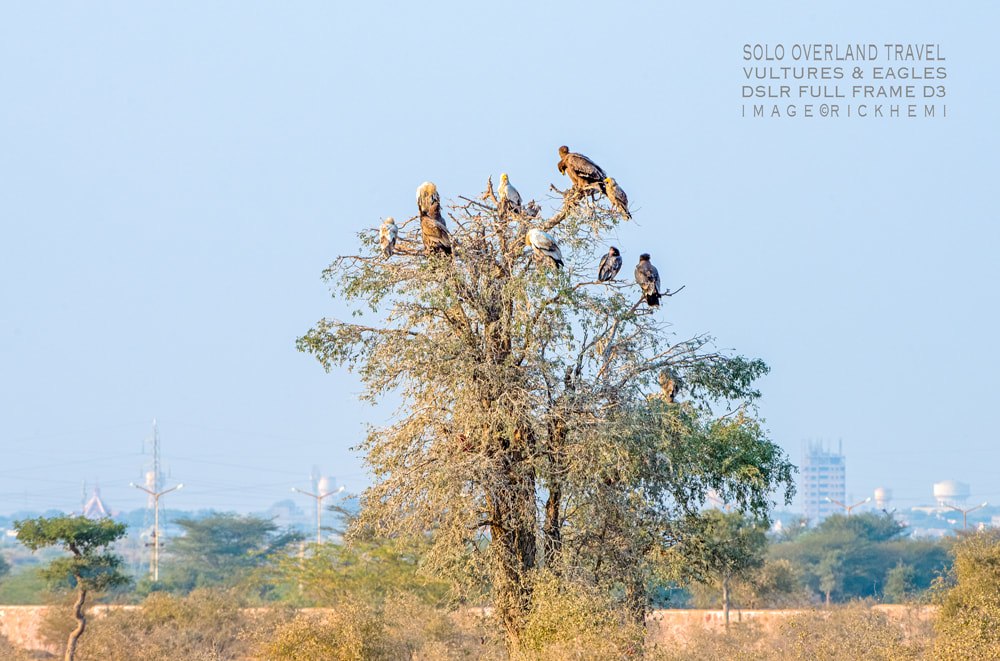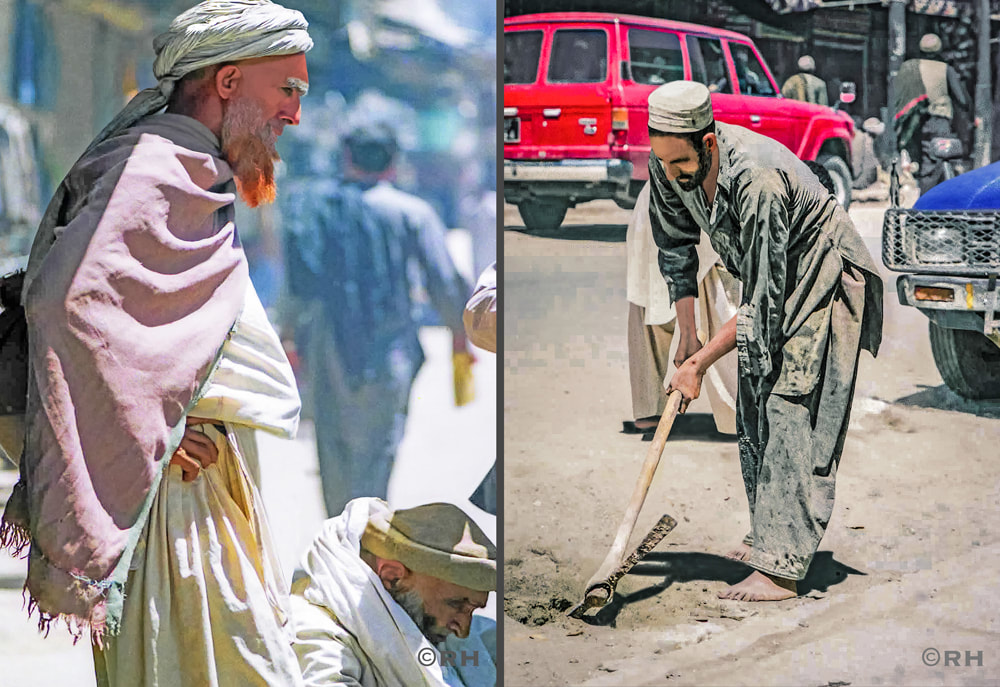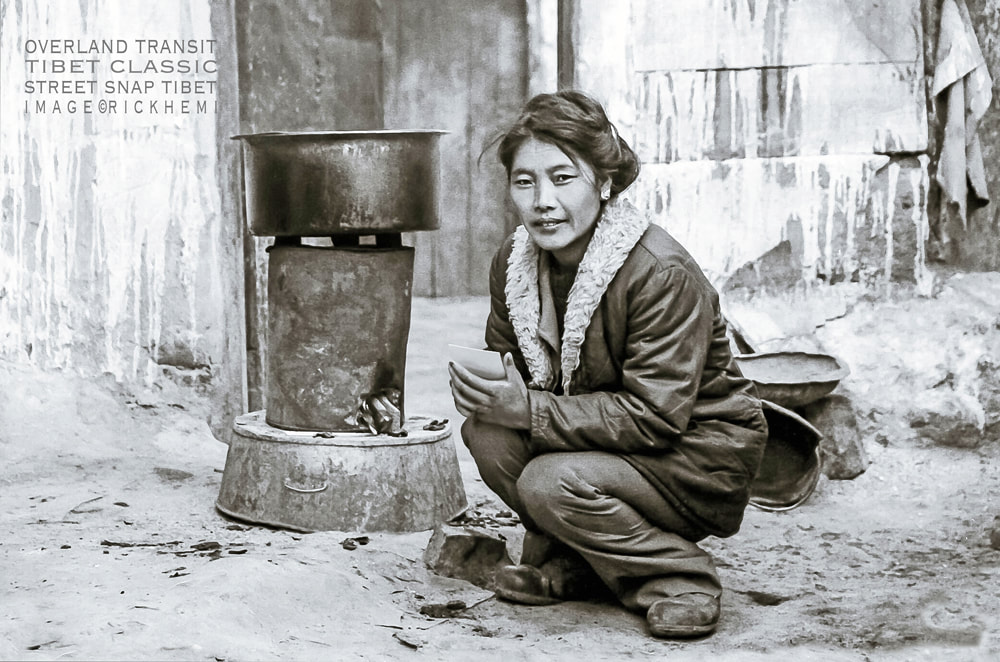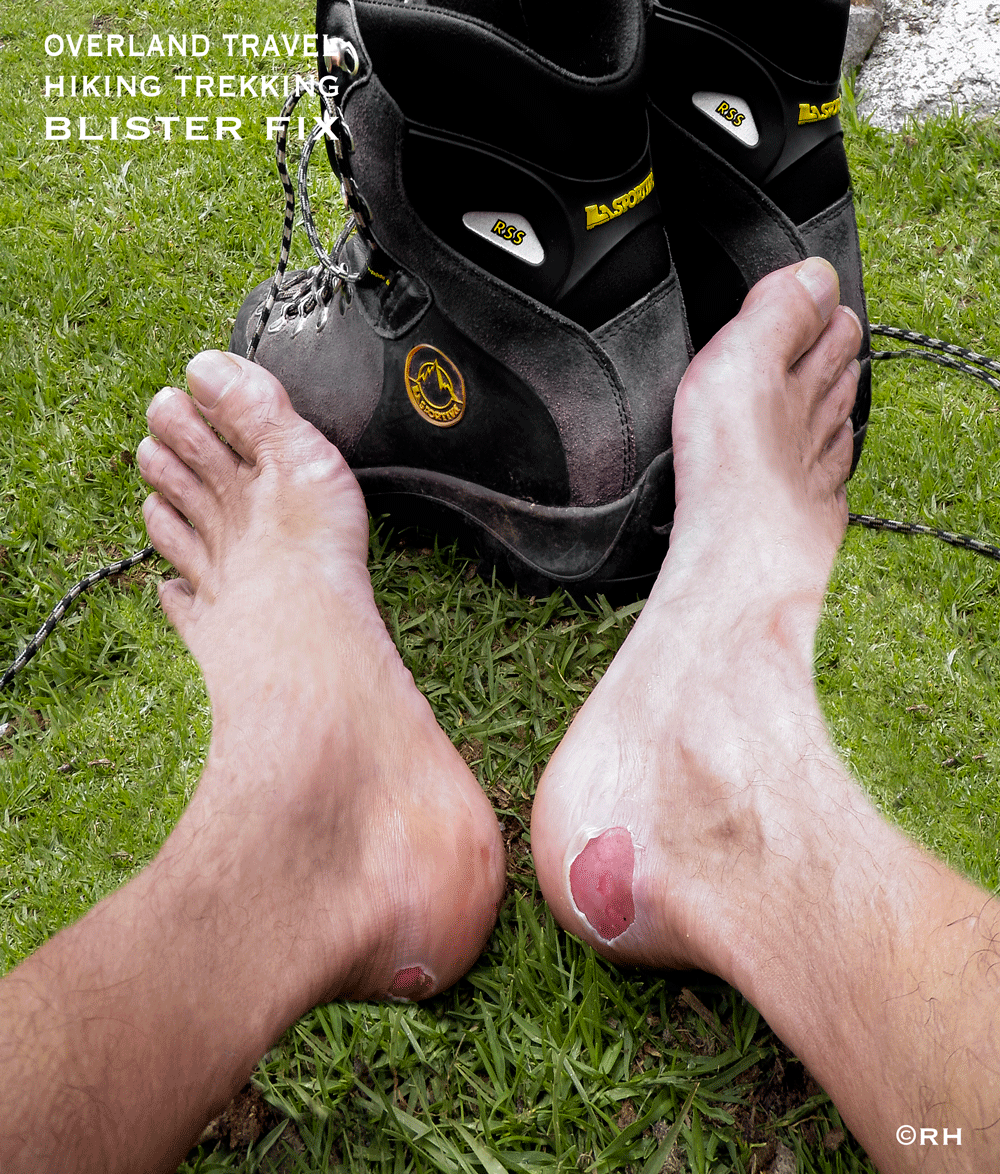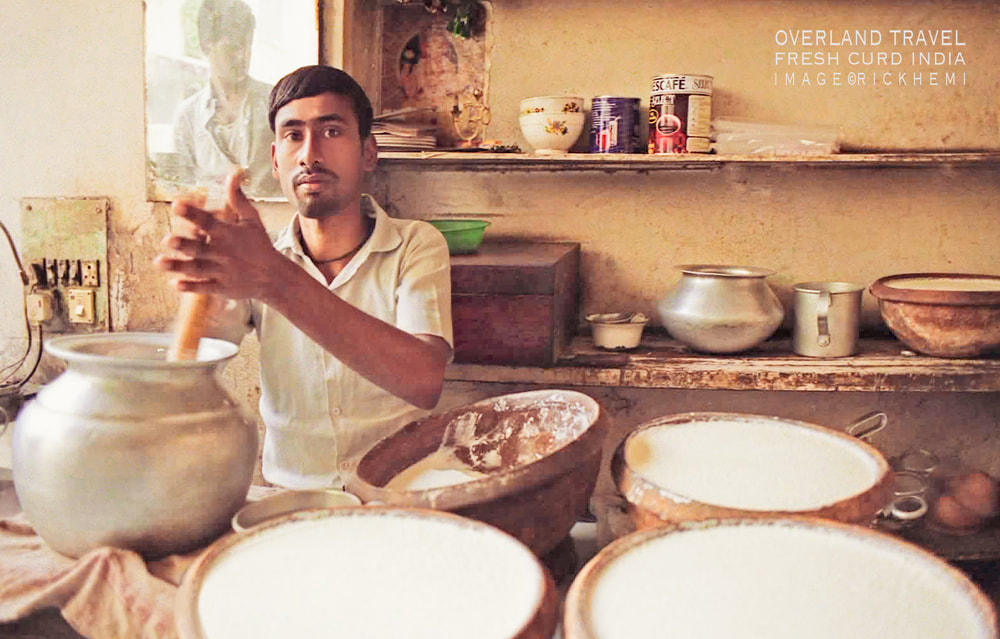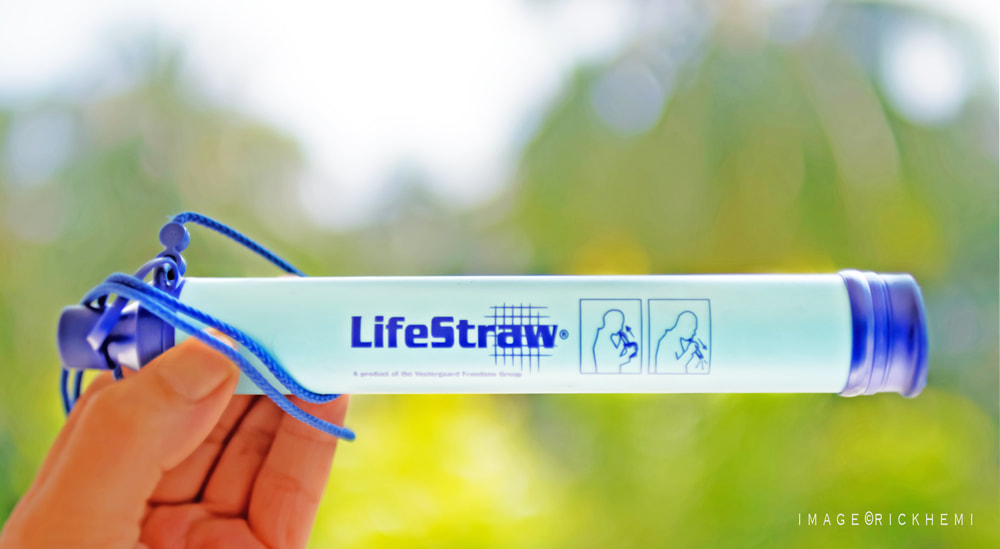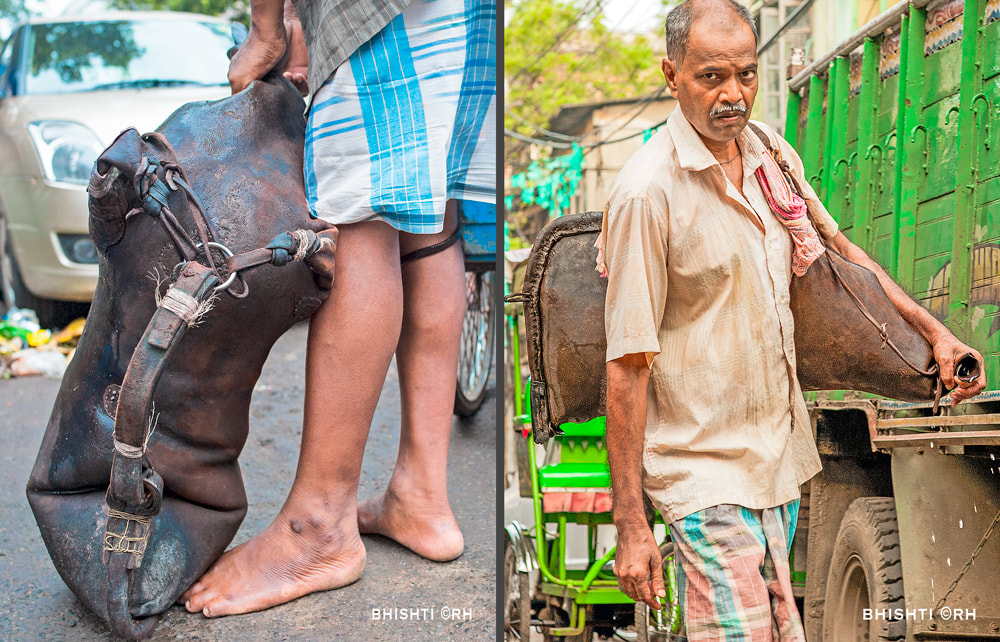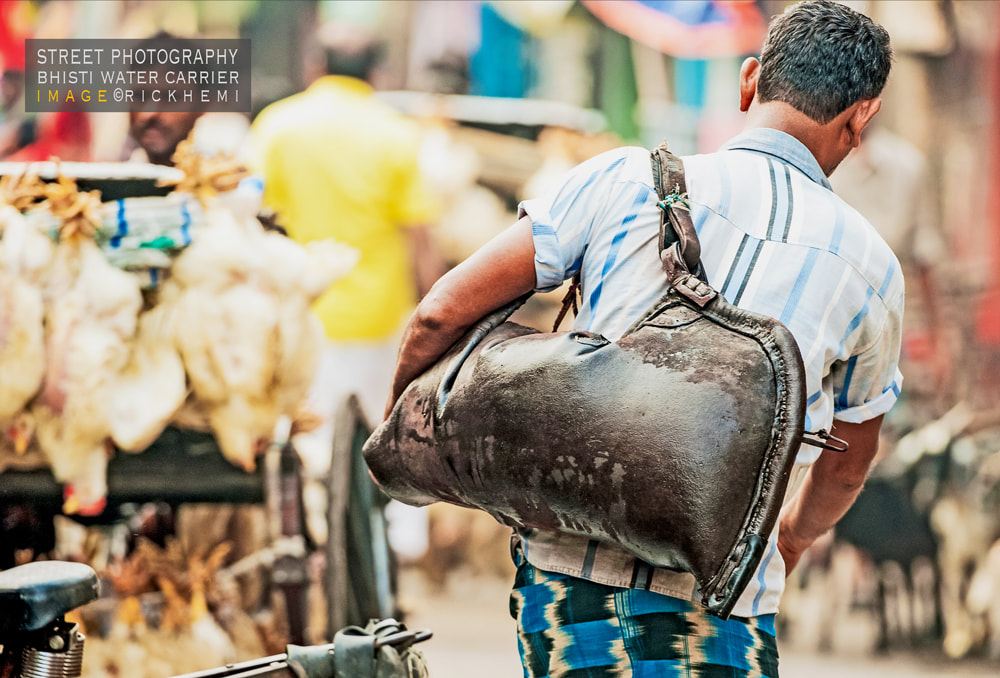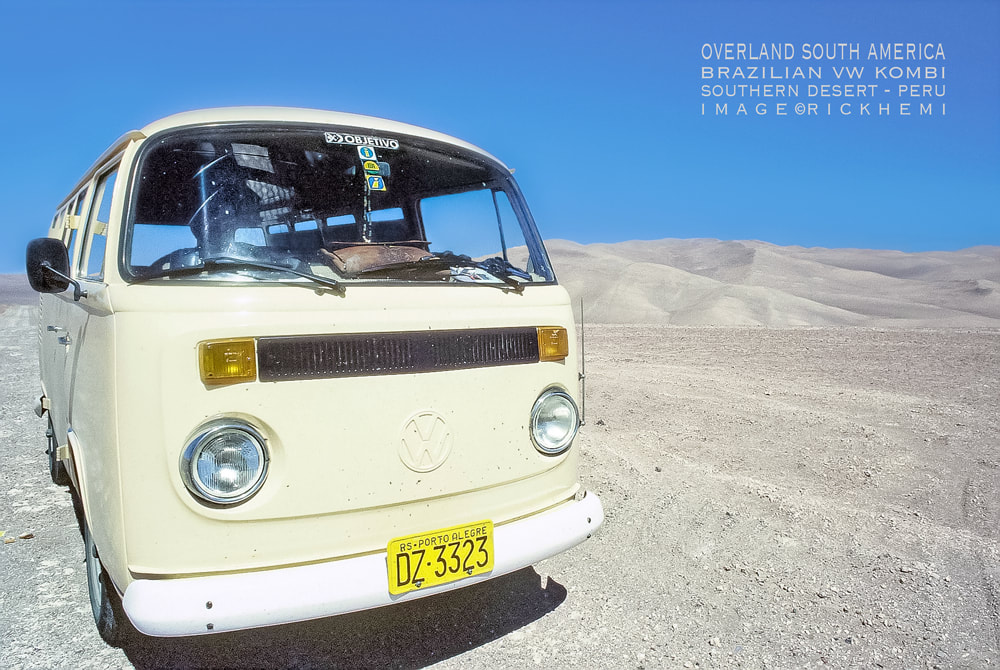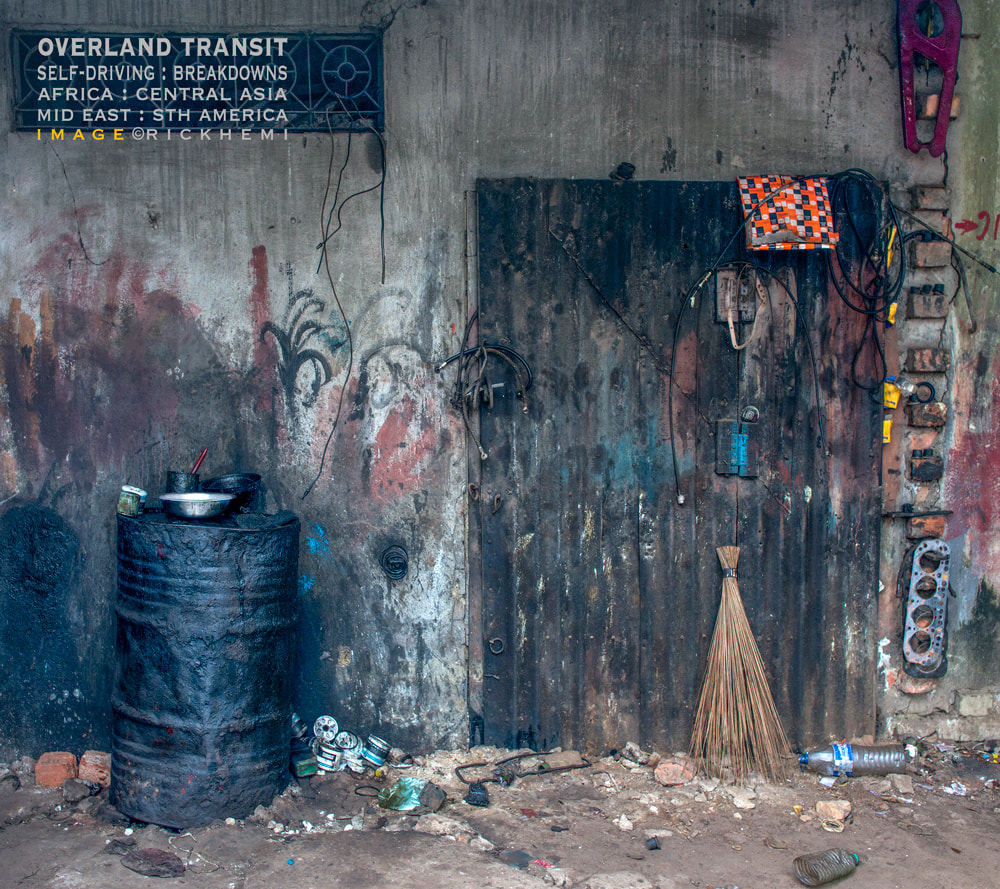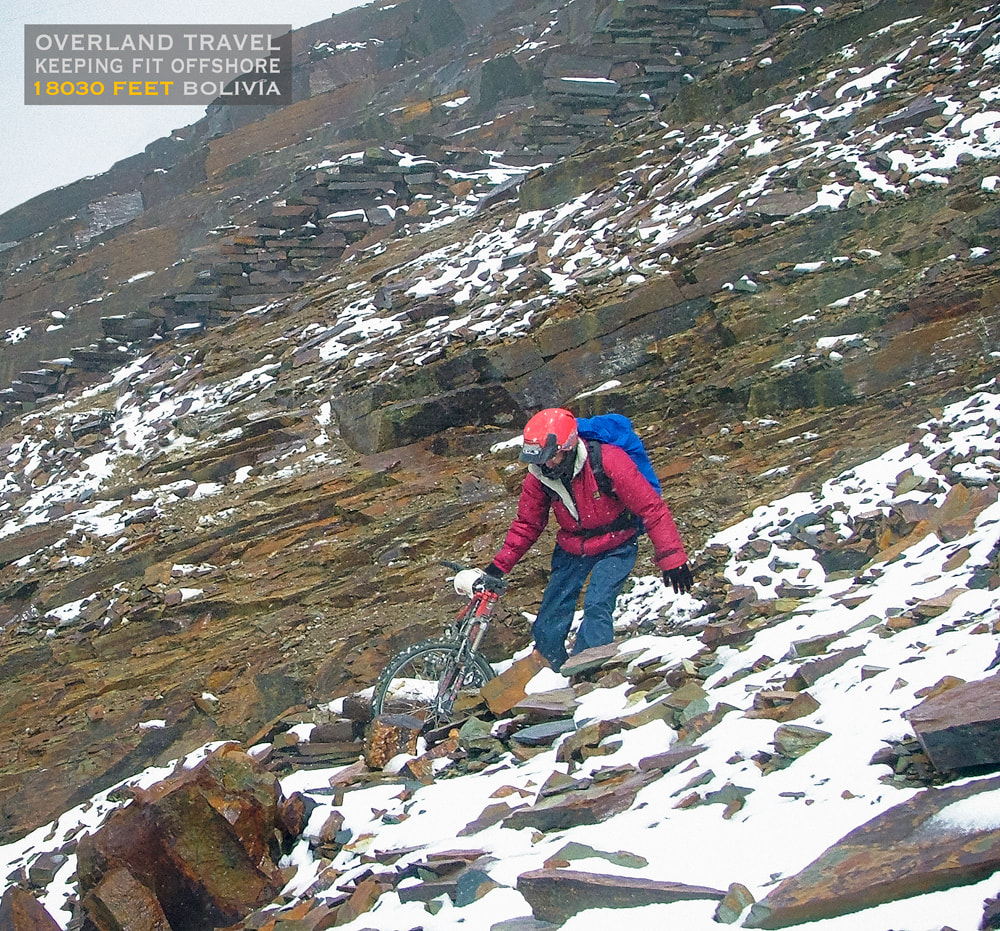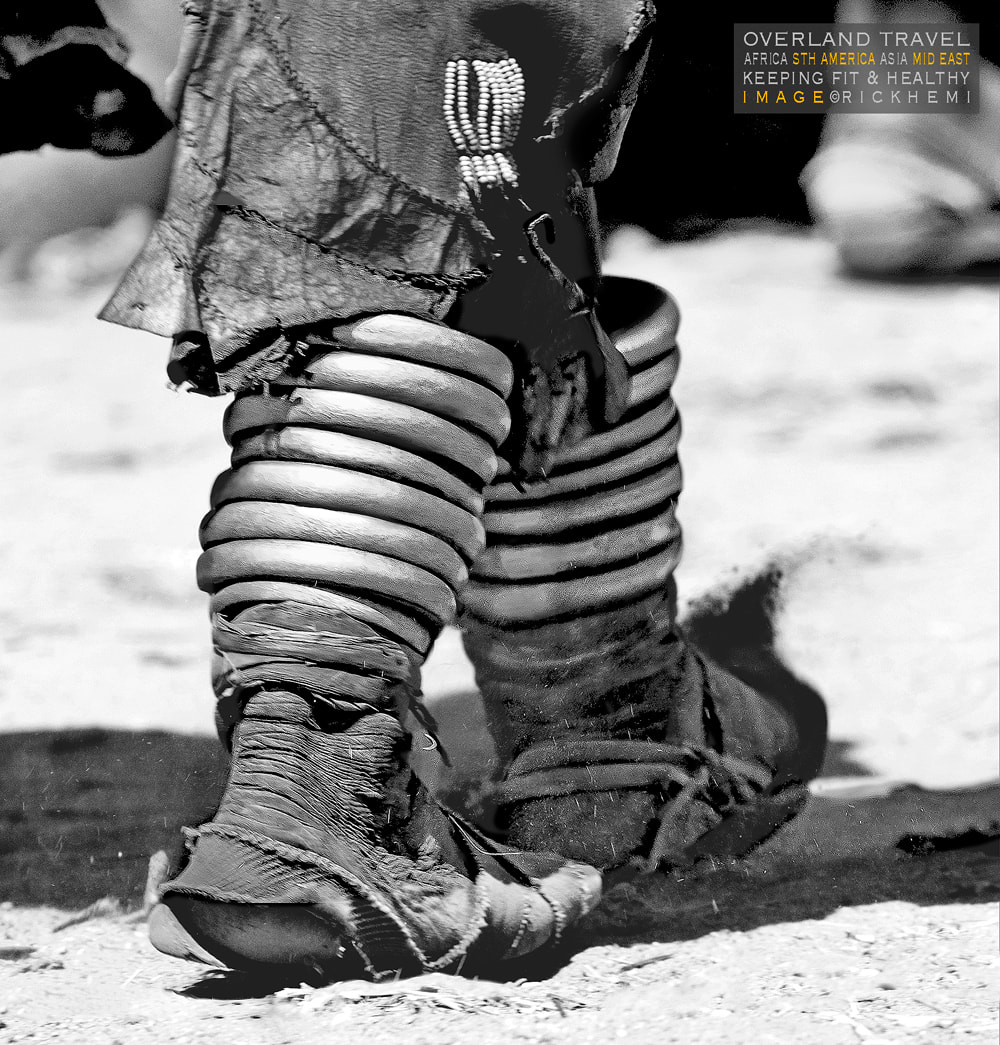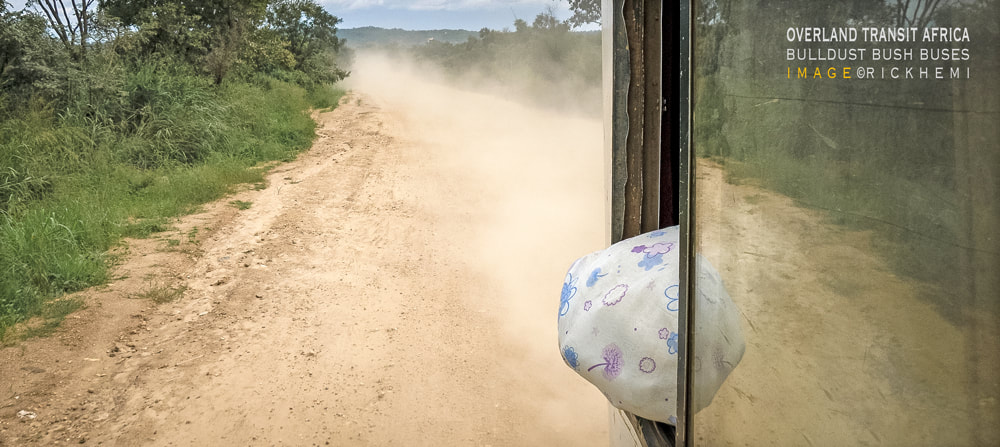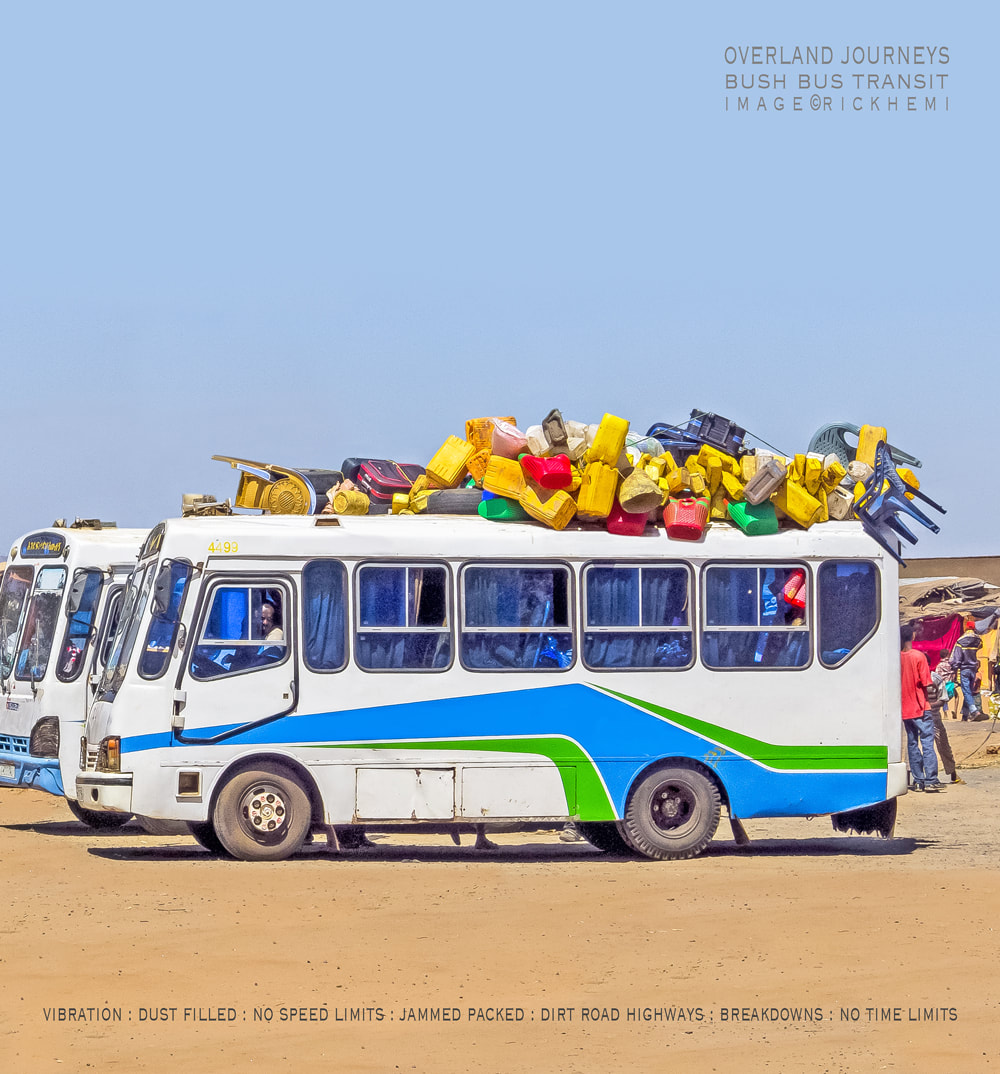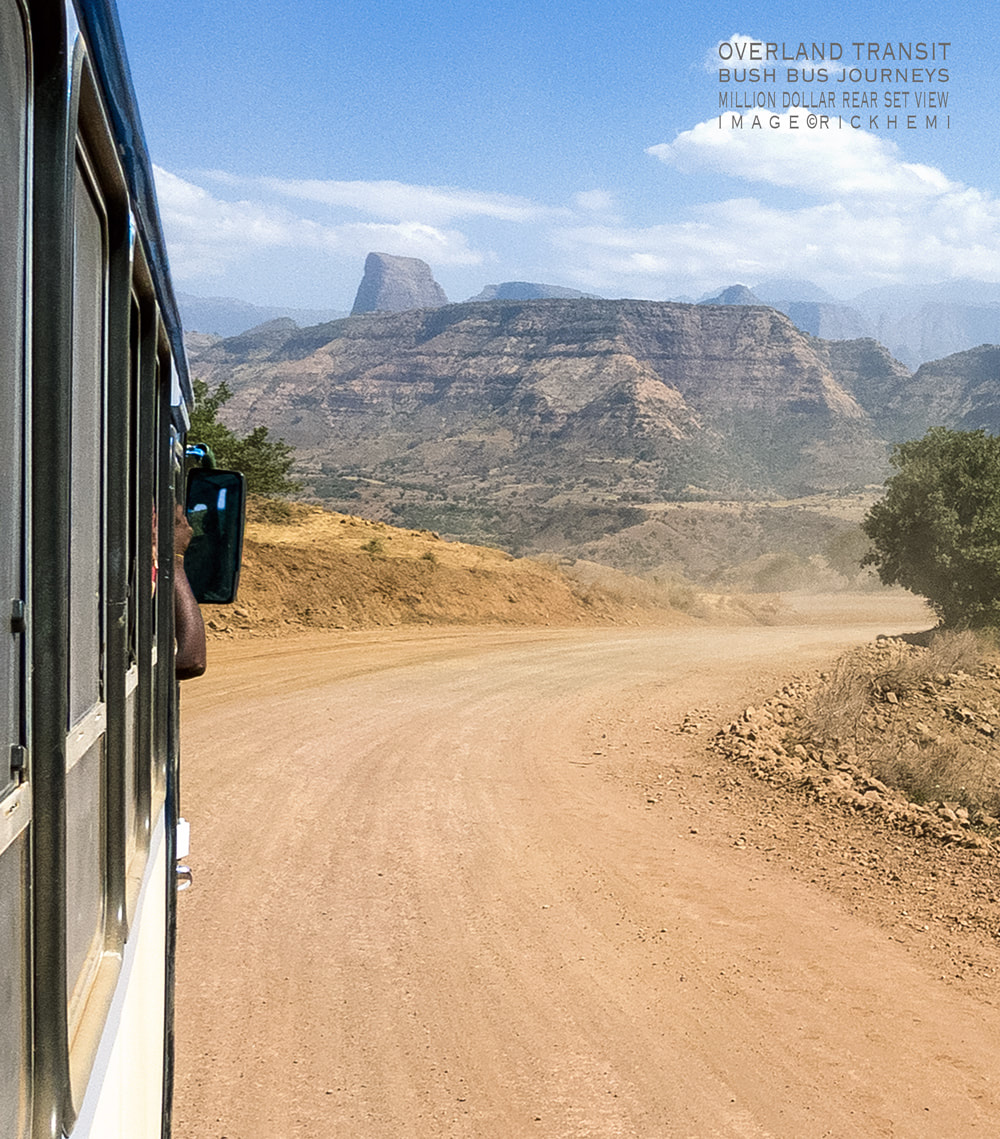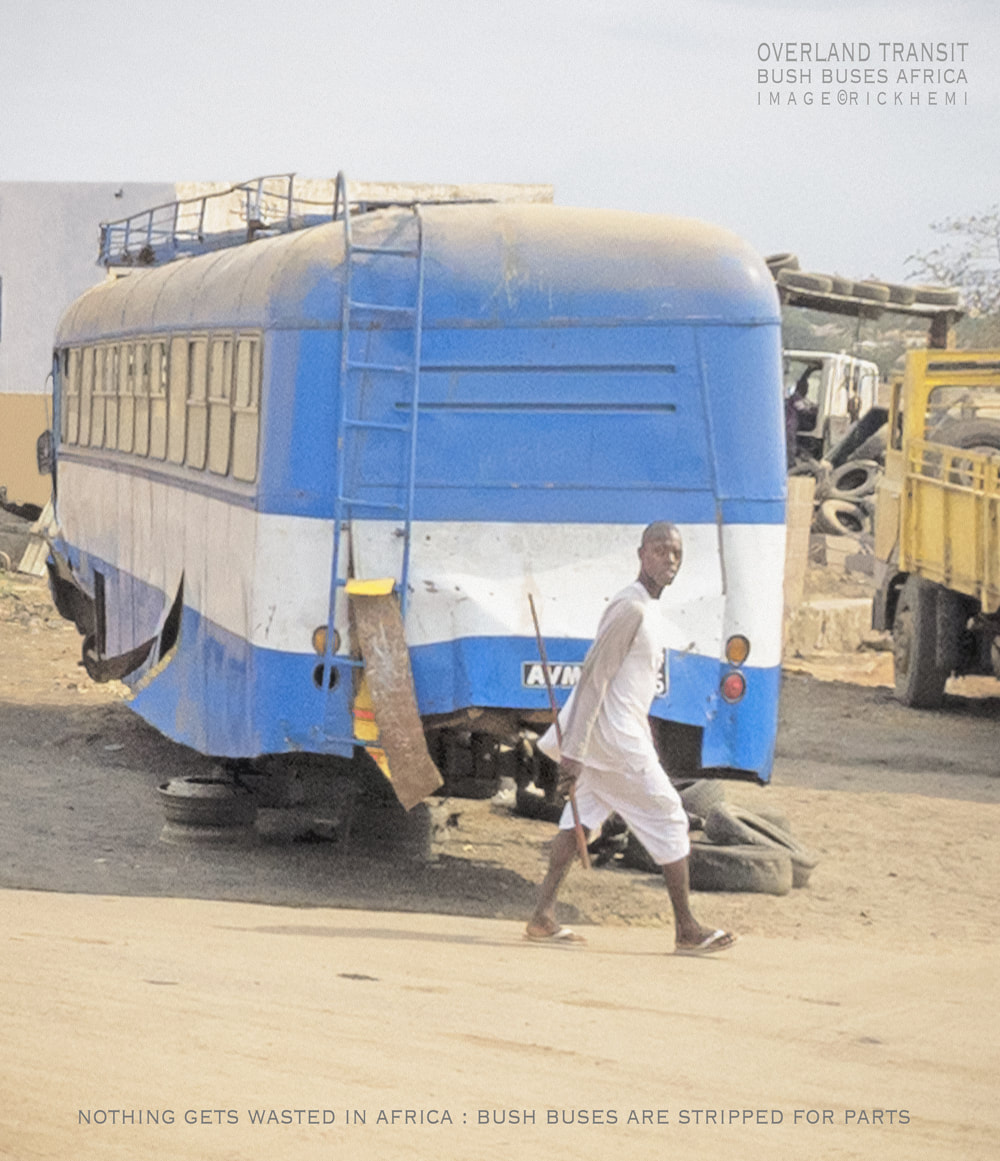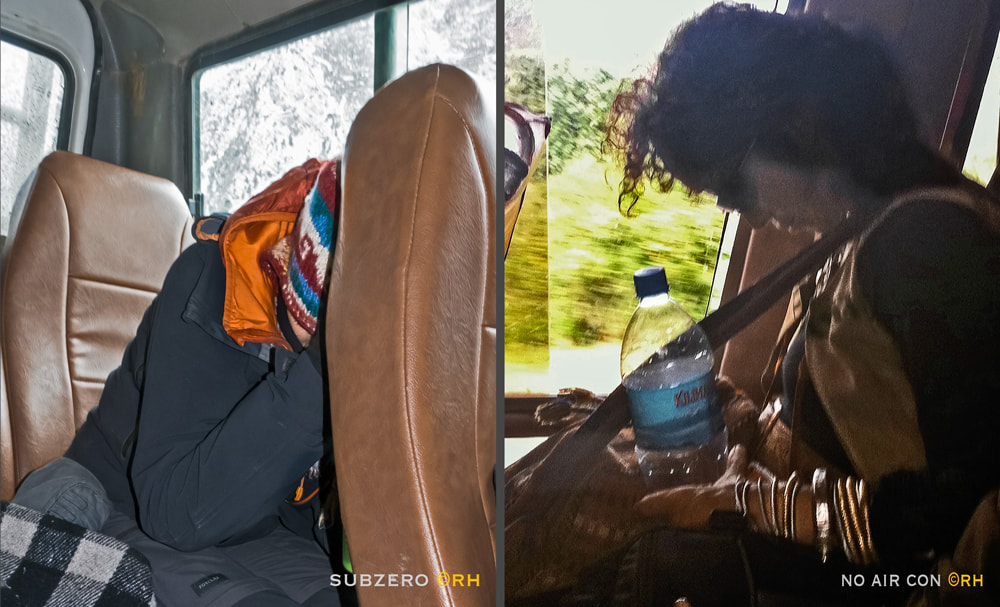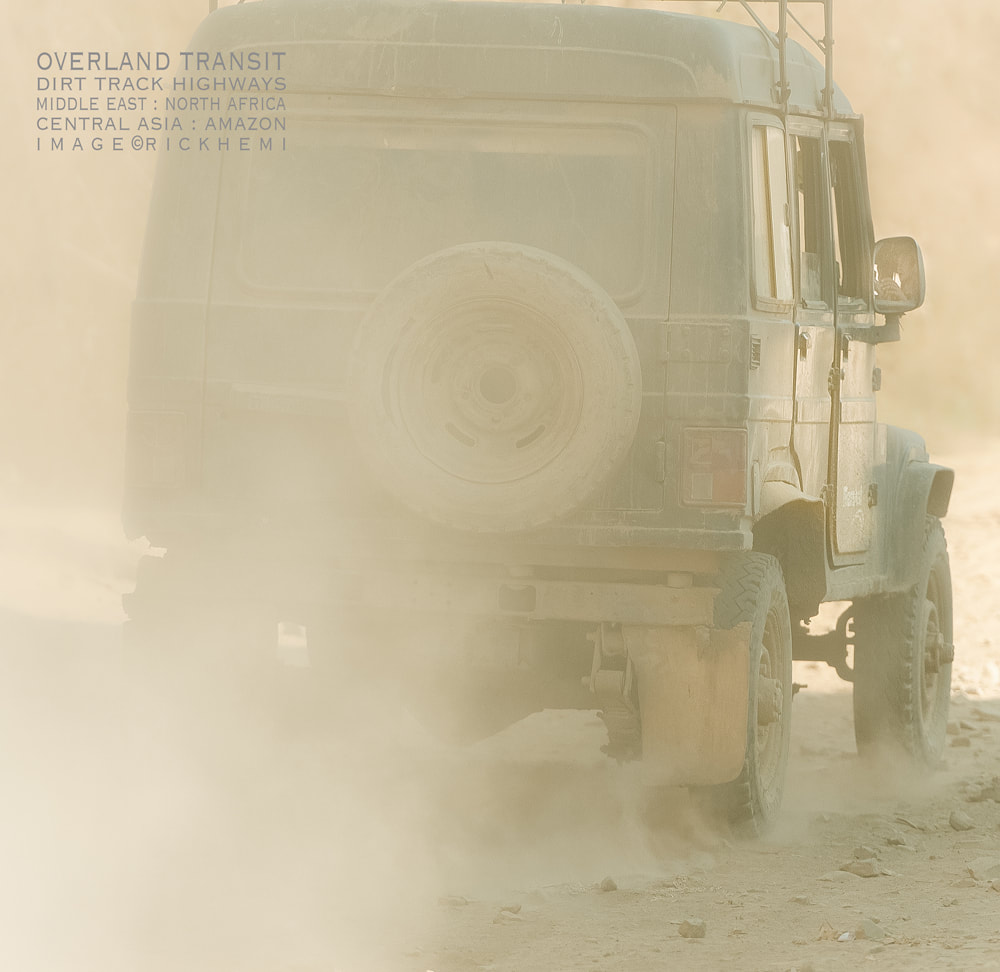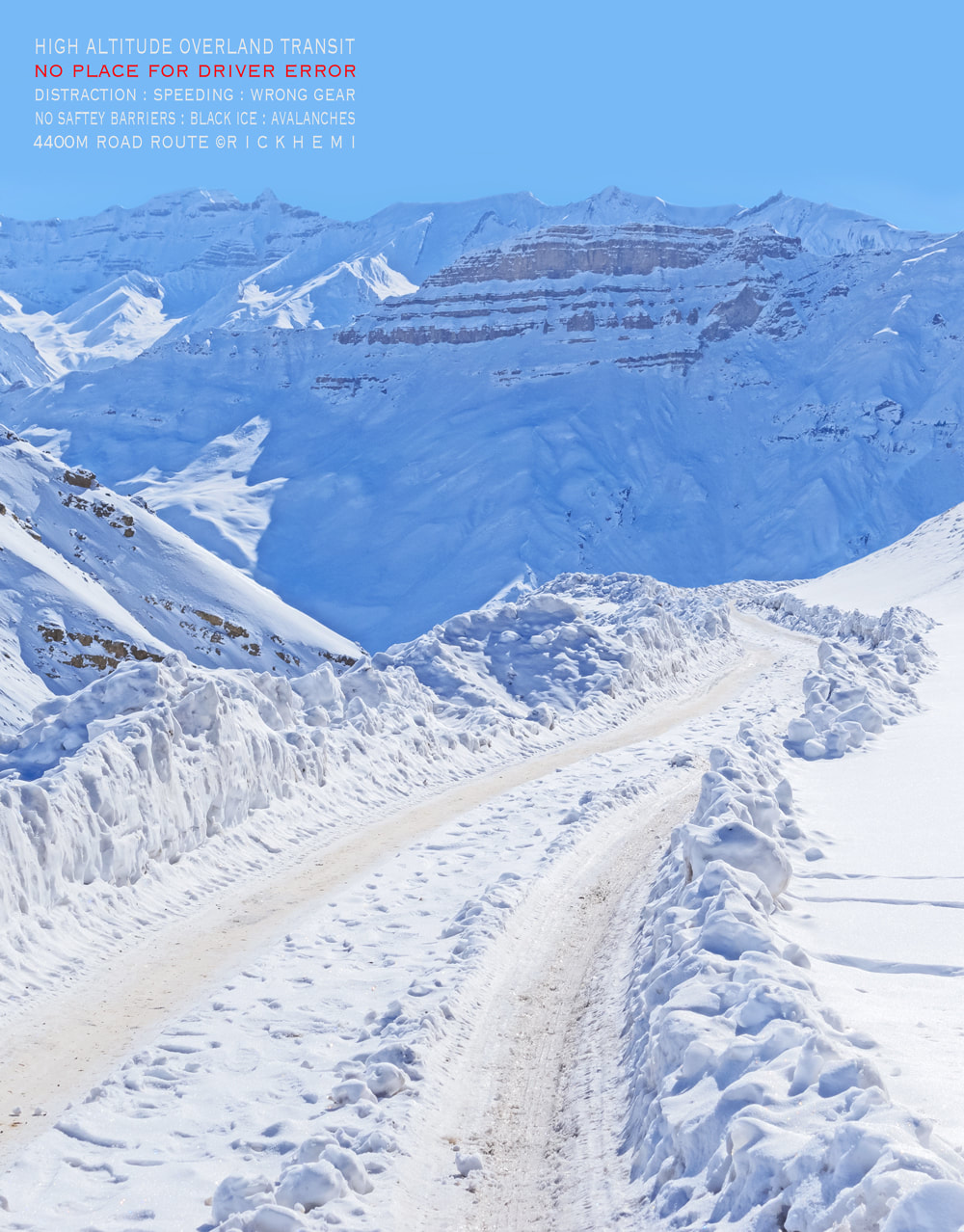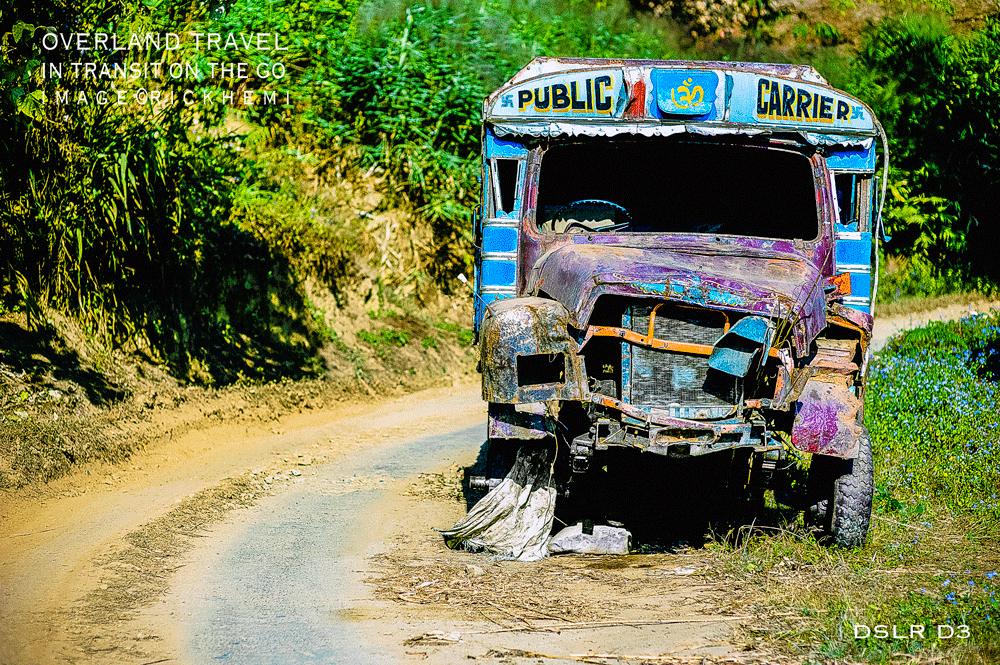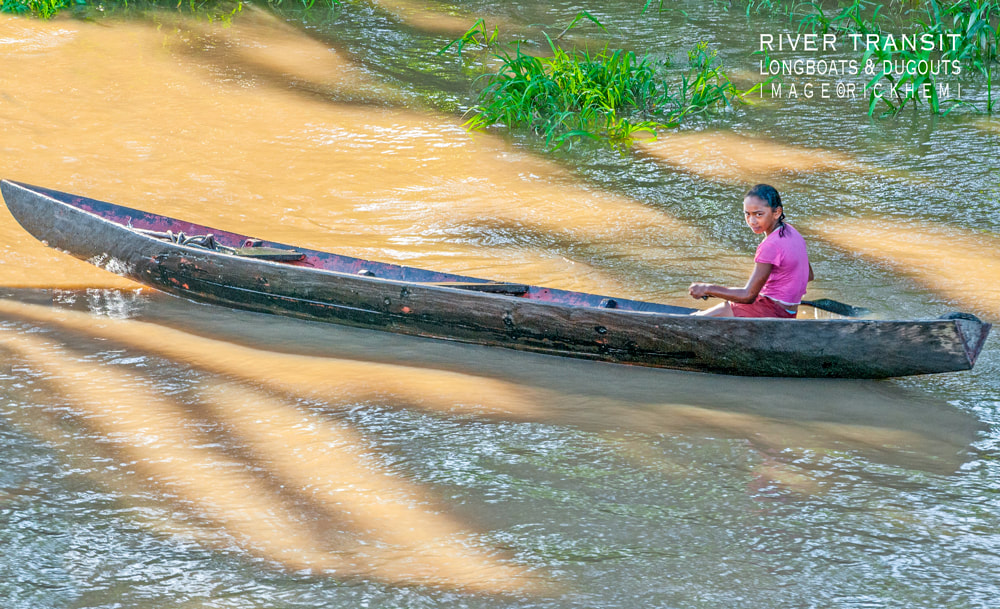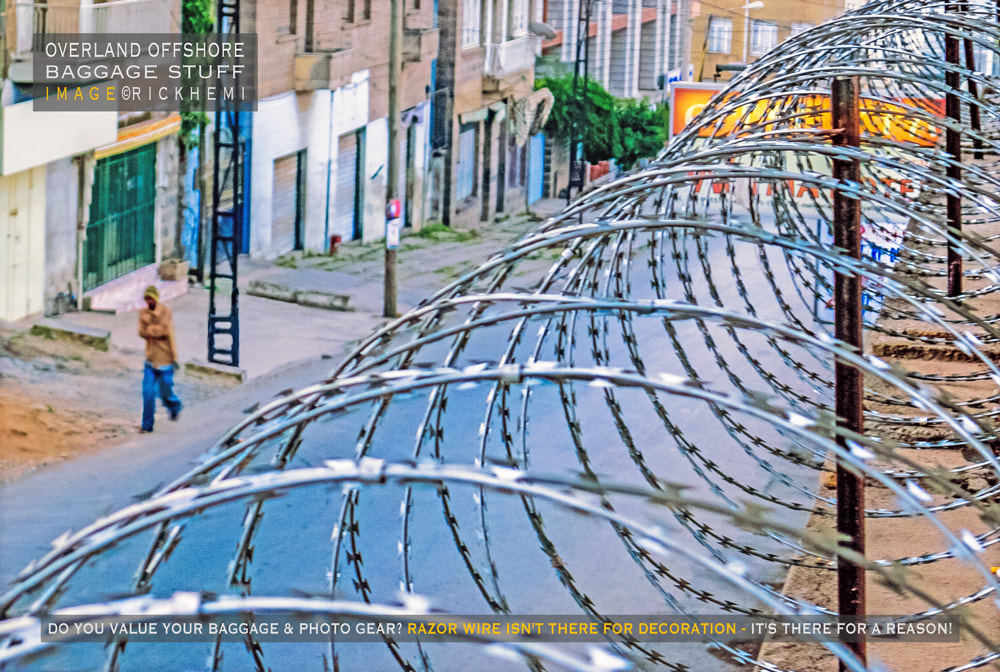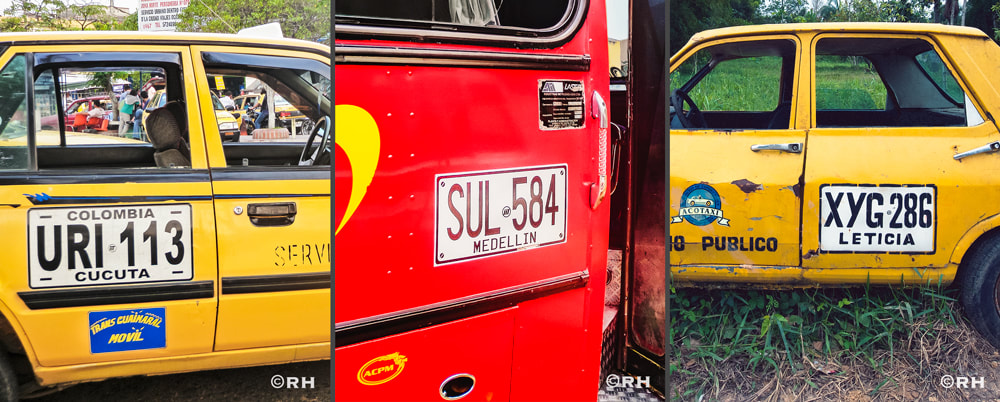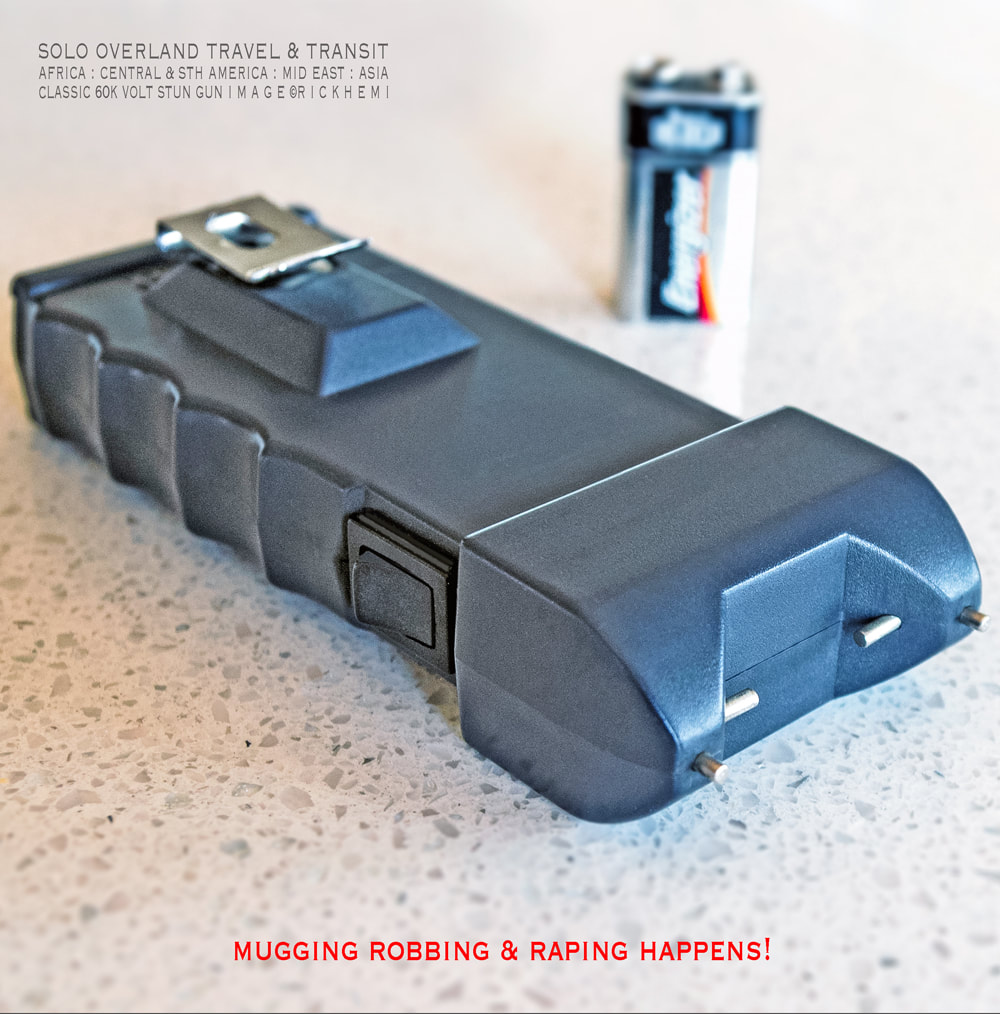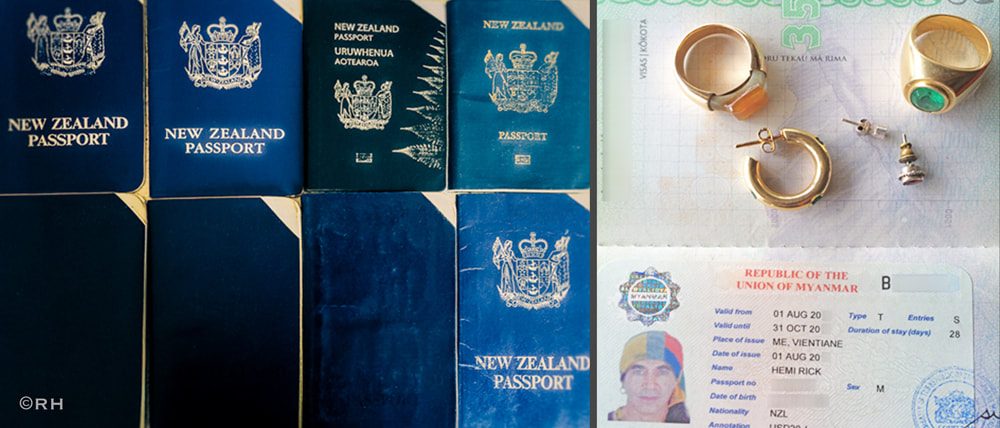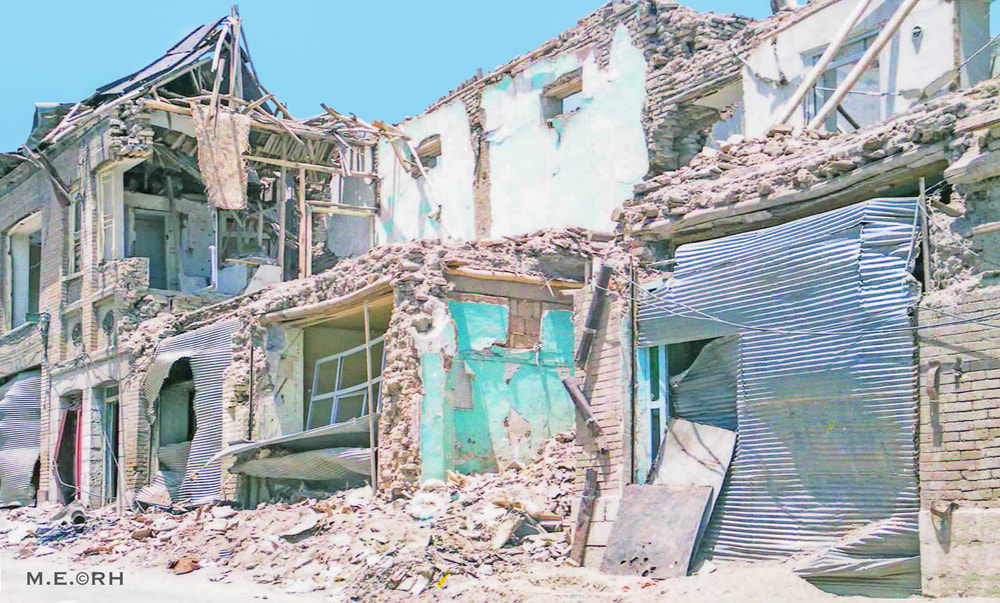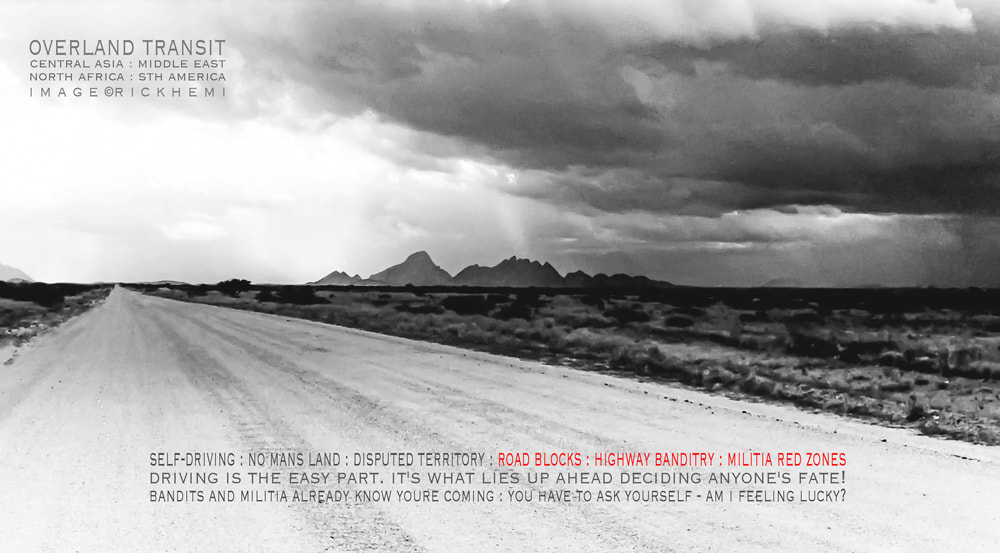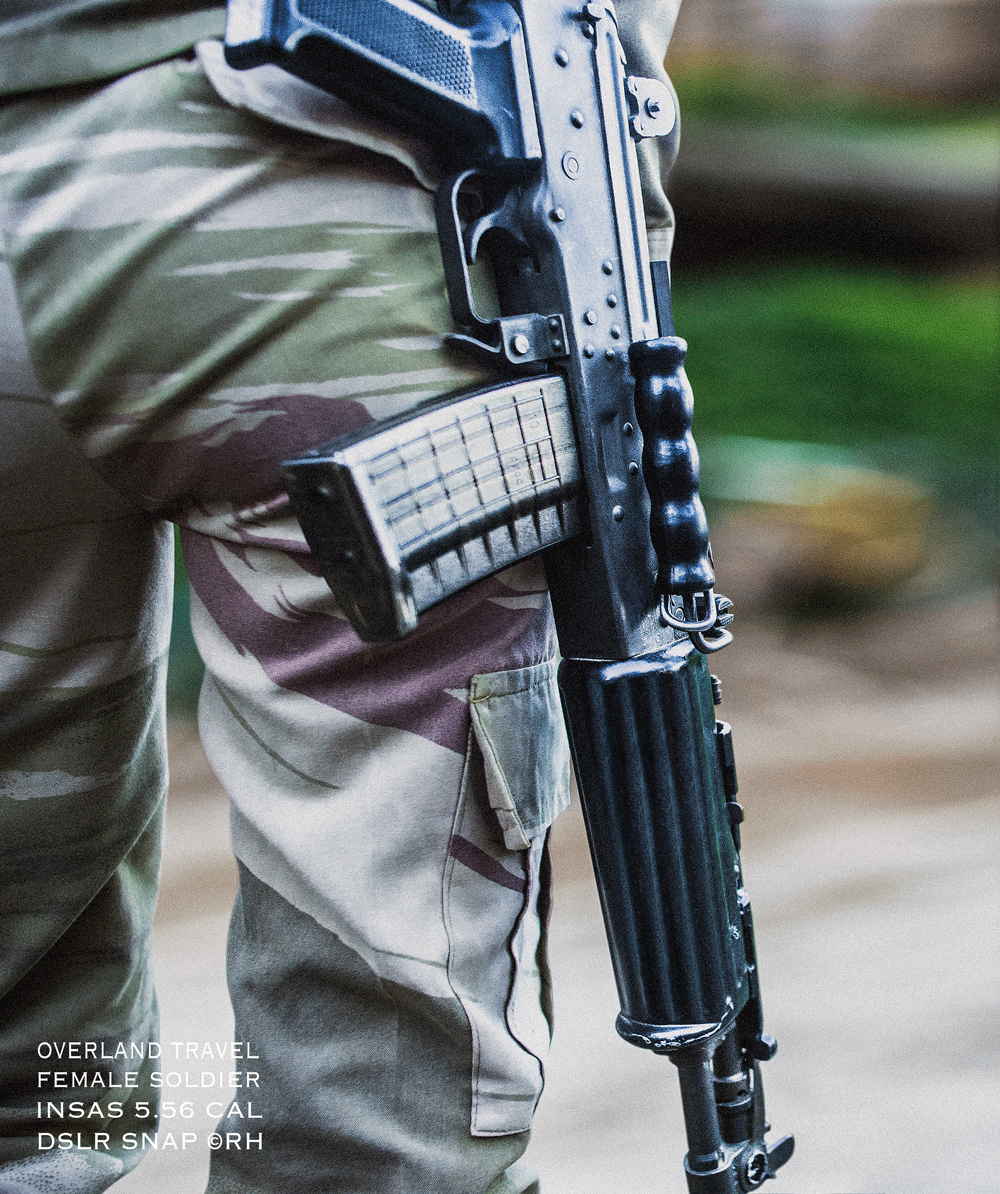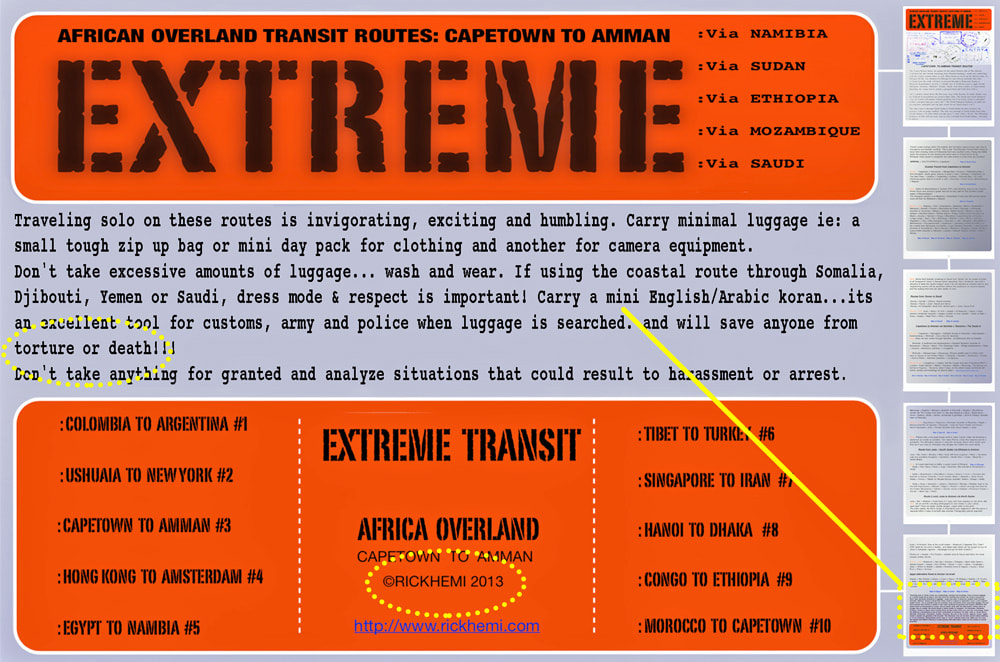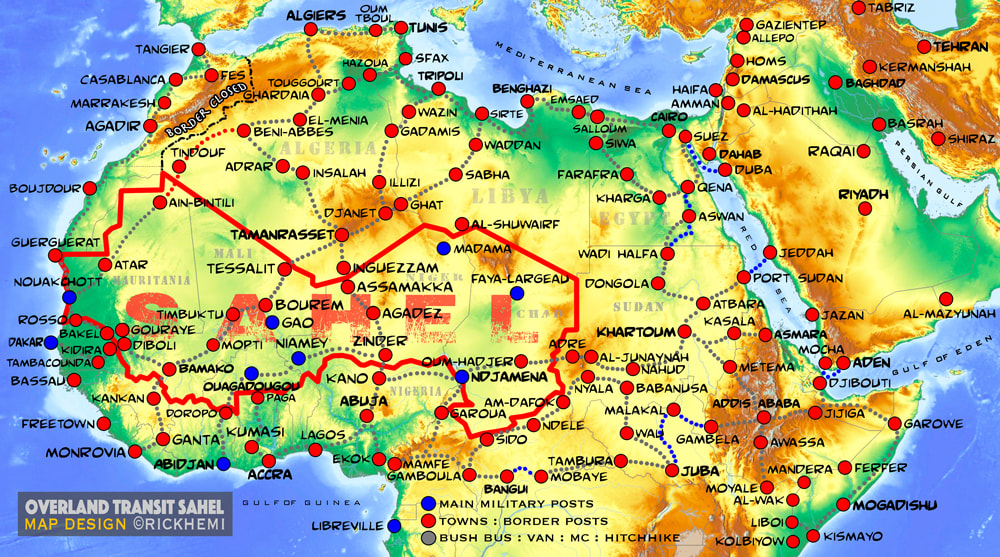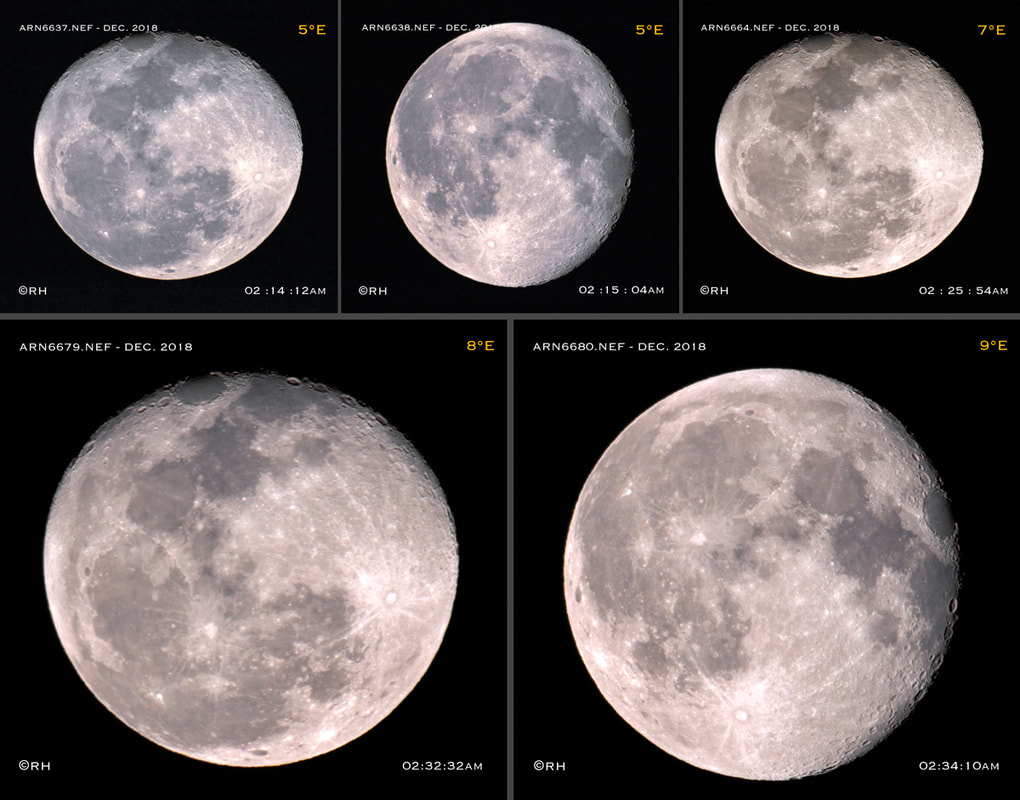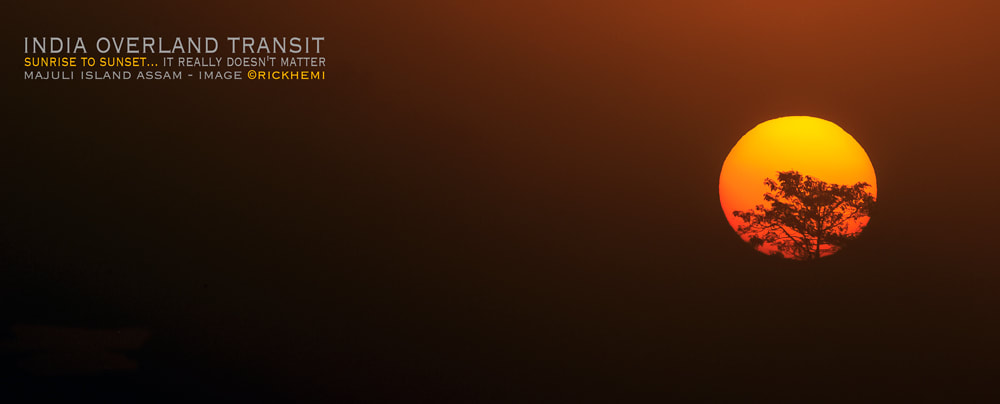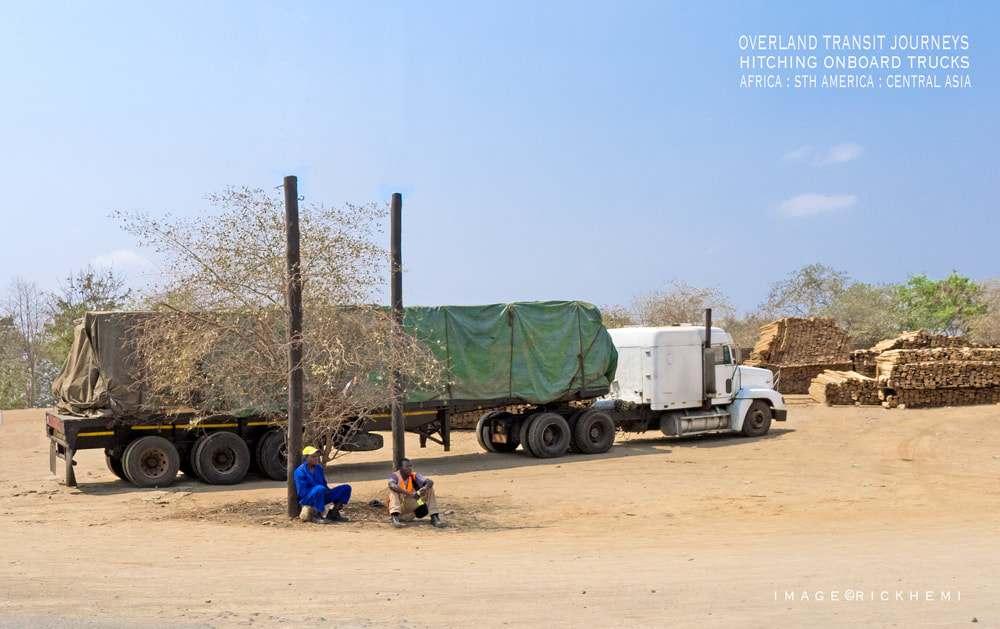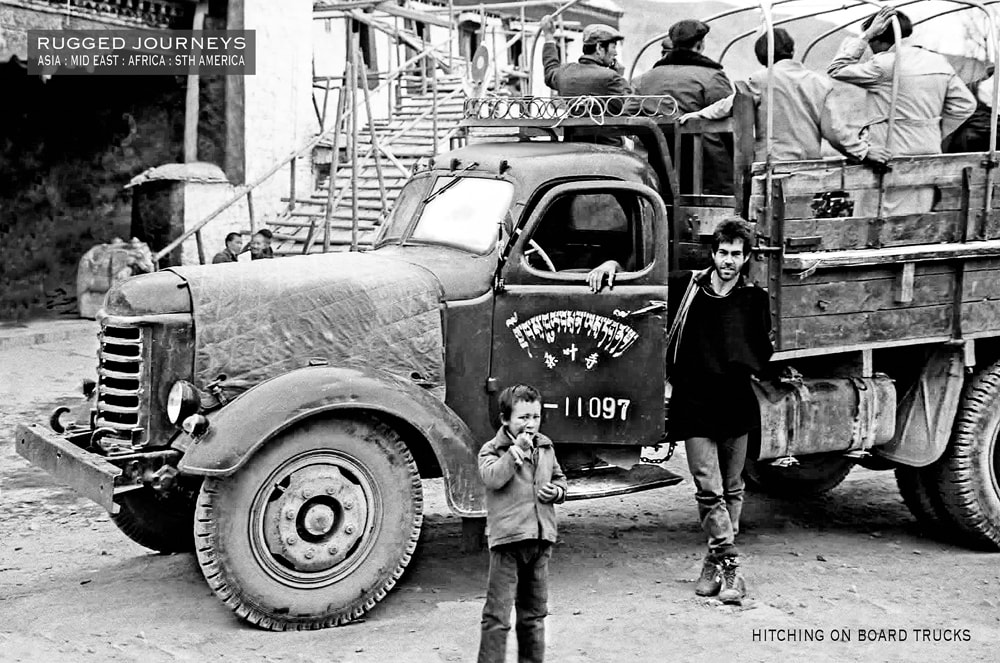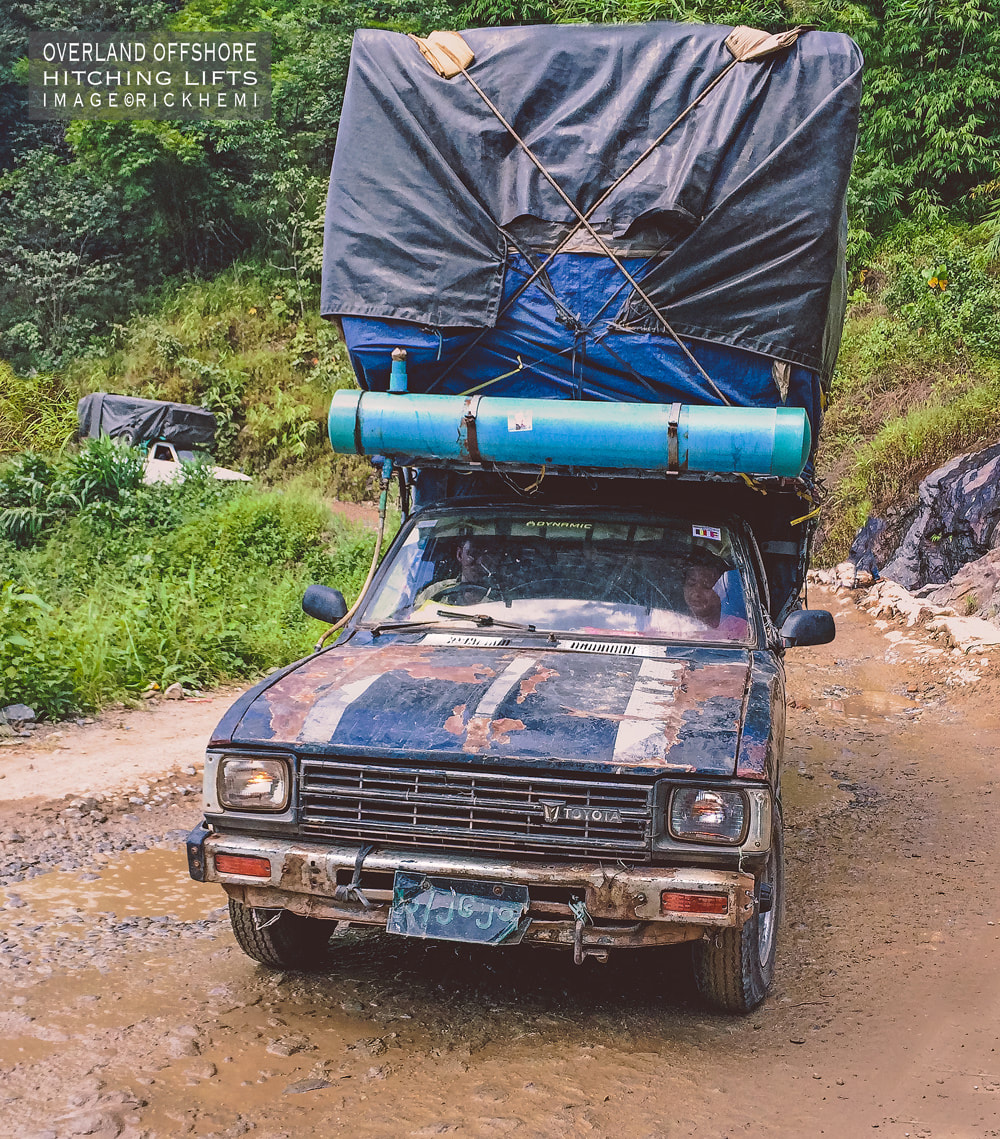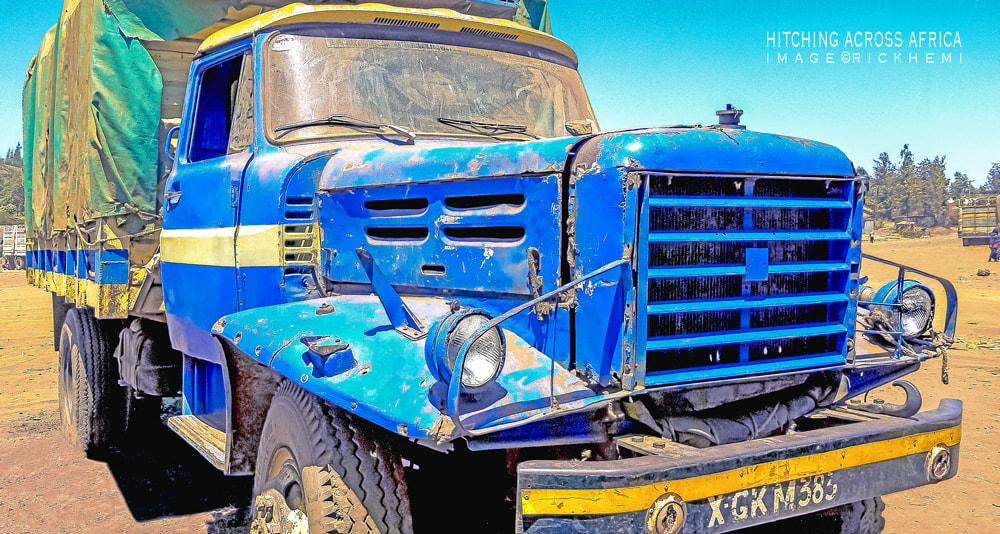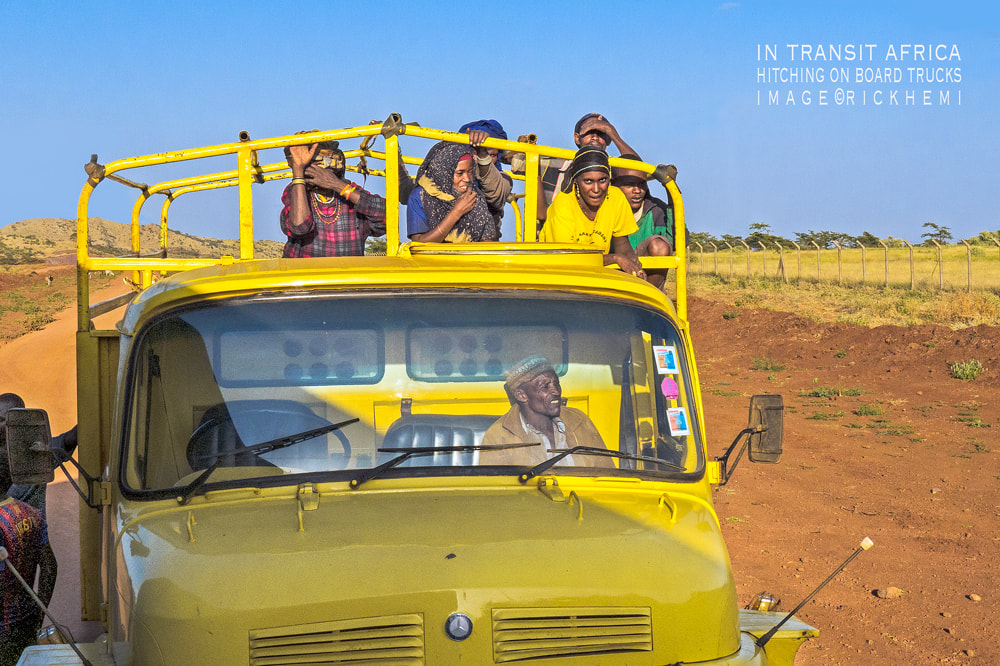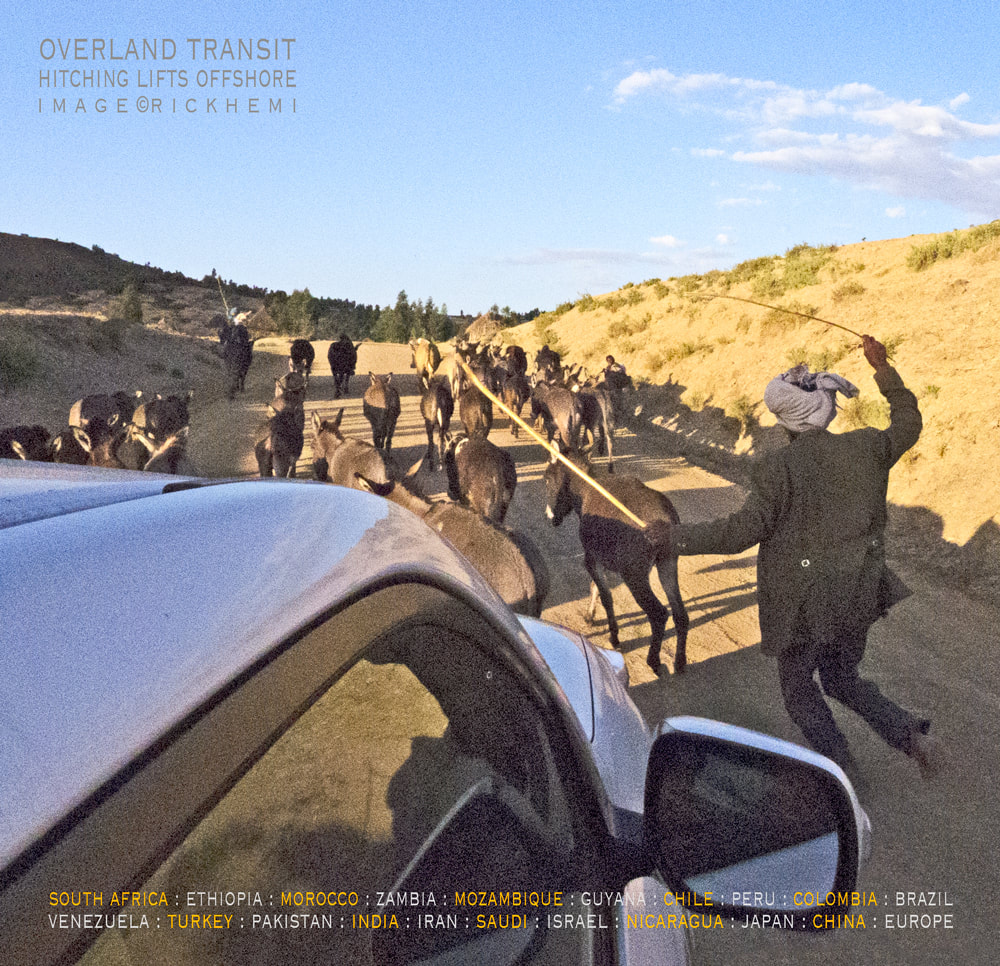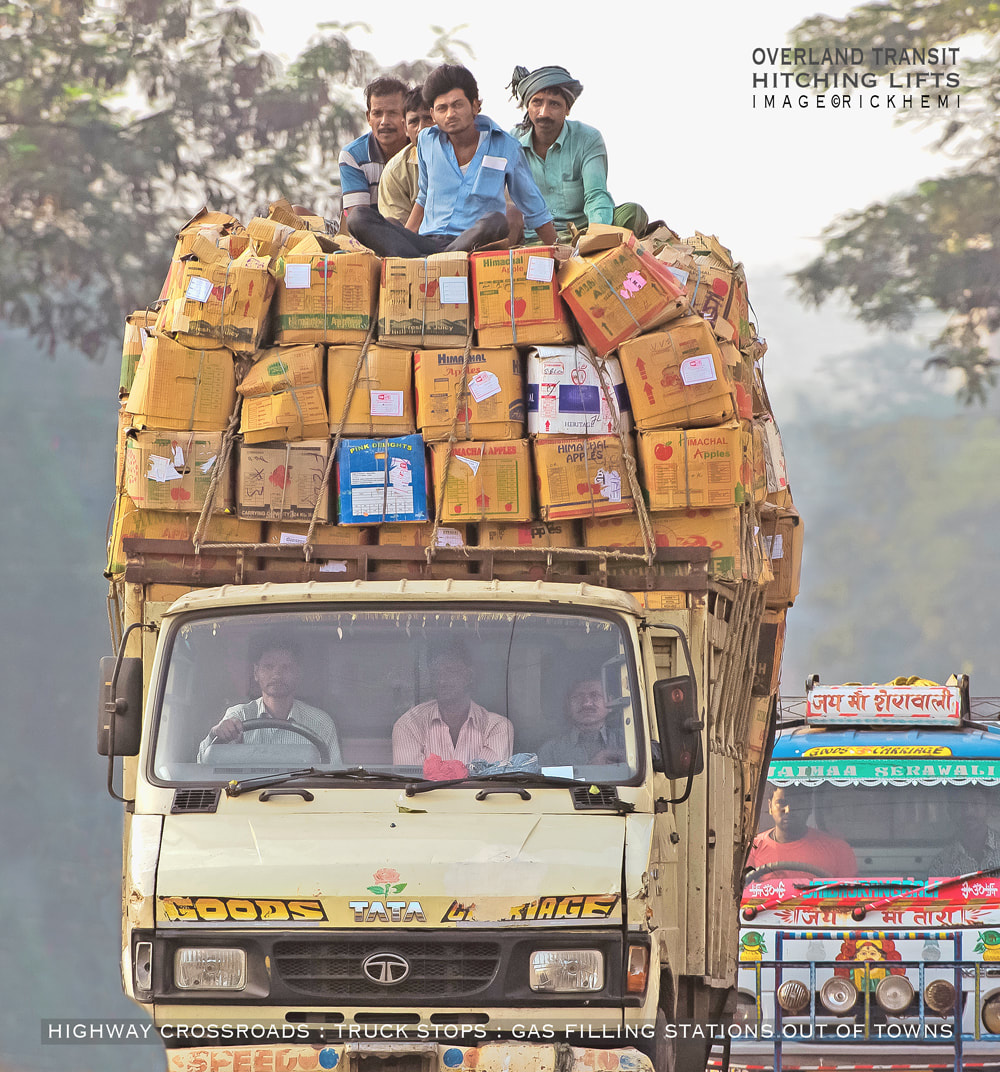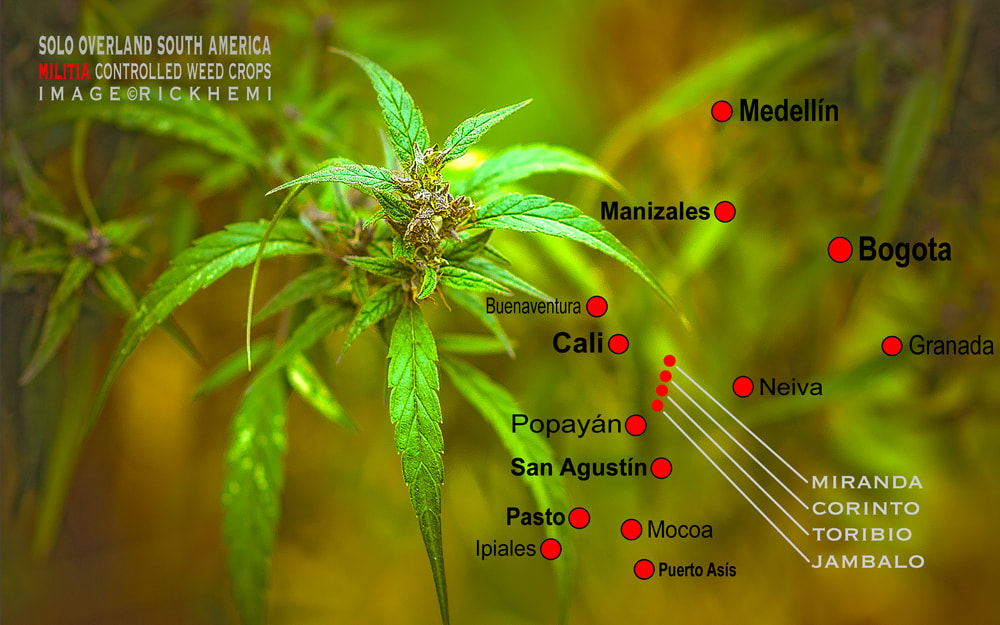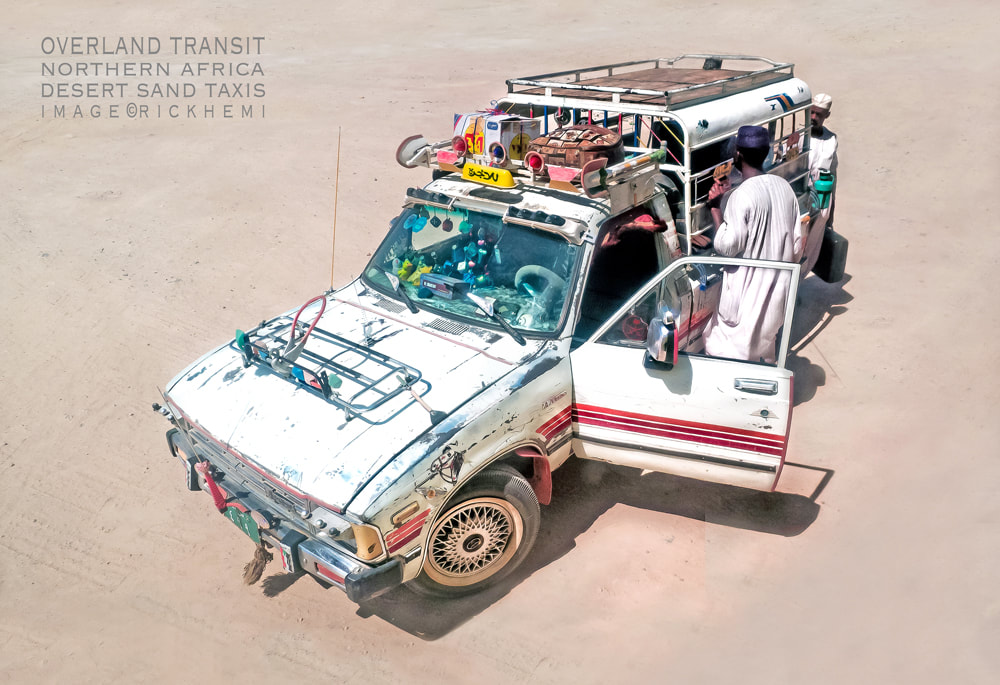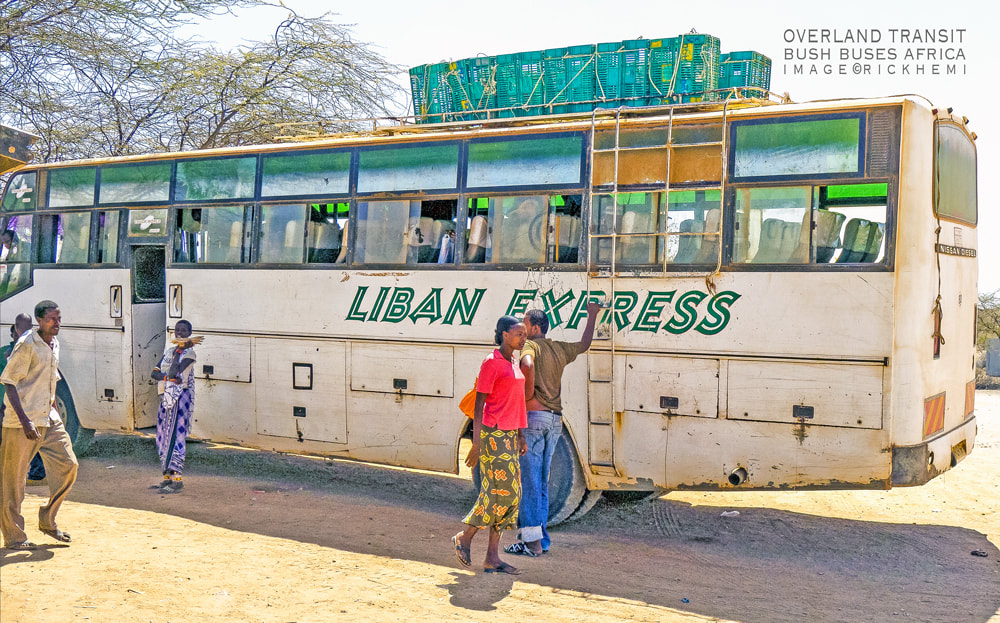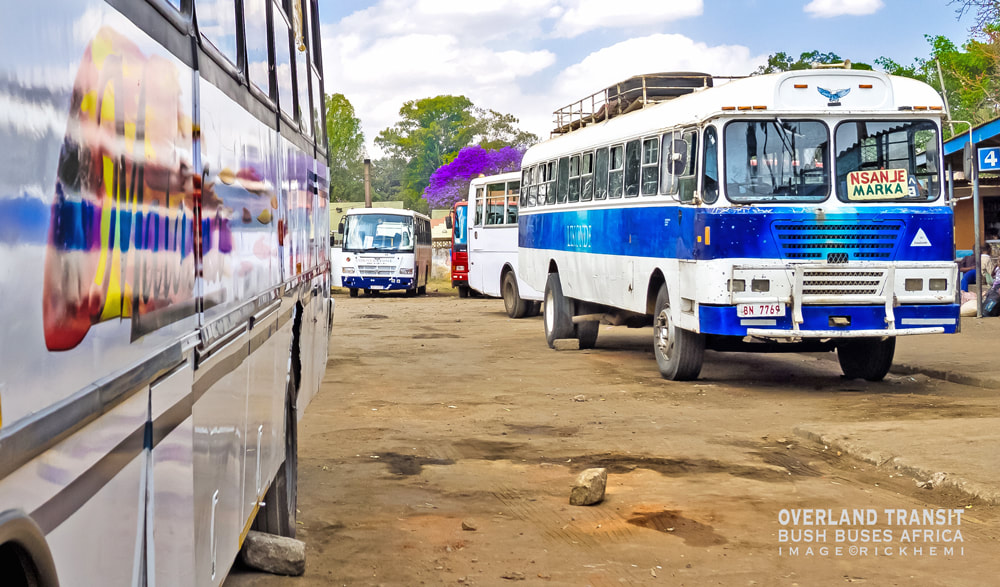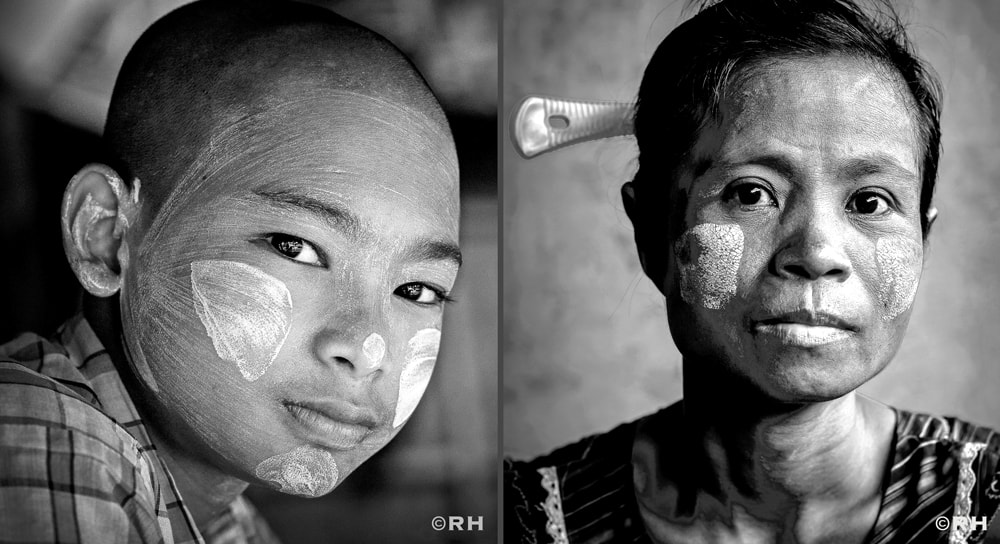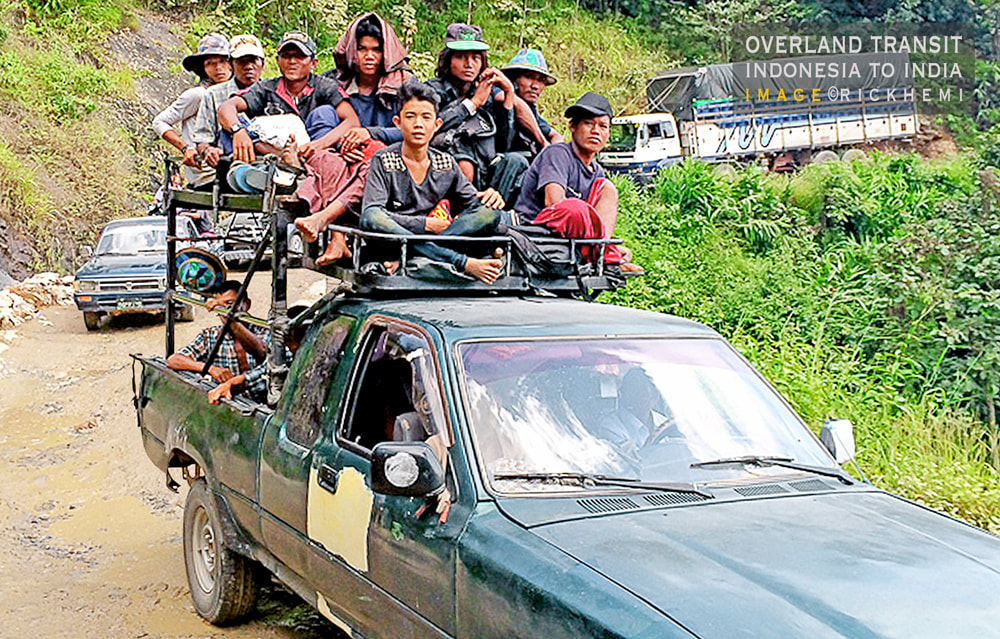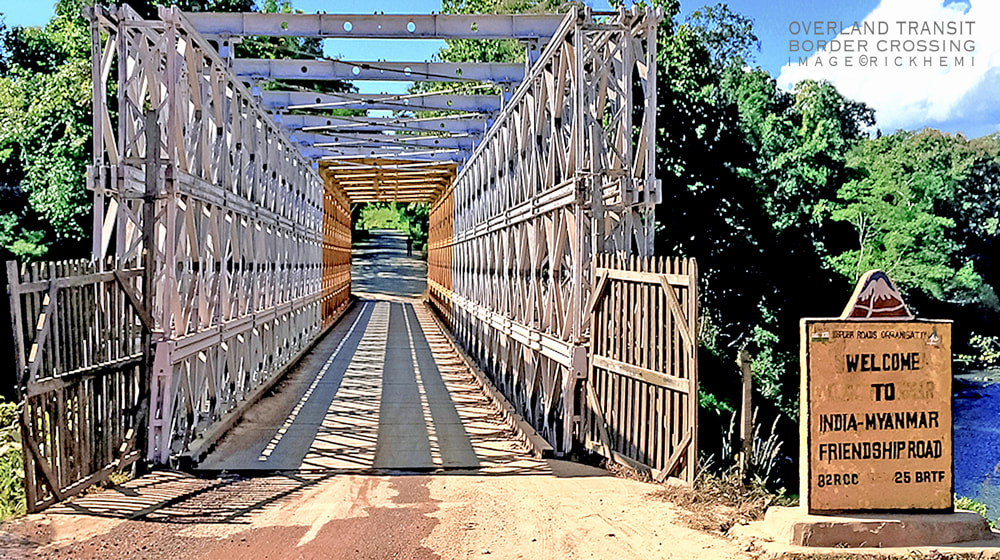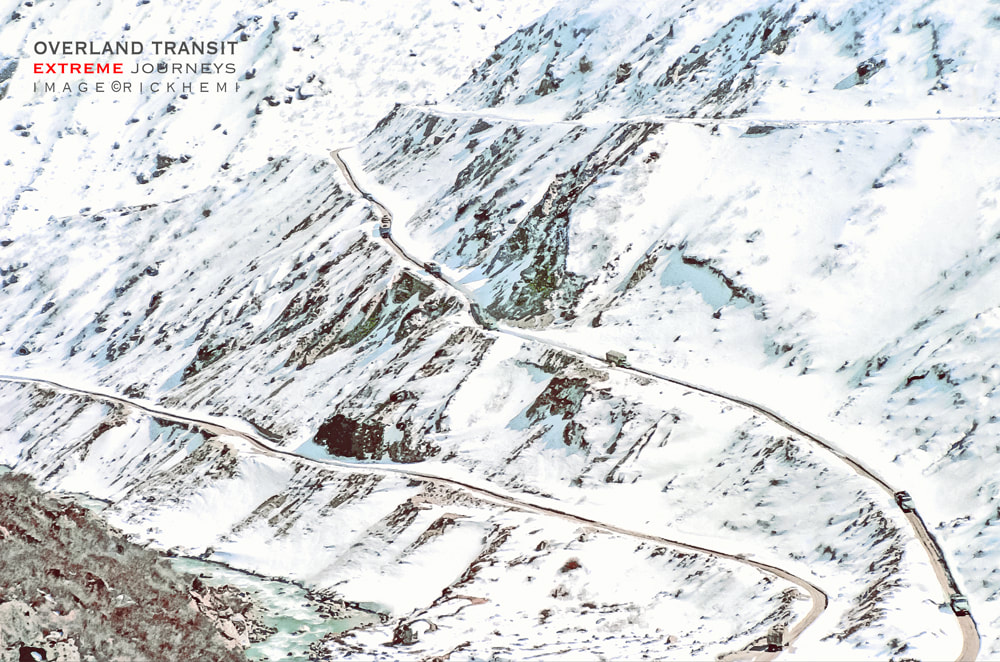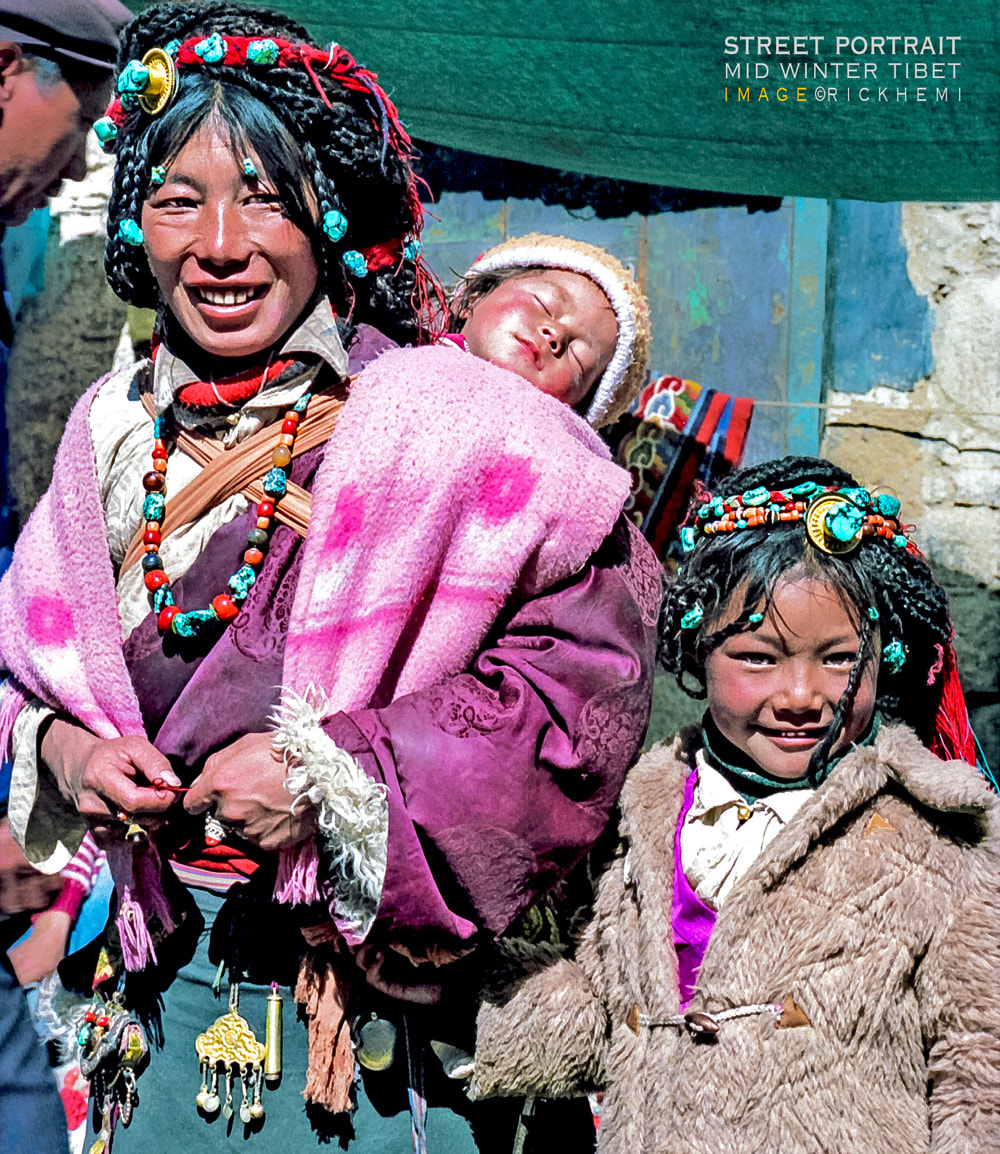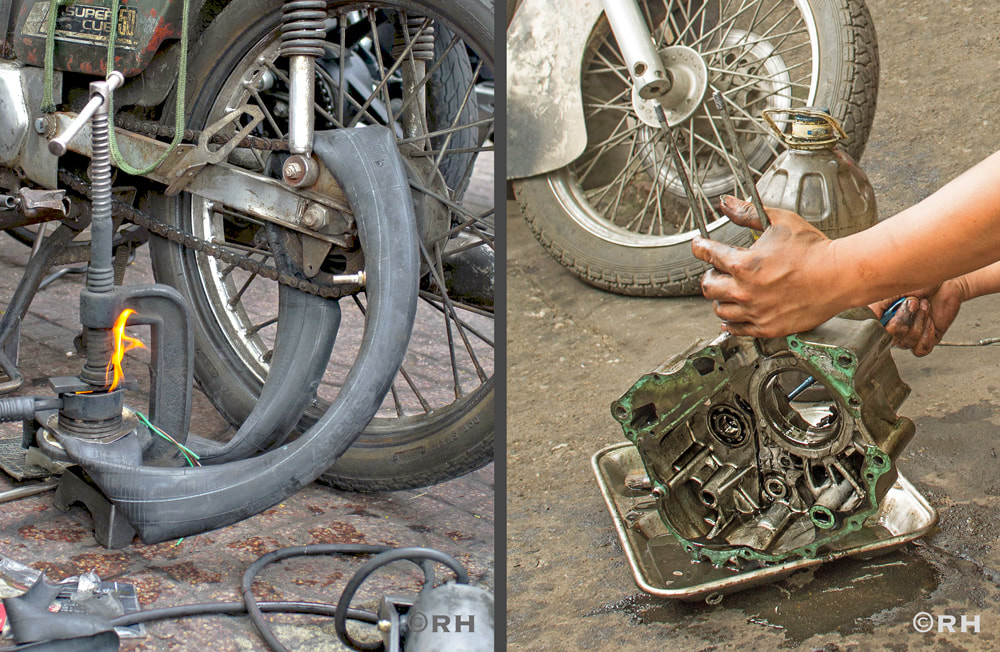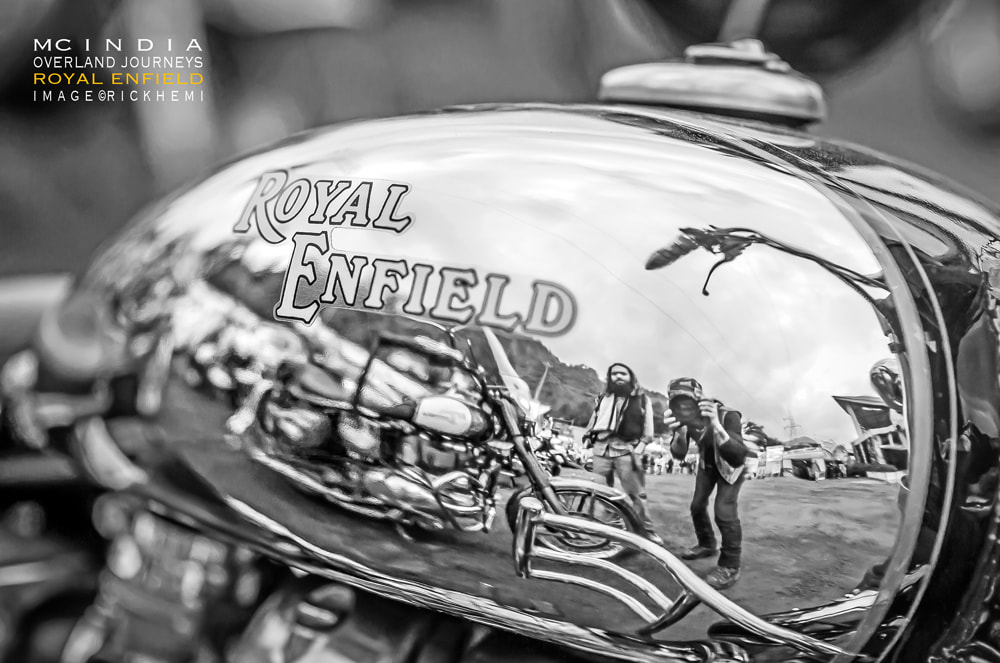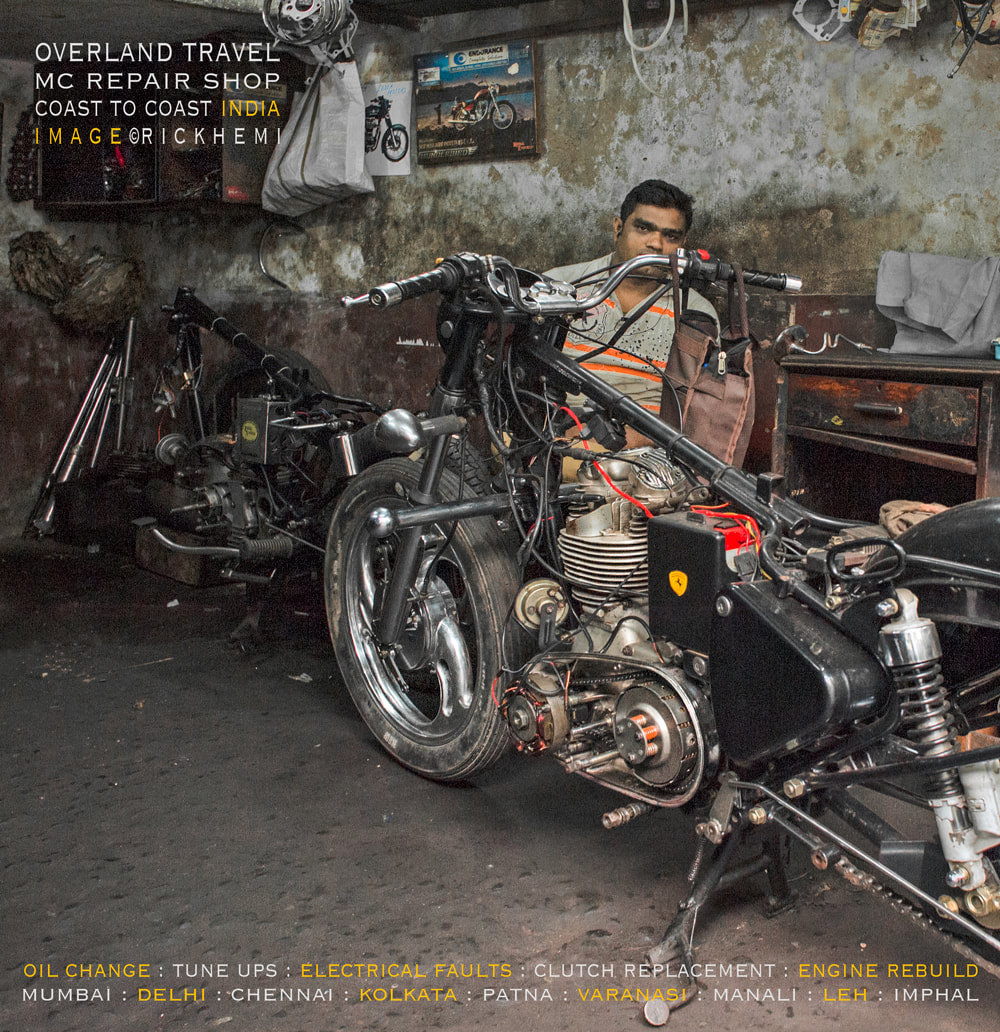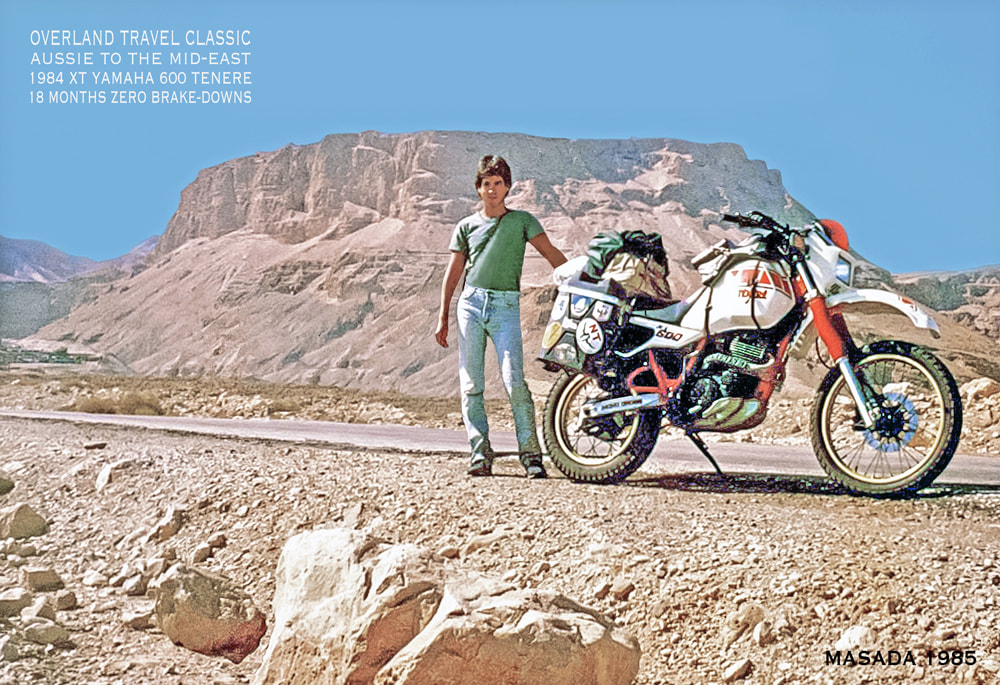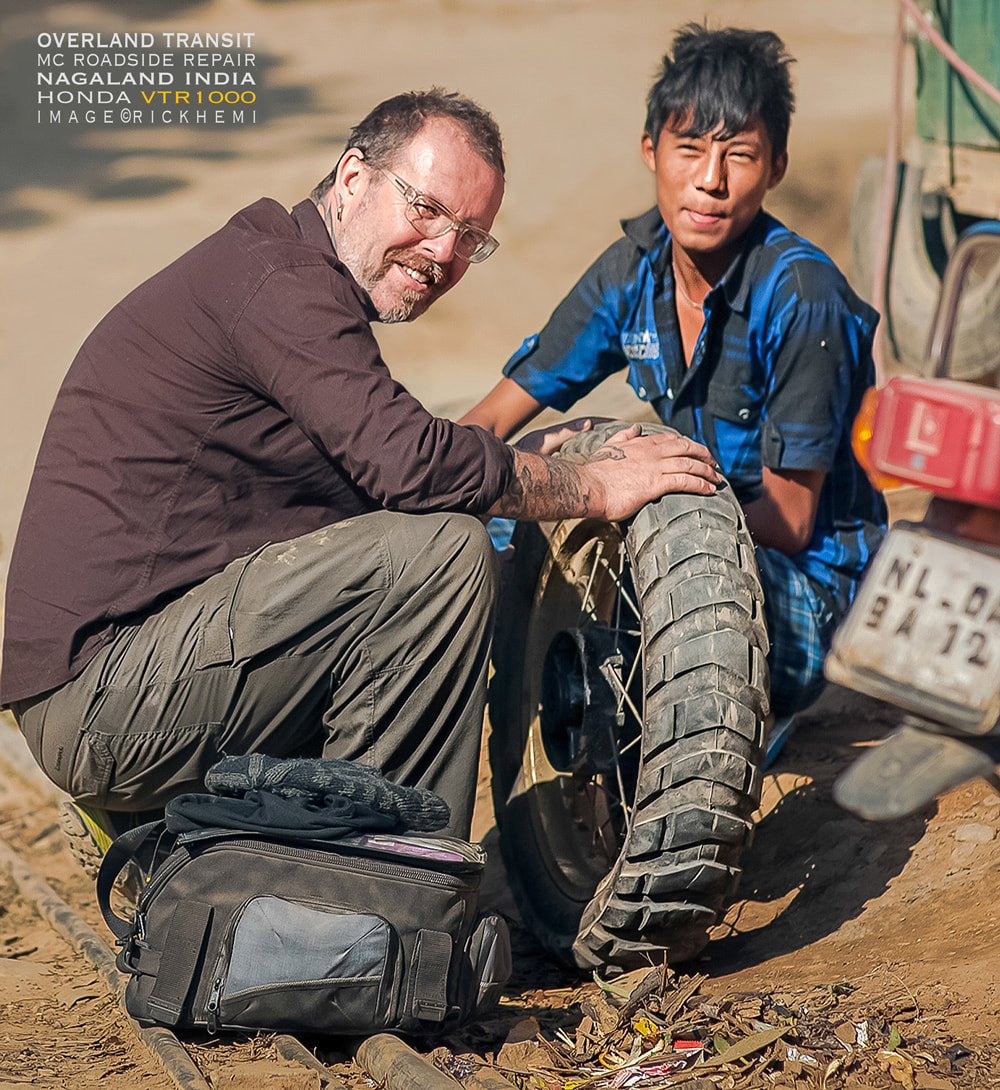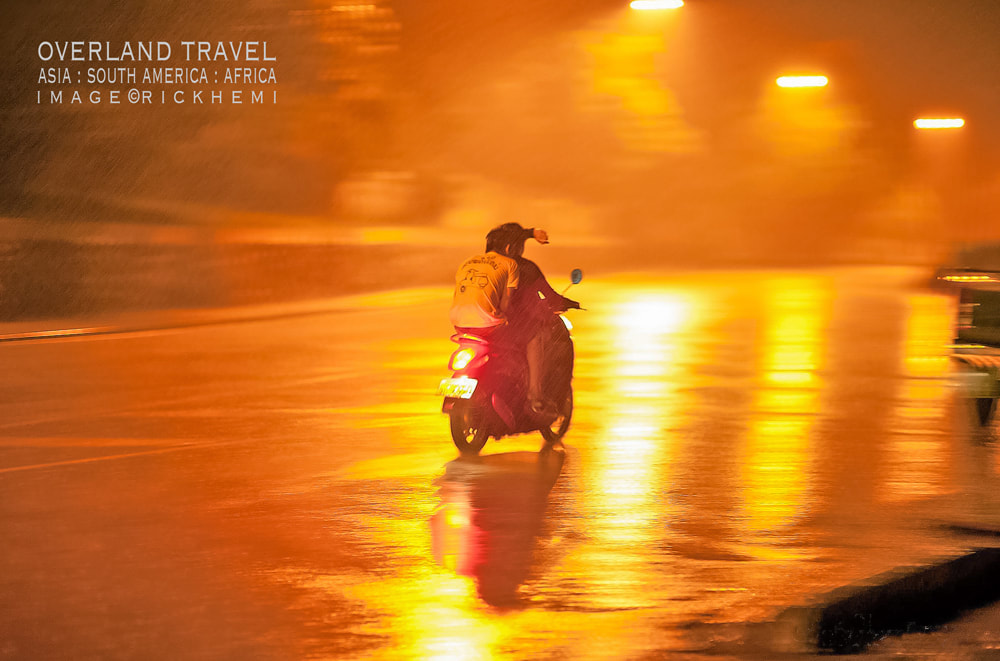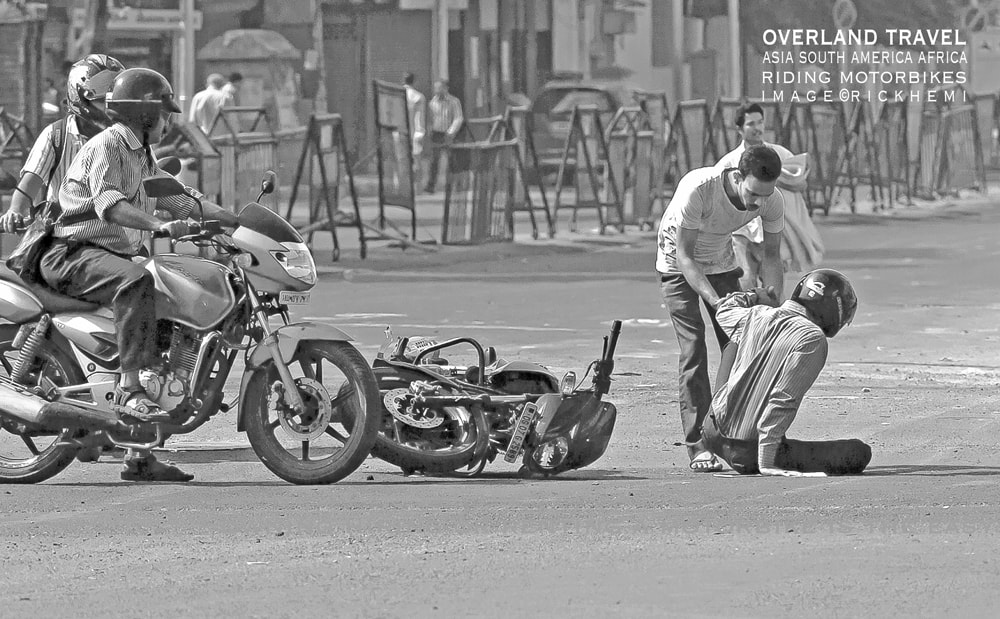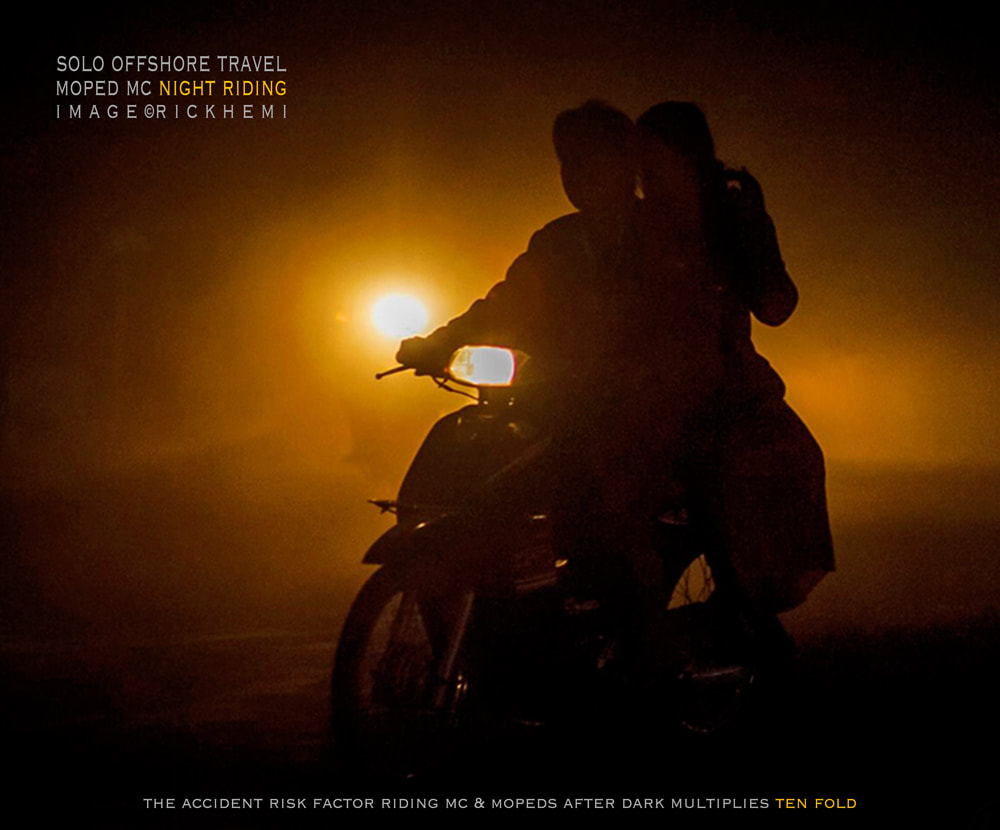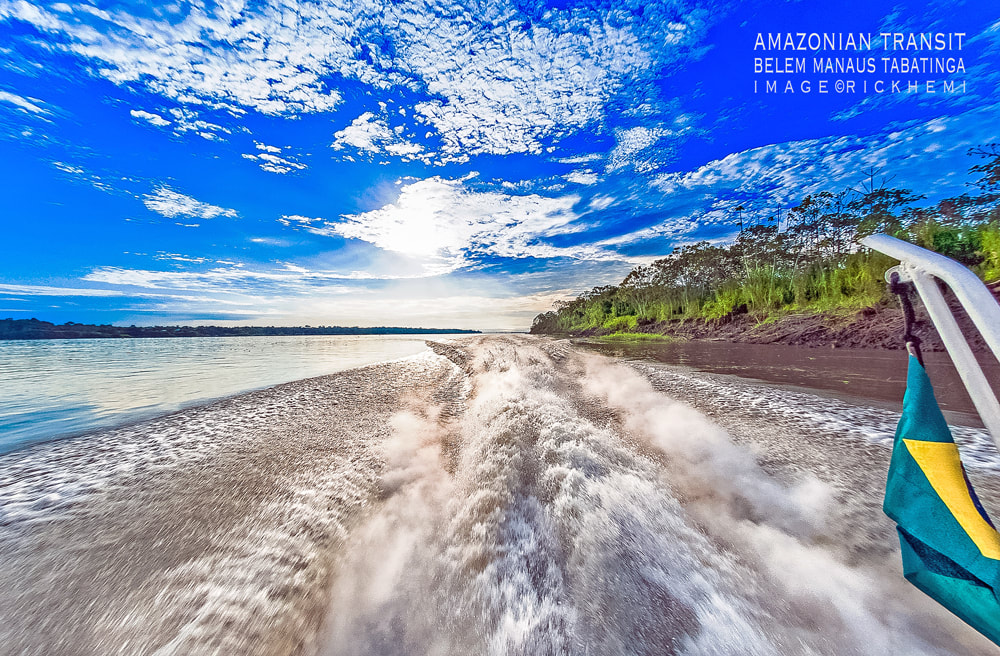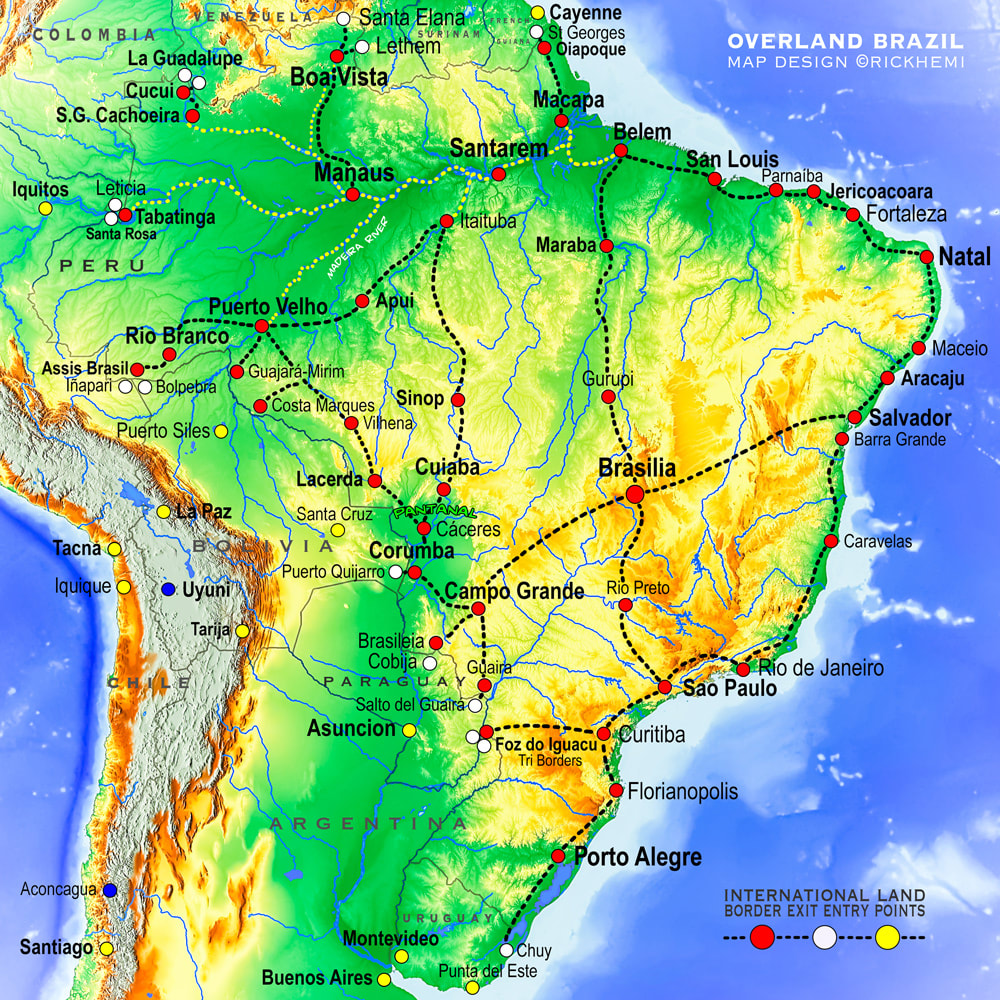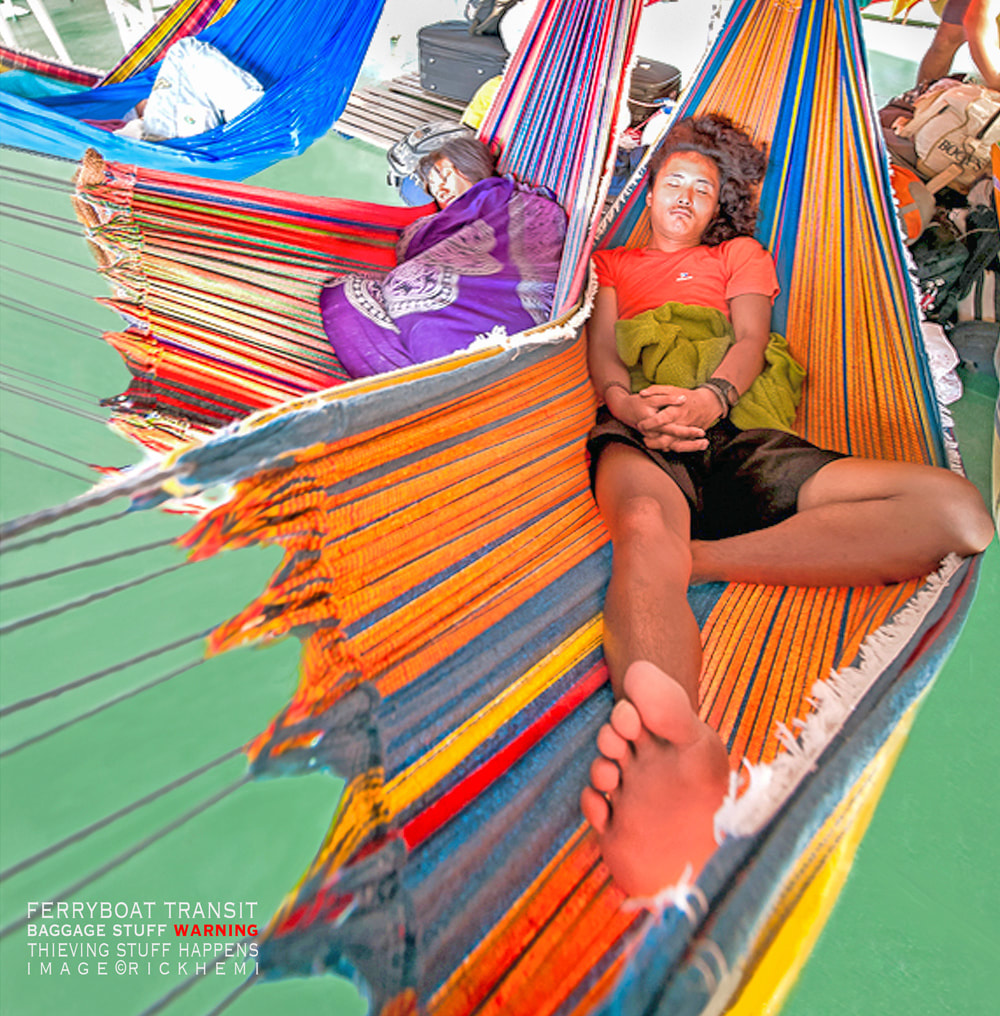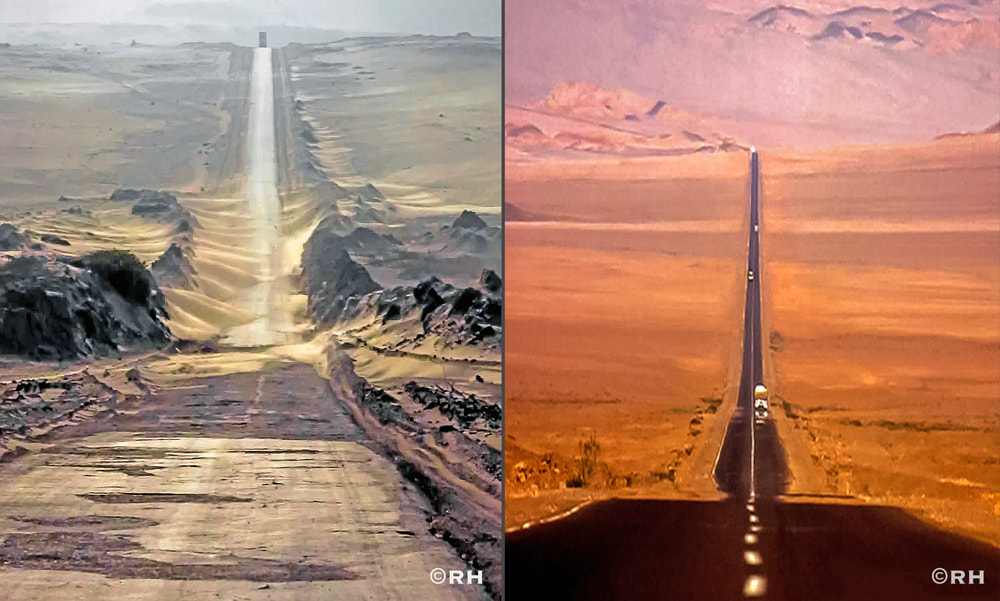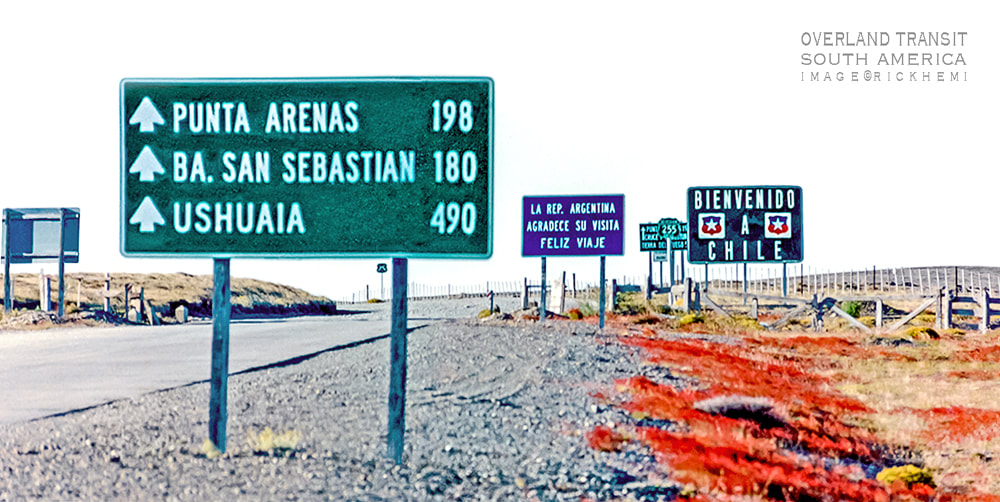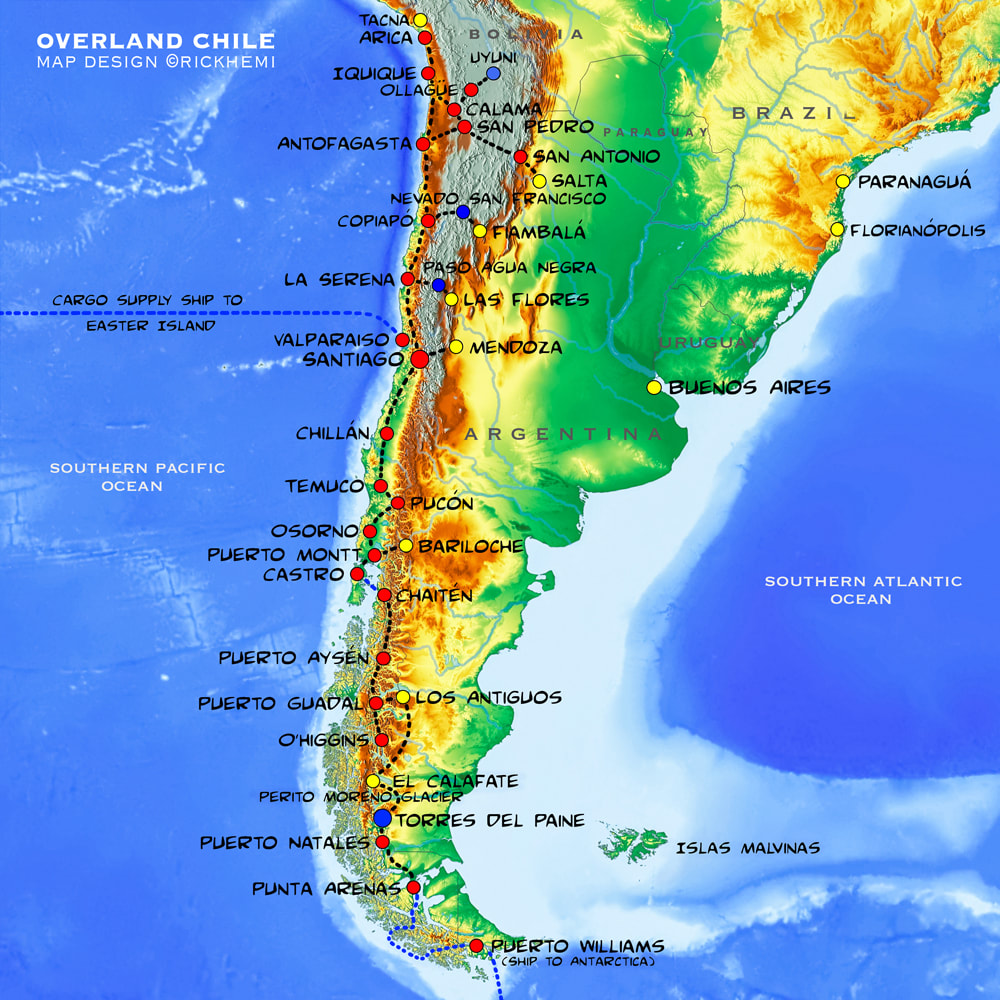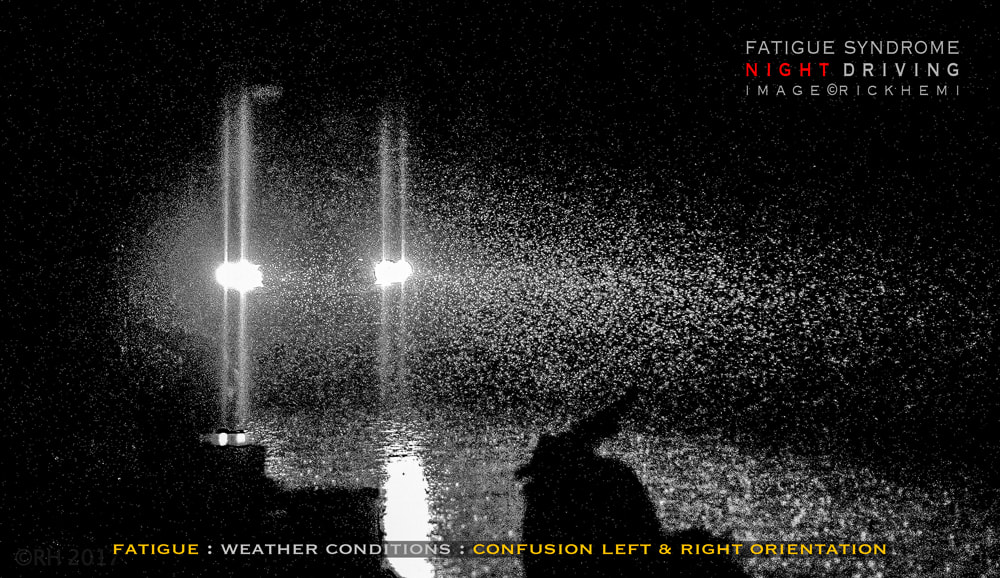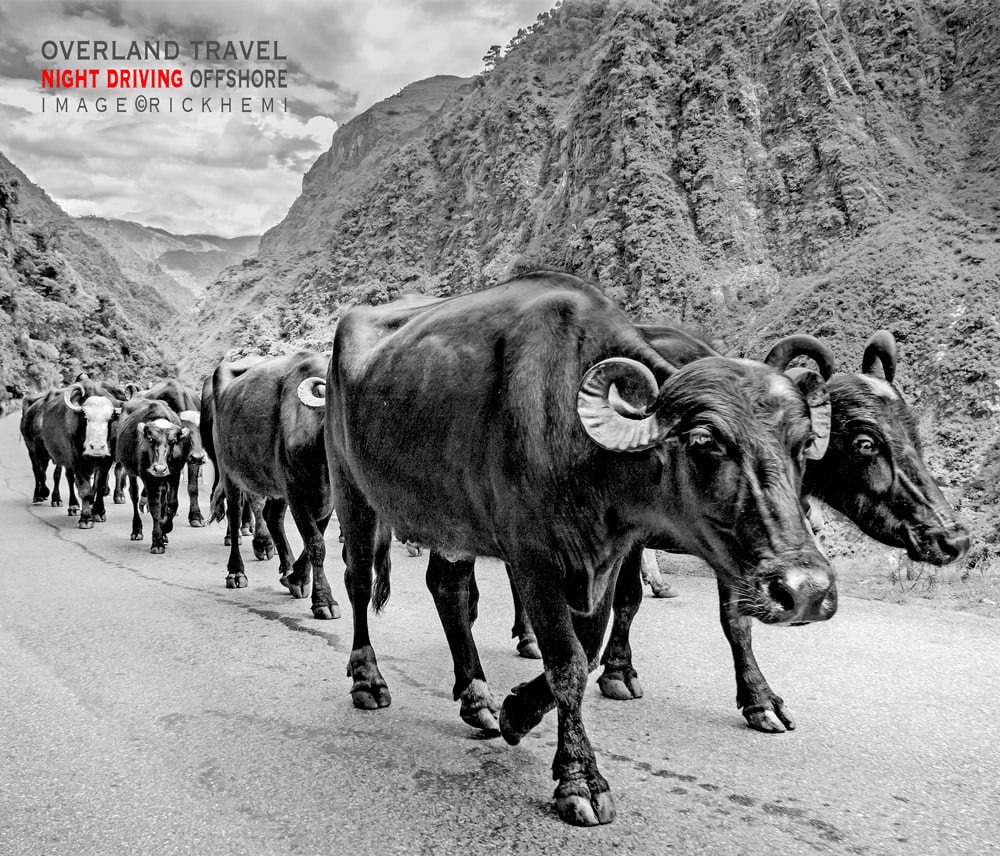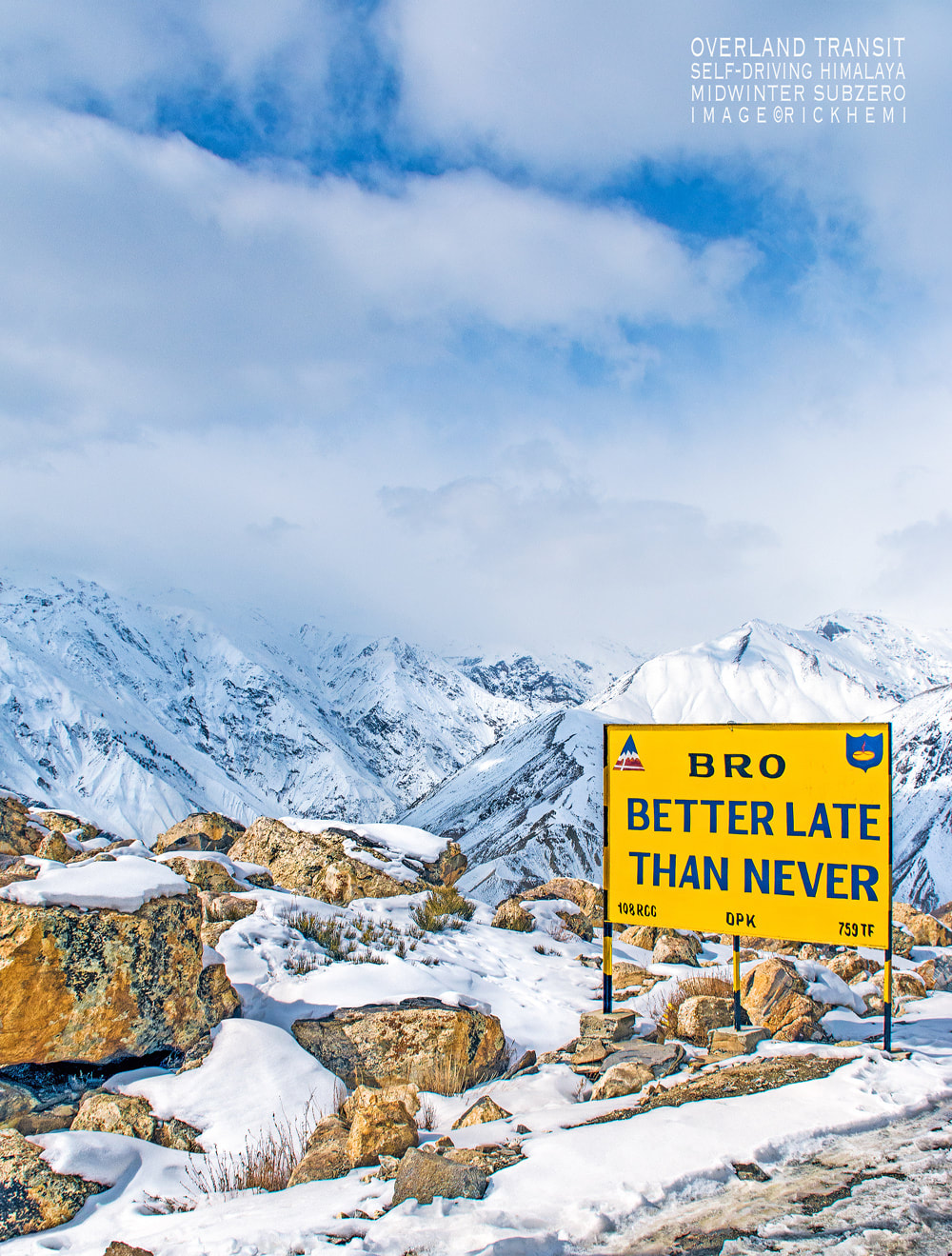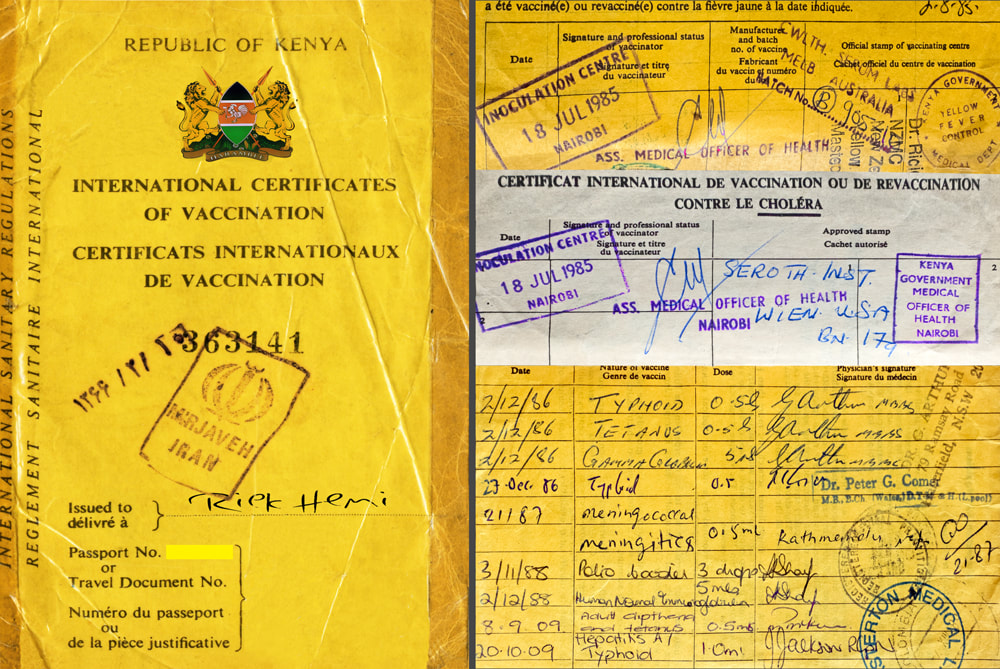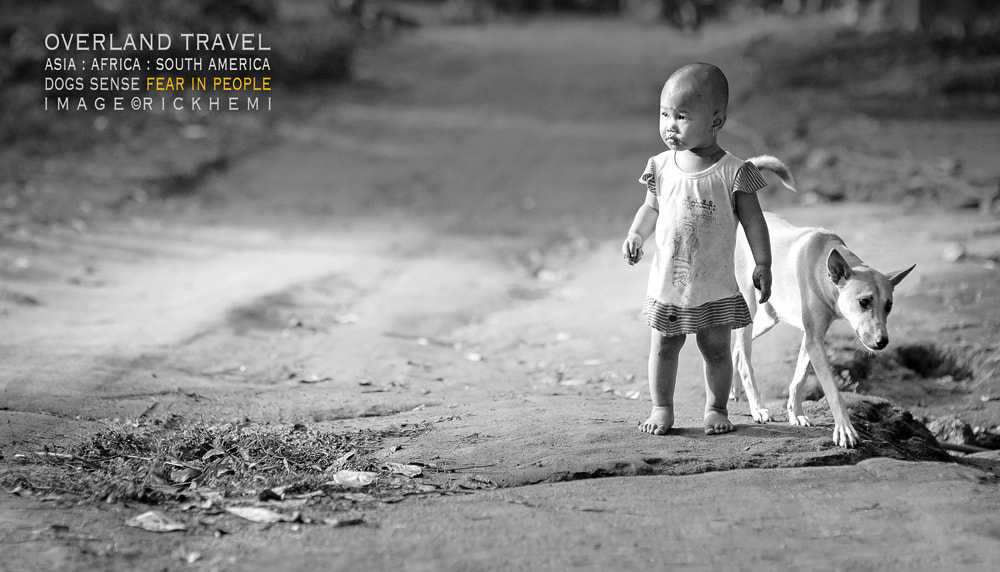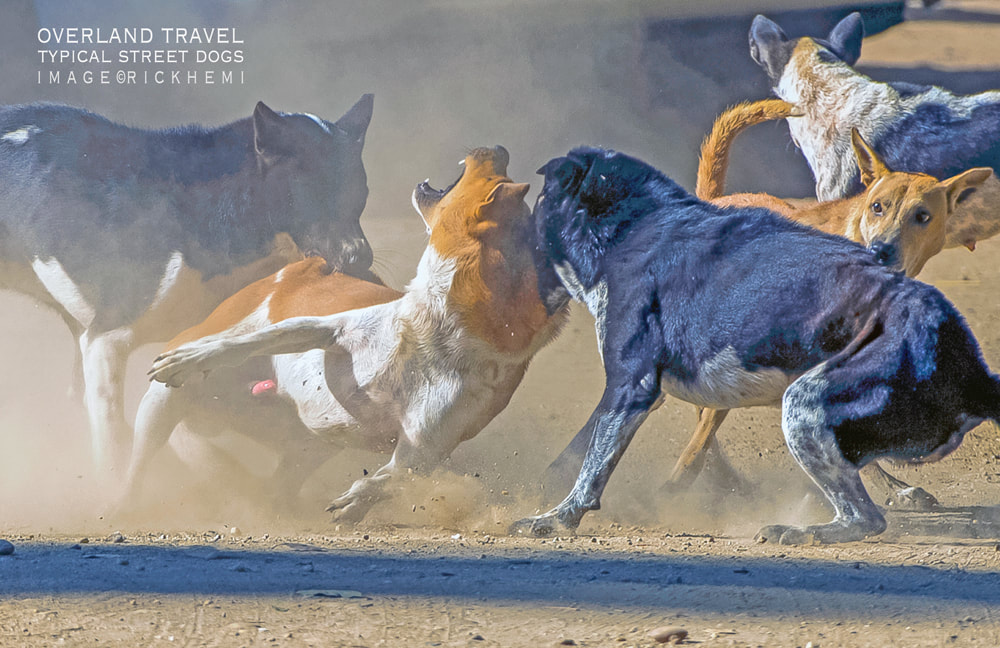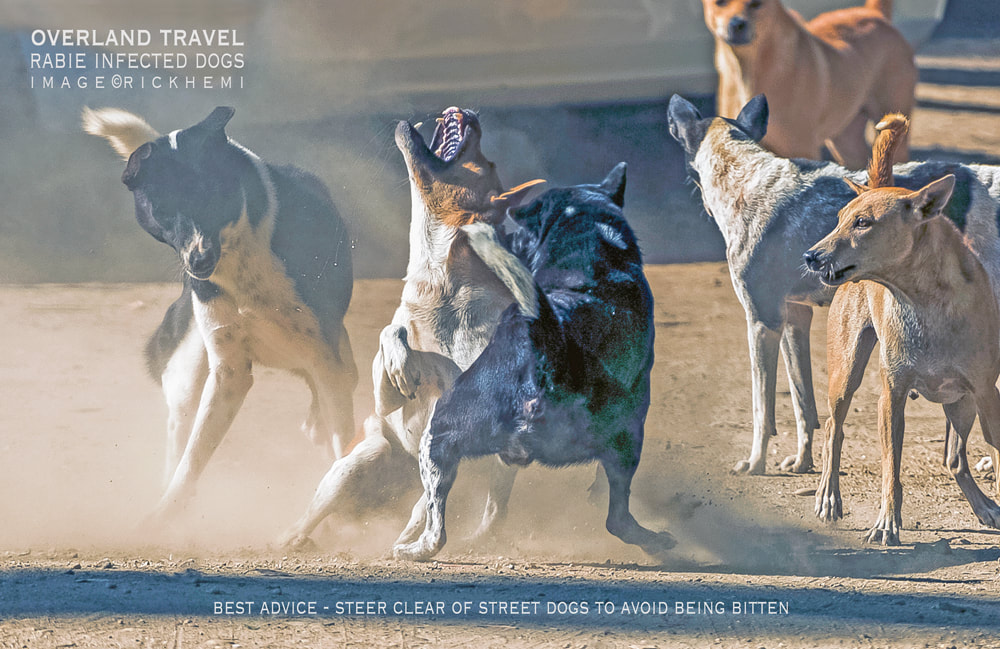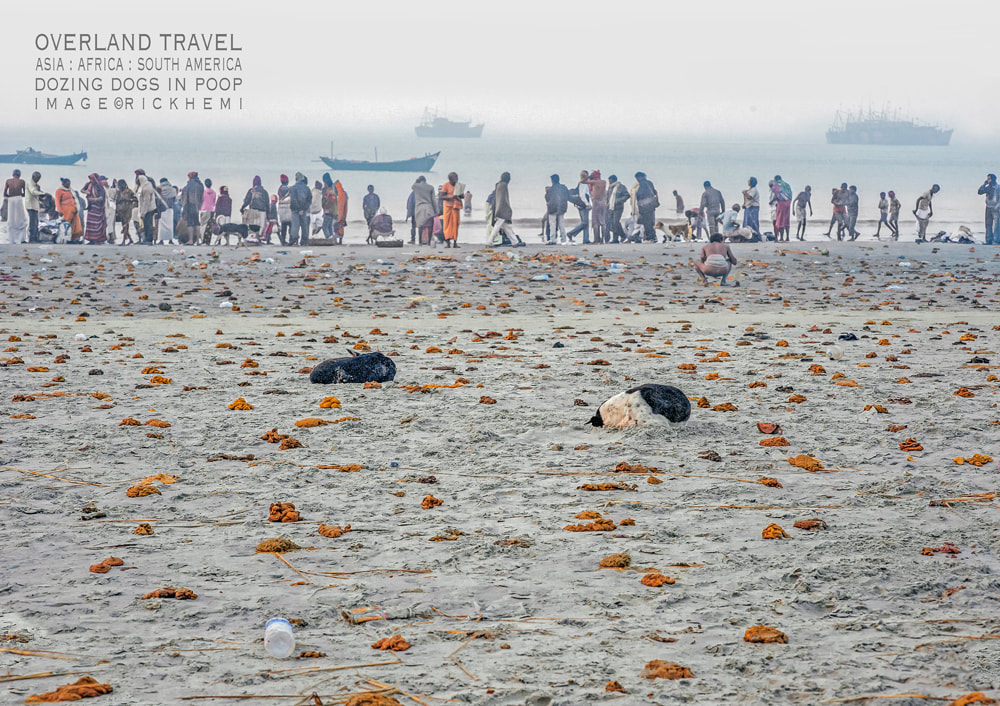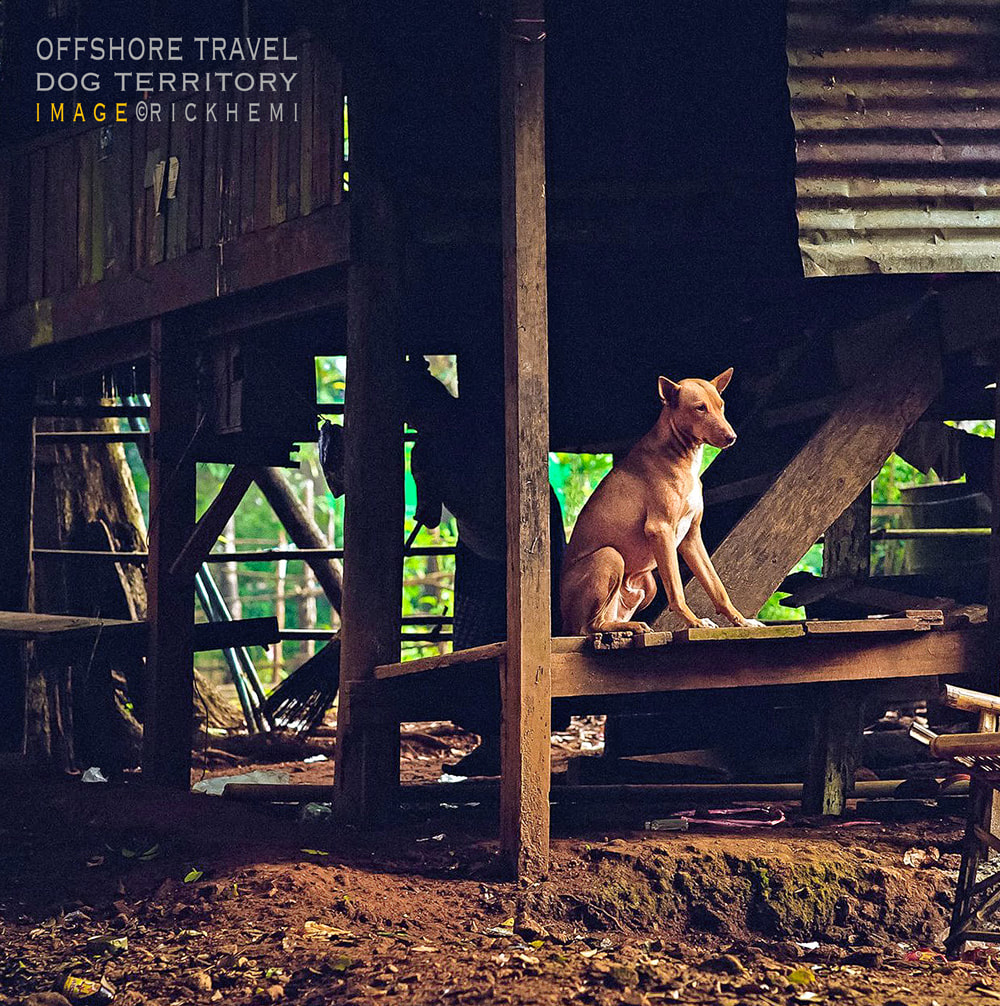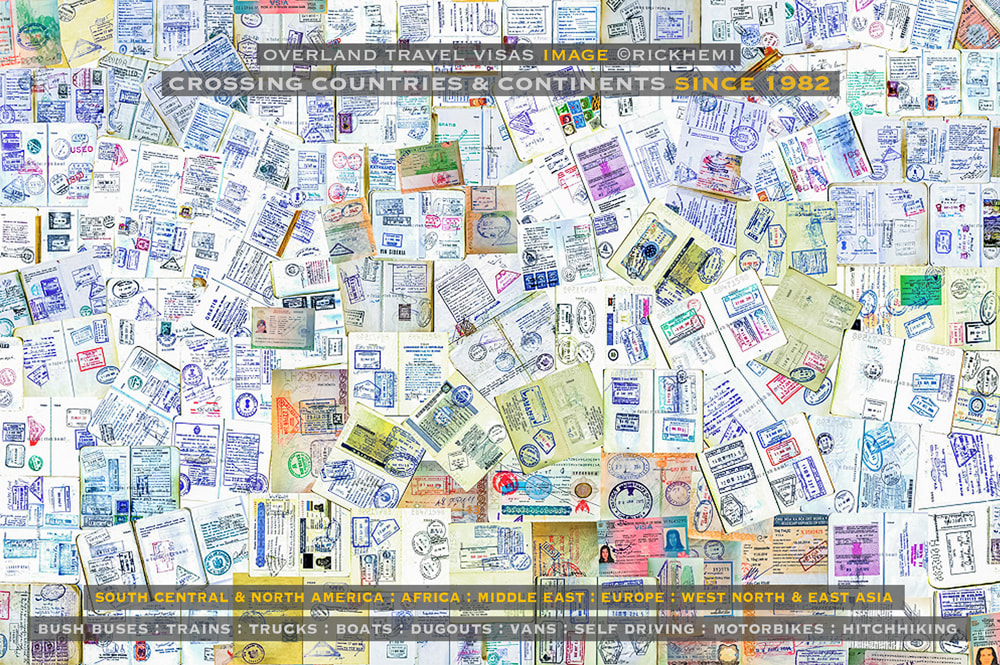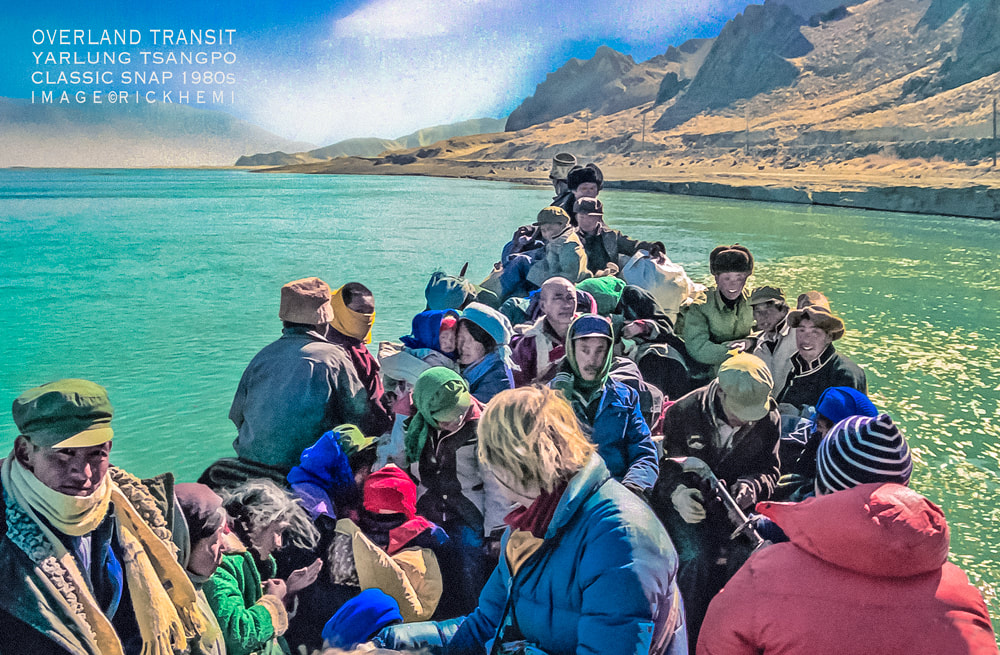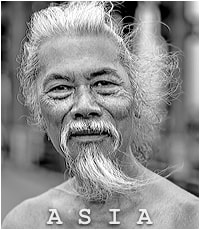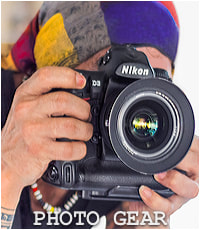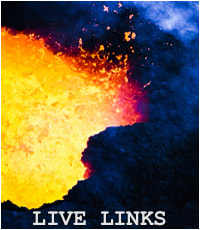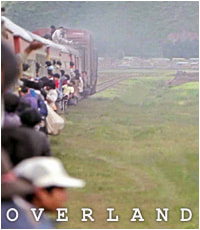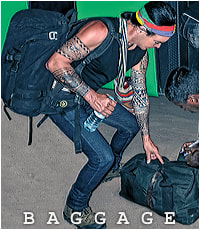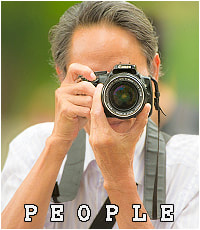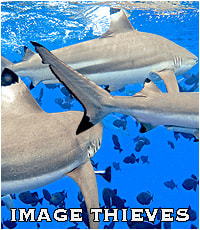Solo Overland - Travel & Transit
South America : Africa : Asia : Middle East
All Images By Rick Hemi
Within interior regions of Africa, South America and Asia, there's always some form of bush transport available. If there's a dirt track that a set of wheels can drive on, then locals will definitely use it to their best advantage. Climbing on the back of trucks, bush buses, or being squashed up into vans becomes a normal weekly occurrence in transit. It's the same with river or lake transport that has enough water to float a boat downstream - always packed over the limit, ready to sail. Some local transportation may appear to be totally outright dangerous within western eyes, but certainly not the case to locals that use it every day.
There are times that the risk factor multiplies, but then if it's the only available transport, it could be a long wait until something else comes along. Highway carnage, accidents, breakdowns, blown out tires and engine failures are all a part of the solo overland travel experience using local transport-Hey, welcome to the real world of solo overland travel.
So many today have the habit of jumping on quick flights inside countries to reach destinations within the same country. The obvious reasons for doing so equates, to either having short limited travel time schedules, or avoiding the hassles of using local overland transportation. This is where it defines those who are actual vivid overland travelers, or half-pie wannabes that haven't the courage or self-esteem to motivate themselves, even if they were inside a used paper bag trying to find the easiest way out. We all know Western beach party goers commonly use selective air travel from one safe zone to another safe zone, avoiding any kind of overland travel as much as possible. Colombia, Senegal, India and Indonesia are classic examples of this.
Are you a jet-set flight baby, or like myself crossing countries overland? Those who are actual real overland travelers won't take internal fights. They will instead travel and transit overland through thick and thin, completing their journeys no matter how long it takes. Below, Peruvian highlands bush train.
Top Bush Train Transit - Bolivia 10/10 : Peru 10/10 : Bangladesh 10/10 : Sudan 10/10 : DRC 10/10 : India 10/10 : Myanmar 10/10
The overland offshore travel days using SLR roll film through the 1980s and 90s. The Nikon FA below was a backup camera for two years during the mid 80's. Although the FA had matrix metering which worked perfectly, the FA's electronic shutter had common failure issues. My two Nikon F2AS bodies including an F2 never failed. These models were already classified as old school camera bodies in '89. Just like the Nikon D3 from 2007, which I'm still using in the 2020s. Good reliable DSLR camera bodies and lenses for still photography were produced between 2007 thru 2017 — Everything beyond are more for video with smart phone hybrid sensors.
Some travel baggage stuff below that survived through the entire South American continent using deluxe buses, bush buses, vans, trucks, and hitched lifts. My DSLR photo gear took most of the baggage space. Traveling across continents carrying less clothing and more camera gear has been ongoing since '82. The 6kg AFS Nikkor 600 F4 ED lens was well worth it's weight and bulkiness. Image was taken with a 2nd backup full frame Nikon DSLR & DX 10.5mm lens.
Getting There - Touching Down
Landing Locations - Aussies : Kiwis : Canadians : Europeans : Americans : Asians : Latinos : Africans
Beginning your own solo overland travel transit journey through a continent usually has limited options where to start, if the entire continent is the itinerary. Landing into the middle of any continent, like Lima, Lagos, or Mumbai will only add complications to fully complete crossing through the rest of the continent in one direction. Doubling and back tracking through countries that have already been completed will only add extra cost and waiting time for new visas, including thousands of transit kilometers and accommodation costs. It makes more sense to begin any long term overland transit journey at the edge of continents, and continuing either up, down, or across a continent. The following countries are typical overland travel and transit start points in either direction: Turkey to Hong Kong, Morocco or Cairo to South Africa, Chile to Mexico, Colombia to Argentina, Singapore to Turkey.
Overland Transit - Rugged Journeys
Real Time Midwinter Overland Regions - Skardu : Sost : Leh : Spiti : Limi : Mustang : Gurudongmar
Above, the high road in the 2020s, below from the 1980s. Nothing has changed over four plus decades through the Himalaya region during midwinter overland journeys. Hitching lifts with trucks still works, bush buses are still active, and most high altitude road routes get clogged and bogged down in snow during the winter months. Fatal accidents are still frequent, and black ice along road routes remains the same - slippery as. One thing is for sure, any midwinter transit journey above 3500 meters in the Himalaya will be those journeys always remembered. Below, I captured this snap on the back of another truck in transit during midwinter half way between Kodari and Nyalam - Tibet 1980s.
Overland transit routes through continents rarely change, although today within various regions, volatile skirmishes, terrorism, Islamic insurgency, drug and people smuggling, and increased banditry has created an array of Red Zones scattered across the African continent. South America has had its own reputation and long history of lawlessness that's still ongoing. Established Red Zone regions are well known within travel circles, but not so much on the spread of newly formed Red Zone territories popping up without notice. Passing through Red Zone depends on timing, available transportation, and the overall safety levels and risk factors involved. Staying in Red Zones automatically increases the risk factor of becoming a victim just like locals residing in the same area. Getting fresh information crossing through Red Zones, is only by being close to them. Gathering the latest information from locals who have first hand knowledge of what's happening within their district is normal procedure, before decisions are made to transit, or stay in theses regions. Red zones have different levels of risk, some not so dangerous during daylight hours, while others are extreme.
Fresh new Red Zone information is definitely not found inside the covers of LP, or other travel guide books. Their sources of information are already outdated before reaching bookshops. Also avoid couch potato travel bloggers relaxing on beaches sipping Pina Coladas, who have zero capabilities of completing hard yards of overland travel. Most travel bloggers, and influencers have no intentions traveling through untamed territories on their own. There's nothing there to sell or promote to their safe zone audiences who prefer soft sandy beaches with smart phones in hand.
The most important thing to understand here, Red Zones don't stay in the same areas. Red Zones multiply, spread, move around, regroup, and overtake other territories. Taking anything for granted outside "safe zones" will most certainly scare the crap out of many, when least expected at a moments notice without warning. Take my advice seriously if you want to survive unscathed, and to leave continents with all the baggage contents one came with. For the latest updates on earthquakes, volcanic activity and weather conditions these 3 active links will keep you informed anywhere on the planet. Below, chill-out space halfway through packaged overland tour journeys doesn't exist. Traveling solo wins hands down.
Stuck on a Crossroad - Going it Alone
From the southern Pacific, there's no way out, but to use long haul flights reaching Africa, South America and Asia. Once arriving into any continent, jumping on internal flights within continents is definitely out in the cold, unless border crossings are completely shut down and closed. Africa, South America and Asia contain an over supply of roads and tracks to reach from one point to another. Jumping on anything with wheels on it heading in my direction normally does the job.
Are you an overland travel speed freak trying to do as much as possible in the shortest time possible? Slow down what's the rush?
Some overland travelers I've bumped into through the decades really had no ambition transiting on slow moving bump and grind transportation, because of their short journey timelines. Instead, they commonly used express buses hauling along bitumen highways, or grabbed internal flights reaching destinations in the quickest time possible. This still happens today, especially in Asia and South America. One classic example during the mid '80s, was just after crossing solo at the Iranian border into Pakistan. A London-Kathmandu express bus full of semi-hippie westerners had also just crossed over after transiting a quick few days through Iran. I chatted with a couple of them traveling on the bus, if they were enjoying their journey. They all had agreed there wasn't enough free-time exploring or seeing anything off their transit route since they had left London. When I told them I had been slowly roaming through Iran for a few months, and was heading back to Kathmandu via China through Tibet, they wished they had done the same. Continental overland travel tours may sound good with cool advertising without the need of worrying about travel route arrangements. Going it alone choosing your own journey itinerary without timeline stress deciding to stay an extra week here or a few weeks there beats the hell out of any group tour package deals on the planet.
Why follow the crowd? Choose your own overland journey routes with no time limits - Do it now while you can!
Transiting on board worn out bush-buses, trucks, thrashed out 4WD’s, listing slow boats, or in beat-up nomadic desert sand taxis is normal. Using basic local transport, with some en-route blowing their engines, or other forms of breakdowns is part and package of any rugged overland journey. At times, it can take days on end hitching lifts, and become stuck within remote isolated regions. Forget about time schedules - who's in a rush anyway? Below, bush bus rear corner seats get the best views.
As a westerner, it's as though time's lost when the clock’s ticking waiting for a lift somewhere well of the grid in isolated regions, but then has it? Some of the most amazing experiences while transiting are all those periods twiddling the thumbs waiting for a ride. It's here at the crossroads en-route in the middle of nowhere, where locals gather chit chatting among themselves. It's the aromas of chai, the smell of coffee, the swirls of bull dust, the noise and intrusions, thirsty mosquitoes and fly blown meat, women openly breast feeding, and fully charged children asking endless questions without shyness. This is where one has no acceptations, only the enjoyment of chilling with the company of locals. These are the moments that are never forgotten transiting through countries across continents. One becomes accustomed to living out of the box well away from comfy tourist zones, which at times may feel hostile to some. In these types of isolated environments you don’t have a choice anyway. The above scenarios don't hit home, or have little value until returning back to Western civilization.
Holding cameras outside on moving transport capturing snaps is something I've been doing for decades. Depending the terrain, a good little point and shoot does the job. Making sure one has a grip holding cameras out of windows during transit will save them from sudden death if slipping. Some haven't been so lucky, who've watched their cameras bouncing to bits on the road - Strap it or lose it!
Bush bus breakdowns commonly happen through central Asia, heartland Africa and Andean block. The longest breakdown spanned 36 hours in the middle of nowhere in central Brazil. Normal issues are burnt out clutches, broken axles, rear spring shackles snapping, tie rod end failure, blown diff, exploding engines and transmission failures.
There are plenty of overland travel companies operating different package tours that transit up and down and across continents. Overland tour operators normally use main bitumen highway routes. They're like an off-shore western taxi service for Westerners. Imagine the hassles between a group of say 20 westerners for 1-3 months every day, 24/7. Personally, that would drive me right up the wall, and would be worse than being locked up in an Iranian jail cell - which I've experienced. It's also the organized time schedules that are either way too short, or in directions that stick to touristy routes for anything constructive well-off the beaten track. Crossing entire continents on main road routes may sound and feel inspiring, but it’s the regions scattered in the middle of nowhere that are much more interesting to visit. There are many Westerners who travel this way, and enjoy their 1st overland travel experience without the stress and paranoia of being independent and alone.
Overland tour companies operating through Africa, South America, and Europe to Asia are more like get-together party hangouts for Westerners, who prefer to travel in groups amongst themselves - very similar to deep sea ocean cruises. Some at later stages may develop their own itinerary, and realize that it’s far more exciting to associate and interact with local atmosphere moving across continents in their own time frame. This is what a major part of solo overland travel is all about - interacting with total strangers through countries and continents without hesitation. When traveling solo, many doors open where they wouldn't if it was a crowd. Time limits are endless in any direction, seriously think about the multitude of possibilities going it alone.
Clocking up serious overland transit mileage across continents on board bush buses is enjoyed not hated. There's plenty of slow overland transit routes throughout the planet where bush buses are still active. The backwaters of Asia, South America and central African heartland are bush bus regions. Anywhere off the beaten track where the bitumen ends is bush bus territory.
Fastest Bush Buses - Venezuela : 2nd Fastest - India : Slowest - C.A.R. : Most Breakdowns - Ethiopia : Longest Bush Bus Journey - Iran
Yuppy travelers have actually asked what bush buses are. They imagined them to be travel buses out-fitted for tourism adventures on one day excursions. Typical bush buses are still being used across the heartland of Africa, Central Asia, India, and Andean block. They are normally nostalgic 1950s - 70s style, with original worn out rattling seats, jammed up windows, broken windows or no windows, no heating or air con, limited suspension, noisy vibrating running gear, smokey engines, no mufflers, squealing brakes if any, more dust floating inside than outside during transit, flavored aromas, sticky floors, picked out nose junk stuck on seats and window ledges, fully jammed packed during transit runs, goats, sheep pigs on board. If you haven't transited through the heartland of Africa onboard bush buses - You haven't been to Africa!
Below, Bolivian bush buses through the country are a makeup of different types of American 70's nostalgia. Many still operate using V8 petrol engines. The rumble and comfort transiting through the Altiplano onboard these machines is as good as gets for what is left of original wild west transportation. The rear corner seats get the best views.
Enjoy the rumble transiting on board Bolivian V8 bush buses while they last. Take your pick - Ford V8 : Chev V8 : Dodge V8
Sooner or later ruff rugged bush buses will become a thing of the past. The rapid completion of bitumen tarmac has been spreading through the African heartland and Central Asia at phenomenal speed. During the '80s the overland route from Europe to South East Asia was a bone rattling vibrating journey worth remembering. Today, numerous routes reach Singapore on layered mirror glass tarmac. In saying that, there will still be bypass overland routes remaining untouched off-major highways. Back roads through the Andean block, the Amazon, and Himalaya a few regions to mention.
Bush bus breakdowns can't be avoided due to the lack of maintenance. Now and then, one can feel the rhythmic tension when breakdowns are about to happen just before they happen. Major engine and transmission failures have their own unique warnings just before failure grinding to a halt. Transfer buses can take hours, sometimes days depending on location. This is a great time grabbing snaps of the event like the above image.
Traveling solo overland using basic transport through the planet in the 2020s hasn't changed. Bush buses still roar down highways. Basically, most transportation is back to normal as it was before the 2020 plandemic. An example of desperation of massive price hikes in fuel costs and food shortages is Sri Lanka. This was planned to happen, which now Western countries will feel even worse. Before 2024, it's advisable to sell off what isn't needed, get rid of all debt, downsize to affordable lifestyles, and learn how to grow your own veges, how to fish and hunt. The Agenda 2030 will begin sinking it's claws in well before 2030. WW3 must happen for Globalists to maintain power over populations. Your own government is probably globalist controlled. The life of easy living will be nothing more than a wet dream for most by 2028. Those who think different will find out the hard way when food supplies diminish. It's called depopulation of the planet by any means necessary, even if means destroying the entire planet as we know it. The planned virus was only a taste of what's coming down the pipeline.
A recent overland transit snap. It shows a typical scenario of larger vehicles getting the right of passageway on busy narrow gauge highways. There's usually no medium line or pull in bays along isolated routes. Razor hairy situations are normal occurrences through the continents. Driver safety depends on who's doing the driving. There is no room for any driver error like above, especially with no safety rails with a 300+ meter cliff drop right beside you. Hitching lifts with crazy drivers happens. I've had my fair share through the decades. Best advice is either tell the driver to slow down, or to grab your baggage and get out before death takes you out on the next bend.
I can count at least a dozen instances of foreigners that had hitch lifts and died from fatal accidents. Self-driving offshore requires quick decision making when least expected. The majority of fatal accidents caused by foreigners offshore are directly from driver error. Learning defensive driving skills is almost necessary in certain countries i.e. Turkey, Iraq, Syria, Egypt, Venezuela, Peru, Mexico, India, Pakistan, Nigeria, South Africa, C.A.Republic, Ethiopia, Somalia.
Ahh, the comfort of traveling on board deluxe buses. Sofa seating, hostesses handing out snacks and drinks, wifi, air conditioning, and roomy WC. Actually, I prefer rough bush buses any day. The occasional transit journeys I've done on super deluxe buses have been minimal through the decades. Most previous overland journeys deviate off bitumen highways where deluxe buses struggle to operate. I've had more than enough breakdowns using deluxe buses running on smooth tarmac. Engine failure in Mexico and Peru with replacement buses. Transmission failure in Brazil with replacement bus, and blown out rubber in Vietnam, Indonesia, Turkey, and Brazil. If I added in Europe, USA, Australia and NZ. the count would be much higher.
Overland Transit - Africa
Solo Overland Africa - Yes : Group Tours Africa - No : Packaged Overland Travel Africa - No : Internal Flights Africa - No
Solo overland travel offshore has no other meaning no matter how it's explained. You use your own brain, initiative and intellect getting through continents. The three big No's which some out there actually assume is real overland travel are only fooling themselves. Try it, I've been doing it for decades without the need of using group travel, fluffy overland tour groups, or taking internal flights within continents.
Above, some R&R down at the Cape after completing a full on solo overland journey up and down and across Africa. Overland transit routes are in full swing even when volatile skirmishes or civil unrest occurs through the continent. The Sahel region, South Sudan, Cameroon, Somalia, DRC, Nigeria and Libya are examples of this. It's imperative to gather fresh up to date information that can be trusted, that allows calculated risks to transit through Red Zone routes. The most trusted sources of travel information is directly from locals on the ground, or foreigners (if any) who are traveling in the opposite direction informing of what's up ahead - never from travel guide books or bloggers with outdated information. Fresh on the ground facts and data will ensure any intended transit route can be calculated beforehand, and bypassed if necessary. This will lesson the chances of becoming a target along routes infested with bandit blockades, Islamic insurgency, sabotage, mugging, and hostage extortion.
Bush bus positives - Atmosphere vibe : Interacting with locals : Long-cut routes, crazy drivers, packed out overloaded, zero yuppie foreign tourists. Negatives - jammed up windows, back corner seat already taken.
Traveling through Red Zones regions in conflict is entirely at your own risk and peril without support. Those taken hostage within the Maghreb - Sahel region will be hard pressed receiving help or assistance. This is the difference between watching to much Netflix compared to the real world. Never assume, if you're a Western foreigner transiting through the above mentioned regions you get a free pass, and that nothing will happen.to you.
Of course the couple in the previous link may have converted to Islam to save their skins, and whether the female was isolated, and constantly raped through her 15 months captivity. No one will never find out until the couple cashes in with an over sensationalized novel of their traumatic experience. Nothing new here, it's all been done before. Warning, be careful where you free camp in Africa, French tourist shot, robbed and hacked to death.
Northern Africa has you covered getting across the continent using basic deluxe buses, bush buses, transport vans, trucks, MC and Hitching lifts. Ths region is notorious for Islamic incursions, highway banditry, ransom hostage abductions, and narcotic and human smuggling. Snitches in this region are your worst enemy.
Foreigners traveling offshore have made wrong decisions and calculations for decades. They have either been robbed, mugged, beaten, raped, or slowly tortured to death because of the risks they choose themselves. Beware of your surroundings, where you stay, and who you chit-chat with. Snitching is the greatest threat, and has always been the greatest threat. Local snitches work independently with various groups. They can be operating with Islamic militias, highway bandits, or human smugglers. Watching to many poorly scripted liberal Netflix movies and yuppie travel You Tube clips won't help in the real world well away from safe bubbles - Got It?
On the bright side, there are many westerners who have completed solo travel journeys through volatile regions (like myself) without having a single incident. Sourcing fresh information and using safe-decision making at crossroads in the middle of nowhere keeps one aware of what's up ahead.
Each overland transit journey has a different atmosphere from one day to the next that may or may not give a free pass without side-effects of negativity en-route. Nothing can be taken for granted, even if your gut instinct tells you so. It depends on the luck of the draw on any given day traveling through the middle of nowhere. It also depends where one is dropped-off, or where one decides to stay. Transiting solo off the beaten track through northern Africa, one has to use their own brain. Forget about travel guide books, their input warning data is already obsolete before printing!
Overland - Bush Transport
Quick subpar transits snaps like above become great journey images. The snap was taken during a coast to coast journey across northern Africa. Transit delays at international border crossings are normal. This allows time to capture a few people snaps, including bush buses one is traveling on. Bush buses have specific name branding for obvious reasons i.e. rough as guts, no air cond, no tv, no wc, no wifi, minimal comfort, jammed windows, unplanned breakdowns etc.
The most exhilarating overland transit journeys through Africa are onboard rugged bush buses, repeat, the most rewarding overland transit journeys through continents are onboard bush buses. Nothing comes near or matches bush bus transportation. The choice between super deluxe buses and bush buses are just like camera gear. One can travel with the latest cameras overloaded with friendly user options with massive megapixels, but a classic 2007 12MP DSLR D3 will get those still shots without the need of all those friendly user options, including no wifi, no bluetooth, no flash, or tilt rear screen. The D3 only requires quality lenses. No wonder I'm still using a D3 in the 2020s. Bush buses are the same. They are as basic as it gets. Worn out seats, sometimes sticky, tacky and loose, open windows for air con with unlimited road dust saturation, vibration, and noise. Random breakdowns are extra bonuses.
Fussy foreign travelers are many. They are those who instead take internal flights over regions in central and north Africa, and South America avoiding rugged overland rough bush bus journeys. I've met 100's through the decades with the usual excuses "I have no time", " I'm only here for a month", "We're here for the exotic beaches". This is how you quickly define the difference between yuppie holiday travel and real overland travel. Nothing has changed in the 2020s. Those wanting to experience real solo overland journeys require unlimited time schedules using any available transportation.
Getting across Africa is slow at the best of times. Not because of transport, because of the endless amount of locations worth exploring en-route from coast to coast. Getting through the Ivory Coast to the East Coast via the Sahel is energy draining. Knowing what's up ahead, is by sourcing fresh gathered information from locals - not from outdated information inside travel guide books. Bush buses are plentiful, just like above, and are usually at full throttle grinding along dirt road highways. The above bush bus made it crossing through the middle of nowhere for 2 days without a single breakdown. That's a feat in it's self. Feeling the real Africa isn't on board boring deluxe buses!
No joke, I've never traveled through countries across continents on package tours or with western groups since I began full on offshore overland travel in '82. The early overland transit journeys through the '80s & '90s was the travel era of total freedom - not like today's plastic travel environment. On one journey through the Middle East, I had met a few UN/US army soldiers who thought westerners like myself were just a bunch of offshore weed smoking hippies. I rejected the comment, "So you military folk are flown here gratis from your own country, you're given free accommodation and food, and supplied free transport to get around and have weapons to self-protect yourself if randomly attacked". "I actually worked and saved for my travels, and I'm here in the same location as you lot taking care of myself without all the free bonus handouts paid by taxpayers". These guys probably never expected a reply like that.
Below image, I've crossed through this same border frontier post over a dozen times since '83. It certainly doesn't look like this today. Classic overland journey snaps like this are priceless.
While the Chinese are busy little bees constructing bitumen tarmac through Africa, there's still plenty of unsealed dirt road routes across the continent to appreciate the real feel of Africa. Somalia to Cameroon via Ethiopia, South Sudan, and the Central African Republic still contain more than enough dirt track routes to rattle anyone's bones to bits. Since the last overland transit journey through the region, militant insurgency has increased spreading in leaps and bounds. Getting the latest information from locals is a must priority. By doing this, it will forewarn what's happening 200 kilometers further up the road. On transit journeys like this, I normally ask truck drivers coming from the other direction I'm about to travel through. When two or more truck drivers say it's OK, the advice given can normally be trusted. I've personally been using this form gathering fresh data since the early '80s with zero failures - There you go.
Above. a classic mid-'80s snap on the Nepali-Indian border. Land border crossings vary, some are hectic while others look shabby and abandoned. Middle East border crossings are usually formal with multiple national flags flying, security, including stretches of no-mans land between borders i.e. Syrian-Jordanian, Iraqi-Iranian, and Saudi-Iraqi isolated crossings. The most secured border in the world, is no doubt Israel. The Allenby crossing in 1983 from Jordan was an eye opener, and certainly nothing how it looks today.
International border crossings are the best locations sourcing the freshest up to data information. Getting rubber stamped into countries is the easy part. What's happening further up the highway is another story. Knowing to avoid certain Red Zone routes and shortcuts beforehand lessens risks, but it isn't full proof i.e. DRC, Cameroon, Nigeria, Chad, Niger, Peru, Brazil and Venezuela. Snitches are you worst enemy.
Dumb foreigners carrying any type of drugs are caught at this above land border all the time. This control check has male female separation rooms full full on strip searches. All electrical devices, like cameras, cell phones, laptops must operate. Tampered screws on electrical items will be opened. Drug customs know all the hiding places i.e. inside restitched bras, half rolled up pants, footwear cavities, hats, anal, vagina.
There are intelligent foreign travelers and dumb foreign travelers. The dummies who don't know they're actually brain dead usually get caught carrying drugs when least expected. They think they can outsmart drug custom officers and drug sniffing dogs who already know every hiding place invented to conceal the most tiniest portion of narcotics. South American drug customs police are very familiar with their own citizens smuggling drugs, so don't expect any new ways or new techniques to hide any form of drug. It's all been tried before well before most of you were probably born.
International land border crossings are always good locations hitching lifts on board trucks. I've successfully hitched truck lifts at border crossings through Africa, Mid-East, Central Asia, and South America since the 1980s. A warning, use common sense photographing at certain land borders. Always check onward visas before crossing ensuring validity dates are correct..
Carving out your own itinerary, and planning your own transit routes through Africa, or across other continents is far more satisfying. You get the real feel of down to earth atmosphere amongst the locals themselves. Why follow the crowd like everyone else? Don't be afraid going it alone. Activate yourself, and hit the highway using local basic transport zig zagging up and down across entire continents. There's certainly no looking back. Real solo overland travel is a guaranteed eye-opening experience deep into the real world we live in. Take advantage of doing it now while it's still possible. Africa is becoming strangled from all sides by increasing fueled Islamic insurgency i.e. Boko Haram, Islamic State, al Qaeda, al Shabaab (more in-depth data and info further down page)
I actually rarely see or meet travel fluff bloggers in the middle of nowhere, transiting in fly-blown vibrating bush-buses for days on end, filled with dust and dog fart aromas crossing through a continent. It's a good thing these types of travelers are confined to touristic island getaways and sunny beach coastlines. Only a small handful of solo travel bloggers from out of thousands out there can pat themselves on the back. Just look at Iceland - sick and tired of Instagram travel influecers, and tourists trying to act like Rambo.
Below, a few links from various sources about scam travel bloggers (ghost writers, and purchasing tens of 1000's of fake followers) Life Lessons : Instagram : Fluff Selfie : Maple Searup : Moose Café : Instagram Scam Artist : Blogger Influencer Ban : Travel Blogger Scam artist
Road blocks and holdups just like above through the central heartland of Africa can take all day to pass through. Local working gangs ignore waiting traffic to continue until they decide to allow you through, except military vehicles. Honking horns, and complaining increases tensions and even longer delays. Bribes to pass through certain road blocks isn't at all cheap. It took approximately six hours wait time at this particular roadblock, because the driver refused to pay their asking fee. The local driver was even nervous I took this quick snap that could of resulted to a hefty bribe.
You know when you're transiting through the middle of nowhere. No deluxe buses here, only trucks and rough as guts bush buses.
My overland travel transit snap images are real as it gets. All captured through different time periods spanning through the decades. There's not too many of us old school travelers left still doing the hard yards from the 1980s travel era. I was still out there offshore while most western travelers rushed home in mid 2020 stock piling up on toilet paper. Ivermectin worked for me.
You can't beat bush bus overland transit journeys across the continent - Packed out, rough vibrating transport gets 10/10
Often offshore, one gets to listen to travel journeys by other foreigners from around the globe. Some boast about their most fabulous beach hangout they stayed at for three months partying hard out, consuming alcohol and drugs. Others chat about how horribly sick they became blaming it on local street food spoiling their relative short vacation. Others will detail how they were mugged and robbed of stuff in various ways, normally caused by their own stupidity. Jaws drop when I mention I've just finished an overland journey taking twelve months up and down and across a continent using local bush buses and hitched lifts on trucks.
Bush bus transit journeys through Africa haven't changed since the '80s. They're still rough as guts, noisy as ever, and still hold the same down to earth atmosphere. Below, I've lost count how many babies I've seen floating around on front seats or plonked on top of dashboards in vans. Seat belts are hardly used through the heartland of Africa. Rough transport vans don't even have seat belts.
The difference between yuppie tourist travel and real overland solo travel is black and white. Jumping on international flights crossing oceans just to stay at "exotic beaches" is not travel. They are R&R holidays. Solo overland travel crossing through the middle of nowhere taking months, sometimes years to complete, is experiencing real time travel, absorbing local atmosphere well away from tourist locations. Those going offshore only to meet up with other western foreigners hanging out at trendy tourist beaches are nothing more than fluff puff party goers - Got It?
Below, the end of the line after zig-zagging through the continent from west to east, north to south, one ends up in Cape Town.
Overland Transit Routes - South America
The transit routes above have all been completed. It takes more than a 12+ month journey to cover the entire continent properly. Two years will certainly do it. Summer and winter seasons play a roll in this, it solely depends where one begins and ends. Returning to South America is usually on the cards for those who want to continue a road trip where they had left-off from any previous visit. Those who have already traveled and transited through the continent will recognize the above transit route directions. Any long-term journey route should be planned in advance, and changed where necessary en-route during transit if needed. For instance, the on-going Venezuelan situation has gone from bad to worse, causing millions of Venezuelan citizens to flee in to neighboring countries. Not only has this situation caused more crime and despair in northern Brazil, Colombia, Ecuador, and Peru, it has also put a spanner in the works for those wanting to travel and transit overland through Venezuela from Brazil to Colombia without being targeted, robbed, or victimized. Until the dust settles inside Venezuela, any travel through the country is entirely at your own risk. There's a 90% chance rate of being mugged, robbed, raped or car jacked not only once, but several times! Jumping on a ship to the Antarctic from Ushuaia or Puerto Williams has become very trendy these days to look at penguins. The best option is booking the smallest ship possible at the very beginning of the high season in November, or in the closing period in March. If one is lucky enough, and has the right contacts, hitching a lift on service supply vessels to the Antarctica peninsula is also possible.
The above image was captured during the middle of a violent category 5 storm in the roaring 40's in full swing between Antarctica and Cape Horn (60th parallel south). I was fortunate enough to grab a few snaps of this 40 foot yacht dancing around in the soup. I've had some really dramatic deep ocean experiences through the decades. This journey ranks 11/10 in the extreme category! Below, completing the entire Amazon region requires time. Disembarking off and on ferryboats can't be helped. The Macapa-Pucallpa journey requires at least a minimum of four transfer stops i.e. Belem, Santarem, Tabatinga, Iquitos. On a second journey through the Amazon, I took a break separating the river trip traveling overland up to Colombia via Venezuela from Manaus. Like mentioned, one requires lots of time without any time schedules. The Amazon region through to Colombia via Venezuela is notorious for random banditry and highway corruption bribes. Robbing - zero : Loss of baggage - zero : Holdups - zero : Bribes - Yes, zero payoffs. Like anywhere else on this planet snitches are your worst enemy!
Overland - South America
There's still plenty of isolated transit routes that are unspoiled off the beaten track throughout South America. The Georgetown - Belem transit route without seeing other foreigners is total bliss. Another rugged route, Bogota - Puerto Carreno gets you across to Venezuela, a test even for the most experienced overland traveler who can get through Venezuela without being corrupted, mugged and robbed (I've done this twice). A great transit route, is through the Bolivian backdoor to Abuno, on to Puerto Velho to Manaus. Another, Yacuiba in Bolivia through the Paraguayan Savannah and paternal to Brazil. A favorite transit route that's been around for decades, the journey from Ayacucho to San Francisco, crossing the Ucayali river to Quillabamba, Ollantaytambo onward to Cuzco. Those game enough, the overland transit route north to Panama via Turbo on the Caribbean coast will be a self satisfying accomplishment. Let's not forget the Puerto Asis slow boat river journey down the Putumayo to Leticia. All the routes mentioned are isolated journey having random banditry holdups from time to time without warning. Best overall Amazon transit route - Colombia via Venezuela, Guyana, Suriname, French Guiana, Brazil, Peru.
There's no excuse, South American solo overland travel and transit routes from top to bottom of the continent are in every direction imaginable. Having plenty of time on your hands is required. A 12 month journey will pass in no time without realizing how quick it went. There's nothing worse than having limited time schedules crammed packed into 3 months for this continent - forget about it. Here's why, a quick breakdown of minimum time limits of each country: Colombia 2 months, Ecuador 1 month, Peru 3 months, Chile 2 months, Argentina 2 months, Paraguay 1 month, Bolivia 2 months, Brazil 3 months, Guyana, Suriname and French Guiana 1 month, Venezuela 2 months. Transit journeys sticking to normal road routes through South America are easily accomplished when done in small steps.
Ormenoi rapid cross border bus service has you covered : Lima - Quito : Quito -Cali : Bogota-Caracas : Lima-Santiago
Overland travel drastically changes in isolated regions with transportation usually being basic. In isolated remote territories, delays and breakdowns do happen, including higher risk levels of banditry within areas in the Amazonian and Andean block. This includes various regions in Brazil, Colombia and Venezuela. From one day to the next, one can never predict what could materialize just up the highway. For example - Banditry is nothing new, one can pass through a zone in the morning without any issues, while another bus or vehicle may pass through the same location in the afternoon and be held-up with passengers stripped and robbed of everything. South America has no Karma. This includes all of central America.
Banditry is an easy lifestyle getting rich pickings for free. Snitches are abundant. While most western foreigners are addicted social media junkies, Latino bandits and thieves are hooked and addicted robbing what's not theirs, they've been experts at robbing for many decades. Most locals in public will smile, and look happy as if everything is blissful, but in reality this may not be the case just around the next corner. Take this as good advice through the entire continent. Foreigners in transit through remote regions have no way around this. Locals do spread gossip of any western tourist within their turf faster than lightning. Snitching is common practice. Getting robbed and mugged will depend if local bandits have just held-up a bus the night before. If so, luck is on your side, this usually gives a free pass to continue onward without hindrance towards the next location. For example, in Ecuador, foreign tourists are set-up, and robbed by small groups in broad daylight. locals close-by watching the event happening will avoid confrontation. Why do they do this? The fear of reprisal attacks. Foreigners are classified as easy loaded targets - no matter the skin color! Latino thieves celebrate year in year out, and why wouldn't they? Because there's always fresh loads of foreigners arriving to randomly rob and mug as they please.
Cityscpes : Barrios : Markets : Street Photography : Altiplano : Wildlife : Heritage : Trekking : Wilderness : Archaeological : Indigenous : Colonial
Self-Driving : Deluxe Bus : Bush Bus : Train : 4WD : Truck : Hitchhiking : Motorbike : Commuter Van : VW Kombi : Camper : Shared Vehicle
Daytime Street Thieves : Aggressive Mugging : Night Thieves : Random Road Blocks : Night Highway Bandits : Bribes : Extortion : Corruption
Don't shout fear porn just yet - These are facts that happen on a daily basis through the continent. You hardly hear or read about robberies, muggings, or raping of foreigners in South America. The daily count rate would frighten most people. Fluffy travel blog-sites may surface dribble a little, but negative postings won't get kudos from their sponsors. Bad news has an immediate negative impact to sales marketing. It lessons the flow of click bait royalties to hotels, airlines, tour deals, and other travel related links. South American MSM only reports on foreign drug mules who have been caught, the odd rape and murder, and foreigners who have died in road accidents. Latin news-links related to tourism crimes have a tendency to suddenly vanish online without trace within a few months.
Violent crime in Peru, including sexual assault, armed robbery, muggings, hotel armed hold-ups, and carjackings, occur frequently in Peru, particularly in Lima, Cusco and Arequipa.
Robbery of taxi passengers is a serious problem in Colombia, express kidnapping, isolated hiking, including hiking trails in and around Bogotá district with gunpoint robberies. Rural regions of Colombia have the presence of growing militia groups and armed gangs (referred to as "BACRIM" in Spanish). Violence associated with the BACRIM has spilled over into major cities. These groups are heavily involved in the drug trade, extortion, kidnapping and robbery. The collapse of Venezuela has increased this problem.
The rate of violent crime in Brazil, including muggings, armed robbery, kidnappings and sexual assault is high. Thieves are often armed. Locals and tourists are targeted.
Crime levels have in Guyana have dramatically increased due to the overflow of Venezuelan crime and drug syndicates using Guyana as an export narcotic hub. Risks increase after dark in Georgetown particularly walking alone.
Violent crime in Ecuador, street gangs, assault and armed robbery is common. Foreigners have been badly injured resisting robbery.
Violent crime in Venezuela, including murder, armed robbery, kidnapping, drive-by shootings and carjackings is common.
In South America there's a saying "The dead don't talk"- it's more active today than it ever was.
Getting through South America takes time, lot's of time completing the entire continent. Don't make the same mistake like many do arriving with pre-planned itineraries. Overland travel routes can change one week to the next. Locations of interest can easily extend for days or months. Completing South America includes overland travel through Venezuela, Guyana, Suriname and French Guiana, which is highly recommended.
Venezuela, South America's wild west. It's a country full of gas guzzling American V8s, the new Cuba with an endless supply of crude oil. The last time I had traveled through Venezuela, pump gasoline was $0,02 cents a liter. 97 octane has now risen to $0.022 cents a liter in 2022. The ease of purchasing a 10 year old American 4x4 V8 in running condition to use through the country is more than simple. That's the easy part, the issues of highway corruption bribes at checkpoints, and random highway banditry can't be avoided. Night driving through Venezuela is a no brainer. One only needs to ask locals how many times they've been bribed and robbed. On two separate journeys through Venezuela, I lost nothing, I wasn't mugged or robbed, and didn't pay any bribes. In saying that, I've met other foreigners who had bad experiences.
Foreigners Are Mugged & Robbed Everyday
South America - Extreme Africa - Extreme Asia - Moderate Middle East - Low
Since the early 1980's, mugging and robbing foreigners throughout South America has Increased mega-fold. The heavy tourist industry and foreign tourists themselves have created this non-stop wave of crime through the continent. Don't be like other brain dead tourists, who are easily robbed, because of allowing it to happen in the first place! This creates others to be robbed, because of some dickhead foreigner thinking it will never happen to them. Latino thieves have been robbing and mugging dumb tourists in their turf for decades! Street savvy instinct doesn't come as a gift. One has to learn by using their vision, hearing and the way they look and handle themselves on the street. Every street block, lane way, shortcut, and park have different ambience. Locals already know you're coming, it's about how one can quickly acknowledge the warning signs and rapidly act to avoid confrontation without losing stuff. If your inner instinct says no, don't walk in that direction, or bypass certain locations and you ignore the warning signs - It's your own fault of what may eventuate. Trusting your instinct and acknowledging what's around you strolling through big city streets instead of star gazing into space is the best advice to follow. Learning how to quickly react and move fast from an area will save the pain for another day.
These local street police in Peru aren't strapped and armed with guns just to look cool. Sometimes you have to question why there's so many foreigners getting robbed in South America. One can read through all the many travel blog-sites writing the same old gibberish of safety travel through the continent to no avail. Latino thieves have probably skimmed through many of these travel blog-sites laughing hysterically, because they already know there's fresh plane loads of docile foreigners arriving into the continent daily who become their next targets.
One out of many mistakes by foreigners in South America, is their own lack of judgment and instinct when out on the street - especially after dark. Imagine being half intoxicated or stoned out of your brain leaving from trendy bars, beach parties, or nightclubs without even realizing who may have been watching you. Experienced Latino night thieves don't work alone - they work in groups, with one or two surveilling their victims up-close for bags, cash stashes and bling, while others outside wait for a cell message from their accomplices inside venues letting them know which victim to target.
It's also very common for foreigners, to let their guards down thinking they're in a "safe zone" as though nothing will happen to them. This no-brainer attitude catches untold amounts of foreigners off-guard every week, every year, around the clock non-stop. Strolling alone along streets after dark without acknowledging what's up ahead does end-up badly for some.
Being robbed, bashed, stabbed, or raped, and even murdered does happen within trendy areas where foreigners think it's totally safe without even knowing what maybe waiting outside in the dark, sometimes even in broad daylight.
Like the image snap above, wherever there's police presence and overhead camera surveillance, this would normally be regarded as a "safe zone", but just one or two blocks in either direction has zero security.
A high percentage of tourist muggings, bashing and victimization throughout the continent never reaches local news. Latin MSM and tourism enterprises prefer keeping negative assaults on foreigners as quiet as possible to keep their booming tourism industry vibrant as possible avoiding the negative truth.
The amount of western foreigners who keep their mouths shut from aggravated muggings or rape is unknown, but with variable online statistics of those that have been robbed, mugged or raped is probably just as high or more.
In saying this, there are thousands of foreigners who have traveled long-term journeys throughout South America without being mugged, bashed, robbed or raped. Why are some foreigners more lucky than others? This has a lot to do with the actual timing of being at a particular location where someone was mugged and robbed moments before, allowing others a free pass. Getting through the continent without incident is about using and following one's inner instinct and judgment, being alert, aware, and acknowledging what's around them, and acting immediately without being over paranoid.
Foreigners are robbed, raped and murdered in Central & South America every year. Here's a few links.
COLOMBIA: American male robbed and murdered in Medellin. ARGENTINA: Kiwi male street robbed shot dead in Mendoza.
GUATEMALA: 12 foreigners in transit road hold-up robbed and raped
CHILE: Canadian male robbed stabbed to death. COLOMBIA: Japanese male robbed and shot dead
BRAZIL: Spanish female shot dead by police. JAMAICA: Kiwi male shot dead
COLOMBIA: 12 tourists bound up robbed, one female gang raped
PERU: A Set Up 30 foreigners robbed by bandits on Amazon riverboat cruise.
PERU: It only took 7 minutes to rob 22 tourists by bandits during transit in the Puerto Maldonado region.
I've traveled through Brazil more than ten times since '88, self-driving my own vehicles and using local transport. Crossing international borders into and out of Argentina, Paraguay, Bolivia, Peru, Venezuela, Colombia, Guyana and French Guiana without being robbed or losing stuff once. During all these visits through Brazil, I had met other foreigners who were robbed, mugged, and lost all their stuff. Sitting down chatting with these victims, I found the same issue with all them - lack of street instinct and ignorance. Western foreigners are easy prey, they allow themselves to be robbed without even knowing they're going to be robbed. This makes it more difficult for other foreigners who value their baggage from becoming targets because of other foreign idiots. In general, it's best to avoid steering clear of tourist ghettos.
Why do so many foreigners get robbed in Brazil? Lack of inner instinct and ignorance.
Sharing cabs and taxis with other western foreigners who have just landed into South America for the very first time is something I also normally avoid, but now and then sharing transport does happen. The below cell snap reveals a European tourist who had the window half way down, and the door wasn't even locked. You don't run around in cabs without a care in the world through the streets of Caracas, or other big cities in South America with baggage on board.
One becomes an instant target by crime street gangs, who have nothing to lose and everything to gain. Just ask locals how many times they've been robbed and the countless times their friends have been robbed. Once one realizes how risky it can be, at least keep windows wound up and day packs hidden out of sight, especially with foreigners that has just landed in the continent.
South American street thieves and highway bandits are good at what they do. They've had plenty of practice through the decades mugging and robbing foreigners with ease. They know what victims to target and those they ignore. Latino street thieves work together with all types of local operatives within their turf, They can be snitches, taxi drivers, bus operators, hotel staff, cafe restaurant staff, night club staff, drug sellers etc etc. It's up to the individual traveler to watch their own back, to decide what street is safer to stroll down after the sun sets. Leaving South America with the stuff you came with depends on your own ability of using street self-awareness, of what's up ahead, what;s around you, who's watching you, where you're staying, how you walk, who you speak with, and where you eat. Foreigners are mugged and robbed all the time - Don't become one them.
Highway Bandit Holdups - Happen When Least Expected!
Now Covid restrictions are lifted, and things get back to normal, most westerners will happily take off without hesitation to feel freedom and blissfulness, escaping from their basements. Road bandits can't wait either, there's been no foreigners to rob within their territories through the Andean and Amazon regions since the exodus of westerners in March 2020. Latino road bandits are now hungrier than ever, and probably more of them en-route casually waiting to hold up bush buses loaded with tourists transiting through their turf. If you think like highway bandits do, you'll understand what I'm writing. They already know you're coming, it only takes a quick cell phone call letting them know in advance who's on board buses. Drivers may get a cut of the booty, including whoever else is involved. Snitches make good income from other's property loss. It's about survival where there's no dole checks, stimulus checks or handouts! The Covid plandemic has created a planet of more impoverished people unimaginable where blissfulness was once blissful - Not anymore, that's the old normal. An added increase of highway banditry will only prosper an already booming bandit lifestyle.
Snitches are paid well, more than peanut pesos loading and unloading baggage into buses, or selling tickets at bus stations. Snitching has has always been an ultimate cash cow. Snitches are invisible. They may have been right beside you face to face without knowing it. Snitches have full protection, keeping their hands clean from the dirty work. This isn't something new, it's classic, but the invention of cell phones has made it all the more easier among highway banditry gangs. Good luck out there transiting through the middle of nowhere. Hopefully, luck itself still has some juice left.
Many have asked me through the years why they were suddenly targeted and robbed by road bandits, or by those who were suspiciously robbed on streets they've walked along many times over during their short stay. Snitching has always been big business in South America because of the easy financial gain. Imagine working for pesos in hotels or in upmarket backpackers, a baggage handler in bus stations, bus drivers, or restaurant staff along highways where buses stop for breaks. Snitches can be anyone, it only takes a quick cell text or call to commission a holdup further down the road. It's simple as that. The world is overflowing with all types of ratbag snitches - Get used to it or stay home watching Netflix.
Are You An Intelligent Traveler? Did you ask when the last bus was held up robbed by bandits prior of purchasing the bus ticket?
Road bandit hold ups will extract and take everything and anything from victims without mercy. Bandits don't care, neither do most locals who carry nothing of value during transit, they already know the ropes. Foreigners on the other hand have baggage of goodies, like high end laptops, the latest trendy smart phones, cash and camera gear. Below, on board a bush bus during transit in the middle of nowhere, a perfect isolated transit route where banditry happens without warning. Totally forget about Google or other major search engines for highway banditry holdups. They will instead give blissfulness links or worse, hyper dramatized Netflix movies exalting famous crime figures as though they are the victims. Browsing through individual local news sites from countries listed below may give better search results in their own language. Even then, local links on crime will only remain for short time periods before vanishing. This has become normal procedure within the last few years by media hiding real-time negativity. Just watch Netflix and shut-up - Got it?
Brazil : Venezuela : Colombia : Peru : Ecuador : Guyana : Nicaragua : Guatemala : Mexico : Kenya : DRC : South Sudan: CAR : Cameroon : Nigeria : South Africa : Papua New Guinea
Full on Red Zone militia regions is a different kettle of fish. They work by using and spreading fear tactics with religious overtures inside their designated groups to exalt their belief system by any means possible. More on that down the page. Below, the perfect isolated road track bandit holdup through the middle of nowhere.
Forget Luxury Travel - Use Basic Transport.
Through the decades, I've completed countless overland mileage, transiting up and down through countries, and across continents. You name it, I've probably done it, including returning through the same regions several times over since '82.
Solo overland travel and transit using any available means of transportation through continents can't be matched. A few examples of real-time experiences in transit are the smell of sweaty armpit odors, vomit on the floor, wasted food scraps glued on seats, locals picking their noses flicking the contents near you, the sounds of deep farts with wicked aromas, constant loud snoring, blaring music at full volume, used as a pillow, cell phones constantly blaring, stale chewing gum stuck to your clothes, dog breath vapor, packed and squashed in tighter than sardines, deep throat coughing and spitting in all directions, bush-bus aisles jam-packed with mountains of luggage, smokey engine fumes knocking you out, spilled fluids flowing under the seat, irritating blowflies, mosquitos and insects trapped on board, random drug control baggage checks, drivers fighting with passengers, passengers fighting with other passengers, uncontrollable baby screams and the smell of loaded diapers, locals walking on top of baggage, goats, pigs and sheep crowding your space, random groping, toxic smelly feet in your face, baggage soaked in engine oil below deck, rattling clattering jammed windows, extreme high speed, holding out for load dumps and pee breaks, high altitude sickness, unbearable heat, the bitterly freezing cold, clouds of endless dust in your mouth, down your throat, and up your nose, non-stop vibrations, bad accidents, long breakdowns, highway bandit hold-ups, robbery, diarrhea pressure on a non-stop moving bus, free sharing of ticks, fleas, and bed bugs.
And you actually think I was afraid of a virus that was engineered to scare the hell out of people causing mass fear psychosis syndrome? The globalist cabal will have to do better than that. Only the dumb downed submitted receiving mRNA clot shots. Thousands are dead now, while millions having adverse health issues directly caused by mRNA jab juice. Did I panic running home to my own country? No, Did I wear masks from March 2020 thru March 2022? Never. I was already taking Ivermectin in December 2019 before the planet went insane.
Transiting on top of trains, plowing through the Tibetan plateau on the back of open trucks, crammed cargo ships, hitching rides on anything that stops, or using my own off-road motorbikes and various vehicles, or other basic transport to get through a continent. I've met some really inspiring travelers en-route during transit journeys - they know who they are. I'm sure others that have browsed through this site have received a boost of inspiration to do the same.
Noise Issues - No Problem : Pollution - No Problem : Interacting with complete strangers - No Problem : No Problem since 1982.
Overflowing crowded spaces, pollution fumes and unrestricted noise limits are usually the best locations where all the action is. Some foreigners coming from quiet controlled environments living with suppressed regulations quickly find out how hectic and uncontrolled the real world really is. Personally, it's the reverse for me. I get cultured shocked whenever returning for short visits to NZ. I've been used to hectic noisy loud environments, and still based offshore in the 2020s within a vibrant location. Above image, a typical midday highway scene that's impossible to capture in the western world, captured with a full frame DSLR Nikon D3.
Some overland journeys from the past are impossible to experience today - they don't exist. Above left, classic 1980s overland transit snap captured with SLR roll film, Peru. Above right, 2020s transit snap crossing India. Image captures like above are more appreciated years, even decades later.
You instantly recognize people that have accumulated years and years of overland travel mileage by their images. This website is proof of this compared to all those fluff puff trendy travel bloggers. I don't call them smart phone camera travel flight babies for nothing. Above, waiting for a lift on the back of truck in the middle of nowhere.
Internal overland transit journeys through the interior of Africa and central Asia are epic adventures normally on bull dust dirt roads with no bitumen tarmac in sight. Bouncing around all day in rattling vibrating transport with endless piles of road track bull dust is a bonus. After two or three days of transit in sweaty blistering heat covered in dust and grime with the smell of stale odors from yourself and locals, one reflects back at the journey and says Yeah - Let's do it all over again! First long term solo overland travel journey - Europe-Middle East-Central Asia-Middle East-Africa 1982-85. I've lived in Aussie, South America, the Mid East Scandinavia and Asia, and still offshore going strong in the 2020s.
I'm still doing overland travel mileage, street photography and wildlife. In the early 2020s, I completed a 4000km midwinter overland journey to extreme subzero high altitude regions in the Himalaya photographing snow leopards within their natural habitat. Lowest recorded temp was minus -33C. Self-tracking snow leopards without guides in the wild and actually capturing images of snow leopards is like finding buried treasure in your backyard.
Above, I took this SLR snap during a rugged overland journey in 1983 during the Iraq-Iran conflict. To save oneself from being struct with shrapnel from Iraqi fighter jets dropping their payloads, solid reinforced pipes were placed within town and city centers. It was a time when one could still see f-14 tomcats lying on their belly due to a lack of parts in Iran. The odd local kid could be seen push biking down the street with an Ouzi strapped dangling on his side. The US dollar was king, a fresh issued ten year passport had only cost me $3. Hotel swimming pools were turned into blooming gardens, and the famous Shiraz vineyards were all chopped up and destroyed. American Mack trucks were still running along highways, and even the odd Harley could be heard slowly chugging somewhere in the distance. Oven hot street naan and grilled Kiwi lamb was an everyday treat.
Overland - El Dorado Is Real
Strong ocean currents washed up large amounts of Colombian narco bullion on this isolated beach location - How do I know? I was there.
While most foreigners during this time period were on the beaches sun-baking in Santa Margarita and Cancun, I was camped beside a rough rugged beach that had a dangerous undercurrent tow constantly washing up all sorts of illegal contraband treasure between Costa Rica & Mexico. Locals seemed more happy here on this lonely stretch of Caribbean coastline than the rest of the country. There wasn't another foreigner in sight and no local mafia either... just the roar of the ocean and the contents it washed in. Colombian narco drug runners using powerful high-speed launches would throw their cargo over board to lighten their boats when U.S. coast guard marines were in hot pursuit chasing them between Rio Turbo and Vera Cruz. Bundles of cash dollars and blocks of cocaine wrapped in sacks had constantly washed up at this particular location because of strong directional ocean currents. The fishing vessel in the image had run aground months before I had arrived. It may or may have not been carrying narco bullion, if it had, the contents on board was well gone.
As repeated many times through this website - Becoming a narco drug mule is a no brainer! Losing all forms of freedom rotting in hot sweaty jail cells isn't appreciated until freedom is completely taken away from you.
Looking for Gold? Quiet backwater streams : Isolated creeks and rivers : Dry river banks and river beds : After heavy rainfall.
Looking for alluvial gold in rivers and streams around the world isn't everyone's cup of tea, but many do do it, with some having success. The grey area to legally prospect for gold or precious gemstones varies in each country. As the saying goes, the quieter the river or stream location is - the better it is. Northern Brazil, and Guyana still have untouched regions with gold deposits, including white diamonds. After heavy rains and flooding, certain areas in Bolivia and Myanmar are awash with fresh alluvial gold deposits. Trekking within very isolated regions in the Costa Rica highlands is also known for gold deposits, usually after heavy rainfall. All that's required prospecting for alluvial gold is a pan or dish plate. Finding gold in certain countries is straight out dangerous. Locals with gold fever are known to rob from each other, or the need to pay bribes to mafia for protection in areas where gold deposits are in abundance. Finding small isolated streams without other humans in sight is the best advice to follow. Massive gold deposits can be discovered by chance Luhihi DRC
Alluvial gold is found in isolated streams, freshly flooded streams, and along bone dry river beds
Alluvial gold deposits are out there, time and patience is required, including basic knowledge of where to look, and how to extract it. Normally, if locals are legally allowed to prospect for gold, so can foreigners. Permits maybe required. Some of the known countries with alluvial gold deposits are as follows. Brazil, Guyana, Venezuela, Colombia, Peru, Costa Rica, Afghanistan, India, Myanmar, PNG, Angola, DRC, Ghana, Burkina Faso, South Africa. Below, a couple with a home made manual sluice extracting gold in Myanmar. The government banned locals to find gold, although I have never seen so many gold shops more than bakery shops just across the border in Mae Sot, Thailand. Some locals are making piles of cash.
Random Highway Drug Searches - Watch Out!
Carrying personal illegal drug supplies during transit journeys may seem innocent enough until random highway road stops occur. The endless amount of western foreigners caught with drugs inside baggage, and on person mounts to mega thousands year in year out. Highway drug squads know every hiding place one can think of, including their drug sniffing dogs. Strip searches do happen, arrests happen, on one escapes - just ask the locals. You have to ask yourself if it's worth the risk to be caught with a small amount of weed, hashish, or other illegal drug substances en-route on board local transport offshore. Many have regretted doing just that.
Below, random highway drug searches are more common than what most assume - It's your call. Hashish, cannabis, weed, cocaine, crystal meth, opium, ecstasy, LSD, khat.
Overland Transit Routes - Asia
There's a multitude of different transit routes through the Asian continent in all directions. Completing the entire Asian rim depends on timing. For example, if one were to start from Indonesia in October, this normally allows a 7 month window to reach the Chinese/Pakistan border when it reopens each spring. Completing an entire overland transit journey through Asia will take 12 months or more. It also depends how much time is spent in each country, especially with all the endless amount of detours off the beaten track that's available. The above map designates the transit direction which is more than enough to work out places of interest en route. Solo transiting through Tibet is virtually impossible today without a pre-booked guide, a driver, including a pile of paperwork bureaucracy and permits - good luck with that! A six month Indian visa is still obtainable in Laos, Bangladesh, Cambodia, Vietnam and Sri Lanka if it's a first visit with no record of a used visa. The new Pakistani online e-Visa makes things easier to enter Pakistan by air. This will eventually filter out to land border crossings in the near future. The Consulate in Chengdu has issued tourist visas to non-Chinese nationals for a while. A bus ticket to the Chinese/Pakistani border will be denied unless a valid Pakistani visa has been issued. It's also advisable to apply for an Indian visa just before entering the country, an Indian visa begins its countdown the day it's issued. The Indian Embassy within Islamabad's security zone do issue visas. This occurrence of restricting visas for certain nationalities happens occasionally depending on each country's security measures with neighboring countries. As a last resort passports can also be couriered to any country of origin to receive visas. The turn around time usually takes 2 -3 weeks. It's advisable to request a dual or multiple entry visa for China if crossing back and forth from Mongolia, Pakistan, Myanmar, Laos, or Hong Kong.
The usual overland transit gateways from Europe to Asia are through Pakistan to India, Kazakhstan to Mongolia, Kyrgyzstan and Afghanistan to China (these 2 border crossings may or may not be open to foreign nationals). Avoiding Middle East chaos is through Urumqi at the border crossings from Kazakhstan or Russia This has been a favorite route by cyclists for decades. If a Pakistani visa has been issued in Southern Asia, the Myanmar-Indian-Pakistani overland route is a straight forward transit route to reach Jordan via Iran and iraq. The easiest overland route of them all is by train. The Trans Siberian railway connects a ferryboat from Vladivostok to Japan. There are also ferryboat connections to South Korea and China. Below, overland transit journeys that are always remembered in extreme isolated regions. This is a freezer location where even brave foreigners avoid traveling to during peak midwinter.
Overland - Climbing Active Volcanoes
Solo Overland Travel Offshore - Climbing live active volcanoes - Asia, South & Central America, Africa
Climbing up live volcanoes is an addictive rush. Some volcanoes are more impressive than others hissing, spiting and spewing their contents at close range. Volcanic slope crevices covered in snow are out right dangerous. Avoid walking anywhere near them unless you're wanting to quickly disappear forever. The same warning applies for live active molten cores. Keeping distance from vertical rim edges, and avoiding backward standing selfie snaps is the thin line between life and death for narcissistic idiots.
Live Active Volcanoes - Sudden Eruptions : Sulfur Fumes : Flying Debris : Airborne Hot Rocks : Lava Spillover
Climbing live active volcanoes has been around for decades. I grabbed this snap from safe distance out of reach from harms way from flying debris and toxic sulfur fumes. Idiots pushing the limits to grab images, close-up selfies, or videos at the very edge of active volcanoes, only have themselves to blame if slipping into the molten core, or cindered by burning ash and hot rocks, or from sulfur fumes which can gas you out in seconds. Every volcano also has different levels of safety reaching their summits, care is required in both directions, or death becomes reality
I've climbed numerous live volcanoes around the planet over the years, and was even fortunate enough to watch an explosive live vent forming into a mini volcano. Above image, at the top of a live volcano. It was captured by lying down with a soaked scarf dipped in water wrapped around my face avoiding breathing sulfur fumes. It's your own responsibility climbing live volcanoes. No one will come to your aid if in need at the top of isolated live volcanic craters. Foreigners offshore using travel insurance may find out in the small print their travel insurance policies excludes cover for Red Zones i.e. militia controlled territory and natural live-earth events.
Below - Lascar Stratovolcano, 5592M (18346 ft), erupting every 45 Seconds with plumes of smoke.
Cash Supply - Middle Of Nowhere
You Can't Eat with Bitcoin or Plastic Cards In The Middle Of Nowhere!
A backup cash money supply is always recommended in the middle of nowhere - ATM's are non-existent or days away when required. Latinos, Africans, and Asians through their respective continents use and handle cash every day. Cash US dollars avoid rip-off ATM surcharges, and will also give better exchange rates. In general, this applies throughout all continents. When crossing international land borders, the exchanging of local currency from one country to the next is never an issue with minimal fee charges. The first to greet you at certain land border crossings are money changers. Haggling for the highest rate is normal procedure. Don't leave home base without a surplus amount of cash dollars. It's still legal to carry $10,000 dollars in cash without having to declare it. Carrying copies of original cash purchase transactions cash is recommended to verify proof of where the cash originated from.
$USD - Tick Tock
As history records show, we all know what happens to countries that create and print too much paper money from thin air. The SARS-CoV-2 US stimulus trillion dollar payout packages, including other western nations propping up their locked down economies is the beginning of what will be the worst coming downfall collapse of debt burden in human history. The powerful globalist cabal have already openly promoted their future plans. Globalist footprints are flat out busy with different forms of agenda lurking in the shadows. The underbelly of stimulus cash handouts may eventually cause western governments to siphon pension funds, bank grabbing personal savings through to 2030. The USD is on its last legs, a planned collapse by internal default is all but around the corner. When the USD is let go, ensure you've exchanged USD into solid investments, like property and sustainable food stocks before the plug is pulled. North Americans before 2030 will certainly suffer extreme pain - all by design!
The Global Reset aka Agenda 2030 NWO beast system have one initiative. To use climate change propaganda, and other planned crises as tools to wipe out fossil fuel usage in western nations, eradicate middle class, all cash, and enforce QR-Coded health and travel passports. Food crises, fossil fuel crises, plandemic crises, climate change crises are all planned by design.
Having zero debt, and owing nothing is the best advice in the world we live in today. I've been saying this since 2008 warning others, but most have deaf ears. They don't want to believe even though in reality they do believe it. This upcoming Globalist 2030 agenda will screw rich nations directly into poverty. Middle class freedom and lifestyle affordability will become non-existent with complete dependency on Government by 2030 - That's the plan.
The following quick list of countries exchange cash dollars by local money changers offering different exchange rates. One hundred dollar notes will give the highest rate of exchange. The more one exchanges at one given time increases higher rates for local cash.
Tajikistan, Mali, Islamic Iran, Russia, Mongolia, Turkmenistan, Congo, India, Angola, Sudan, Guyana, Argentina, Venezuela, South Africa, Iraq, Nigeria, Angola, CAR, Nepal, Pakistan, Chad, Niger, DRC, Brazil, Nicaragua, Cuba, Somalia, South Sudan, Sudan, Libya, Turkey, Ecuador, Cameroon, Armenia, Mauritania, Ivory Coast, Burkina Faso, Zimbabwe, El Salvador, Guiana, Afghanistan, Myanmar, Syria, Lebanon, Eritrea, Yemen.
US Dollars are still going strong in the early 2020s - still the preferred currency of exchange for local cash.
Whether you like or dislike using US dollars, it's still remains the most versatile paper currency to have in transit offshore until it fails i.e. petro-petroleum shift off the USD. One can try using Bitcoin, but it won't get you far through Africa, or the Mid East paying for transportation, food and accommodation. The Euro is another option, but 100 USD Fed notes speak for themselves, and will still give the best exchange rates without even going to local banks. Until the USD faults - which many speculators have been predicting since the mid '70s, the dollar remains the top currency as a cash stash for overland travel and transit journeys through continents.
Will the US dollar become worthless by 2024? If it does, every other currency will fold before the dollar vanishes - all down the toilet! The plan to get rid of paper currency by the globalist cabal has been ongoing for decades. The first warniing signs, is when other global currencies begin defaulting, and excessive printing and run of the USD to its highest value in history before total collapse. Cash must be eradicated for Globalist to fully control global population.
Never advertise or expose bundles of cash in public places to anyone - including other foreigners running on empty, who can be your worst enemy if they're flat broke. Walking around after dark carrying a pile of cash is more than stupid. Foreigners who are robbed offshore happens, by allowing it to happen by simple mistakes without acknowledging their mistakes until it's to late - even if in safe zones.
Today, no where is safe, no matter the country or region. The only difference between Red Zones and Safe Zones are the different types and level of criminal activity within them. You're being watched at ATMs, walking into banks, handling money at cafes. From the time you walk out the door until returning, you are being watched of your every move of your cash stash out on the streets - Remember this advice!
Exchange Rates 2020s - Volatile!
Currencies devalue, multiple zeros are added, printing presses create more money, the cycle repeats itself - A Globalist Wet Dream
Running out of cash in the middle of nowhere happens to those who suddenly realize they're days away from the nearest ATM, or blind to the fact that cash is required to survive on a daily basis within certain regions around the planet. Having too much local cash should be avoided in countries with spiraling inflation. It's not unusual for freshly designed banknotes to suddenly appear, or the addition of added zeros printed on used banknotes with a value of 100 pesos that become 100,000 pesos overnight without notice. This has happened through recent time dating back to the '80s in Bolivia, Argentina, Brazil, Peru, Venezuela, Zimbabwe, Iran, Iraq, Israel, Indonesia, Guinea, and Vietnam. The Serb Republic of Krajina broke all records issuing a 500 million single denomination banknote in 1993. Traveling with backup USD or Euros will ensure one has various ways of exchanging reliable currencies for local cash when required.
Crossing Land Borders - Red Zone Regions
Update July 2021 - Afghanistan has now become impossible to cross, enter or even leave through overland border crossings. Russia, Turkey Iran and Pakistan have suspended their consulates in Mazar -e-Sharif. Pakistan has also closed the Torkham border until further notice. Tajikistan has also deployed 20k troops to the border for security reasons. US trained Afghan soldiers are fleeing their posts in droves. The Taliban are also shutting down local news media they infiltrate to conceal their violence. This update will be history within a few months due to the escalating ongoing insurgencies and conflict by Taliban and ISIS. With twenty years of US and Nato troops and training, and billions of dollars put into infrastructure, Afghanistan is once again being torn apart eradicating all freedoms for Afghans. Afghanistan once again will become under the cloud of Taliban Sharia law. History repeats itself time and time again, the English Empire, Soviets, America and Nato have all collectively suffered humiliating defeats.
The Chinese red dragon will no doubt become the next great pacifying invader. The massive Afghan drug trade is now China's cash cow, including the multi-trillion dollar mining of rare earth minerals - follow the money!
Overland entry into and out of Afghanistan was done through six countries pre-2021. The direct land crossing into China through the Wakhjir pass is known as a grey ghost border smuggling route for all types of illicit contraband. The border is a skeleton crossing only. Chinese visas maybe denied if visa itineraries show the overland route is entering via Xinjiang State. The Chinese government has clamped down on their own Muslim population sending an estimated million plus Uighurs to internment camps. In general, visa issues for neighboring countries bordering Afghanistan have open time validations. The duration length of visas depends on nationality, and where, and who is issuing the visa. An Afghani visa extension is permitted only once, over staying in the country is expensive @$10 per day.
Red Zone regions throughout Afghanistan has increased in 2021. Most foreigners are lucky enough to transit through Afghanistan along secure routes without issues whatsoever. All Red Zone regions are not called Red Zones for nothing. They share common values - Radical Islamic extremists, pro radical extremists, sympathizers supporting radical extremists imported extremists, heroin cultivation, smuggling trade routes, arms smuggling and contraband goods. Normally, locals in these regions are more than over friendly with happy chit chat. The danger arises when any of these groups may decide to do an unexpected hotel call to your room during the middle of the night. Kidnapping happens, getting tortured and shot in the head also happens. News of any foreigner arriving and staying in any town within a Red Zone region spreads like wildfire. Afghan snitchers are many! Western Muslim converts who speak Afghani will get a free pass. Atheists, Christian, and othre faith groups are in the same bag - just ask locals for verification. Like in the days of the mid 1960s-'70s hippie era, nothing much has changed. Westerners still flock to Afghanistan for one thing only, to consume cheap hashish, opium and local meth.
The usual European overland transit route to Asia is through Tajikistan, Kyrgyzstan to China, and onward to the Irkeshtam pass on the Karakoram highway. In saying this, in 2018, a group of 4 cyclists from the Holland, Switzerland and the USA were deliberately mowed down and stabbed to death in Tajikistan by radical islamists. The now deceased American couple had been on the road for over a year cycling through "safe zones" in Africa. They were mistaken and had totally misjudged that evil was only a make believe concept with both ending up in body-bags. Jay Austin had quoted the following "Evil is a make-believe concept we’ve invented to deal with the complexities of fellow humans holding values and beliefs and perspectives different than our own is a make-believe concept"
Other westerners traveling offshore thinking like this should remain within safe tourism zones. Don't expect others to have the same "free thinking" liberal values as you do! This is non-existent in the real world outside tourist regions.
Crossing Pakistan to India is through the Wagah border via Lahore to Amritsar. Entering Afghanistan from Iran is simple if an Afghani visa has been issued. The route from Mashed to the Taybad-Islam Qala border is the normal route used by foreigners. Avoiding Afghanistan completely is through the Mirjaveh-Taftan border into Pakistan. This is a Red Zone border region. Depending on how volatile the Baluchistan province is on the week of arrival, a military/police escort through to Quetta maybe required. Taken Hostage Kabul, 3 foreigners killed, Ambushed Tourists, Held captive for 5 years, Herat German killed, List of foreign Hostages, Afghan News
Warning, taking random closeup street images of Muslim women is at your own risk if not consented before hand.
So you've just arrived in Egypt from a grueling overland journey from Cape-Town, and now plan to continue onward to Nepal overland through the Middle East. There's a choice of 3 different routes that will work without having to use air travel. Applying for onward visas through the Middle East maybe difficult for some nationalities, but usually with the correct itinerary and dress mode visiting Embassies, and the luck of friendly visa official staff, most visas do get issued. Having a passport half filled with freshly used visas from Africa also makes a positive impression.The quickest overland route is directly through Saudi. Ferryboats operate from Suez to Duba and Port Sudan. Hitching lifts through Saudi isn't difficult. Street photography in Saudi is still heavily regulated when it comes to capturing random portraits without prior consent and approval of subjects first. From Doha, Dubai and Muscat, there are various onward ferryboat connections to Iran and Pakistan. If arriving in Bandar Abbas, the lower border crossing from Iran into Pakistan (Mand-Pishin/Gabd-Rimdan) by-passes the border route further north at the Mirjaveh/Taftan crossing. The Mashed Herat Kabul route as from July 2021 should be avoided unless you're wanting a full on Red Zone travel experience with Taliban. Most Afghan consulates and embassies have restricted issuing visas until further notice, which basically means indefinitely.
Applying for fresh Indian visas in Islamabad usually takes five days. Indian visas begin countdown the day they are issued. The choice of transiting through Iraq from Saudi into Iran is another option if Saudi visas have the stretch time to do so.
Route 2 is through the Sinai to Jordan (Nuweiba to Aqaba). Picking up Iraqi visas in Cairo is recommended without relying on the consulate, or embassy in Jordan. The Amman-Baghdad border crossing was reopened in February 2019. Crossing over to Iran can easily be done from the many Iraqi-Kurdish border crossings in the north of the country, or at Basrah in the south. From Iran, transiting through Afghanistan to Pakistan and on to India is now almost impossible. The latest situation in Afghanistan is a repeat of the 1979 and '88 Soviet invasion and withdrawal. When the Taliban take control of the entire country, border crossings and visa issues may resume. Until then, Afghanistan has some dark days ahead.
Take your pick - Deluxe Bus : Bush Bus : Van Transporter : Self-Driving : Motorbike : Truck : Hitchhiking : Cycle
Route 3 is the longest overland route. Finding passage on board cargo ships to Cyprus from Alexandria or Port Said sea ports is possible, but time consuming. From Cyprus, crossing the Med to Rhodes, and then directly to Turkey is also still possible. From Turkey, one can choose traveling through Iraq into Iran or directly enter Iran at the Bazagan crossing. The Iranian route through Afghanistan via Herat-Kabul-Peshawar is now impossible as of July 2021 until further notice. The lower crossing at Zahaden-Taftan-Quetta-Multan-Lahore-Wahga/Attari-Amritsar is open.
Transiting through Middle East Red Zone regions is at your own risk. Northern Sinai has Al-Qaida/Daesh terror cells, Syria contains Daesh/Al-Qaida /Hezbollah/ proxy terror cells, Iraq contains mixed Sunni and Shia pro-Islamic proxy cells, Iran has controlled undercover police and military closely watching western foreigners and their movements, Afghanistan has an ever growing expanded mix of Taliban/Daesh/Al-Qaida terror cell networks within their own territories. Kabul gets rocked by suicide bombers every week. Pakistan has always had various narcotic drug territories and smuggling routes. Abiding with local laws and religious customs is required!
Capturing closeup street images of people like above, is done interacting with subjects first - DSLR D3, Prime Lens
Knowing the art of interacting with total strangers offshore to capture closeup portraits of them becomes easier by learning how to master it. Sitting with people in public spaces is a great start. Inquisitive locals will normally ask all the same questions like, where you're from, where you're going and how long of you're intend visit. The above image is a quick example of a closeup street snap using DSLR camera gear. It took ten minutes before pointing a lens at the direction of the subject. Without prior interaction, it would be impossible to capture such images.
Below, capturing random street images of Muslim women is a different story. Prior permission to photograph first must be granted beforehand. Western males pointing cameras at Muslim females in public can receive more than what they bargained for without mercy. Even though Saudi has become an open door for tourism, photographing locals - especially women is still forbidden. Foreign female street photographers on the other hand have more leverage capturing street portraits of Muslim men and women. Western males should avoid taking random street snaps of Muslim woman unless permitted to do so in Saudi Arabia, Iran, Iraq, Yemen, Somalia, Niger, Chad, Mali, Nigeria, Afghanistan, Pakistan and Brunei.
Overland Photo Gear - Still Photography
Point & Shoots : Mirrorless : 4/3 : DSLR - So many choice brands to choose from.
What some good travel advice? Purchase proper cameras and use smart phone cameras for selfies - if you have that addiction. Have you seen cell phone images in photoshop enlarged @300% - Horrible and time wasting lacking sharpness and depth to render any image to poster size in canvas. Cameras have the options to capture images in jpeg & raw - which smart phone cameras lack. Shooting in raw is the way to go, and has been since the digital age. Smart phone cameras are also useless in wildlife parks, and even more useless to capture fast moving subjects at distance lacking quality focus. Low light captures with smart phone cameras without using flash are grainy. Sony, Canon, Fuji and Nikon have good DSLR photo gear with a broad range of different cameras to fit anyone's budget. Make the right choice - you won't regret it.
Crossing the line past warning signs like in this quick snap taken at a remote location in Saudi near the Aqaba coast will automatically end-up in expensive fines, interrogation, deletion of images, seized camera-gear, and the possibility of jail time and deportation. If caught, don't expect to receive any future Saudi e-Visas. This applies to any sensitive areas within the Middle East region wherever military, navy ports, and isolated airstrips are established. Iran, Pakistan and India are other examples to completely avoid being involved with local politics, anti-government protests, or taking images of sensitive locations of military, navy and airstrips. Use common sense following rules and local warnings, or suffer the consequences - Got It?
Overland Journeys - Self-Driving Vehicles Offshore
Are you considering to purchase your own vehicle for extensive road trip journeys through countries or even driving through entire continents? It's a great way to be self reliant without depending on public transportation. Buying private transport is the easy part, but how reliable is it? Do the tires have good tread? are they the same brand? Has the speedo mileage been wound back to look as if the vehicle has done minimal mileage? Is the engine oil jet black as if it hasn't been changed for years? Is there oil leakage on the road from engine, transmission or diffs where the cars parked? Does the engine start-up immediately sounding smoothly, or does it take lots of cranking? Do all the gauges function showing oil pressure, temperature, and voltage? Does the engine blow smoke out the rear exhaust? Does the clutch slip when in gear? Does the rear diff make whining noises? Do the brakes work immediately, or spongy and unresponsive? Does the engine ping and unresponsive when driving up hills? Depending if a vehicle is 2wd, 4wd, diesel, petrol, automatic, or manual, the above reference check will almost be the same. Safety comes first, your life depends on it. Reliability is a close second if you don't want to be stuck with a broken down wreck in the middle of nowhere, including your baggage and valuables. Never purchase any vehicle because you like the color, or the fancy sound system installed in it. Reselling used vehicles may get most of your investment back depending on the overall condition and appearance of interested buyers.
Are you driving a wreck? Blown engine : Overheating issues : Electrical failures - All begin with faulty gauges.
All instruments should work and function as they should. Clutch and transmissions should operate smoothly with minimum noise. Engines should immediately start with minimal rattle and fumes. Brakes shouldn't be spongy and all electrics should work. A vigorous thorough test drive is compulsory.
Seized cooked engines usually happens within the middle of nowhere, because of faulty non-working temp & oil gauges.
Driving anything with wheels across different countries through continents without knowing basic auto-repair knowledge and weekly maintenance determines, if vehicles will make it to its next destination. Some I've met en-route through South America, Africa, and Asia found out the hard way of the importance of having working oil and temperature gauges operating in the middle of nowhere.
Some had seized-up boiled cooked engines which could have been avoided if their gauges were functioning properly. Any quality brand aftermarket shock proof gauges like Auto-Meter installed somewhere visible on the dash with visible warning lights will save engines from seizing or blowing to bits. This will also save mega-dollars of repair bills from bush mechanics for whatever amount of time it takes to repair. Below, I drove this 4WD Toyota thousands of kilometers getting through the middle of nowhere.
Overland Journeys - South America : Africa : Asia
Self-Driving Across Countries Through The Middle Of Nowhere Without Tools - A No Brainer!
Breakdowns happen when least expected. Traveling with a selection of basic automotive tools can get vehicles up and running again if the issue can be quickly identified and repaired. For instance, a loose or cracked radiator hose, broken fan belt, or clogged up petrol filters are easy roadside fixes, but without any tools or local traffic passing by, an easy 5 minute roadside repair can turn into days of waiting time without having minimum tools. Having numerous past breakdowns with my own cars, vans and motorbikes offshore, I personally know the importance of carrying basic auto-workshop tools. On the other hand, a few self-driving journeys worth mentioning that were hassle free without incident, was a six month road trip driving a van throughout Japan, hammering a sleek 5 speed Fiat through Turkey, a six month journey around Australia, a second self-driving road trip through South America with a classic VW Kombi, and a flawless journey with an MC in the Middle East.
Many dream of self-driving vehicles offshore but wouldn't have a clue how to change spark plugs.
Above images, I've been doing full engine rebuilds on my own automotive junk since the age of sixteen. I've even pulled down a 1973 Ford V8 351 engine under an overpass during a rainy day replacing the hydraulic lifters and pushrods. Locals thought I was nuts, but hey, I had the tools and knowledge to get the job completed and done. Not just some dumb long haired tattooed Maori capturing street images around the planet as some may assume - rebuilding nostalgia Buying used vehicles offshore to self-drive through countries across continents requires some basic knowledge of engine repair and maintenance. Vehicles no-matter the make or model can suddenly malfunction requiring roadside fixes. Becoming stuck in the middle of nowhere along isolated routes without tools and spare parts happens to those without a brain. It's even worse for those who have tools and replacement parts, but haven't a clue how to remove spark plugs, change fan belts, replace ripped radiator hoses, clogged up fuel filters or re-bleeding diesel engines because of running out of diesel fuel. Those thinking of self-driving in to the beyond off the beaten track crossing isolated regions should already know basic quick fix roadside repairs. One can be fortunate enough to have someone stopping to your aid and do the job for you, but don't count or rely on it.
Simple tire repairs within remote regions can literally take days to fix - Travel with spare wheels.
Many foreigners like flying directly offshore to far away semi-deserted islands soaking in tropical lagoons taking endless selfie snaps. Others, like myself prefer doing the hard yards traveling on board any available transport absorbing wild views through rugged highland terrain. In short, there are four regions that still have high climbing road routes that all share one thing in common - extreme. They are scattered through the Andean block, north east Pakistan, western Nepal, and within various locations through the Indian Himalaya region. I've personally traveled on most of them through the decades. Some road routes have now been widen and plastered with safety barriers, while others remain the same as they were when first constructed. Those wanting to experience full on adrenaline transit journeys will get what they're looking for in the above regions mentioned.
Overland Road Journey - Kombi Van Across South America
Above, doing roadside maintenance and roadside repairs through South America are done before the sunsets. Below, a second VW Kombi van purchased in Curitiba Brazil with a blown rear engine seal being repair Antofagasta, Chile. VW essential spares - coil, rotor, points, carb kit, fan belts, distributor cap, condenser, spark plugs, fuel filter, spare oil, spare wheel and a supply of tools.
VW Kombis are nothing new in Central, South America. Mexico and Brazil have been manufacturing kombi vans for decades, so there's still plenty of good used classic Kombis that can be purchased throughout the continent. Apart from the usual spares, the above list of engine parts are essentials for emergency breakdowns that may happen in the middle of nowhere. The Kombi engine shown above was running fine half way through the continent, until it blew an engine seal and required a replacement seal. It involved a 250 kilometer tow, and the engine removed to repair the issue. I was fortunate enough to have spotted the warning oil light blink on, acting immediately shutting the engine down saving it from total seizure.
Purchasing cheap rust buckets should be avoided for two reasons, the unseeable cost of repairs and breakdowns that may eventuate en-route, and the resale value of the vehicle a year or two later. Clocking up 30,000kms through South America mounts up quickly. Vehicles looking like wrecks will drop considerable in resale value. Pawning off vehicles to other foreigners is an option to retrieve cash back.
I've had two successive runs across South America using different gasoline kombi vans that were originally purchased in Brazil. Driving at night along the Peruvian southern coast in thick sea fog is one crazy experience never forgotten. On both road trips through the continent, I wasn't mugged, or held up by highway road bandits, but did have the odd breakdown roadside repairs. The normal corrupt bribes en-route from various highway officials was something one had to master without paying a peso. Driving kombis, or any vehicle with foreign rego plates crossing international borders is automatically regarded as an instant cash cow in South America. Locals know foreigners driving on their turf with a foreign vehicle already know there's stuff you have and and want it. Dummies out there will probably say "But I don't have anything of value" local thieves and bandits don't know that do they! Driving through the continent without losing nothing twice on two different road trips with two different Kombis shows it can be done. Those with non-alert minds, and who lack quick decisive decisions would be better off using local transport.
Below, rust buckets like this are cheaper than a packet of peanuts, but should be avoided. VW wrecks in this condition won't make it through Venezuela let alone completing the entire continent. More on SA Kombis further down the page.
Driving worn out rust bucket Kombis won't get you very far though South America - Choose Wisely.
Most of the second junk I've bought and used offshore since '78 wouldn't be up to roadworthy standards in my own country. New Zealand has one of the most draconian vehicle warrant inspections globally that apply to all registered vehicles every six months. The craziest thing about this, road accidents are still happening, and usually caused by driver error not the vehicle. Instead, the N.Z. government should re-test all Kiwi drivers instead. Automotive tax gathering in NZ is massive. The Kiwi government will certainly be introducing all types of new road taxes on BEVs (battery electric vehicles), because the removal of gasoline run engines will also deplete millions of tax revenue dollars.
The most important advice purchasing secondhand vehicles offshore is the running gear. Trusting sellers when buying their wrecks should be avoided. A personal thorough inspection of vehicles involves checking the engine i.e. compression test, condition of oil & oil filter, valve noise, cam belt and gears, engine leaks, sump leaks, hoses and radiator condition, battery condition, starter motor, alternator voltage check, air filter condition, overall condition of hardware if bolts and nuts have been butchered using junky tools, fan belt wear, water pump condition etc. Looking at the underside of bonnets will reveal if the engine is a smoker, this is usually caused from collective engine oil fumes. The exhaust system should show no signs of decay. Manual geared vehicles are better than autos. A good hard test-drive will show any signs of clutch slippage and gearbox issues.
Driveshaft universals and tie rod ends should be well greased with no sloppy side play. Brakes should work with just a light touch. Applying pressure on the brake pedal in neutral with the engine at idle should have no downward movement or feel spongy. The usual cause of faulty brakes is the brake booster. Brake rotors and brake pads should be good condition. Leaking brake calipers will require replacement seals. Removing the diff side plug checking the oil volume is by sticking a finger inside the hole. If there's no oil at the tip of your finger, the diff requires a top up. This also applies to manual gearboxes and 4WD transfer cases. Suspension should be quiet with limited up and down bounce. If the front end is over bouncy, the shocks need replacing. Checking front wheel bearings is by jacking the vehicle up rotating the wheel back and forth from top to bottom. Wheel bearings will require adjusting or replacing if there's any side play movement. Tyre's should be in good condition with minimum 70% tread. Considerable inner or outer wear on front tires will require both camber and tie rod adjustments. All lights low, high beam, blinkers, temperature and oil gauges should be in working order. Oil, alternator and temperature gauges should be working perfectly.
Cosmetic appearance is a personal choice. Ripped upholstery and a few dents and scratched paint work here and there is normal with used wrecks. Knowing how to personally inspect, repair and do maintenance work on automotive running gear self-driving offshore is a priority. Vehicles don't breakdown when they're parked, they break down when least expected because of simple repairs that could have been avoided but were ignored. I've owned some pretty nasty looking second hand wrecks through the decades. Oldest owned running wreck was a '39 Ford V8 sedan @ 18 years old. The sound of a flathead V8 engine with the gas pedal push to the floorboards revving up hills in top gear was enjoyable.
Without having a supply of tools on the open road, the most simplest repair like changing fan belts and frost plugs is impossible.
Below, a mid '90s Jeep Cherokee 4x4 that was used as a kick around transit vehicle for 18 months. No issues with electrics, transmission, engine or running gear. The first things I normally do when purchasing older vehicles, is to change the engine oil and filter, tranny oil and filter, top up diff oil, replace the air filter and spark plugs. The Cherokee also got a set of Cragar mags and tires, a personal plate which made it a fast resale retrieving the same amount paid for it.
Crossing International Borders - Self Check Baggage!
Crossing international borders with any ammo shells with or without used primers is illegal.
Foreigners caught even with one small pea-shooter .22 caliber live round, or spent .22 cartridge case will result with custom interrogations, fines and the chance of being on the next flight out of certain countries. Being caught with large cartridge rounds will result in expensive fines, court costs, deportation with a probable black ban for any future visits in many Asian, African, and South American countries. Foreigners ignoring this warning carrying ammo are literally shooting themselves in the foot!
It's your own responsibility checking personal baggage of illegal items before crossing international borders. Those caught, depending which country, procedure begin with interrogation, fines, court proceedings, jail time, deportation and black banned. A few links verifying foreigners caught carrying live ammo or spent cartridges in their baggage on departure or arriving at airports.
Onward Visas - Overland Transit Routes
Grabbing a flight into any continent of choice is simple enough, but continuing overland journeys through continents crossing land borders into neighboring countries should be planned well in advance. This ensures onward visa formalities for neighboring countries aren't an issue at least two weeks beforehand. Depending on nationality, visa requests can be denied by the cover of your passport. Nationalities from around the planet have never been treated the same. This can involve extra paperwork runaround, bank statements, and flight tickets out of certain countries before visas are issued. In general, Consulates are easier to deal with rather than Embassies unless one fronts up in a suit holding a briefcase. Usually pre-booking bus or train tickets crossing international borders is sufficient enough, rather than purchasing onward air tickets arriving directly to a country's capital. This beats the purpose of overland travel.
South Africa, Ethiopia, India, North Sudan, Pakistan, China, Iran, Saudi, Russia, and Nigeria are a few examples with different levels of entry formalities which may or may not be requested at Consulates, or when entering at certain land border crossings. Positive interaction with officials usually works, although some land border crossings are easier to pass through than others without the need of being corrupted by officials.
Getting There : What's up ahead after touchdown : Visas : Border crossings : Safe Zones : Red Zones
One example is the Rwandan/DRC border crossing to Goma which has had a bad reputation for years from certain DRC officials siphoning and extracting cash from foreigners. Some have paid $200+ dollars or more - depending on nationality - with valid Congolese visas. I found traveling a little further south to the DRC border crossing located in Burundi by-passes corruption fee payouts. Corruption bribes depend on the day and hour one crosses - Not all border immigration officials are corrupt. Don't pay bribes! This makes it more difficult for other foreigners to cross without being subjected to cash hand-outs! Either return and cross at another border post, or patiently wait until other immigration officials arrive.
Argentinean highway police are notorious extortion hunters, including a few land border immigration officials, who go out of their way extracting cash from foreigners driving private vehicles. I've had the opportunity on many occasions to experience this issue first hand driving Brazilian registered VW Kombis. Having a pile of cigarettes and plenty of fresh avocados visibly spread on the dash, seat and floor always gave free passage without paying a peso. Argentinian-Chilean border crossings can also be an issue. Corrupt border officials want large bribe cash handouts to pass, not loose change. Some Argentinean highway police have even escorted foreigners driving their own vehicles to the nearest ATM to extract bribe payouts. I've never forked out corruption cash, unless a loaded gun is pointed at my head. Using skilled interaction techniques works. On one occasion, it took twelve hours at one border crossing until replacement border officials began their shift to leave Argentina avoiding bribe payouts.
Overland continental transit routes still remain on the same bitumen and bush track highways as they always have been for decades. The only changes worth mentioning here are the short-cut transit routes that may head directly into red zone regions containing elements of insurgency, highway banditry, and local upheavals. Most red zones are well known by locals who reside on the edge of them. This is where the latest fresh information can be collected for any particular overland route. The chances of meeting other foreign nationals who may have just traveled through Red Zone territory that one is about to transit through is rare. Taking calculated risks are better than transiting blind through any Red Zone.
The following overland transit routes are considered extreme and do contain various levels of danger: Sudan to Mali through the Sahel region via Chad and Niger. Algeria to Nigeria. Iran to Lebanon via Iraq and Syria. Djibouti to Kenya via Somalia. Egypt to Tunisia via Libya. Turkey to Jordan via Syria, Iran to India via Afghanistan. Pakistan to Kazakhstan via Afghanistan and Tajikistan. Angola to Sudan through DRC. Nigeria to Sudan via Cameroon and Central Africa Republic.
Traveler Scribble : The Backpacker : Flight Babies : The Yuppie : The Artist : The Bored : The Restless : The Party Animal
Solo overland travel offshore today is as diverse as it was during the 1980s. The congregation of foreigners switching to party mode has never changed. There's nothing better than swapping overland travel routes and info with others after completing journeys through an entire continent. Although many younger travelers post 2000 do think jet setting to one individual destination, to a single country, or landing to an island getaway is actual travel. This is the difference between flight babies and those who first do massive amounts of overland transit mileage through continents before some R&R. Below, a mixed group of foreigners, most who are fly in fly out flight babies, chilling out on the rooftop of a private hacinda - Taganga, Colombia.
Overland - Street Still Snaps
Getting The Best Out Of Big Cities
Street Photography : Edge of Big Cities : Random Portraits : Street Scenes : Open Markets : Hustle & Bustle
One thing large cities don't lack, are the endless flows of local buses passing through central metropolitan areas. Normally, city buses have their own routes to commuter passengers daily back and forth transiting in their specified directions. One thing I had learnt decades ago, was to Jump on board any bus and travel on it until the last stop. The interaction levels of meeting different locals en-route is rewarding. The unknown final destination on the out skirts of large cities will always have something of interest worth photographing. Machine workshops, auto repair garages, street portraits, vendors, and open markets are a few to mention. Some locations on the outskirts of large cities vary and may require a second visit.
By dissecting different bus routes, one can easily cover the compass dial from north to south, east to west over a week. Returning each time using the same bus route gets you back to the city center where other foreigners often stay and hangout.
Reaching the edge of cities gives ample opportunities capturing street images and close-up portraits. With words of caution, there are certain risks involved for those who are not street wise and lack interaction skills. Caracas, Kabul, Sao Paulo, Lima, Lagos, and Jo-Burg do contain levels of different risk. The outer edges of big cities have limited police and security, so you're virtually on your own using your own brain. The majority of my own visits to the edges of large cities have been positive. Since 1982, I've learnt the necessary interaction skills with all different kinds of people.
There have been occasions when I've returned to the same location, because of it's unique isolated atmosphere that's impossible to find within city centers. Make shift machine workshops, auto garages, dusty roadside tea shacks, scrap yards, and endless possibilities of capturing street portraits are found on the outskirts of big cities. Arriving back to home base inside metropolitan districts becomes somewhat stagnate compared to what can be experienced on the outskirts of bustling cities through the continents.
Big city urban sprawl share one thing in common - Noise. The top country for endless levels of noise is none other then India. Without noise, India wouldn't be the same. Loud horn honking from anything with wheels from dawn to dusk is legal and compulsory. Pakistan ranks a close 2nd with Indonesia trailing close behind. Above, in rush hour traffic central Dhaka.
Big city urban sprawl does have its good side. Chaotic bustling streets is where one captures endless amounts of random street images of chaotic traffic and people shots, The first item set and ready to go out the door is a camera. Below, central Bogota 1989.
Reaching the outskirts of towns and cities the chances of capturing images of local bird life is positive during the cold season. I've done this on many occasions through Asia, South America and Africa. The below snap was taken with an FX DSLR body in DX mode (600mm) of vultures and eagles sharing the same tree on the city outskirts.
Street Stills - People Shots
Parts of the Mid-East and central Asia resemble yesteryear of the wild west. Both regions have had an over-supply of arsenal and weapons. In saying that, it can actually be safer within these regions than walking on the streets of Chicago, Rio or Jo-Burg. Mild Mid-East countries. like Jordan and the UAE have been tourist havens without the need of worrying about car bombs, and IED's exploding to bits from various militant groups. Touch wood, through history safe zones have been infiltrated and overrun at the drop of hat.
Random street photography outside tourist zones is generally friendly having minimal issues. Using basic interaction skills with permission to photograph is like anywhere else. Normally, foreign male and female tourists will have different advantages photographing Muslim locals. Males can take street snaps of men, while females have the opportunity of photographing women in privacy or secluded places prohibited to men.
In other Mid-East countries, random street photography in rural regions depends on real-time atmosphere from locals having time to chat and interact. Getting out onto the streets without photo gear for a day or two feeling the vibe is recommended. Spending time at street chai hangouts will draw attention feeling the atmosphere. This is where one can test their own interaction levels with locals. Speaking Arabic goes a long way in remote areas. After walking through a few blocks of any town, the decision to go out with cameras can then be determined. local Muslims will normally ask your nationality, and at times your religious background. Americans can always say they're Canadian nationals. For instance, western foreigners staying in Jalalabad, Kabala, Aleppo, or El Arish will spread at supersonic speeds through those towns. Some of the best locations for street photography in Baghdad, Damascus, Kabul, and Cairo are on the out skirts of these cities.
Is it risky walking around alone in these zones? Yes and no, dress mode and interaction levels play an important roll. For most Western nationals, anywhere and everywhere can become risky in the Middle East. It will depend on your own personal judgment, the ability of communicating in Arabic and Farsi, and how good your interaction lskills are capturing closeup portraits. It's also common practise by locals close-by observing what you're doing. They may warn you not to photograph certain subjects. Following local rules and customs avoids public street grillings.
What camera gear do I use for people shots in the 2020s? Full frame DSLRs, fixed prime lenses, and zoom lenses.
Capturing random street images like above are much easier taken by using tripods. Positioning tripods on busy urban streets allows the full 360 degree circle rotation capturing subjects. This keeps constant focus on any subject, and guarantees tack shark images. Above, an example taken from 30 meters distance. This applies using heavy lenses of 3kg+ which become heavier as the day drags on. Moving from one location to another using this technique has worked for me resulting with 100's of random street images that would have been virtually impossible to capture.
Random closeup street photography rarely changes, if anything, it has become a lot easier with all the different camera options available. Using the latest camera gear is one thing, but capturing closeup portraits of total strangers can quickly backfire if the wrong approach is made. Depending on subjects, repercussions can cause all sorts of problems. The deletion of images, threatening behavior, police involvement, and even smashed cameras. These are common issues from those pushing the boundary limit. Zero interaction with subjects beforehand is the root cause. These occurrences probably fester in your own country, so imagine the consequences in other countries with strict religious laws, like in the Mid-East, Africa, and Asia. The breakdown to photograph any stranger is relatively simple using four steps. The atmosphere where an image is about to be taken, the communication and dialogue between the subject and who they're with, and the amount and level of interaction time with subjects. Going ahead without using these steps is not only rude, but it makes it even more difficult for others to photograph at the same locations. Using common sense recognizing subjects that may reject of being photographed, is by their actions. Images taken of subjects from distance using zooms and tele-lens are never an issue. To capture closeup people portraits using lenses less than a meter will need the above basic steps for rewarding street portraits.
Overland Travel - Street Savvy
Like anywhere else around the planet, street crime never disappears - it's increasing at alarming rates becoming worse no matter the country or continent. Being street savvy arriving into new urban sprawl different to your own surroundings will at least help keep you aware of what's happening around you. In every country, street thieves never use the same techniques. The level and intensity of city street crime varies from block to block within different neighborhoods.
The best advice before walking out into streets in unfamiliar turf, is to walk around for a day or two without day packs and camera gear. Collecting information from locals, of where dangerous zones are located is automatic procedure. One can be fortunate to casually stroll through crime infested areas during daylight hours, but don't expect the same vibe within the same zones after dark.
At the end of the day, it's all about luck, the roll of the dice how one uses their composure and interaction levels, and knowing their boundary levels without taking the risk of crossing over it. Westerners, who normally take things for granted in their own country without a care in the world, are those who eventually end-up losing what they're carrying when wandering through big cities having zero security. This is nothing new, docile foreigners who think they can do as they please are usually those ending up being mugged, assaulted and robbed. Foreigners who are easily mugged and robbed within "safe zones" have zero chance within Red Zone regions. Americans may have all the guns they can carry in the USA, but forget about personal gun protection traveling offshore - You're on your on.
Street Stills - Interacting
Have you ever ended up with disappointing street portraits? I used too, because of the lack of putting some effort into actually capturing the shot. Through time and motion, one begins to understand how important it is to use dialogue and interaction with the subject. If you're tall and the subject is small, getting down below eye level with cameras will usually give the correct angle of the subject. Capturing the subject in front of an open doorway will also make any street portrait stand out. Depending on what finished result one is trying to accomplish, moving the subject either back or forward a few steps will increase or decrease the amount of desired ambient light required. This simple technique requires no flash. Good positive interaction skills and using reasonable quality photo gear will give anyone random street portraits satisfying results - Try it.
Is it your first solo overland travel & transit journey through a continent? Can you handle interacting with total strangers outside your comfy zone? How good is your interaction levels? these are only a few of many questions you need to ask your self to understand the importance of interaction. Having low self esteem with limited interaction levels won't go far. You can forget about capturing close-up street portraits almost anyway. Imagine being within an open market area somewhere in the Congo, or down narrow street lane ways in India, or in an isolated village in Afghanistan, and spot subjects you really want to capture as close as possible, but haven't a clue or know the first step of interacting with them. Don't worry, you're not alone, I've seen many foreigners through the decades who have stumbled on this important issue. Interacting is actually easier than what it seems, just a quick smile at subjects can go along way. Holding your posture and looking directly at your subject shows you're open to dialogue. Taking interest of what a subject is doing is automatic. Pointing a camera at any subject too early may cause rebuke, or irritation, it's all about timing, the way one moves, sits, the vibe and atmosphere, and how one expresses themselves to capture close-up random street portraits. Every location and region has different vibes. Don't expect the same reception through Africa and the Mid East.
Overland - Tribal Lands
Reaching somewhere into the the heartland of Africa is a mission in itself, but worth whatever effort it takes to get there. Interacting with isolated tribal groups will depend on your own personal skills. Shyness isn't an option, being introverted won't work either. Depending on the location, tribal groups are very responsive towards individual westerners who make an effort to interact amongst them. A positive open atmosphere usually happens immediately with children who generally have a steroid mix of unmatched adrenaline. In general, most isolated tribal groups have the freedom of being semi naked, or even completely naked. They don't adhere or follow western values of controlled dress mode or political correctness jargon. Untamed Africa still exists off the beaten tourist trails through the continent. If you're looking for more than lying on a beach in Zanzibar, or sick and tired of the usual touristy hangouts, the option of heading into the middle of nowhere awaits for those who want to feel and experience the real Africa.
In the West, People strolling around town semi-naked in public are frowned upon and against the law. Within African tribal territories, semi-nakedness isn't something unusual to see whether male or female. Those visiting tribal communities who dislike nudity will find themselves under the rule of tribal law void of western values. Keep away from these regions if semi-nakedness bugs you, or wear some dark shades.
Reaching tribal zones in the back regions of countries using basic overland transport takes time. Transit journeys reaching them may require several drop-off and pick-up points. Hitching lifts on anything moving in the right direction shouldn't be avoided, unless it looks like a bush-hack about to fall to bits. Hitching lifts in the outback are normally done at crossroad junctions, if any (transit-stops). In most cases, locals climb on board trucks, pickups and anything else passing-by. Don't hesitate to do the same within the middle of nowhere. Waiting for lifts getting out of tribal zones is the same procedure.
If you like or want to take images like these, you're going to have to do some serious overland transit mileage to get them. Capturing random on the go snaps is something I've been doing for decades. Grabbing the attention of a truck load full of locals is only by interacting with them first. Those who do travel doing the hard yards, but end up taking more selfies of themselves rather than what's in the opposite direction, are usually narcissistic social media addicts. That's something I gave the boot down the toilet years ago!
Solo Overland Travel - Classic Street Snap
Above, street snap image for an image. Handing out Dalai Lama images in the 80s was banned by the PRC. Chinese communist China has successfully subdued globalization into a communist party tool. Warning, posting images like this online can result in denied visas for China.
Those wanting to visit China should take the above advice seriously for any planned future trips into this communist country. The global PRC/CCP spying networks has fully integrated itself inside social media platforms around the planet. They don't only know when you've been to the toilet, but the weight of the load dump as well. This includes western countries by their governments, who either have slack protective protocol within their own data base networks, or who have sold out their nations, and in bed up to their necks with the CCP (as always, follow the money trail). I let China go as a travel destination years ago. The country is riddled with evasive in your face AI, controlled zones, land grabbing along its borders, plundering fish stocks around the planet (Galapagos islands of all places), minority groups and religious faith crackdowns, screwing over nations with accumulative debt burden (belt and road), and flooding the planet with cheap copy wing bling junk - enough said.
Decades ago, I handed out images of the Dalai Lama for image captures in return of Tibetans through Tibet. Since then during overland journeys, no matter the continent, the odd request by locals to have images sent to them arises. This was difficult in the roll-film days, but in the digital age, images are easily done in an instant. There are those who reside within remote territories, who still don't use cell phones believe it or not - total freedom with zero spying spooks. Grabbing contact details, sending an A4 size laminated portrait at a later date is always appreciated.
The Fujifilm Instax camera is the perfect solution for on the spot color prints on the go, if there's space enough in baggage. This is a great interaction tool in certain regions through continents.
Overland - Basic First Aid
Basic first aid kits may not be used for months on end, but do come in useful when required. Don't forget a supply of Ivermectin.
Traveling with a small mini first aid kit is something that many don't really worry about until the moment it's needed. When over-landing through the continents, there will be times when a first aid kit comes in handy. Transport accidents, hiking fatalities, beach, ocean, desert and Savannah cuts, including infectious bites are a part of a long list of hazards that can eventuate from one minute to the next. Here's a quick list of what I usually carry for emergency purposes - A tick extractor, band aids, plaster tape, eye drops, neosporin powder and ointment, antiseptic cream, portable water purifier, alloy wrap sheet, vitamins, tiger balm, tweezers, mini scissors, and a sharp knife.
Getting blisters, like above, happens occasionally normally caused by loose boots, carrying excessive weight, or by extreme pressure hiking for days on end. These particular blisters received a good dose of freshly squeezed lemon juice (painful at first), By the next morning, the healing process was already visible. Within two days, the blisters were healed.
Indian plain curd - Probiotic Proteins & Nutrients : Potassium : Magnesium : Calcium : Vitamin B2 - B12 - D
When in India, how does one prevent getting the Delhi belly? A daily intake of freshly made curd helps protect the digestive immune system. Indian curd has strong probiotic proteins and nutrients like potassium, magnesium, calcium, vitamin B-2, B-12, and vitamin D. On arrival in India, the first thing to consume is a bowel of plain curd that will automatically begin to protect the intestinal tract. Above image, a local preparing lassi. Below, fresh plain lassi in a clay cup, India.
Overland - Drinking Water
Many foreigners wonder if local water supplies seen readily available through the continents is safe to drink. In most cases Yes it is, if locals drink it - then you can too. Actually, in some instances, local water is probably safer to drink than what's contained in plastic bottles labeled with fancy selling logos. Have you ever considered how many microns of plastic is consumed from each bottle? Bottled water also loses most of its nutrients during the filtration process. This is also the main cause why some foreigners require to replenish their bodies with rehydration salts. Fresh squeezed lime juice mixed with pure rock salt works. Personally, I've drank from local water supplies from the streets when required through Africa, Asia, South America and the Middle East over four decades without any issues. This is a good way to strengthen and beef up weak immune systems. One less purchase of plastic filled water bottles helps stop global plastic pollution.
Above, a local at a typical street pavement watering outlet in Central Asia. When blistering temperatures reach 45C plus, these street water pit-stops are packed out. Face, neck washing, and guzzling down piles of water is common practice during the hot summer months.
In extreme emergencies, a small lightweight carbon filled life-Straw comes in handy when no clean drinking water is available. A Life-Straw can handle one thousand liters of water passing through it before replacing. I've carried one in baggage for years without the need of using it. In most cases, life-Straws will only be used when natural disasters occur cutting-off water supplies.
An age old tradition still seen in India are local Bhis†i water carriers. Bhisti can be spotted at public water taps filling leather bags with water. They can also be spotted through the streets carrying these heavy leather satchels delivering water to individual customers. India is the cream of the crop for street photographers. Every day is different to the next. One never knows what can suddenly appear up the street and down alleyways. I've traveled solo through India countless times using photo gear capturing random street shots since the mid 1980s. - Check my Indian page for reference.
Road Journey - Self-Driving South America
Driving a classic VW Kombi will get you through the continent - How Do I Know - I've done it twice.
An overland road journey self-driving a VW Kombi through South America gets 10/10
Are you planning a long term overland road trip through South America? Purchasing a classic VW Kombi van in Brazil is one alternative. I've crossed the continent several times driving VW Kombis purchased in Brazil. These old road floaters can still be found in reasonable condition throughout the continent. There are different rules and regulations in each country, but foreigners can easily purchase and resell vehicles almost anywhere through the continent. I personally found Brazil to be the easiest country to purchase VW vans. The exchange rate plays an important roll. This determines where a vehicle can be bought at the cheapest exchange rate. Argentina, Chile, Peru, and Colombia have different vehicle tax levels. It depends on the timing of the exchange rate, and the asking price where any vehicle can be purchased at a reasonable cost. There's more info further down this page. The images shown was a 2nd Kombi purchased in Brazil. This gasoline VW was purchased in Puerto Alegre for $900 bucks. It gave no issues throughout its entire road trip throughout South America. Parts are still available for these models in most Latin countries. The converted diesel version VW Kombis are also reliable machines, but expensive to purchase. Here's a Brazilian link to purchase VW Kombi vans, although most viewed on this site are newer models (2000-2014) in the price range of $2500-$6000USD. Some time and patience is required to purchase a vehicle. Don't buy any vehicle without inspecting it first. I've purchased classic Kombis from private owners in Curitiba and Porto Alegre without issues. A full maintenance check over is recommended to ensure the running gear is in tip-top condition before any embarking on long duration transit journeys. A Brazilian gasoline powered vehicle will also need to have the ignition timing advanced for neighboring countries because of higher octane gasoline. One can still be lucky enough to find a good classic Kombi without rust in good mechanical condition for peanuts - Good Luck.
Self-Driving South America - 2020s
By 2025, Gasoline & diesel fuel will become unaffordable — all by design!
In South America, purchasing vehicles is one thing, but self-driving through various regions of the continent is not as simple as black and white. Breakdowns do happen periodically without any forewarning. I've experienced this on one occasion in the middle of nowhere during a previous road-trip journey in the continent. If vehicle breakdowns require towing, the chances of cell phone connections for assistance may arise off the beaten track. Within isolated areas, stopping any available traffic is about the only thing one can do. Don't expect all local drivers to stop after dark. One can only be fortunate enough to be towed to the nearest workshop garage for an agreed fee.
Vehicles with cross-border number plates is straight out advertising someone is visiting the country, and will give the impression the vehicle has a stack of valuables like photo-gear, cash, jewellery, designer clothes etc. This is one of the major downsides owning and driving your own vehicle through the continent, thus resulting with a higher risk level of losing valuables. Removing personal items during transit-stops is normal, but this doesn't stop highway bandits from taking everything, including the vehicle after dark - Just avoid driving after dark period! Bribe pay-offs to corrupt officials and police is common amongst locals, so don't expect any free passes if stopped along highways or at control checkpoints. I've encountered corrupt highway police driving through Argentina, Peru and Venezuela. These countries are well known for bribe handouts. Countries with night banditry are Venezuela, Brazil, Colombia, Ecuador and Peru. Night driving should be avoided through the entire continent - including the Patagonian region. Keeping awareness levels at a maximum using smart safety tactics will get you through the continent in one piece. Those self-driving through Venezuela will encounter the full strength of bribery, highway corruption, and all out banditry holdups in all directions. Below, very basic highway pit stop in the middle of nowhere for oil changes and top end repairs.
Keeping Fit - Exercising Offshore
Losing Weight - Walking Around Is A good Start
There's endless online info about losing weight gain, but actual data shows that foreigners off shore, mainly women, gain more weight than males. Whether this is caused by people's daily food intake, or from increased amounts of fetish sugary food and drinks, it has certainly been a growing trend over the last decade. The don't care attitude, or those with low self esteem only have themselves to blame - No one else. At least get out and about like locals do doing daily walks instead of lazing around all day sitting at sidewalk cafes consuming sugar food when you're actually not even hungry.
How do you lose and shed excessive weight traveling offshore? Stop consuming heavy intakes of sugar and cheap fast food takeaways is good start. Eat food only when you're actually hungry and daily exercise the body.
Keeping fit and healthy : Walking daily : Cycling : Swimming : Hiking : Eating meat : Veges : Fruit : Garlic : Curd : Fish.
Do I like cycling and cycle a lot? No, but there are times when cycling becomes an enjoyable workout, like these image snaps taken in Bolivia at high elevations way above La Paz. Nothing like dragging a cycle across rocky shingle in slight snow fall at 18,000+ feet altitude.
A non-serious work-out shedding unwanted fat tissue is simple enough to accomplish. Walking at your own pace all day does the trick. Africans are known for their long distant walkabouts, including Asians, and Latinos. Many locals through the continents are super-fit, because of having to walk for days on end due to the lack of transportation. Walking workouts in cities or in rural regions is not only healthy, it also gets you from suburb to suburb, village to village without knowing who you may meet up with next. One can easily stop for a quick break, guzzle down some water, chit-chat with locals, capture some closeup portrait snaps, and shed as much sweat at the same time. A 10 kilometer walk through any city does the same job, although depending on pollution levels. I do this often to keep fit. Cycling is great too. Carrying a camera, grabbing street snaps en-route clocks up plenty of kilometers without even realizing it. Most will be surprised how much weight shedding will eventuate just by walking and sweating it out everyday. I've remained the same weight for more than four decades. Below image, a 70+ tribal woman cruising around daily with heavy ankle weights.
Are you overweight? Obese? Lazy? Tribal groups walk around all day - Try it - It Works. The usual offshore addictions with many foreigners, is bar cafe lounging, excessive overeating, and sugar, fat and alcohol fetishes. Those having symptoms ignoring health issues, laziness, don't care attitudes are normally those with low self-esteem. The best advice, is to completely change lifestyle habits with something more positive benefiting one's personal outlook to life.
One doesn't need to look far spotting obese overweight foreigners offshore - there's literally thousands of them wandering around in slow motion in the usual tourist ghettos. This isn't a swing punch at obese people, it's about obese overweight people who ignore their personal health and dietary intake for the obsession of food consumption addictions.
Overland Transit - Bush Buses
Kiss goodbye comfy zones & soft lounge suites in transit mode off bitumen highways.
Feel The Real Africa - Bull dust highways coast to coast - Nigeria - Cameroon - Congo - D.R.C. - C.A.R. - North Sudan - Ethiopia - Somalia.
Overland transit means what it says, screaming will do you no good when in the thick of it. Comfy zones are non-existent transiting through remote regions off the beaten track. Bush buses, trucks, 4WDs, including boat transport all have their limitations. Major breakdowns happen. Gearboxes explode, engines blow-up, and diff axles break. There's always something up ahead that positively dramatizes overland transit on board rough bush buses enhancing the addiction of doing it, and repeating it through other continents. It can be the feel of freedom, the unknown, the enjoyment of completing rugged journeys. Climbing on board anything moving in my direction is normal procedure with little or no choice. If you're like myself, wanting real adventure - don't even think twice, just do it. Solo overland travel crossing through continents using bush buses has no equal. Breakdowns, border closures, expired visas and highway banditry are part and parcel transiting through Red Zone regions. Safety predictions have no place doing these type of journeys. What's up ahead no one knows, anything can happen, and then maybe nothing will happen at all. Below, bush buses crossing Africa all have the same feeling - rough as guts, dust riddled, vibrating journeys that are always remembered.
Overland - Bush Bus Transit
Forget about tour companies and travel blogger packaged click bait deals if you're looking for real adventure crossing continents - there are none! Most cater for the tourism bubble market along rapid express transit routes. Going it alone overland using basic bush bus transport crossing through countries gives the best overall experience. Think about it - on most bush bus journeys you'll end up being the only foreigner on board. Interaction levels are easier, and locals will usually go out of their way to help or assist if required. Using rough as guts basic bush-buses becomes routine with each individual journey being different to the last. And don't think bush buses are slow, some drivers have their foot hard down on the gas pedal all day non-stop, literally screaming engines at peak revs without mercy. Like flying a jet without wings and no suspension.
Forget about tour companies and travel blogger packaged click bait deals if you're looking for real adventure crossing continents - there are none! Most cater for the tourism bubble market along rapid express transit routes. Going it alone overland using basic bush bus transport crossing through countries gives the best overall experience. Think about it - on most bush bus journeys you'll end up being the only foreigner on board. Interaction levels are easier, and locals will usually go out of their way to help or assist if required. Using rough as guts basic bush-buses becomes routine with each individual journey being different to the last. And don't think bush buses are slow, some drivers have their foot hard down on the gas pedal all day non-stop, literally screaming engines at peak revs without mercy. Like flying a jet without wings and no suspension.
Some of the most amazing overland transit journeys are on board loud fuming rattling bush buses falling apart. Photo gear and other fragile items will also fall apart, if not packed down properly. Cameras falling on floors on vibrating bush buses at 90 kph along a winding corrugated pot-filled dirt road will test their reliability. Some cameras no matter the brand will fail to function on their first hard drop - choose wisely.
Every bush bus journey experience is different from the last. Some bush buses can manage 500km over 3 days without a single breakdown, while others have minor puncture repairs, or major engine, transmission, or rear end failures. I've been on board a few bush buses with crazy drivers, who try to break the world speed record. Forgot about telling drivers to slow down, they'll normally just smirk, and even go faster. The bush bus journeys vividly remembered are always those insane gas pedal crazy drivers.
Those wanting to capture on the go snaps during transit like above require solid grips on cameras. Paper lightweight point and shoots are good for this compared to heavier DSLR gear. Forget using smart phone camera junk! On the go in transit snaps taken are usually captured along dust filled corrugated vibrating dirt track routes. Taking images with full frame cameras with expensive lenses will depend how much dust is swirling around out of windows and inside buses. Sudden bump and grind can easily knock cameras out of your hands without warning. During rugged overland journeys, I spend more time out of windows while most other passengers are fast asleep. Bush bus rear corner seats get the best views and capture the best shots without fail. Below, the view on board a $2, 14 hour bush bush journey through the middle of nowhere.
Air conditioned deluxe buses lack open window views like above - Bush buses win hands down crossing countries through continents.
There's something special about traveling on board bush buses through continents. Most foreigners are always in a rush wanting the best comfort through their journeys reaching destinations at the quickest time possible. Bush buses are the complete opposite automatically adding nostalgia deluxe buses can never offer. Bush buses are normally aged with ripped torn seats, cracked, jammed or missing windows, and the sound of changing crunched gears, squeaky brakes (if any), and the roar and smokey fumes of diesel engines at peak revs. Bush buses are jammed packed with locals and sprawling luggage. How can one not experience transiting across Africa using bush buses? You have to either be a yuppie tourist, fake travel blogger, or anyone who can't handle dust, grime and getting their clothes grubby.
Dusty Journeys - Get Used To It.
It doesn't matter which continent one transits across - Vibration & Dust Will Be Waiting For You
If you don't mind dust - no problem, if you do - tough. There's no escape from dust, dirt or grime in transit mode off bitumen tarmac. Collecting thick layers of dust is part and parcel of any travel journey through interior inland road routes. Grinding dust in your teeth, and having your nose and eyes caked up with dust becomes normal. Transiting in transport that actually have windows wound up doesn't matter. Dust will get in through the ventilation, or from doors with worn out rubber seals. The only issue worth mentioning, is photo gear and laptops. Equipment and dust sensitive stuff should be sealed and packed down. If not, the bouncing, corrugation, and vibration, including endless clouds of dust will destroy anything not properly protected. It doesn't matter what continent one transits across. The vibration, together with dust and grime affects people in different ways who haven't experienced days on end of non-stop rugged travel. Most hitched lifts, and local transport I've used through the decades transiting across interiors have ended up with the same result - Another journey to remember, with piles of dust or no dust.
Bush track highway dust comes for free - Enjoy it, there's still plenty of it waiting for you transiting through Africa.
A common travel fatigue, especially with woman on board rough rugged overland journeys during transit through the middle of nowhere is sleep dozing. During the first few hours they're normally full power chit-chatting non-stop, and then suddenly doze-off into a coma of deep sleep. I've seen this materialize first hand numerous times with females in the Middle East, Sub-Saharan and Central Africa and Andean block. Below snaps, uncontrollable transit dozing.
Rough rugged bump and grind overland transit journeys affect people with fatigue outside their comfy zones.
Grabbing multiple dusty transit snaps en-route like below should be done with secondary back up point and shoots. Dust is one of the worst enemies for all types of semi and pro photo gear. Dust, especially fine dust particles can easily enter inside onto camera sensors when lenses are detached and remounted during ruff rugged journeys. Some using DSLR, 3/4, and other types of camera gear have found out the hard way with their camera sensors covered in spots and grime. Others have had issues with dust slowly grinding away inside their lenses.
Overland Self-Driving - Risk Factors
Unpredictable Weather : Flash Floods : Black Ice : Avalanches : Road Blocks.
Driving any vehicle within extreme subzero isolated mountainous terrain without previous driving experience should be avoided. Westerners who live and drive in subzero regions normally have layers of sprinkled salt on their roads with safety barriers and warning signs. Forget about the same treatment in the Himalaya, Patagonia, or along snow track routes in the Andes. Driving with snow chains during daylight hours is bad enough. During midwinter, melted puddles of ice quickly reform into black ice at sunset. Returning to home base - wherever that is, well before the sun sets is imperative in isolated regions like the image above. A simple breakdown can become nightmarish when temps suddenly drop consecutively down to minus -30C (-22F) above 4000 meters altitude.
Heavy rains, flash flooding, avalanches and rock fall are normal occurrences during winter and monsoon season. Abnormal freak weather causes havoc and slow downs along high pass mountain road tracks in Nepal, Peru, India, Bolivia, Ethiopia and Pakistan. Many high altitude bush track highways are usually closed during the winter months in Pakistan and India, due to heavy snow drifts giving zero visibility with limited access driving through these regions. Peru, Bolivia, and Ethiopia are known for erratic weather carnage along cliff top bush track highways with major slippages and rock avalanches. Blocked high pass transit routes can be closed for days or even weeks on end. India and Pakistan have issues with flash flooding during monsoon cycles every year in highland regions affecting roads along the edge of valley gorge cliffs - which have collapsed in seconds. Buses sliding over the edge into swollen rivers does happen. Buses, vans, and 4WDs driving along high top altitude bush-tracks slide off the sides of cliffs every year caused by drive error. You certainly don't want to be self-driving through any high pass bush track during heavy rain fall, a risk that has killed many locals, including foreigners. Always check weather conditions before departing - Your life depends on it.
Subzero high altitude regions during midwinter is 4WD territory only - Self-Driving in these locations has no room for driver error.
Self-driving through high altitude regions during mid-winter in 2WD vehicles is a waiting death sentence. Those with common sense, will use 4WDs, with essential survival and safety equipment on board. Those who are ignorant ignoring basic safety rules with limited driving skills within harsh high pass remote transit regions anywhere around the planet only have themselves to blame, if taking risks beyond their own limitations - This happens year in year out!
Wet Season - Mud Bog & Breakdowns
Lugging baggage & stuff in the middle of nowhere happens : Impassable routes : Breakdowns : Bogged mud tracks : Jungle bandits.
Where the bitumen ceases, the reality of real overland travel transit journeys begin. The Amazonian wet season shows no mercy when continuous outbursts of tropical rain washes out bush track highways making it impossible for transport to pass through. Most dirt track highways within the interior of the Amazon basin become clogged and bogged endless mud pits. Screaming will do you no good at all during the middle of any bush track journey thinking it was a quick short-cut transit route. During the wet season through the Amazon, many bush track highways end up becoming long-cuts, with some routes wiped out, or impossible to pass, due to slips and severe flooding. Experienced bus operators won't risk getting stuck in the middle of nowhere for days on end.
There are crazy drivers out there, who gamble trying to get through, becoming bogged down stuck in mud. Passengers piling out of buses stuck in mud become victims pushing buses up to their knees in mud. Various breakdowns occur with broken axles, electrical faults, blown engines and transmission failures. Failed brakes and speeding are the direct result of buses ending down ravines and over cliffs. A positive note is the exercise one gets lugging personal baggage from one bus to another across bog pits where transport can't pass. I've experienced this numerous times with different transportation. The Amazon isn't tameable both for wildlife or highway banditry. Random holdups are common on certain routes, just ask locals. You certainly won't find local regional highway banditry holdups on Google search. Below, in transit through the middle of nowhere, transport probably caused either by brake failure or driver error - far north east India.
Dugouts - Not Good When Sinking With Baggage
Paddling in swollen rivers in dugouts can cost you your baggage.
A warning to those wanting to transit up or down rivers in dugouts solo with travel baggage. One should check the condition of dugouts before renting, purchasing and cruising-off down river loaded with everything they own. Old timber soaked dugouts do collect water and slowly submerge like subs. The image above was a dugout that was bone dry one day, and half submerged the following day. Any venture on rivers using dugouts on smooth flowing currents is fine. Only those who have had past experience will master a dugout when encountering rapids - which can flip dugouts on their side in seconds. If you value your life, and travel baggage (photo-gear included), take this advice as a precautionary measure. Some foreigners haven't been so lucky, and have lost everything they've owned in dugouts flipping on their side. Rivers can swell overnight caused by heavy rain further up stream. Don't even think using dugouts unless they're water tight in good weather. Losing possessions and drowning at the same time can be avoided by using watertight dugouts.
Getting stuck up river with leaky boats and dugouts happens. This doesn't become an issue unless losing baggage overboard, and for those who can't swim. You always hear about some dugout or boat that had capsized further down stream when you're on board local floaters heading downstream yourself. Taking calculated risks is better than ignoring your own safety, and especially when it involves baggage. Choosing the right operator, or trusting yourself managing dugouts that become semi-water logged in the middle of unforgiving rivers will depend how quickly it takes reaching dry land.
If you've got plenty of time on your hands and enjoy cruising down rivers using your own dugout or longboat, the Orinoco river from Ciudad Bolivar floating down stream along the Colombian frontier to the Brazilian border will keep you paddling for up to two months with stop offs en-route. This journey is through Red Zone territory. Only those who can handle rough travel with good interacting skills should do this river journey. It's the Deliverance movie on steroids. Discarding personal dugouts and longboats at the Brazilian border is mandatory. Only official registered boats are permitted to float on main Brazilian rivers.
Those who think the Colombian Putumayo river route is hardcore, the Orinoco is double hardcore, especially now with limited fuel stocks in Venezuela. In this region, contraband fuel is under the control of militants. Researching fresh information for this particular riverboat journey, is only by being there. This route to the Venezuelan-Colombian-Brazilian tri-borders, is a narco smuggling region. Local private boat owners will gladly take anyone down river for the right price. Pre-planned drop-off and pick-up schedules, one way inter connections, and transport to isolated areas should be agreed on before jumping on board any dugout or motorboat.
Isolated Amazonian wilderness jungle river camping requires the necessary food supplies including a reliable burner. An MSR whisperlite, headlamp, and enough water supplies to last the duration of any excursion trip. River water can be used for drinking if boiled first. Knowing basic survival skills, like preparing quick campsites, catching fish, and self-treating emergency first aid are necessities in wilderness jungle. Avoiding coral snake bites is done by hitting bush and branches in front and beside you when strolling through semi-dense forest using a stick. If bitten by snakes, spiders or scorpions, the use of a small hand held stun gun comes in handy, zapping across the bite several times will rapidly reduce pain and swelling, and avoid possible death. There is no help, no doctors or cell phone coverage - you're on your own. Swimming or bathing in rivers, especially creeks should be avoided. Taking bucket baths to cool-off and wash is normal procedure.
Long boats, dugouts and motorboats have you covered for transportation throughout the entire Amazon region.
Robbed & Mugged In Transit - Nothing New Here!
When You Think You're Safe - That's When You'll Get Robbed - No Place Is Safe After Dark!
The amount of foreigners I've met in transit mode over the years who have been mugged, robbed, raped and bashed is beyond belief. Many lose their baggage because of simple mistakes. Some have been robbed because of using unsafe accommodation, or not keeping an eye on baggage when in cafes, bars or during transit journeys. Never think thieves and robbers are all the same! For example, in Central and South America they're not! Thieves, muggers, and bandits use their own techniques, with some working only in daylight hours, while others rob and mug through the night. Daylight thieves have their own areas and turf. So in most cases, experienced thieves are already stalking their targets without the victim even knowing they've become the next possible victim. Latino street thieves strike at appropriate times that always suits them. Repeat the last sentence again and again till it sinks in.
Highway bandits in the middle of nowhere are unpredictable, they show no mercy holding up buses robbing the entire contents of buses. This can also include strip-down of passengers down to their underwear. Hidden cash stashes in money belts, clothing and shoes all for the taking. One must learn street instinct and process of transit survival through different countries without being robbed losing stuff. Those who don't bother learning the tricks or using basic skills of street awareness within any environment, especially in South America will eventually be mugged and robbed with no one to blame apart from themselves.
You can read all you want from "fluffy travel blog-sites" who write about the same jargon about offshore travel safety, but they're only skimming the surface of premeditated robbery, rape and assault without getting into any in-depth detail of the root causes. There are reasons behind this, one, being the global billion dollar tourism industry itself. If any country already has a viscous crime and rape rate, then don't expect local thieves, muggers and rapists to stop in their tracks giving foreigner visitors a free pass! They won't. They will continue without remorse doing what they're good at. Robbing and mugging foreign tourists has always been a big lucrative business.
Foreign tourists are easy targets, and spotted two blocks away by their western dress apparel, and expensive looking boots and day packs. Some shady hotels employed with light fingered staff are also in for the take, and known for relieving items from baggage and room safes. Also, many bars, and music joints are magnet hubs for thieves and would be rapists. They can freely congregate, watch, analyze and target their next victim without the person acknowledging until it happens - usually after dark. So, it doesn't matter about how many surface level warnings you may read, and digest from trendy travel blog-sites. It's up to the individual to be aware of where they stay, where they eat and congregate - especially after dark. Safety is all about the country you're visiting. Countries that already contain high crime and rape statistics will automatically have a much higher risk factor targeted at foreigners - Got It?
Like most other overland travelers staying in cheap crappy hotels with thin walls, peeled paint and disgusting uncleaned showers is something taken for granted. I've stayed in some pretty worn out decaying hotels, especially through Central Asia, the Andean region, and both sides of Africa. For the price of a night and moving on at daybreak catching a smokey run down bush bus has no argument. On the other hand, crashing out at one location for a few weeks is a different story. I usually pick rooms well above ground level with a view, lockup security i.e. window latches, window security grills, and healthy doors showing no signs of knife marks or tampering. Choosing secure rooms in hotels and other accommodation has kept my travel baggage safe since '82 with zero loss.
Since the days of Pablo Escobar, Colombian public transportation have enforced rego plates attached to all four sides of vehicles, including motorbike riders, who display rego numbers visibly seen on the back of their vests. In the past, assassination hits were mainly done using motorbikes. The rider would concentrate on which vehicle to target while the pillion did the shooting. MC road assassinations in the past would normally occur at traffic lights. Personally during previous journeys in the late '80s and early '90s I avoided standing to long crossing over when traffic lights switched to red. The splatter of ammo from sub-machine guns at crossroad intersections is unavoidable. Four plate vehicles are also easier to identify when customers, especially females are harassed, robbed or raped. Below, a quick snap of a local selling all types of different knives at the central bus station in Maracaibo. The seller even gave a quick demonstration how to defend yourself from assault, although, in South America, being shot dead by illegal purchased handguns is more common than being stabbed to death.
The tourism industry, airlines, hotels, and internet giants like Google would rather place negative tourism news feeds hidden well away deep inside search engines. By keeping a positive vibe of travel tourism within search engines, any negative travel data is more difficult to research unless it's the exact web link address. The majority of travel bloggers and You Tube travel fluffers apply impressions of the same blissfulness on travel destination they're marketing. Travel bloggers require to keep their sponsors, and affiliates happy with positive click bait. Being aware and alert within unfamiliar surroundings can easily become nightmarish for those only associating to hyped travel bliss by travel sharks. When people are partying hard out, intoxicated, or stoned off-their faces, who really cares about worrying about being mugged, bashed, robbed, raped, or murdered? This is the last thing on anyone's mind. This is when foreigners do become victims.
Personal safety offshore is your own responsibility! The tourism industry, the fancy online hotel advertising, and all those travel bloggers out there won't be around to help you out when any negative situation arises. If ignored or remain ignorant - you only have yourself to blame.
Fake Travel Blissfulness : Razor Wire : Night Security : Auto-Lock Entrances : 24/7 Camera Surveillance : Room Door Wedges.
Blissfulness sounds great until it suddenly turns into a nightmare scenario that can't be imagined. Travel blogger influencers avoid covering the negative side of travel, especially on violent assaults and rape because it doesn't fit their narrative of what they earn from - total dreamy state travel blissfulness. Thieves and rapists aren't racist - They rob and rape anyone.
Three bandits held 10 tourists (one a 16 year old Israeli girl) bearing firearms at a holiday house in Silonque Nature Reserve South Africa. All nine were robbed of cash, cell phones, laptops, jewellery and their car. A 16 year old female was taken to another room where she was gang raped before the bandits fled the scene.
locals at the park where the assault took place stated that this has never happened before. You hear this time and time again around the planet. Dumb downed liberal travelers say "there is no evil in the world", only fools would believe such bull-crap. Depending on location where one stays, the chances of violent assaults may be minimal on any given day. All it takes, is an unlocked gate, an open door, a window open, or sleeping night security for brutal events to unfold. Snitches employed within hotels and tourism industry are common!
Overland Travel - After Dark
The text above may sound raw - Yes? It has to be. The increased level of foreigners offshore who are robbed, mugged, bashed and raped happens non-stop, at full speed around the clock through the continents. Foreigners wandering around after dark by themselves either intoxicated or stoned out of their heads are instant targets. They have knowledge of being assaulted until the damage is already done. Remaining vigilant sounds like good advice, but useless in many situations. Being aware, is by using your own inner instinct that automatically acknowledges the boundaries of safety around you at any given location. Everyone has this gift, but many fail recognizing it, or completely ignore it.
Western foreigners offshore become completely blinded, almost hypnotized when traveling. Some quickly forget their own safety surroundings and environment from where they normally reside. This gives false impressions, that the same safety levels are not required and quickly forgotten. A fatal mistake when in other countries already having multiple assaults on their own populations.
An example, are North American citizens, who feel safe in their own country, especially with the right to bear arms. Forget about those little side-arm pistols as protection departing the USA - you're on your own, just like everyone else. Countless criminals, thieves, bandits and rapists are alive and well throughout the planet within their own zones picking-off random targets as they choose. Foreign tourists become easy targets, because most foreigners after one month offshore forget how easy it is to become a victim. Cruising around by yourself, especially after dark thinking nothing will happen to you will get you in the end. Strolling through alleyway shortcuts, or walking across parks are classic examples the average tourist does when leaving music bars, night clubs and venues totally intoxicated.
Night thieves love western tourists, they know there's something of value worth taking for free. Females wandering after dark are more vulnerable of being raped, and mugged. One only needs to ask locals how many times they themselves, or know of others who have been robbed, mugged or raped. Becoming a victim offshore after dark depends how alert you are within different environments to your own.
Location awareness is your own responsibility to avoid becoming targeted. Night predators, midnight thieves and sex stalkers hangout at bars, trendy clubs and night beach parties. Being drunk drugged and date raped happens. Being mugged and raped on solo night strolls happens. Taxi rape happens, and becoming gang raped, is an experience that will haunt victims for the rest of their lives. Have you strolled through the streets of Cali, Colombia, Caracas, Venezuela or Nairobi, Kenya after dark on your own? Try it, and see how far you get before something happens from out of nowhere. To verify, just ask locals. Don't expect any help strolling down side street alleys, or through dim lit parks and short-cuts back to accommodation after midnight - You're on your own.
Travel Safety - Everyday Is Different!
Self-Protection Offshore - Take Your Pick - Martial Arts : Mace Spray : Stun Gun : Baseball Bat : Other.
Strolling in the Park : Walking in the dark : Night thieves : Deserted beaches : Rapists : Muggers : Isolated locations
Forget about fear mongering or over exaggerated hype. Some idiots out there really believe the world has no evil - Stay home in your basements. Getting assaulted, robbed, mugged and raped happens when least expected. There are many out there who know exactly what I'm talking about and probably remain silent due to embarrassment, shock and trauma something happened to them. Those ignoring the warning alarm bells and blind to the fact of what is happening around them without reacting quickly usually ends up badly.
In the real world, anyone can become targeted and then a victim within a few short minutes. Westerners that are easily mugged, robbed, or raped are usually those on cloud 9, heavily intoxicated, or have zero awareness levels day or night of what's happening around them. This allows the vicious cycle of victimization to flow on to other foreigners, who also become targeted within the same locations. Local predators offshore hardly ever move from locations that bear fruit - Got It?
Learning some form of self-defense, or carrying some type of protection is a personal choice. Using one's instinct and awareness when required will get most through an entire continent without harm or loss of baggage stuff. Just because you may come from the Bronx, Chicago or reside within no go zones in Europe doesn't mean jack shit in other neighborhoods elsewhere offshore. Every neighborhood zone through the planet uses their own street rules, tactics, and tricks. Westerners who come from safe protected lifestyles are more vulnerable becoming victims within the real world, because of pure blinded ignorance. Disclaimer - Using stun guns on yourself is at your own risk and peril.
Using mini stun guns zapping voltage across fresh snake, scorpion and spider bites several times reduces pain and swelling
A snap of a scorpion catching a centipede (both poisonous) during a 5 day solo trek in the Himalaya. Foreigners within the Amazon, or in regions through Africa and Asia have suffered excruciating pain from scorpion, snake and spider bites yearly with some even dying. By using a stun gun on yourself, this will reduce inflammation, swelling and neutralize venom juice. Self-inflicting high voltage doses of electrical current in the middle of nowhere on venomous bites isn't a joke. It can save your life. One to four zapps directly over bites will decrease heart beat and swelling within minutes and neutralize poisonous venom. Snake bites require immediate attention. The bushmaster snake by Dean Ripa Below, Not all creepy crawlies are dangerous even if they look nasty, below a harmless Golden Orb spider.
In Transit - Do You Watch Your Stuff? Many Don't!
Day Packs & Baggage Stuff : Highway Pee Breaks : Dozing : Open Windows : Distractions : After Dark Pickups : Highway Food Stops.
The list are the normal disappearing items, like smart phones, camera gear and laptops. Razor slashing day packs retrieving stuff during the night on board buses is nothing new. This was normal occurrence in full swing in the 1980s. The chances of losing items from inside day packs, or having day packs suddenly disappearing altogether does happen during overland transit journeys through continents. How do I know this? By all the extensive overland travel and transit journeys spanning decades of the amount of foreigners who have had day packs pilfered and stolen. This happens to those dozing-off, or leaving day packs unattended while taking pee-breaks on buses and trains. Buses with slide open windows is one of the fastest ways losing day packs. They are quickly thrown directly out of open windows during chaotic midnight bus stop pickups. It takes under 3 seconds to remove unguarded day packs tossed out of bus windows. Deluxe buses may feel safer with sealed windows, but on countless occasions the pilfering of day pack contents without passengers knowing until it's too late. Keeping day packs from being razor bladed will depend where day packs are placed, and positioned during night transit journeys. Never think everyone on buses are honest, just because you're a woke feel good foreigner. Local bus thieves know very well foreign tourists are easy targets and have stuff. They will take what's not theirs in seconds with a smile. Below, offshore robbing can't get easier, street thieves love sleepy docile tourists with stuff.
Solo Travel Offshore - Wearing Real Bling
Is it worth the risk wearing expensive jewellery roaming the streets in South America, Africa or Asia? This is certainly not recommended in most cases, unless one is totally street-wise, and can quickly defend themselves from being attacked. Why cause yourself unnecessary grief being mugged of stuff just because of wanting to show-off or just to feel good wearing bling. Professional street thieves have eyes sharper than hawks. They can spot a set of gold earrings and gold rings and necklaces street blocks away. Giving potential street thieves that option in the first place to remove stuff is only yourself to blame. The chances of being watched by snitching hotel staff, or when leaving trendy up-market cafes or night bars are normal occurrences that happen without potential victims realizing it until they've become victims. Hiding expensive bling and cash in hotel rooms is usually safe with rooms that have shaft bolts doors using your own locks. Even then, rooms can still be broken into if there's no camera surveillance. Getting a knock on the door during the middle of the night, and opening the door without first recognizing who it is, is another no-brainer that's caught out many foreigners.
Getting robbed of stuff at gunpoint in hotel rooms by bandits isn't so common in cheap lodging. Although I vividly remember a trendy upmarket backpackers opposite of where I was staying in Cartagena full of foreigners who were all individually robbed of their possessions by local bandits during the night. Inside snitching by hotel staff in collaboration with bandits is something that is impossible to detect. The same occurrences have happened sporadically in Brazil, Peru, Ecuador and Venezuela.
Designing your own jewellery offshore is common. I've personally done this many times through the decades. For instance, finding reputable gold craftsman in Bogota, Colombia is simple enough. One can also find authentic used jewellery, gemstones, and old gold watches at bargain prices in various pawn shops through the continents. An example, I had purchased an original 78 Rolex Oyster 18 carat men's watch for only its gold weight value due to scuffs and minor repairs. It was later repaired and resold for more than double the original buying price. When offshore, it's important to have receipts for jewellery.
Wearing expensive bling offshore depends on location, and whom one associates with. Strolling around exposing expensive bling is the fastest quickest way to be mugged. Knowing the ropes of being street wise, especially during transit journeys traveling with stuff, is a learning curve.
Taking quick snaps of bling beside freshly issued visas where entry and exit stamps will be rubber stamped is a precautionary measure of showing proof, if required in certain countries who may suspect jewelry bling was purchased while traveling within those countries.
Those who have accumulated a stack of used passports like I have should keep a log data of each passport number, including where passports were issued, date of issue, extensions, and expiry dates. Now and then, an occasional hiccup delay arises when applying for new passports offshore. I've had my fair share of weird Embassy dealings. One I remember vividly, at the NZ Embassy in Lima, where I was semi-interrogated by the Ambassador himself. He had actually asked, if I knew how much a NZ passport was worth in the Middle East. Off course, I knew he already had official record data on my global overland footprints. I took his insulting question seriously, as if he really thought I was selling passports. I returned fire at him, and asked if he had a blank piece of paper and a pen. I then verbally gave him all the used passport numbers, one after the other dating back to 1978, including where they were issued, the dates of issue, and cancellation dates - all by memory. When traveling long term, one can usually remember passport data, as this Ambassador found out I certainly wasn't a brown skin who had just walked out from Kiwi bush land.
Keeping records of all used expired travel documents is recommended when based offshore!
Have you ever bumped into foreigners offshore that have invested large sums of cash into real estate or hotels? I certainly have through the decades in South America, South East Asia and Africa. Some have lived out their dreams residing offshore without a care in the world. Others have suffered from bad startup deals, or from 49/51% local partnership bust-ups, or even worse, half-completed real-estate with sudden disputed land ownership. My advice, steer clear of any investment that has million dollar views with invisible paperwork that will bite your bum at a later date. With global chaos peaking to maximum levels, avoid thinking to seriously investing in offshore real estate.
Caution Required - Investors lost all their cash in this 5 star complex - Every Red Cent.
Below, this looks like the perfect setting to build that dream getaway villa well away from bustling civilization. The Amazon region has untold swaths of land like below that can be purchased from local land owners. The problems with this particular section are many. During the wet season both the main river and stream can easily swell within a short time period completely flooding the property. The back drop hillside can engulf the property destroying whatever was built within a moments notice. Land erosion caused by strong river currents can slowly eat away at this property leaving nothing left over a space of a few years. And then there's random banditry and venomous snakes to deal with. One positive of this location are the prospects of finding alluvial gold deposits further up stream.
Solo Female Travelers - Risk Versus Regret
The majority of foreign solo female travelers who have already been raped, mugged and murdered has happened either in isolated areas or somewhere after dark. Just because you may have walked a certain route a few times strolling along beaches returning to bungalows, or down quiet lane ways returning to a hotel after dark at the same location doesn't mean it's safe - It's Not! This is a grave mistake, an illusion that causes foreign solo females to become victims. Feeling free and letting your guard down thinking nothing will happen is when something does happen!
The amount of online reports of foreign female victims who have been raped, mugged, and murdered through the last two decades shows no decrease. For instance, a woman is murdered in Argentina every thirty hours, and every six hours in Brazil. So what are the chances, or risk factor for foreign females becoming victims wandering around after dark in these countries? - Think about that for a second.
One can believe and trust the many click bait "fluffy travel bloggers" that rape statistics off shore are minimal, but what they can't tell you, is how many foreign females offshore, who have been raped have kept silent about it.
There is no clear global data of the scale of rape attacks against female travelers - Many keep silent!
Most countries do not comprehensively track violence against female travelers. There are more chances and greater risk for solo female travelers becoming targets after dark. As a warning with good advice, never take risks to walk to, or from any isolated area after dark unless accompanied with companions. It's not the amount of risks that you may have gotten away with during the past, but rather a moment lurking somewhere into the future that can easily eventuate and happen - because of letting your guard down thinking that nothing will ever happen to you. Deserted secluded beaches are prime areas for rape attacks.
At the time of posting this (Dec 2018), two Scandinavian woman in Morocco were raped and murdered within a well-known hiking region in the Atlas mountains. In India, a British woman on her 10th year visiting Goa India, was raped and robbed while she was walking towards a beach at 4am in the morning. In New Zealand, a solo British female backpacker had hooked up with a local on Tinder, and was murdered and buried the same evening. Geo tagging your location with any snaps or selfies posted online should be avoided. This also includes solo female travel bloggers
It doesn't matter which region in the world one travels, solo female travelers are more vulnerable of being targeted and becoming the victim after the sun sets. There's no quick-fix remedy to heal a person who has been gang raped and mugged, no matter how tough they represent themselves through social media platforms. There are ways to keep such scenarios from happening after dark. Don't walk or stroll off alone somewhere at night thinking it's safe. Plan evenings with other foreigners, or at least be within surroundings which have a presence of local activity in lit-up areas after dark. Never accept free drinks, food, fruit, or sweets from friendly strangers no matter how good it looks. If intoxicated, or stoned-off your head parting hard-out somewhere in public - get someone you already know to accompany you back to the hotel. It's your own personal responsibility to keep safe as possible traveling and transiting as a solo female - this includes couples traveling offshore.
South Africa has an estimated 500,000 rape cases every year, It's estimated that 40% of South African woman will be raped in their lifetime. Peru has 3 rapes an hour according to the Peruvian public prosecutors office. South Africa is following close behind with an average of 4 rapes an hour.
Central and South America combined only have 8 percent of the world's population. Colombia, Brazil, Mexico and Venezuela account for a quarter of all the murders on the planet. 17 of 20 countries with the highest murder rate globally are from Latin countries. South Africa, India and Costa Rica are also plagued with random attacks on foreign women with robbery, rape and murder.
Exotic places around the planet always look "so exciting" when viewed online by travel companies, airlines, tour guides, government tourism adverts, and especially from the countless female travel bloggers. They just all somehow forget to mention that every year new rapists, muggers and murders are out there somewhere planning their next assault.
Below, links of brutal attacks of foreign females who thought they were safe within "Safe Environments", but suffered the consequences of rape, robbery with many ending in a brutal death. Global statistics of western females raped off-shore who keep silent is unknown, but estimated to be in the thousands every year. I've personally met a few females who have been raped offshore, which verifies the above as factual. Fluffy travel bloggers will never show links like below on their blog sites - It Doesn't Sell Well earning profit.
AUSTRALIA: German & Finish females gang raped and robbed PERU: Israeli solo female raped and murdered
BOLIVIA: Russian solo female gang raped KENYA: British solo female gang raped and murdered
SENEGAL: Spanish females raped and robbed COSTA RICA: Mexican solo female raped and murdered
SOUTH AFRICA: German female gang raped and robbed COSTA RICA: Spanish female raped and murdered
TURKEY: Japanese female raped and murdered SENEGAL: 3 Spanish females raped and robbed
ARGENTINA: French females raped and murdered INDIA: Danish solo female gang raped and robbed
SOUTH AFRICA: South African female gang raped and murdered MEXICO: German female raped and murdered
INDIA: Irish solo female gang raped and murdered BALI: Australian solo female raped and robbed
TURKEY: Japanese female raped and murdered NEPAL: Belgian solo female beheaded
MOZAMBIQUE: Australian solo female raped and murdered INDIA: South Korean female drug raped
AUSTRALIA: Israeli solo female raped & murdered INDIA: Japanese solo female kidnapped raped and robbed
SOUTH AFRICA: British female gang raped MEXICO: 6 Spanish females gang raped for hours
AUSTRALIA: British female beaten and raped INDIA: US female drugged & gang raped Delhi
PAPUA NEW GUINEA: American female butchered and gang raped NEPAL: American female beaten to death
TURKEY: Italian female raped and murdered PAPUA NEW GUINEA: Philippine female brutally gang raped
SOUTH AFRICA: Norwegian female gang raped and robbed MALAYSIA: American female multi gang raped and robbed
INDIA: Swiss female brutal gang rape SRI LANKA: Russian female gang raped
THAILAND: Scottish female gang raped ECUADOR: Argentinian female raped, robbed & murdered
INDIA: Canadian female raped INDIA: Japanese female raped PALESTINE ARAB TERRITORIES: Polish female gang raped
THAILAND: Thai female drugged, gang raped and murdered COSTA RICA: American female gang raped
THAILAND: British female gang raped and robbed SOUTH AFRICA: German female gang raped
INDIA: American female gang raped BRAZIL: American female gang raped
NAMIBIA: German solo female raped and robbed DUBAI: British female gang raped
NEW ZEALAND: German solo female raped NEW ZEALAND: Dutch female brutally raped
IRAN: French female gang raped and robbed INDIA: Latvian female drugged, raped and beheaded
PHILIPPINES: British female raped AMAZON: British female tortured, gang raped and murdered
TURKEY: American female Bludgeoned to death INDIA: Australian female gang raped and murdered
SOUTH AFRICA: 2 Swedish females knife point raped BRAZIL: Lithuania female robbed and raped
THAILAND: German female raped and brutally murdered THAILAND: British female raped on Koh Phi Phi island
INDIA: Chinese female drugged and gang raped Agra INDIA: Japanese female raped
SOUTH AFRICA: Israeli female robbed and gang raped INDIA: Japanese female gang raped
INDIA: Russian female gang raped Manali THAILAND: American Female raped Krabi Is.
INDIA: Russian female drug gang rape INDIA: German female raped on deserted beach
SOUTH AFRICA: Israeli female gang raped and robbed CAMBODIA: French female abducted gang raped
SOUTH AFRICA: Irish female raped MEXICO: Italian female gang raped by cops
GRENADA: American female raped and murdered SRI LANKA: Spanish female raped
CHILE: 2 British females attacked raped tied to tree BRAZIL: Lithuania couple both raped - partner murdered
INDIA: Israeli female gang raped PHILIPPINES: Russian female raped at Panglao beach
THAILAND: Chinese female raped and robbed THAILAND: German female raped
THAILAND: French national rapes British female INDIA: British female raped and robbed
PAKISTAN: American female tourist gang raped INDIA: Spanish female gang raped
The above links are a drop in the bucket compared to the many thousands of links that are either hidden or slowly drained off the internet on purpose — Trip advisor is one of them! The obvious reasons for this, is the "Bad Publicity" it creates within the entire global travel industry. The majority of far away exotic countries soaked as blissful destinations already have their hands full from their own local rapes and murders. Here's one from 1981. One only needs to Google search results for any country, which will show pages on pages of images of the bias tourist trade. Travel blogger influencers are the worst culprits. They require to sell blissful travel click bait having that "feel good" to compete amongst themselves. Hey Travel Bloggers - copy & paste the links above, and post them on your own blog site — Title it "The Other Side Of Travel Blissfulness" or "Murdered Female Rape Victims Don't Talk" - No? Thought Not. All the female victims above means nothing to you.
The majority of negative search results of rape and murder of foreign tourists must be individually searched in local offshore news media which are also removed off search engines.
Google Bliss : Thailand images N.Z. images South Africa images Costa Rica images India images Peru images
The same tourist trade bias also applies to the majority of airlines and the hotel industry. Negative rape information doesn't fit the happy narrative travel experience offshore. Rape assaults are placed on the back burner classified as "one-off events" to keep tourism cash flows spinning at maximum. A quick example, a vanishing rape internet link, a Lithuanian female cyclist who was raped while cycling through Itarema, Ceará state, Brazil.
If you are unable to think like a would be rapist, a mugger, or murderer, the other side of travel blissfulness is null and void until it personally happens to you. Safe secure hotels are cool, until stepping out onto the streets wandering around through unfamiliar territory. Those who actually think evil doesn't exist out in the real world have narrow warped tunnel vision.
Gang rape is real! Rapists in groups are more common than what moat assume. These 8 women in South Africa, all models will suffer ongoing trauma for the rest of their lives - Aug 2022
Pakistan's hospitality is generally positive. I've done five overland journeys through the country entering and leaving Pakistan from India, Iran, China and Afghanistan. Western females on the other hand do get harrased whether by confrontation or secretly. I caught two locals in a Peshawar hotel, one holding stacked chairs while the other was perving through a high window at a slim Aussie blond. On another journey, a British female tourist was groped and felt up onboard a train during the night. Nothing much changed in the 2020s — 4 suspects held in Islamabad harrasing foregn female tourists : Harassing foriegn female tourist - images : Frantic female tourists : Spy cameras are used in hotels — watch out
Solo Travel Female - Red Zones - Yeah Right.
Hey G.L.T. - Iraq has endless cemeteries full of innocent victims - Don't forget to visit a few!
An image of a western female holding a hand written sign IRAQ "Girls love travel" (image location not confirmed if it is real or fake) HITCHHIKING IRAQ
|



